v
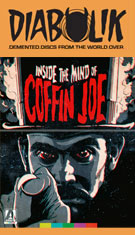
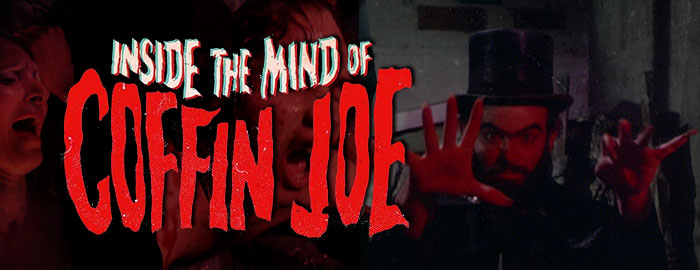
AT MIDNIGHT I'LL TAKE YOUR SOUL
B&W, 1963, 82 mins. 16 secs.
Directed by José Mojica Marins
Starring José Mojica Marins, Magda Mei, Nivaldo Lima, Valéria Vasquez
Arrow Video (Blu-ray) (US/UK R0 HD), Synapse Films (DVD) (US R1 NTSC), Fantoma (US R1 NTSC), Anchor Bay (UK R2 PAL), Cinemagia (Brazil R0 NTSC), Umbrella (Australia R0 PAL)
THIS NIGHT I'LL POSSESS YOUR CORPSE
B&W/Color, 1966, 109 mins. 13 secs.
Directed by José Mojica Marins
Starring José Mojica Marins, Tina Wohlers, Nadita Freitas, Antonio Fracari, Jose Lobo, Nivaldo de Lima
Arrow Video (Blu-ray) (US/UK R0 HD), Synapse Films (DVD) (US R1 NTSC), Fantoma (US R1 NTSC), Anchor Bay (UK R2 PAL), Cinemagia (Brazil R0 NTSC), Umbrella (Australia R0 PAL)
THE STRANGE WORLD OF COFFIN JOE
B&W, 81 mins. 10 secs.
Directed by José Mojica Marins
Starring
José Mojica Marins, Vany Miller, Veronica Krimann, Paula Ramos, Esmeralda Ruchel, Luís Sérgio Person, George Michel Serkeis, Iris Bruzzi, Osvaldo de Souza, Nidi Reis
Arrow Video (Blu-ray) (US/UK R0 HD), Anchor Bay (UK R2 PAL), Cinemagia (Brazil R0 NTSC)
AWAKENING OF THE BEAST
B&W/Color, 1969, 93 mins. 6 secs.
Directed by José Mojica Marins
Starring José Mojica Marins, Carlos Reichenbach, Ítala Nandi, Mário Lima, Annik Malvil, João Callegaro
Arrow Video (Blu-ray) (US/UK R0 HD), Fantoma (DVD) (US R1 NTSC), Anchor Bay (UK R2 PAL), Mondo Macabro (DVD) (UK R0 PAL), Cinemagia (Brazil R0 NTSC), Umbrella (Australia R0 PAL)
THE END OF MAN
Color, 1970, 79 mins. 58 secs.
Directed by José Mojica Marins
Starring José Mojica Marins, Teresa Sodré, Roque Rodrigues, Rosângela Maldonado, Mário Lima
Arrow Video (Blu-ray) (US/UK R0 HD), Anchor Bay (UK R2 PAL), Cinemagia (Brazil R0 NTSC)
WHEN THE GODS FALL ASLEEP
Color, 1972, 77 mins. 25 secs.
Directed by José Mojica Marins
Starring José Mojica Marins, Tony Carlos, Cláudio Alberto, Rosalvo Caçador, Daniel de Souza, Adão Felix, Antônio Almeida
Arrow Video (Blu-ray) (US/UK R0 HD)
THE STRANGE HOSTEL OF NAKED PLEASURES
Color, 1976, 79 mins. 25 secs.
Directed by Marcelo Motta ( and José Mojica Marins)
Starring José Mojica Marins, Elza Barbosa, João da Cruz, José Horta, Alfred Almeida
Arrow Video (Blu-ray) (US/UK R0 HD), Anchor Bay (UK R2 PAL), Cinemagia (Brazil R0 NTSC)
HELLISH FLESH
Color, 1977, 82 mins. 43 secs.
Directed by José Mojica Marins
Starring José Mojica Marins, Luely Figueiró, Oswaldo De Souza, Helena Ramos, Lirio Bertelli
Arrow Video (Blu-ray) (US/UK R0 HD), Anchor Bay (UK R2 PAL), Cinemagia (Brazil R0 NTSC)
HALLUCINATIONS OF A DERANGED MIND
Color, 1978, 83 mins. 37 secs.
Directed by José Mojica Marins
Starring José Mojica Marins, Jorge Peres, Magna Miller, Jayme Cortez, Natalina Barbosa, João da Cruz
Arrow Video (Blu-ray) (US/UK R0 HD), Anchor Bay (UK R2 PAL), Cinemagia (Brazil R0 NTSC)
EMBODIMENT OF EVIL
Color, 2008, 93 mins. 16 secs.
Directed by José Mojica Marins
Starring José Mojica Marins, Jece Valadão, Adriano Stuart, Milhem Cortaz, Rui Resende, José Celso Martinez Corrêa, Cristina Aché
Arrow Video (Blu-ray) (US/UK R0 HD) / WS (1.78:1) (16:9), Synapse Films (Blu-Ray & DVD) (US RA/R1 HD/NTSC), Anchor Bay (Blu-Ray & DVD) (UK R0 HD/PAL) / WS (1.85:1) (16:9)
Decades 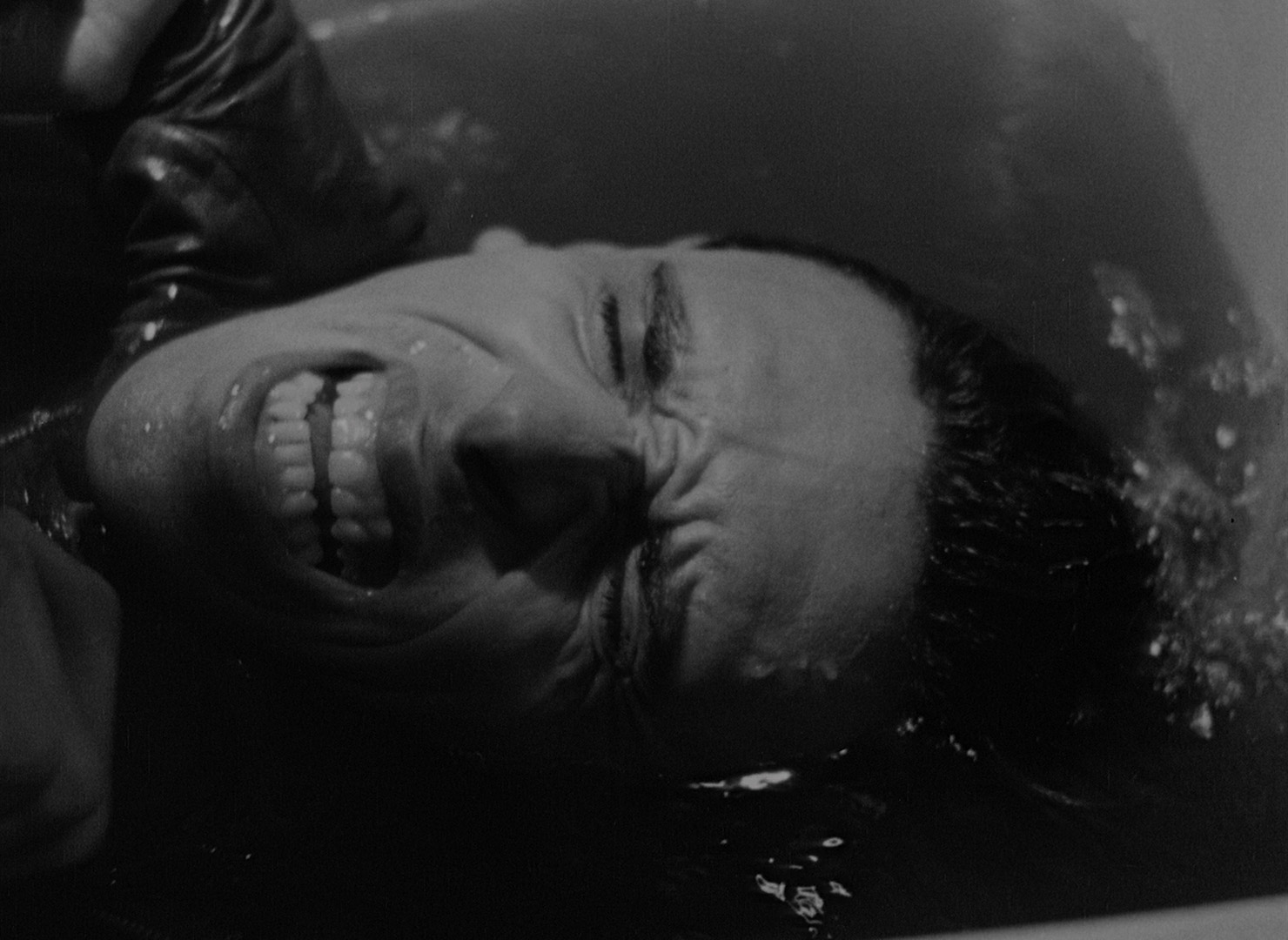 before
before 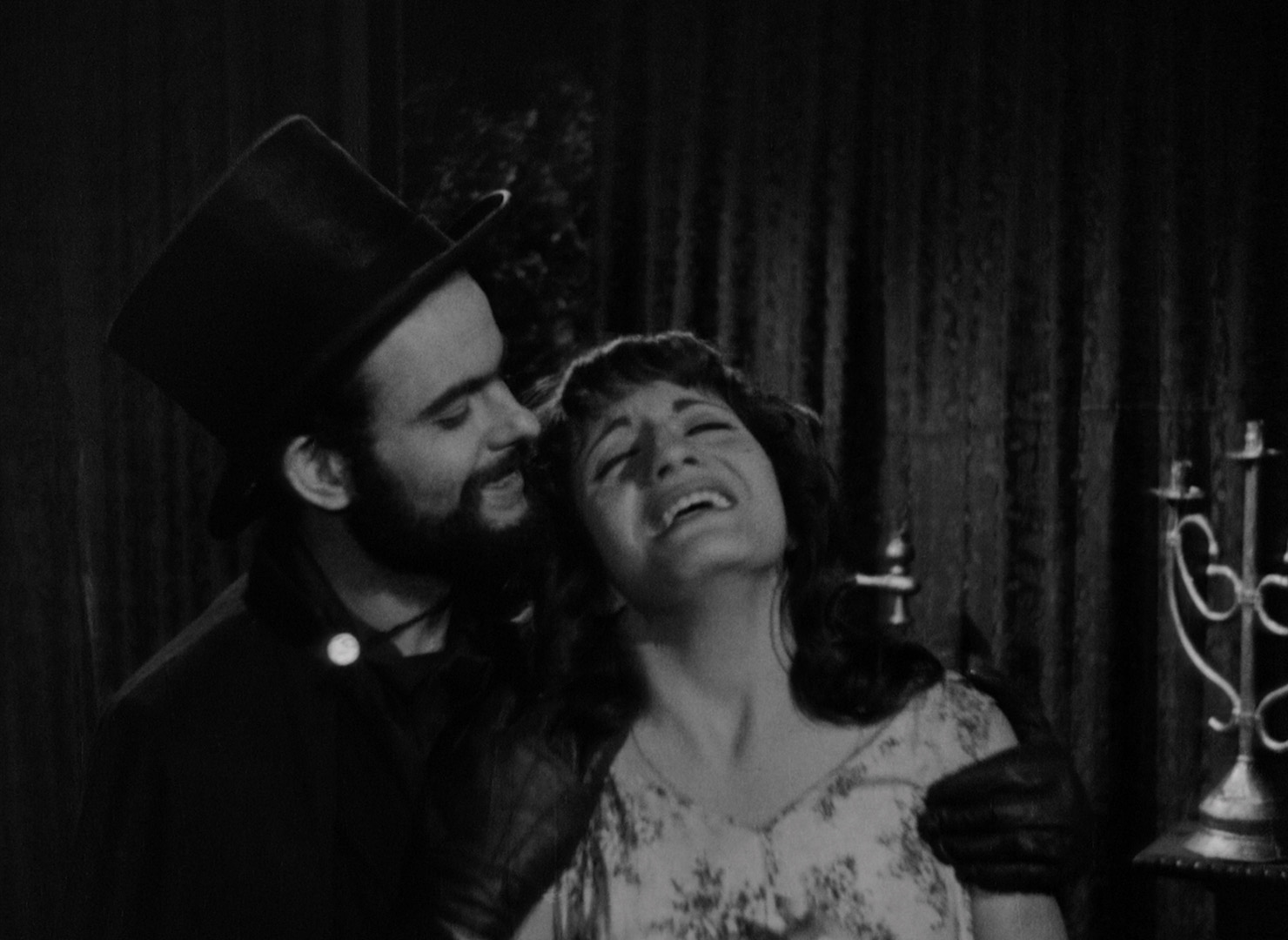 Freddy Krueger, another maniacal fiend with long fingernails stalked movie screens for years in Brazil. One of the most unforgettable director-actors ever, José Mojica Marins began his bizarre career in 1963 with At Midnight I'll Take Your Soul, a film shot on scraps that turned out to be a huge hit in screens across the nation. With his top hat, chiseled beard, piercing eyes, flowing black cape, and inhumanly long fingernails, Marins became a celebrity as Zé do Caixão, or "Coffin Joe" (the name given by Mike Vraney when the films first came to American VHS from Something Weird starting in 1993), a raging narcissist and pontificator devoted to a personal philosophy of suffering, pain, and procreation. Exactly what constitutes a Coffin Joe film has been up for debate since the character has popped up in multiple titles as a main character, a horror host, or a peripheral presence, with only three of his titles really qualifying as 100% official entries. Marins' horror output (as opposed to his work in other genres ranging from melodramas to westerns to a brief stint in hardcore) has appeared in piecemeal fashion on home video over the past few decades, driven by fan fascination largely ignited at first by jaw-dropping stills and write-ups in major horror book studies like Phil Hardy's essential The Overlook Film Encyclopedia: Horror. Despite claims that his films had been mostly damaged so badly they couldn't be scanned again, a large portion of his horror work was miraculously restored and reissued on Blu-ray by Arrow Video in 2023 in a loaded set, Inside the Mind of Coffin Joe, with six discs housing ten key films along with extensive new and archival extras. The packaging for this limited edition features a collector's book Coffin Joe: Against the World!, with essays by Tim Lucas, Carlos Primati, Jerome Reuter, Amy Voorhees Searles, Kyle Anderson, and Paula Sacramento, plus a double-sided poster and 12 postcard-sized double-sided art cards.
Freddy Krueger, another maniacal fiend with long fingernails stalked movie screens for years in Brazil. One of the most unforgettable director-actors ever, José Mojica Marins began his bizarre career in 1963 with At Midnight I'll Take Your Soul, a film shot on scraps that turned out to be a huge hit in screens across the nation. With his top hat, chiseled beard, piercing eyes, flowing black cape, and inhumanly long fingernails, Marins became a celebrity as Zé do Caixão, or "Coffin Joe" (the name given by Mike Vraney when the films first came to American VHS from Something Weird starting in 1993), a raging narcissist and pontificator devoted to a personal philosophy of suffering, pain, and procreation. Exactly what constitutes a Coffin Joe film has been up for debate since the character has popped up in multiple titles as a main character, a horror host, or a peripheral presence, with only three of his titles really qualifying as 100% official entries. Marins' horror output (as opposed to his work in other genres ranging from melodramas to westerns to a brief stint in hardcore) has appeared in piecemeal fashion on home video over the past few decades, driven by fan fascination largely ignited at first by jaw-dropping stills and write-ups in major horror book studies like Phil Hardy's essential The Overlook Film Encyclopedia: Horror. Despite claims that his films had been mostly damaged so badly they couldn't be scanned again, a large portion of his horror work was miraculously restored and reissued on Blu-ray by Arrow Video in 2023 in a loaded set, Inside the Mind of Coffin Joe, with six discs housing ten key films along with extensive new and archival extras. The packaging for this limited edition features a collector's book Coffin Joe: Against the World!, with essays by Tim Lucas, Carlos Primati, Jerome Reuter, Amy Voorhees Searles, Kyle Anderson, and Paula Sacramento, plus a double-sided poster and 12 postcard-sized double-sided art cards.
In 1963's outrageous At Midnight I'll Take Your Soul, the audience receives not one but two introductions delivered directly to the screen, first from Marins himself and then from a cackling gypsy woman. We then meet our antihero, Coffin Joe, the undertaker of a small village who terrorizes the citizens with his self-centered, violent behavior. Just for kicks he ties up a woman and lets spiders crawl over her, he voraciously eats meat on Good Friday, and he 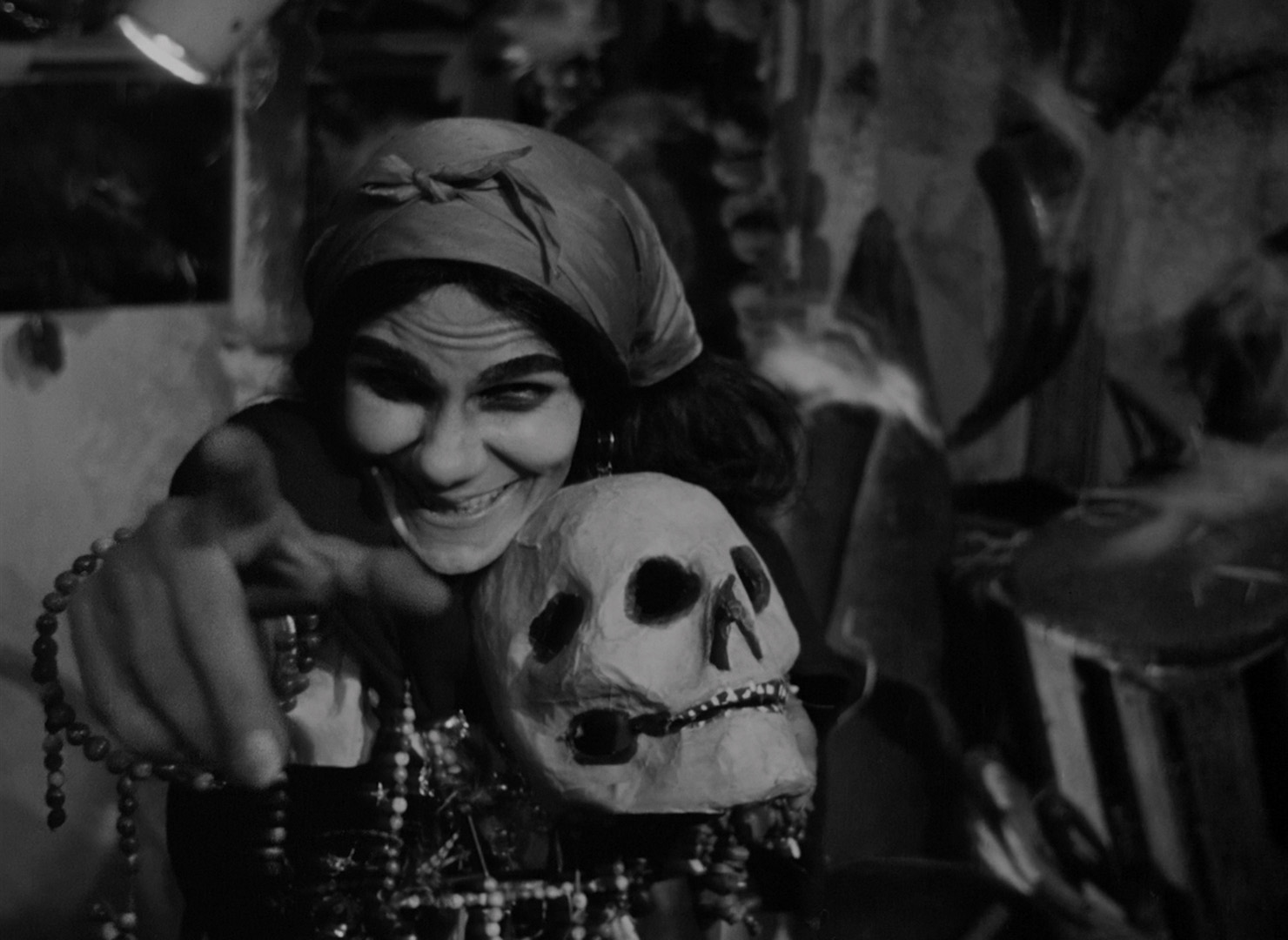 regularly picks fights at local bars and cuts off his competitors' fingers with a broken bottle during a game of poker. The goal of Coffin Joe's unholy search is the perfect woman who can bear his son, but even including his own less than satisfactory wife, the locals don't offer a prime candidate... or so it seems, until he meets the lovely Terezinha (Mei).
regularly picks fights at local bars and cuts off his competitors' fingers with a broken bottle during a game of poker. The goal of Coffin Joe's unholy search is the perfect woman who can bear his son, but even including his own less than satisfactory wife, the locals don't offer a prime candidate... or so it seems, until he meets the lovely Terezinha (Mei).
Though 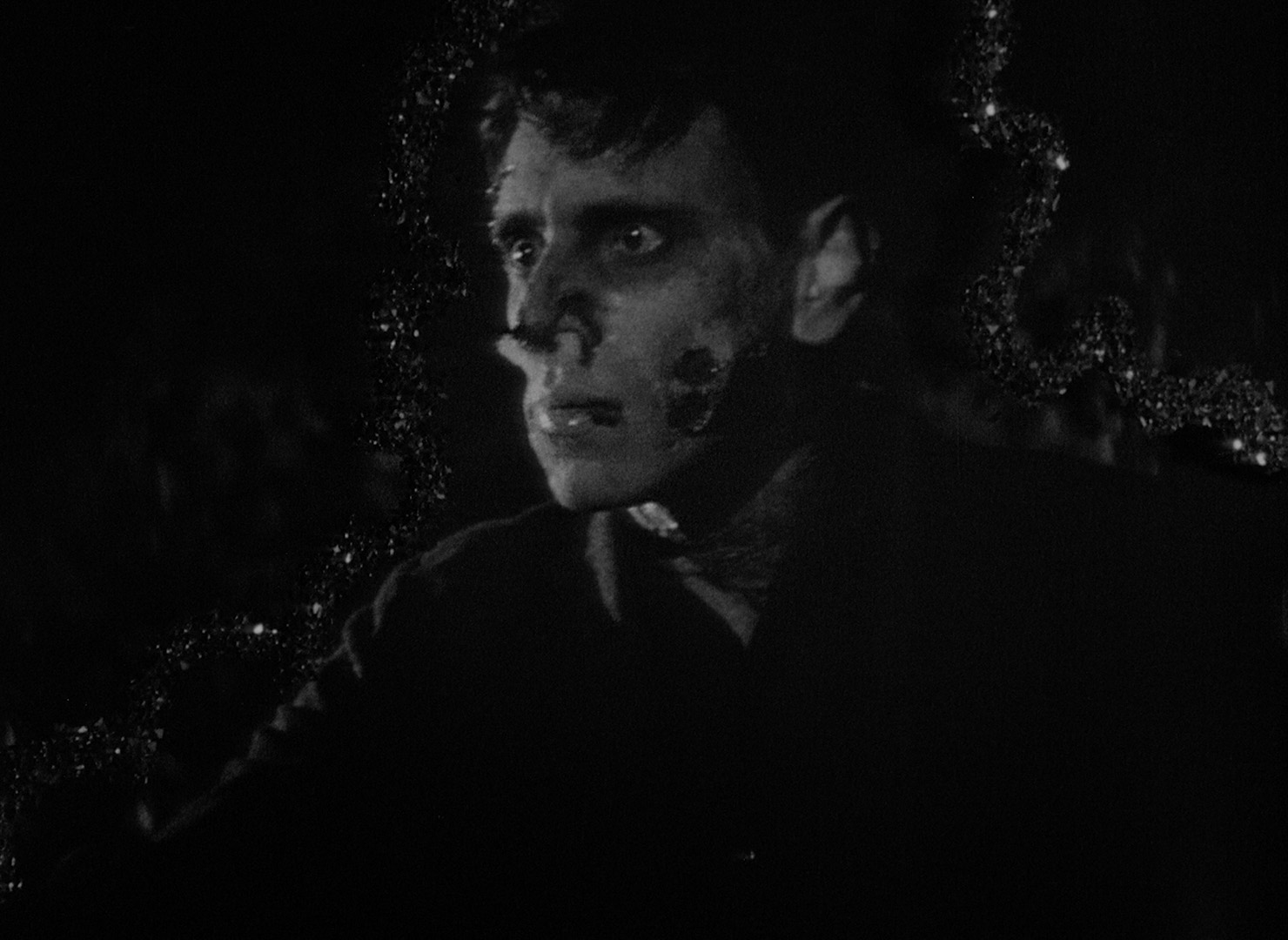 Marins is known for his extreme, personalized filmmaking which often put the actors through the kind of humiliations normally reserved for carnival freak shows, At Midnight is surprisingly strong in both the story and atmosphere departments. The desolate, shadowy village is photographed in a stylish manner to conceal the limited budget; in fact, some of the nocturnal graveyard sequences recall the similar feats accomplished by Mario Bava in Black Sunday and several of Terence Fisher's earlier Hammer films, not to mention the classic Universal horrors which crop up in numerous little homages. All of the actors were amateurs, either friends or relatives, and Marins (sporting his shortest manicure here) handled most of the technical duties himself. As far as homemade horrors go, however, this is a stunning achievement.
Marins is known for his extreme, personalized filmmaking which often put the actors through the kind of humiliations normally reserved for carnival freak shows, At Midnight is surprisingly strong in both the story and atmosphere departments. The desolate, shadowy village is photographed in a stylish manner to conceal the limited budget; in fact, some of the nocturnal graveyard sequences recall the similar feats accomplished by Mario Bava in Black Sunday and several of Terence Fisher's earlier Hammer films, not to mention the classic Universal horrors which crop up in numerous little homages. All of the actors were amateurs, either friends or relatives, and Marins (sporting his shortest manicure here) handled most of the technical duties himself. As far as homemade horrors go, however, this is a stunning achievement.
Bearing in mind that it was shot on less than optimal stock and probably spliced together with Scotch tape, At Midnight has fared quite well on home video for the most part over the years including its first appearance on DVD in 2001 from Fantoma. Some of the process shots, such as the opening titles, still look as ragged as they ever did, but the image quality is crisp and the negative appears to have been well preserved. The first subtitled VHS edition from Something Weird looked pretty good, but this one beat it easily. The Portuguese dialogue is presented with optional English subtitles, and the disc includes trailers for all three Fantoma Coffin Joe titles (identical to the ones on SW's previous compilation tape). The real treat here is a 10-minute interview with Marins in which he discusses the making of the film, pointing out various locales which had to be altered and explaining how he accomplished that memorable shimmering shot of a specter offering Coffin Joe a light in a graveyard. The same source was later used for an Anchor Bay release as part of a 2009 Coffin Joe set (marred by some hideous NTSC-to-PAL conversion and burned-in yellow subtitles with lots of typos), an excellent 2002 Brazilian special edition, and a 2011 Australian DVD.
In 2017, Synapse Films brought this film (and its sequel) to DVD under somewhat controversial circumstances; in the age of Blu-ray, it was claimed that the surviving film materials in Brazil couldn't withstand another film scan -- thus no HD option to come for many years, though this option had better contrast than its predecessors. Extras include the hammy Brazilian Coffin Joe intro (2 mins.), the 10-minute making-of featurette with Marins from the Fantoma disc, an 8m53s discussion by Marins about his early 1952 short film Reino Sangreato (whose surviving clips are shown), a 6m31s 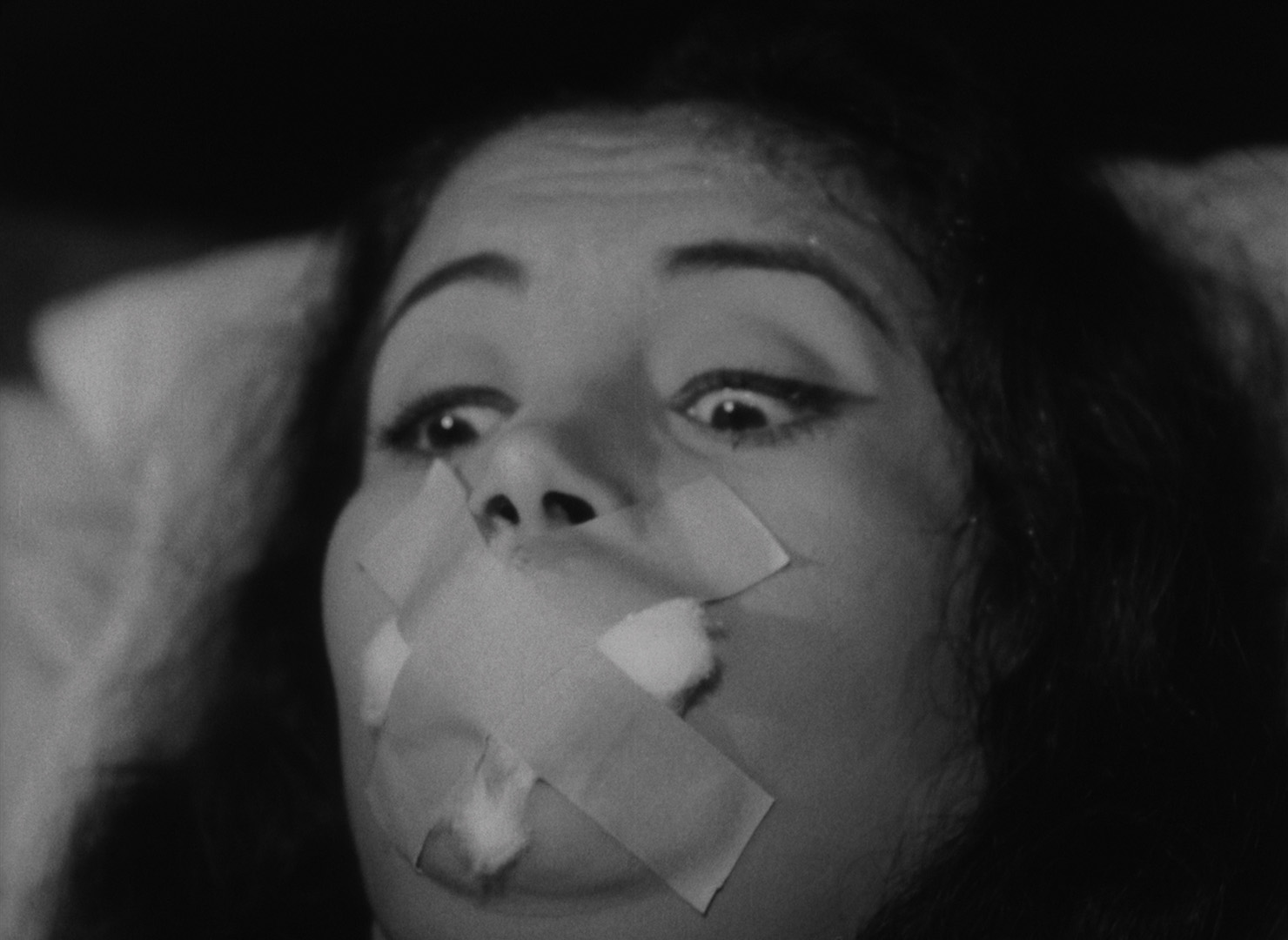 Marins interview about the genesis of his interest in filmmaking, a
Marins interview about the genesis of his interest in filmmaking, a 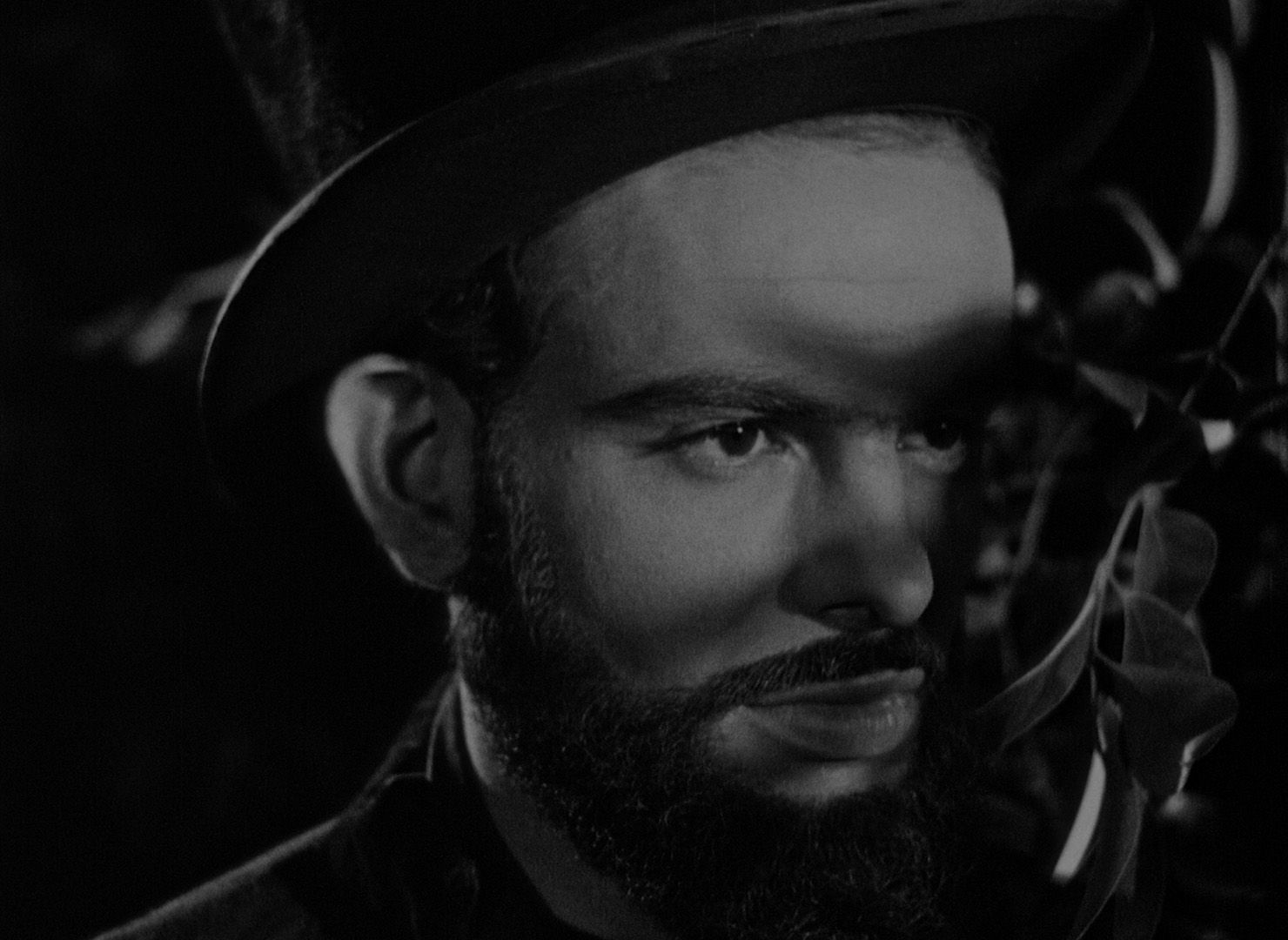 "new scene" shot in 2002 with a modern-day Coffin Joe assailing a woman clutching onto a pet bird, the original Brazilian trailer, and a "rare promotional trailer" with burned-in subs that could have run during its Something Weird days.
"new scene" shot in 2002 with a modern-day Coffin Joe assailing a woman clutching onto a pet bird, the original Brazilian trailer, and a "rare promotional trailer" with burned-in subs that could have run during its Something Weird days.
Like the rest of the films in the set, the Arrow Video Blu-ray is a godsend (if that's the right term) featuring a 2022 4K restoration "executed at Cinecolor Brazil lab with the support of Arrow Films and under the supervision of Mojica's last producer, Paulo Sacramento. Digital restoration done from the 35mm image interpositives (printed in 1996) and a 35mm print supplied by Cinematica Brasileira. The audio files were restored from the preexisting telecine of a 35mm print." In short, it looks great and should delight anyone despairing that we'd be stuck with standard def options for the rest of eternity. The LPCM Portuguese mono audio is also in fine shape and features the best English subtitles to date. A commentary from the Brazilian release is ported over here featuring Martins, filmmaker Paulo Duarte, and film scholar Carlos Primati (with English subtitles) explaining how Brazil's first horror star was born under the most meager and challenging of conditions, as well as the challenges he faced getting it released with the censorship guidelines at the time. The new "Coffin Joe’s Sadean Underworld" (12m10s) is a video essay by film scholar Lindsay Hallam about the reflections between Marins and France's most famous literary provocateur, both of whom used extreme philosophies throughout their work along with taboo levels of violence and sexuality. Previously available subtitled in the Anchor Bay set as a standalone DVD, the 2000 documentary Damned: The Strange World of José Mojica Marins (65m19s) by André Barcinski and Ivan Finotti returns here and offers a thorough survey of Martins' films, life, and cultural impact, including extensive chats with the man himself, film clips, and appearances at screenings and conventions. Marins' first short, Bloody Kingdom (8m55s), is presented here with director commentary (it was silent anyway) as seen on the Brazilian disc, while his other early efforts are represented starting with 1958's The Adventurer’s Fate (A Sina Do Aventureiro) (12m49s). This one is a fragment of Marins' apparently violent western which offers the spectacle of the man himself as a rough-and-tumble gunslinger getting stamped in the face, and it's followed by a fragment of My Destiny in Your Hands (Meu Destino Em Tuas Maos) (15m55s), a cartoony magic realism drama (with great animated opening credits) featuring Marins minus his beard. Two trailers for At Midnight round out the 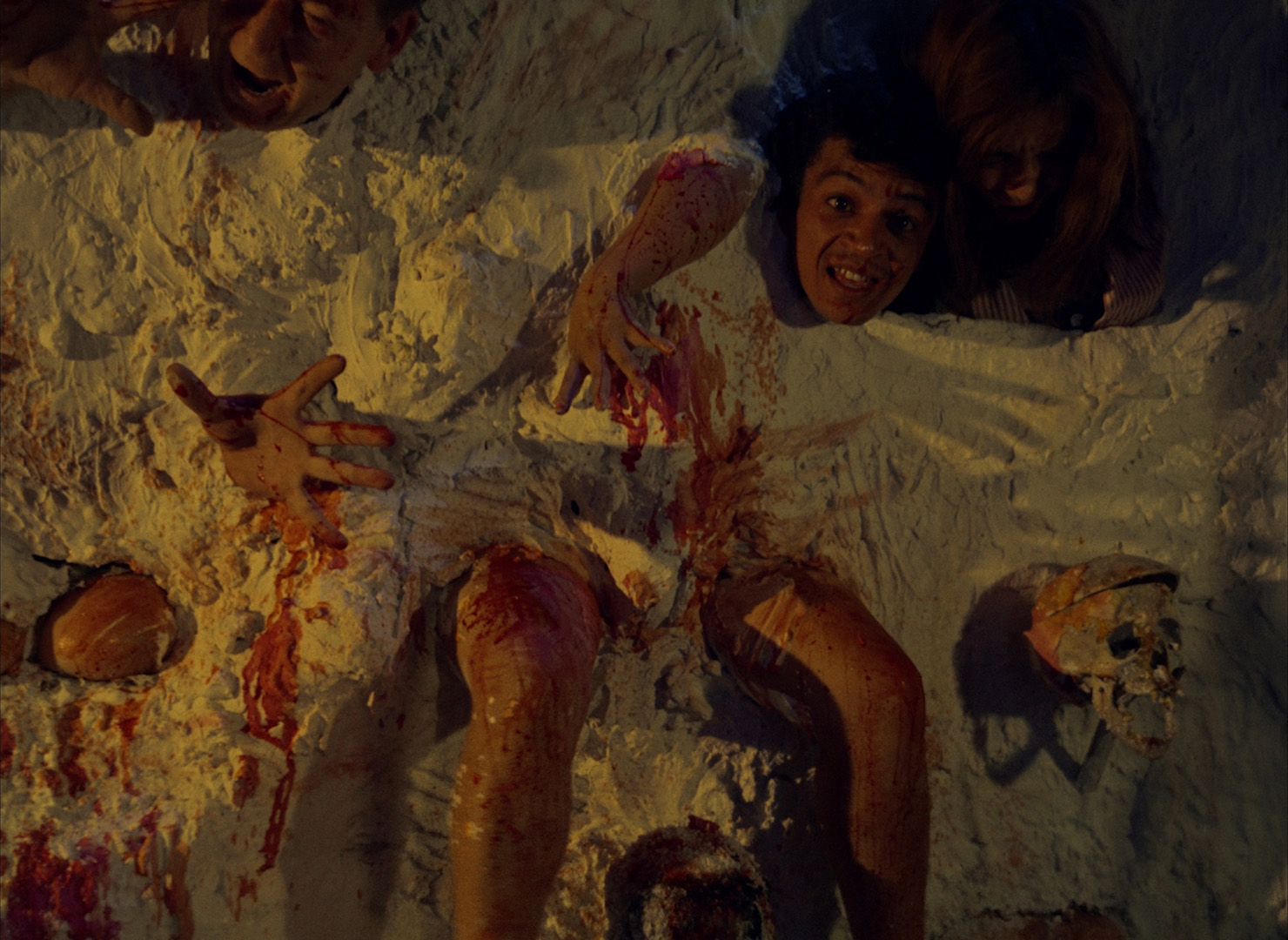 first
first 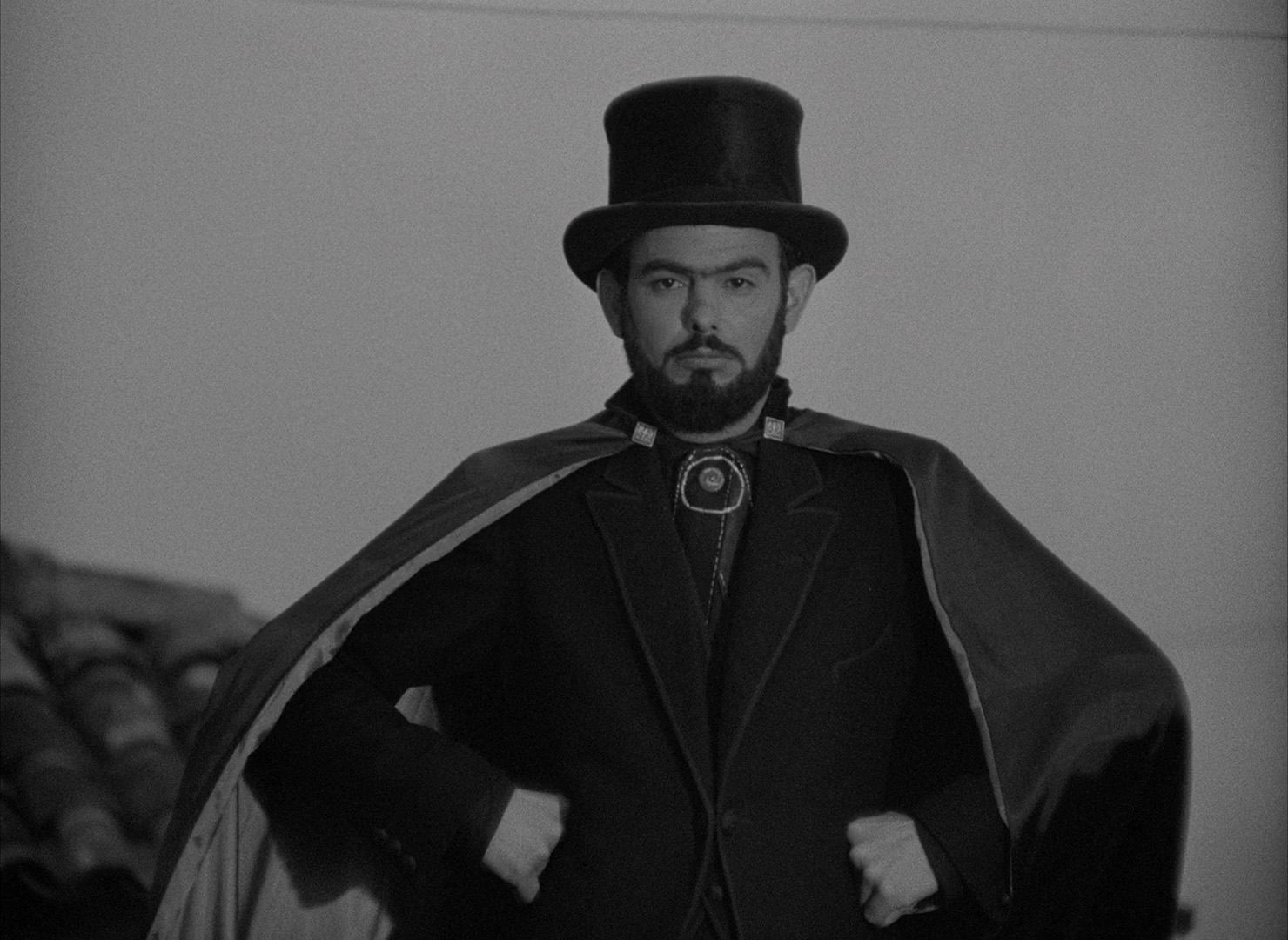 disc.
disc.
Picking up shortly after his first film left off, Coffin Joe returns in This Night I'll Possess Your Corpse, an even more extravagant wallow in horror movie excess. After recuperating in the hospital from massive eye trauma (which looked significantly worse at the end of At Midnight, to say the least), he's back to business as usual trying to scout out a future mother for his evil, "perfect" spawn. After auditioning six beauties with his trusty tarantulas and subjecting another young woman to the clutch of a boa constrictor, all with the aid of his new, trusty hunchback assistant, Bruno (de Lima), Coffin Joe finally settles on the perfect mate and even wipes out his male competitor with the aid of a heavy rock to the cranium. Alas, a brutal twist of fate induces him to hallucinate a horrifying journey to hell (in full, bleeding color), where the damned are cursed to an eternity locked into the walls of an icy cavern presided over by pitchfork-wielding minions of the devil, also played by Marins. Shaken to his senses, Coffin Joe embarks on one final, savage attempt to fulfill his destiny...
Encouraged by the popular reception of At Midnight, Marins pulls out all the stops for his second foray into horror territory. The vestiges of a storyline present in the first film are largely discarded for what instead resembles a collision between the aesthetic perversion of the Marquis De Sade and the violent, orgiastic visuals of the '60s S&M Olga films. This is no quick cut and paste sickie, however; Marins' craft had obviously been honed to allow him freer expression of his dark, comic book style fantasies. The sets are more elaborate, the photography 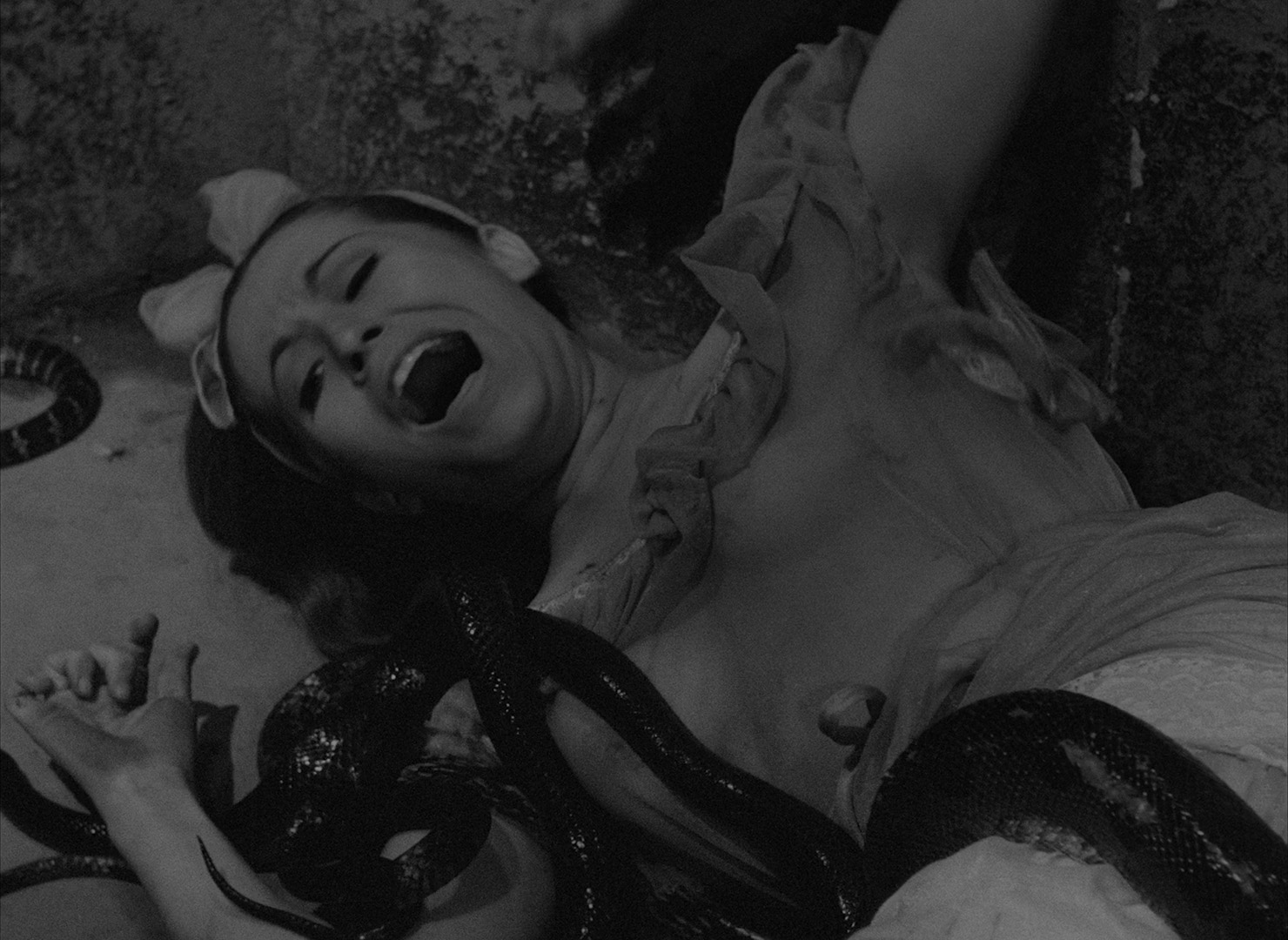 is slicker, the acting is better, and the hell sequence is arguably the most striking set piece in Marins' entire canon (which recycled it more than once!).
is slicker, the acting is better, and the hell sequence is arguably the most striking set piece in Marins' entire canon (which recycled it more than once!). 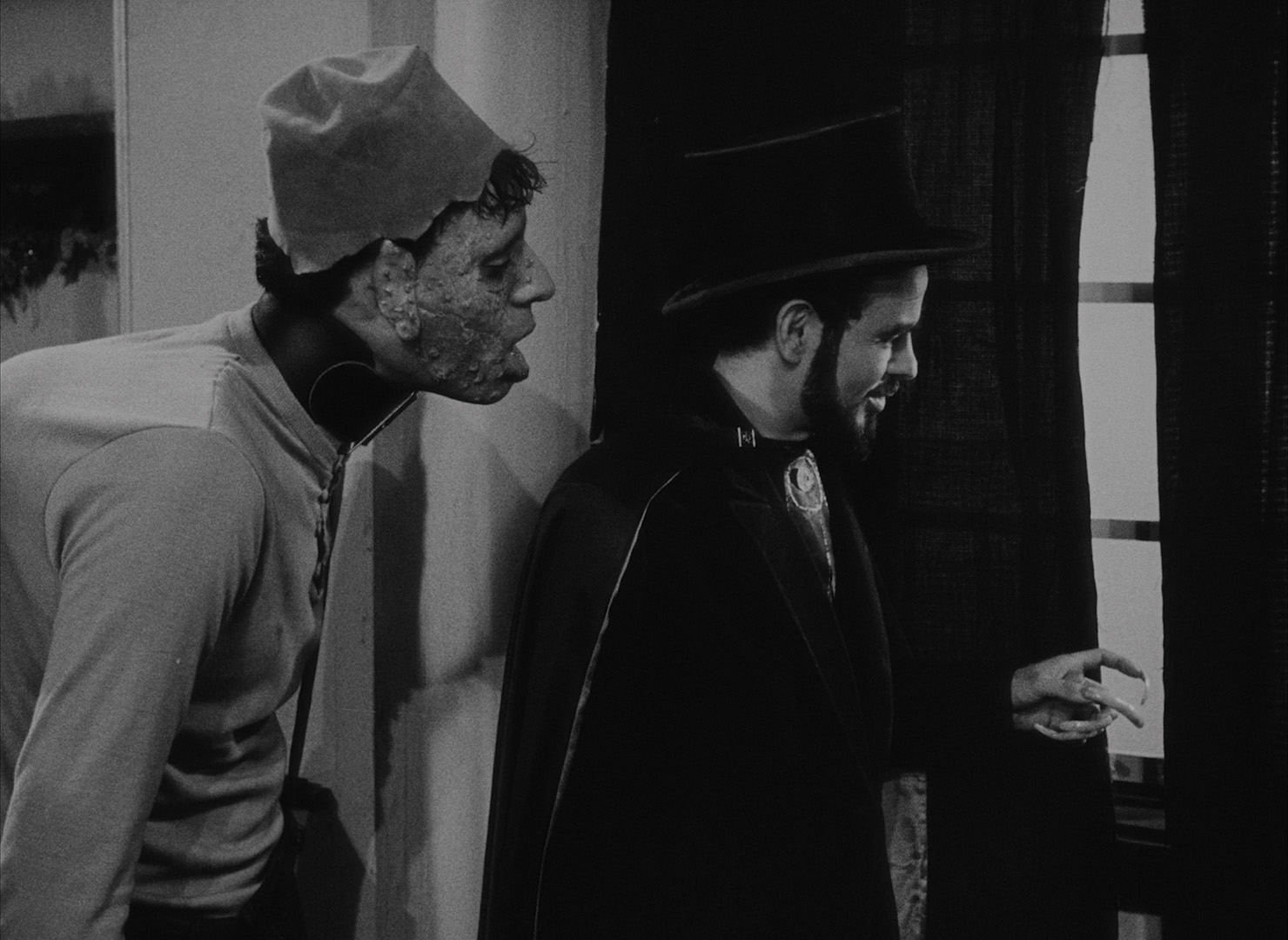 Newcomers may be startled by the film's excessiveness, so it's probably best to start with the first film to get one's feet wet; however, anyone curious about world horror cinema should make This Night required viewing.
Newcomers may be startled by the film's excessiveness, so it's probably best to start with the first film to get one's feet wet; however, anyone curious about world horror cinema should make This Night required viewing.
As with the first film, this debuted on DVD from Fantoma in 2001, and the English subtitles are well written and easily accessible. Once again the disc includes the three Coffin Joe trailers, as well as a fascinating 8m11s interview in which Marins discusses the sudden celebrity he encountered while making this film, the ordeals suffered voluntarily by his cast members (with "bank tellers, doctors, and lawyers" among the damned who had to work the next day), and much, much more. Also, be sure to read the liner notes for an interesting bit of trivia about the film's frenetic closing line. After that the film followed an identical trajectory on home video as its predecessor, winding up in that Anchor Bay set (also with conversion issues) and Brazilian and Aussie releases. In 2017 the Synapse disc again offered the most solid representation of the film in SD with a proficient encoding that handles the detail and black levels better than ever before. Extras include a 1m42s Marins intro, the original trailer, the Fantoma featurette, a 4m25s look at the Coffin Joe Museum (which looks amazing and comparable to the Profondo Rosso shop in Italy), the great 25m14s Ivan Cardoso love letter "The Universe of Coffin Joe," a 7m48s Marins interview about some of his cinematic legal hassles and tragedies, and a gallery of rare production photos. The Arrow Video Blu-ray once again goes way beyond expectations with a pristine restoration sourced from a 4K patchwork of the original 35mm camera negative and 35mm interpositive, presented as the first feature on disc two. Everything improves here -- contrast, detail, element condition, amount of image info, you name it. The color 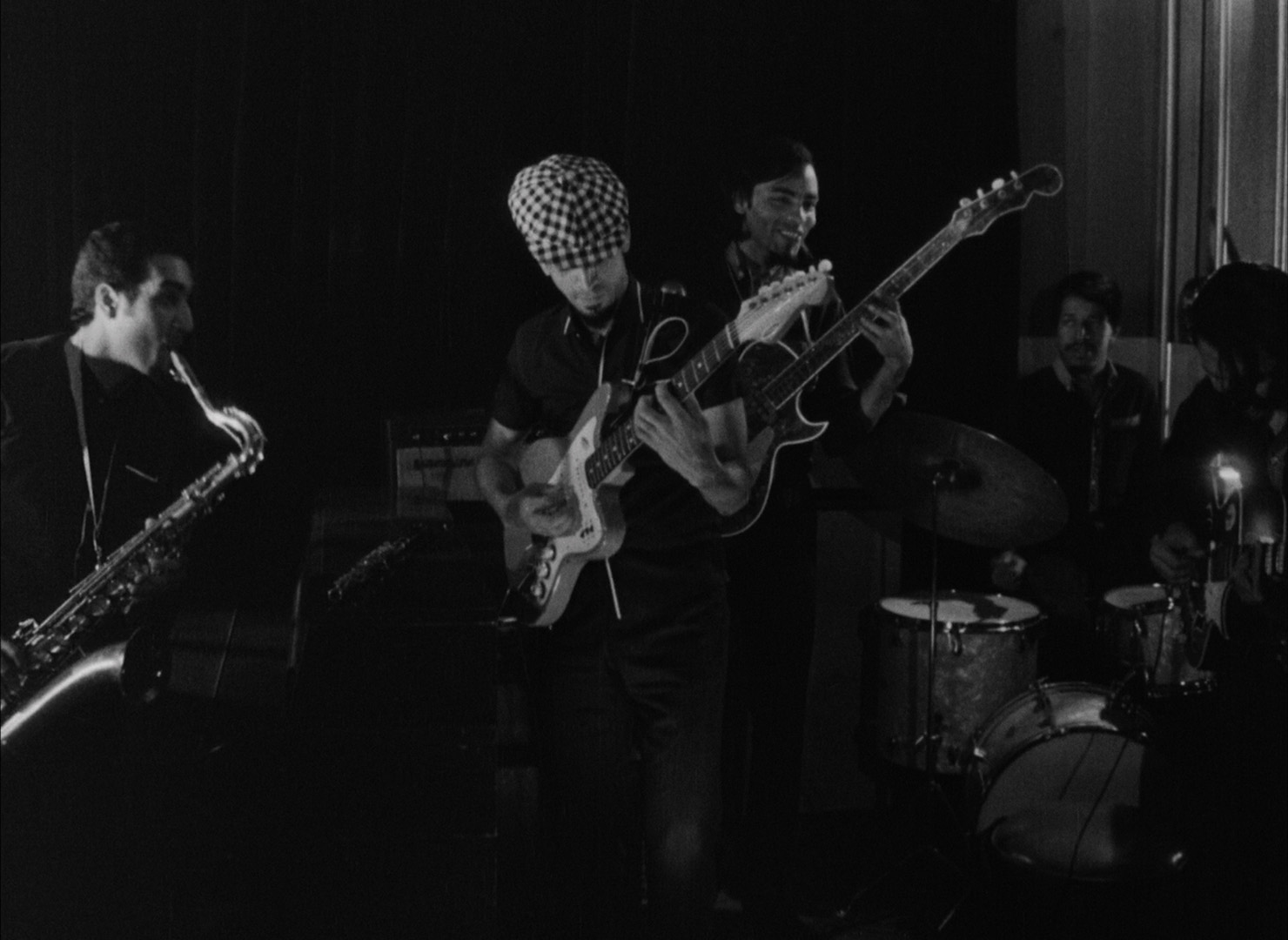 sequence looks markedly different than the earlier scan, with the gaudy pinks now looking a darker red and brown. (See comparisons at the bottom
sequence looks markedly different than the earlier scan, with the gaudy pinks now looking a darker red and brown. (See comparisons at the bottom 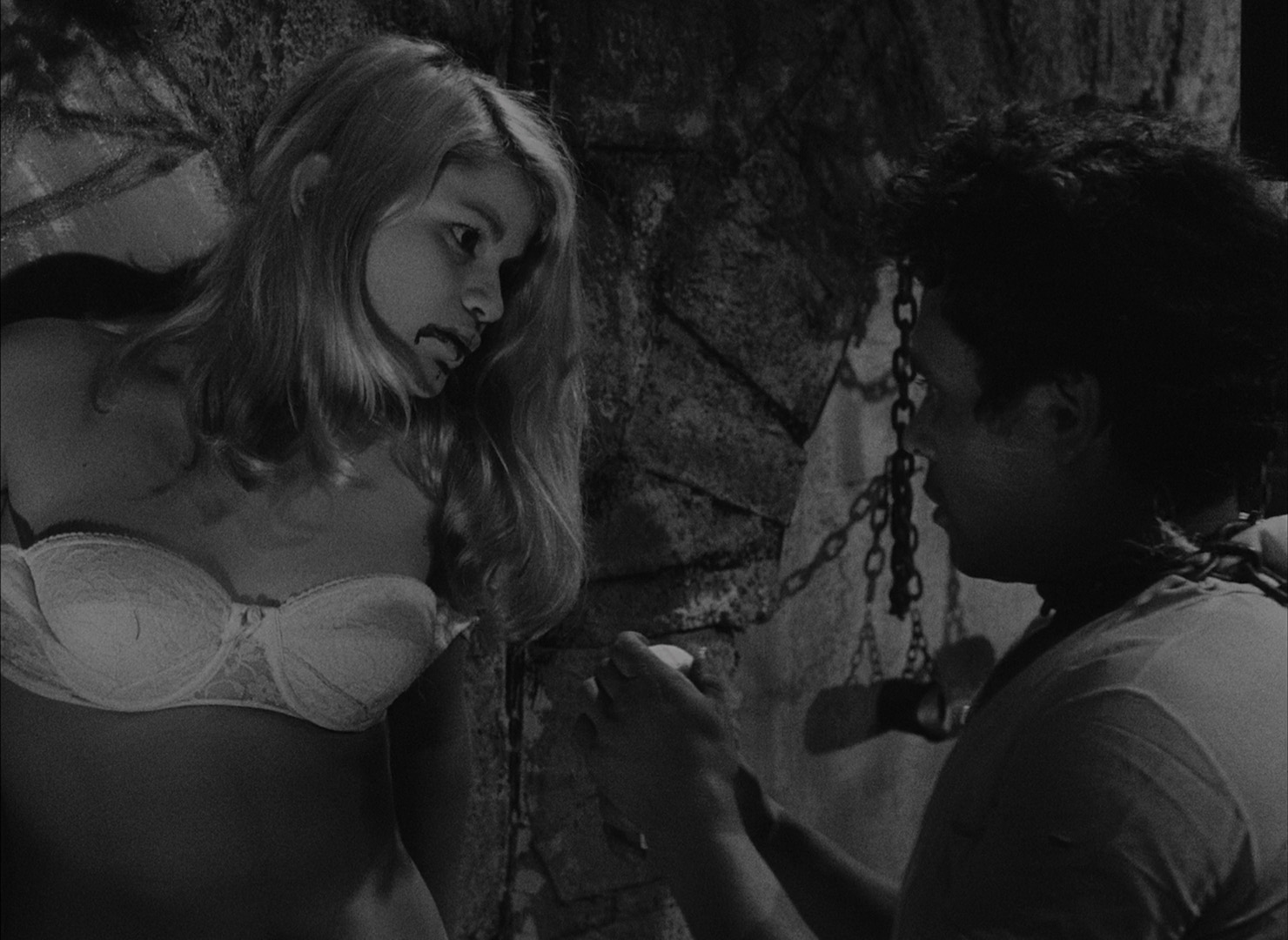 of this review.)
of this review.)
Also on the second disc is The Strange World of Coffin Joe, a great title for a horror anthology that actually relegates the boogeyman himself to simply serve as our host at the beginning. "The Dollmaker (O Fabricante de Bonecas)" involves a quartet of thieves whose latest target, the town dollmaker, is chosen because of his personal fortune stashed away somewhere in his house. However, the craftsman also has four daughters whose charms have a sinister link to the popular dolls that have made their family name. In the dialogue-free "Obsession (Tara)," a lowly and homely balloon seller (Serkeis) becomes fixated on a young woman (Bruzzi), in particular her feet after she leaves behind a pair of shoes. When tragedy strikes, he finds his desires coinciding with a macabre opportunity to fulfill his fantasies. Finally in the most famous and outrageous segment, "Theory (Ideologia)," a TV debate involving Professor Oãxiac Odéz (played by Marins with a wild wig, and try spelling that character name backwards) and a rival professor (de Souza) that leads to a continued conversation over dinner. However, the evening soon turns into an unrelenting night of horror as Odéz puts his dark philosophies about freedom and the indulgence of the will into practice.
A very lively and sometimes stylish act of provocation that also demonstrates Marins' skills as a filmmaker in a manner similar to Tales of Terror or Black Sabbath, The Strange World of Coffin Joe came right on the heels of the same year's horror anthology Trilogy of Terror (Trilogia de Terror) to which Marins contributed one story, "Pesadelo Macabro" (available subtitled on Something 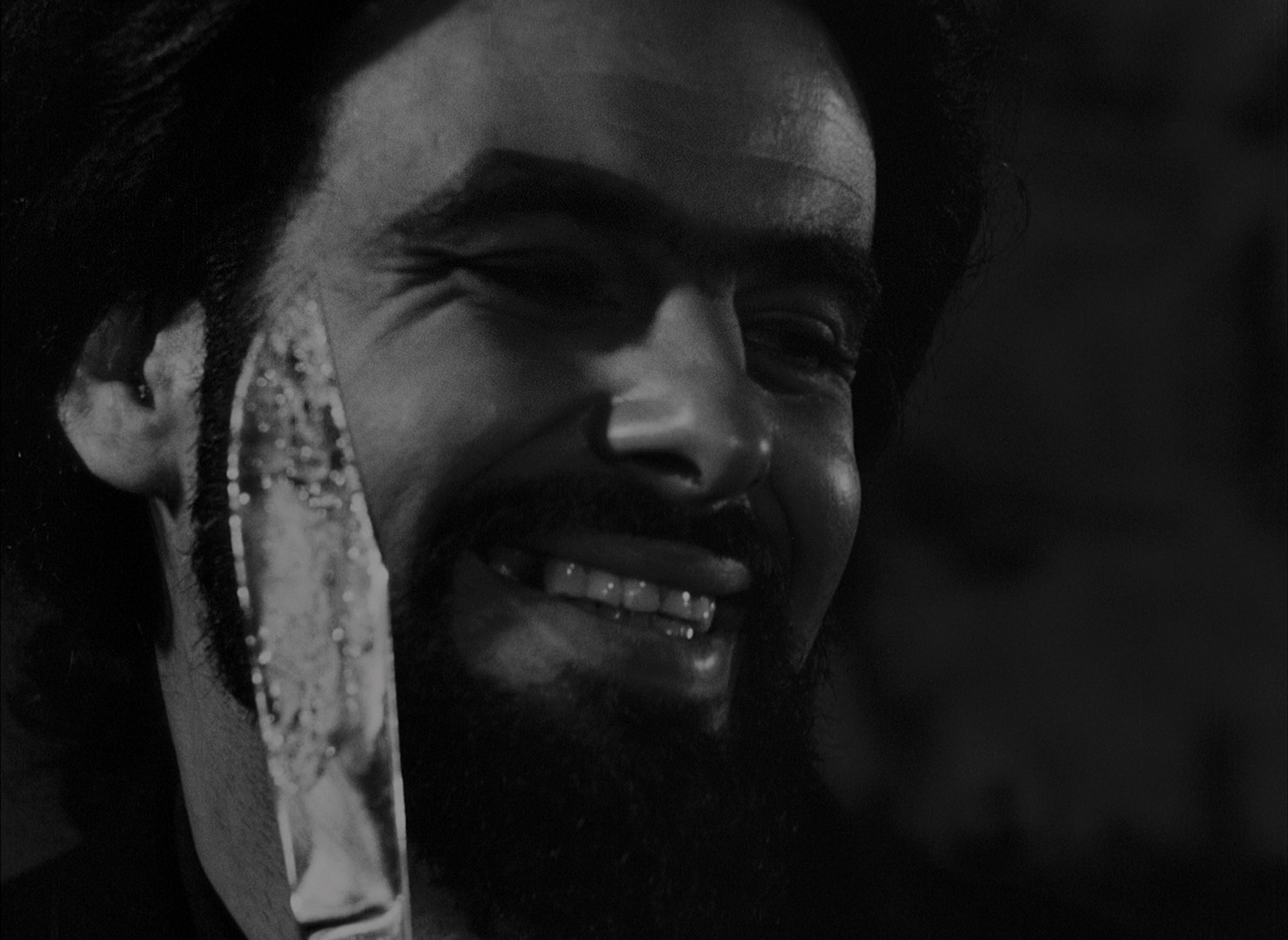 Weird's 1993 VHS compilation, Coffin Joe's Visions of Terror and out of commission since then). The first two stories are certainly strong
Weird's 1993 VHS compilation, Coffin Joe's Visions of Terror and out of commission since then). The first two stories are certainly strong 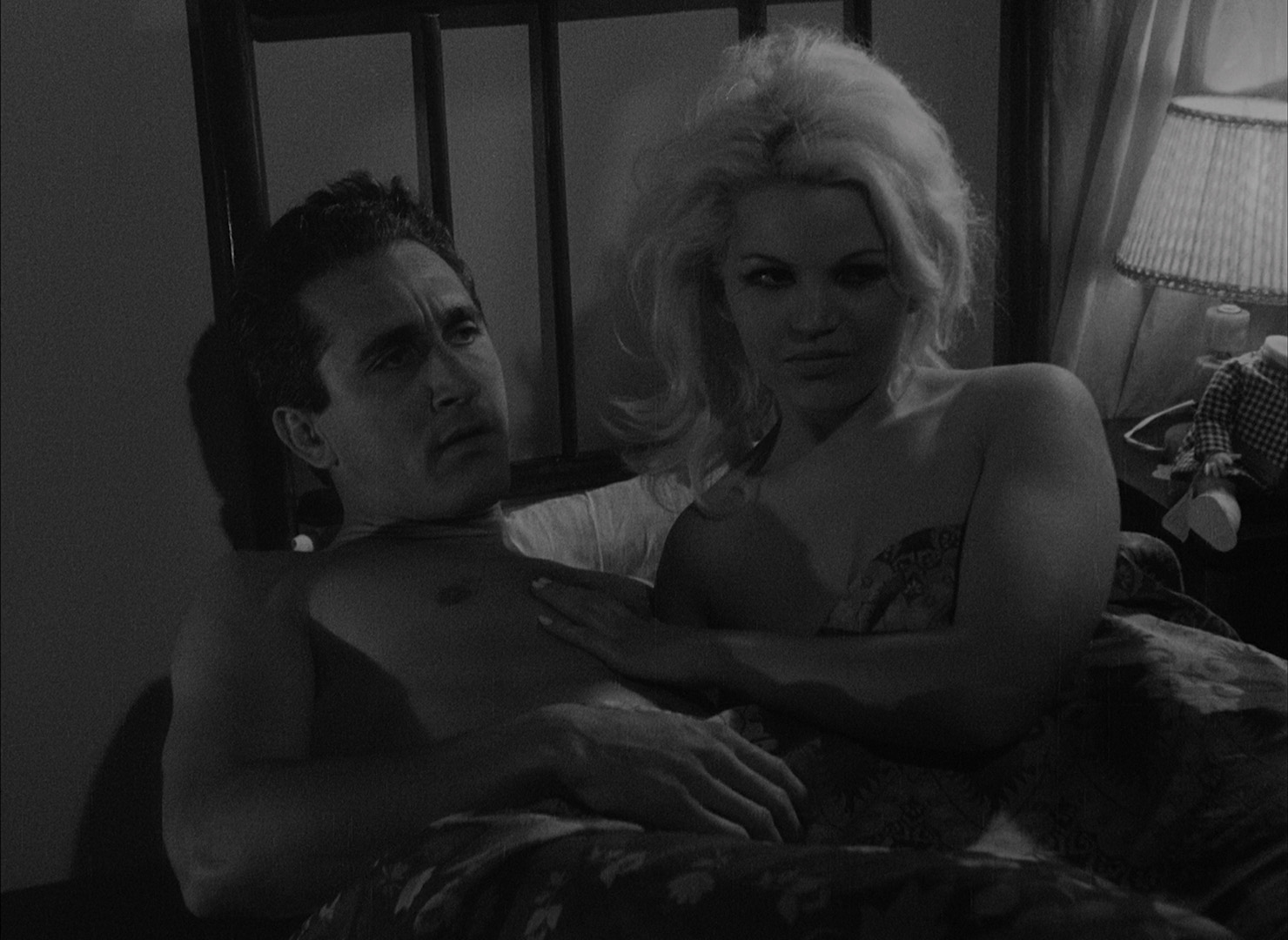 enough with their subject matter involving necrophilia, rape, and other unsavory activities, but it's in the last stretch where Marins pulls out all the stops with an unforgettable banquet scene that's up to par with the delirious heights of his prior two horror films. This one hasn't had quite the same level of home video exposure in the U.S.; it hit VHS from Something Weird and appeared in the Brazilian and U.K. wave of releases, but the Arrow Video Blu-ray is its first stateside availability in a very long time. The new 4K restoration from the 35mm interpositive and a 35mm print is a radical improvement compared to the very harsh, contrasty look it's had before, with a lot more image info visible to boot and a cleaner LPCM 1.0 mono track. Extras on the second disc include commentaries for both features with Marins, Duarte and Primati ported over from the Brazilian releases, while Stephen Thrower contributes an epic, eloquent look at Marins and his cinematic influences with "Eccentric of Cinema" (87m28s) covering a bevy of literary and cinematic ties to the filmmaker's most transgressive work. "On Tonight’s Horror Show!" (17m14s) is a new video essay by film scholar Miranda Corcoran examining the Coffin Joe persona within the larger line of international horror hosts, with Marins himself shooting to new popularity in Brazil in the '90s as a horror movie host himself. An alternate ending for The Strange World of Coffin Joe (54s) with commentary by Marins is actually the tacked-on ending seen on all prior home video editions; it was imposed by Brazilian censors to get the film released, with an explosive act of God and a bit of scripture wrapping this up on a moralistic note a la The Bad Seed. Its absence in the main body of the feature itself here is actually quite a cause for celebration as the film now ends exactly where it should on a note of complete amoral abandon.
enough with their subject matter involving necrophilia, rape, and other unsavory activities, but it's in the last stretch where Marins pulls out all the stops with an unforgettable banquet scene that's up to par with the delirious heights of his prior two horror films. This one hasn't had quite the same level of home video exposure in the U.S.; it hit VHS from Something Weird and appeared in the Brazilian and U.K. wave of releases, but the Arrow Video Blu-ray is its first stateside availability in a very long time. The new 4K restoration from the 35mm interpositive and a 35mm print is a radical improvement compared to the very harsh, contrasty look it's had before, with a lot more image info visible to boot and a cleaner LPCM 1.0 mono track. Extras on the second disc include commentaries for both features with Marins, Duarte and Primati ported over from the Brazilian releases, while Stephen Thrower contributes an epic, eloquent look at Marins and his cinematic influences with "Eccentric of Cinema" (87m28s) covering a bevy of literary and cinematic ties to the filmmaker's most transgressive work. "On Tonight’s Horror Show!" (17m14s) is a new video essay by film scholar Miranda Corcoran examining the Coffin Joe persona within the larger line of international horror hosts, with Marins himself shooting to new popularity in Brazil in the '90s as a horror movie host himself. An alternate ending for The Strange World of Coffin Joe (54s) with commentary by Marins is actually the tacked-on ending seen on all prior home video editions; it was imposed by Brazilian censors to get the film released, with an explosive act of God and a bit of scripture wrapping this up on a moralistic note a la The Bad Seed. Its absence in the main body of the feature itself here is actually quite a cause for celebration as the film now ends exactly where it should on a note of complete amoral abandon. 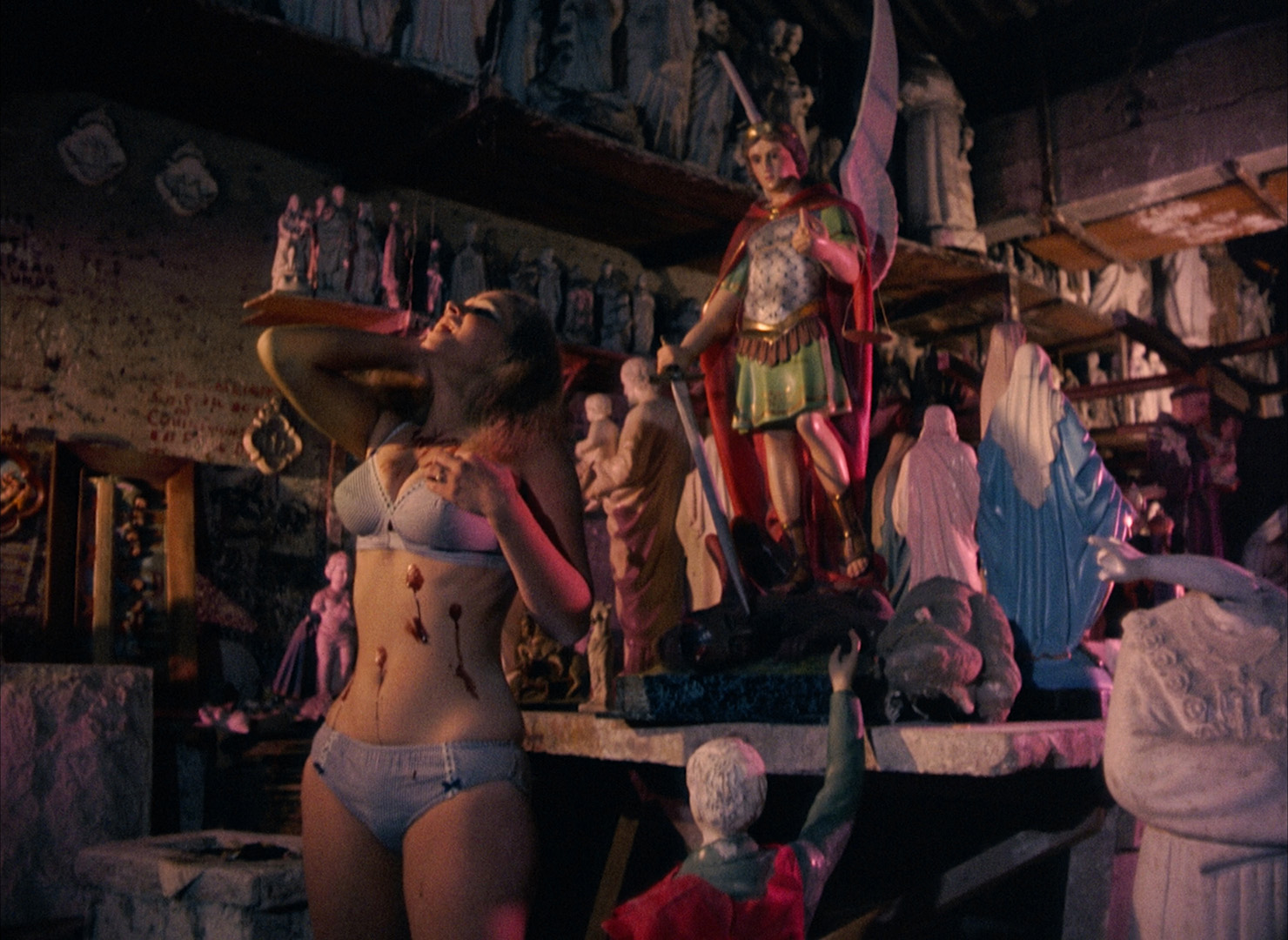 Theatrical trailers for both films are also
Theatrical trailers for both films are also 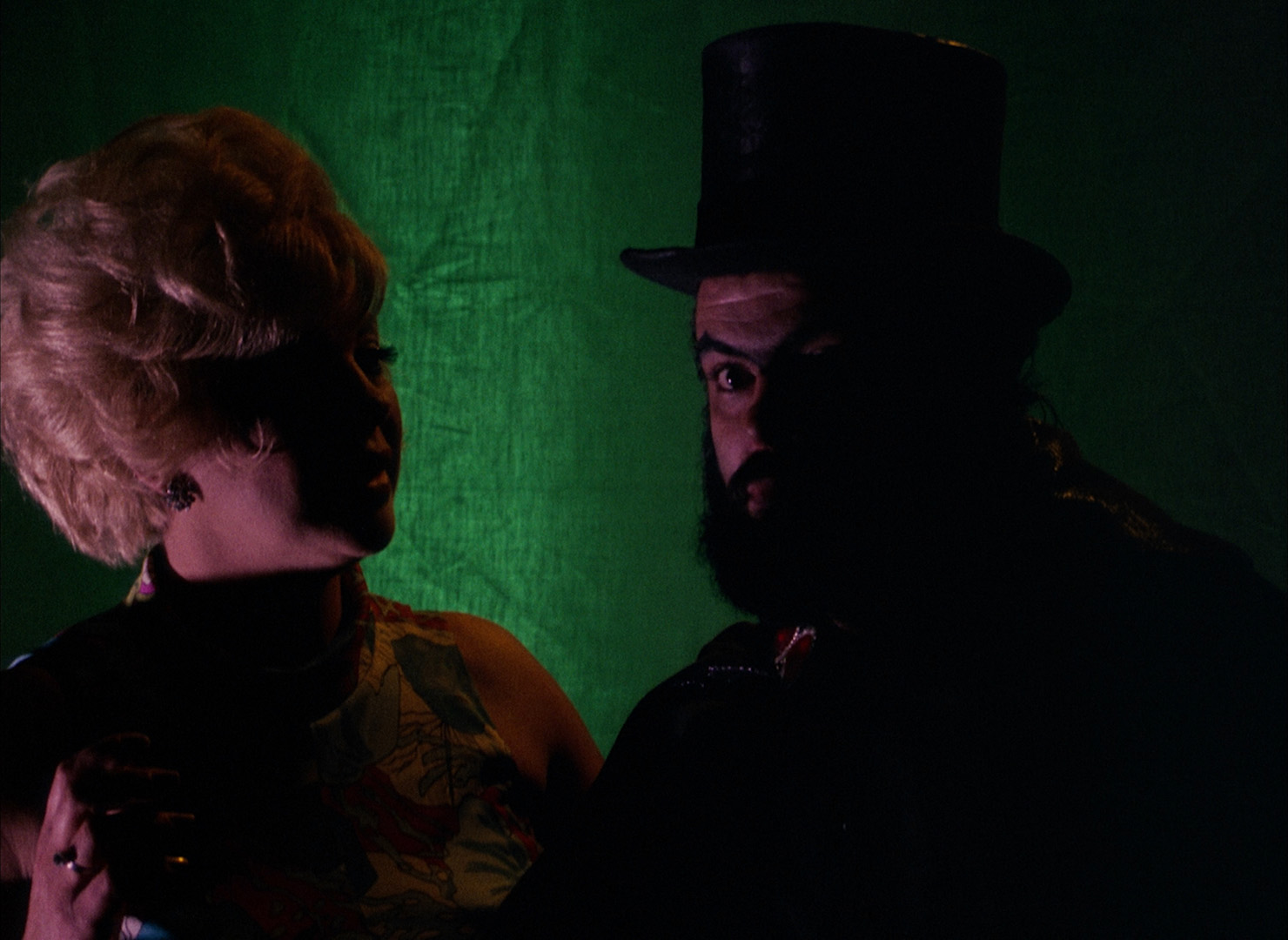 included .
included .
When is a Coffin Joe film not a Coffin Joe film? When it's Awakening of the Beast, a scathing portrait of drugs and decay in modern day Brazil. While the famous caped villain does make an extended appearance in the final half hour, the bulk of the film is devoted not to sadistic torture but to the lurid debauchery wrought by chemical abuse and unchecked crime in an urban environment -- all the more remarkable considering it was mostly shot in one room. Banned in Brazil until 1986, this was promptly hailed as Marins' masterpiece. Though many may find it doesn't quite live up to the hype, Awakening is both essential Marins viewing and a fascinating look at drug-fueled hysteria.
After an extended, lurid curtain raiser in which a woman in bobby socks provokes a group of stoned men into group debauchery, the film's plot (for lack of a more refined term) begins as the renowned Dr. Sergio introduces case studies to convince the public that drugs and crime are inextricably linked. For undeniable proof, he presents four human guinea pigs who were dosed with LSD and forced to stare at a Coffin Joe poster (following a viewing of This Night I'll Possess Your Corpse, of course). Then, in color and sepia tone, the viewer witnesses each subject's plunge into delusions involving Coffin Joe, whose appearances are comprised of both new footage and censored or alternate clips from his 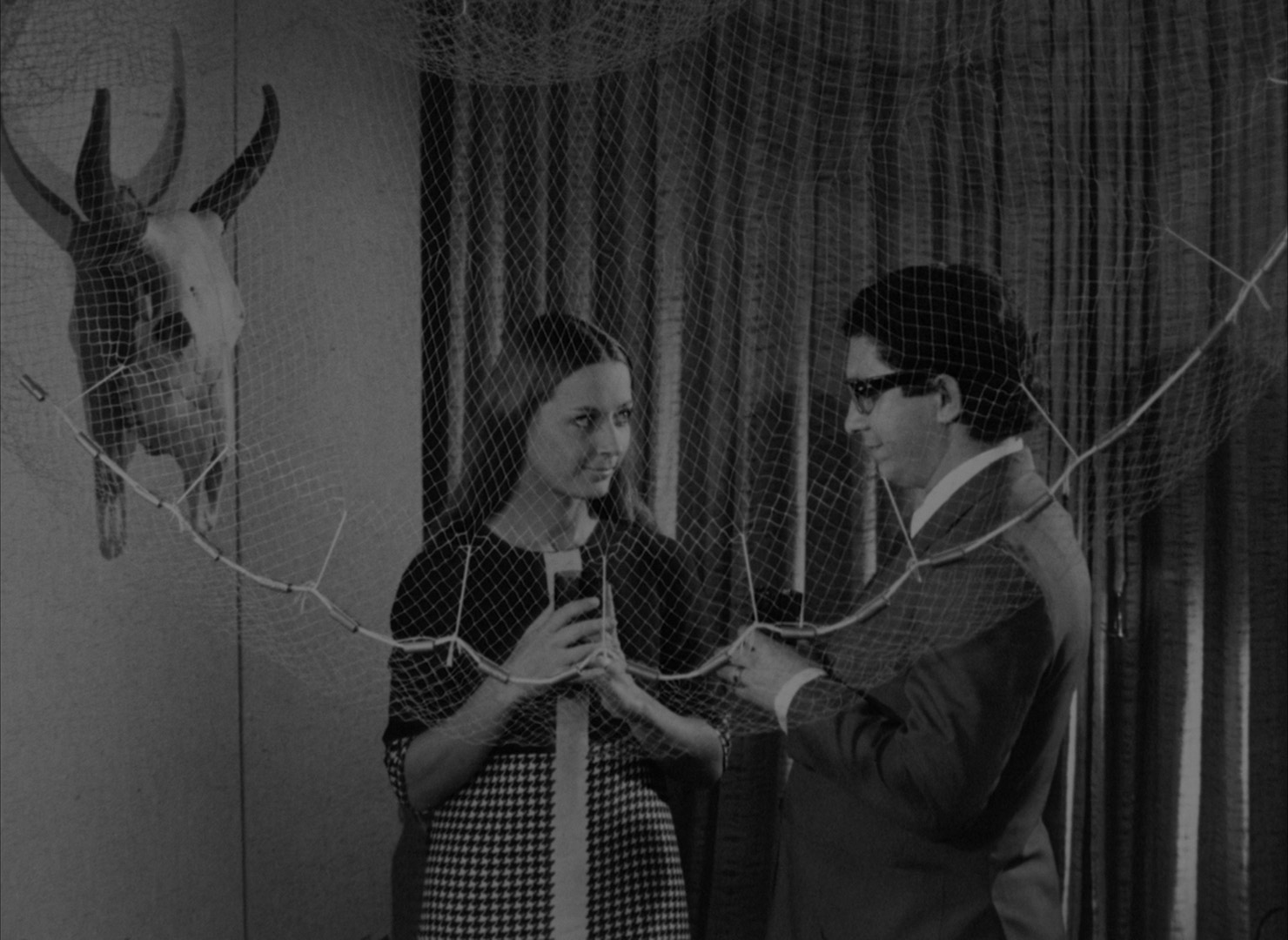 previous
previous 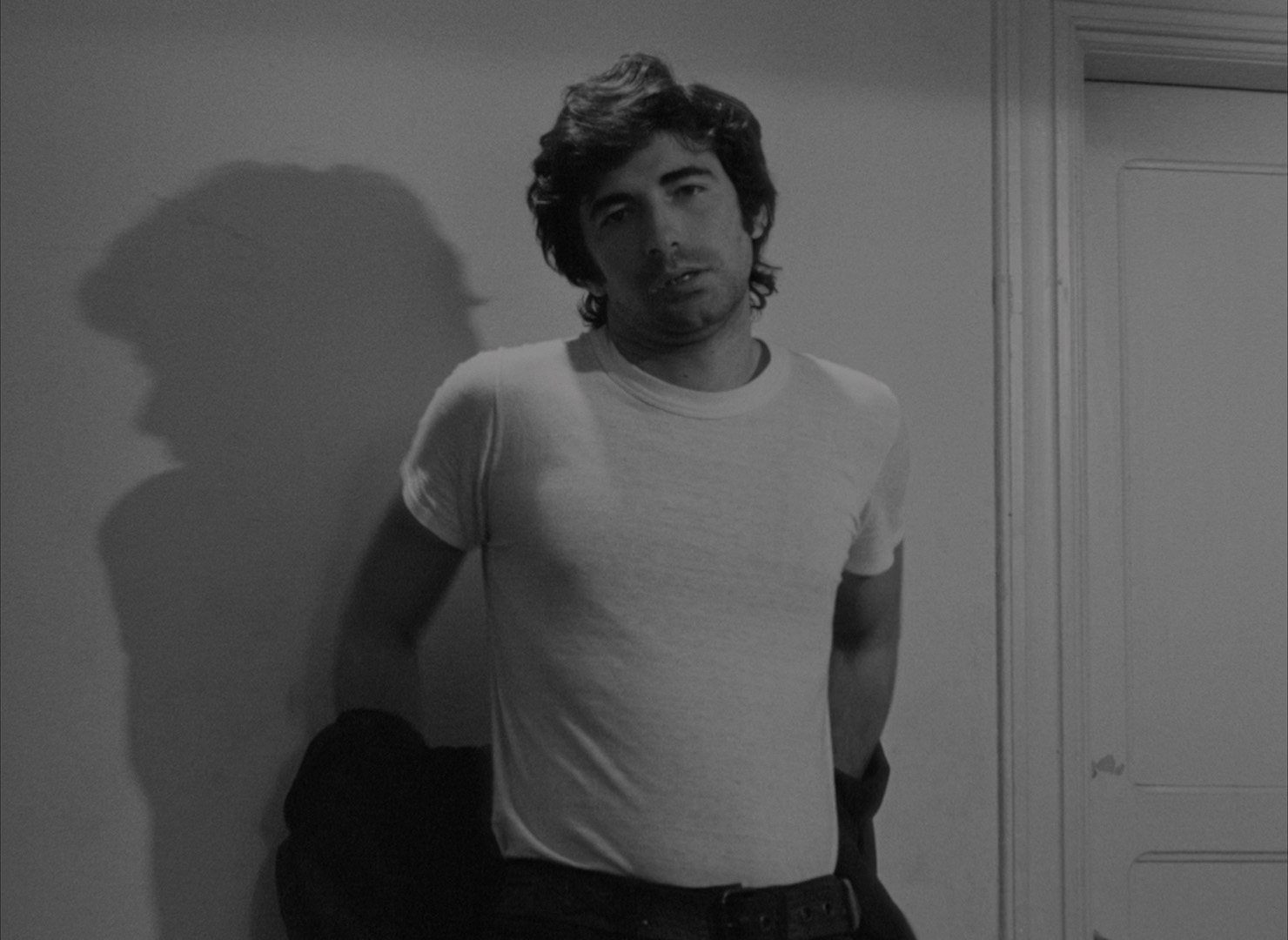 films.
films.
More or less a feature-length extension on the final "case study" story in The Strange World of Coffin Joe, this film was most likely banned more for its political subtext than its exploitation elements. The sex is stronger and more deviant than the violence in this case with an odd fixation on bodily functions, but that's really nothing compared to what viewers witnessed from Mr. Marins during the 1970s. The drug material would snugly fit with any roughie exploitation title from the U.S. during the period, making this an ideal companion piece for such fare as Mantis in Lace and Alice in Acidland, but the presence of Marins (both as Coffin Joe and himself in the memorable denouement) makes this a genuinely unique experience.
Since it was never used to strike a massive number of prints and only spooled through a projector a couple of times, this film was is in the best shape of the three when it first hit DVD from Mondo Macabro in the U.K. (featuring the excellent Mondo Macabro TV episode on Marins which has yet to pop up anywhere else), followed by a U.S. DVD from Fantoma. Again the color sequences are a marvel to behold, and the black and white footage is very moody with a queasy kind of documentary feel at times. The same video path as the first time films is carried over here, with Marins contributing an 8m23s video interview for the Fantoma and Synapse discs to discuss the importance of the film, its personal message to him, and the potentially disastrous circumstances under which it was carried out. As usual, the film was included in the U.K. and Brazilian lines as well. The Arrow version which kicks off the third Blu-ray is another major leap up, featuring a 4K restoration from the 35mm image interpositives printed in 2008 supplied by Cinemateca Brasileira and the 1969 35mm 35mm print supplied by Brazil's Arquivo Nacional, with audio from a print. 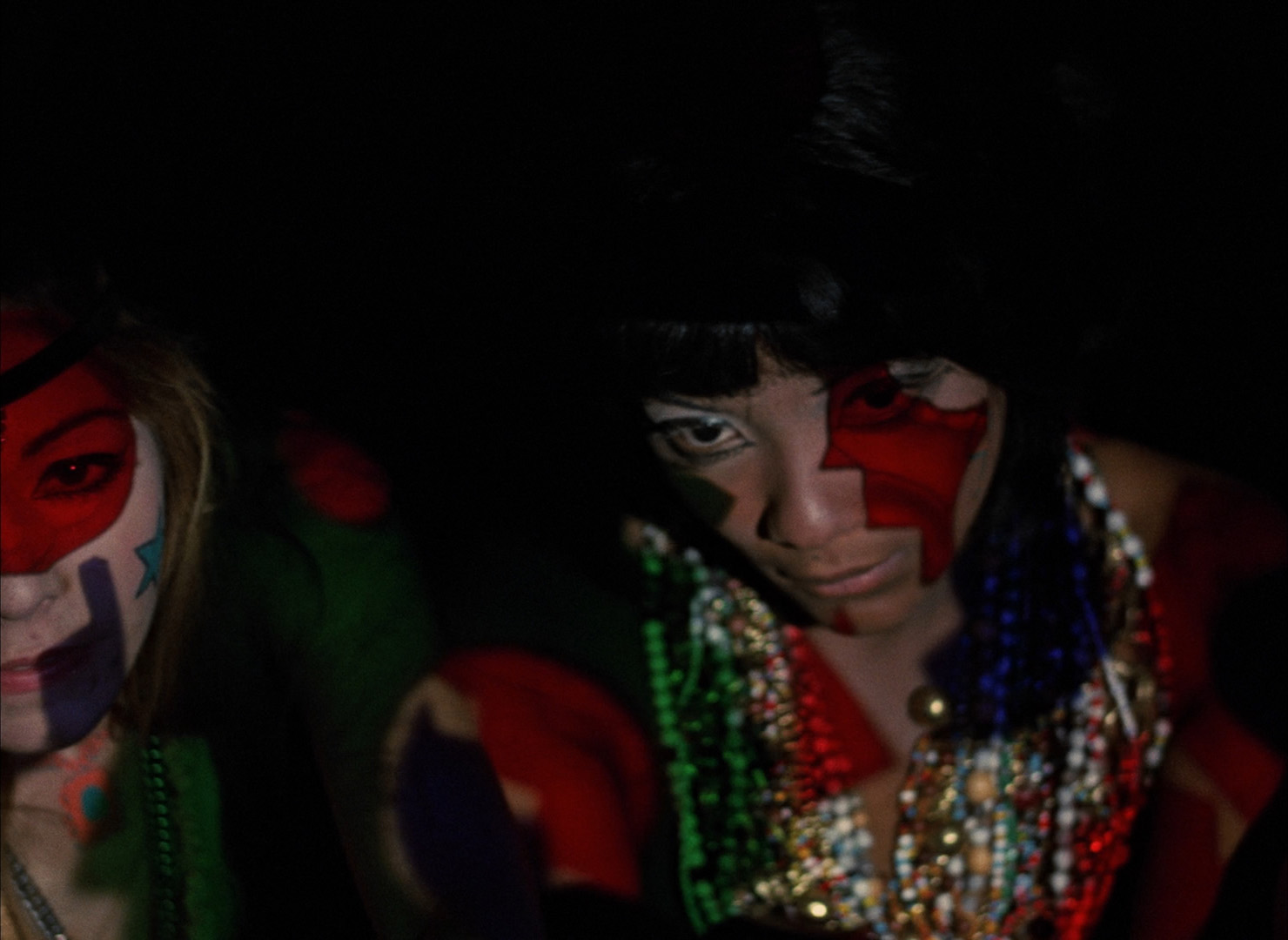 Here the contrast is also
Here the contrast is also 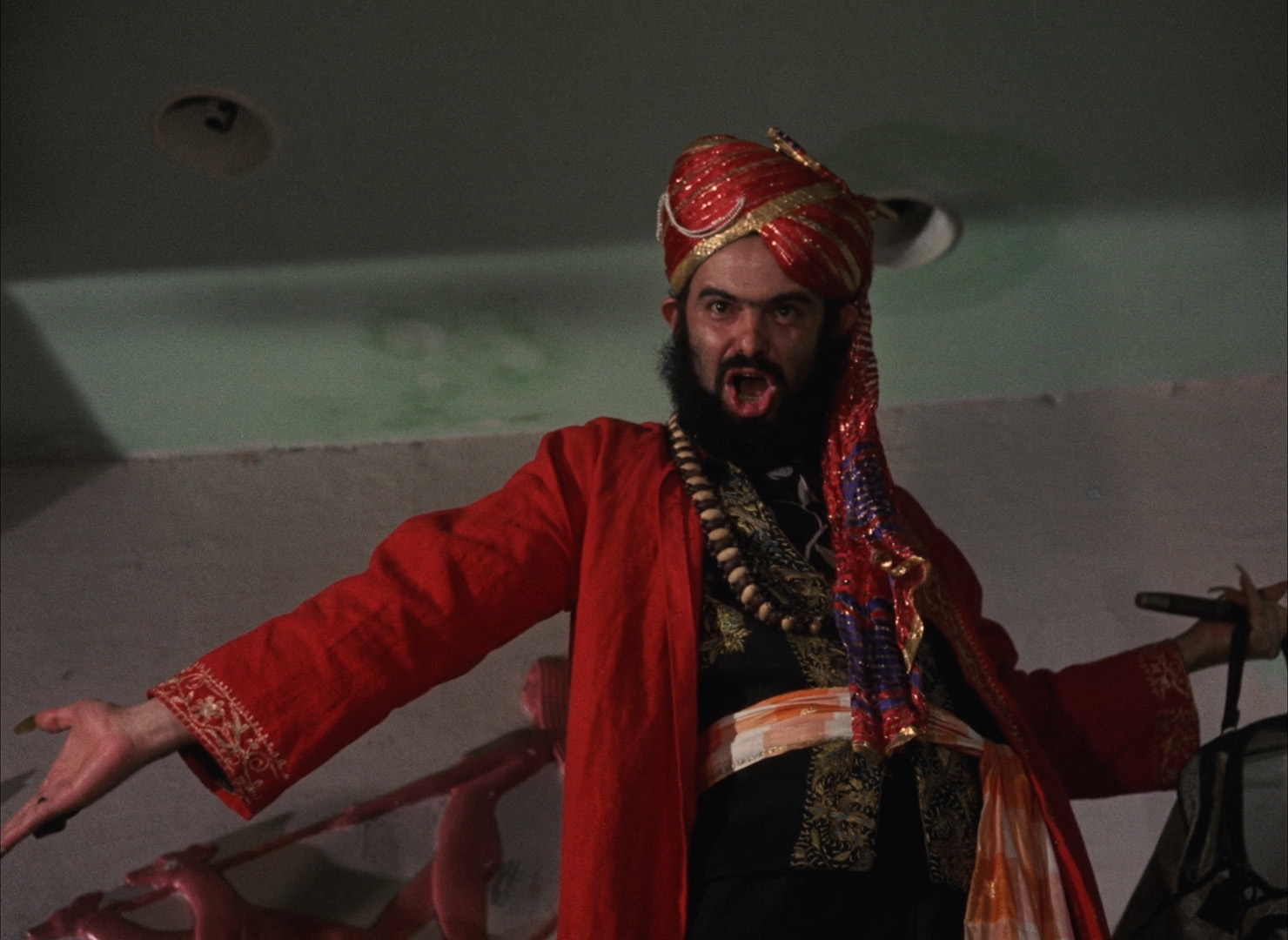 drastically improved, though in this case it's also a nice surprise to have the film opened up to 1.33:1 versus the matted 1.66:1 presentation of earlier releases which, by comparison, resulted in clunkier compositions and sheared off some significant info at the top. ADDENDUM: Evidently an error is manifesting on the finished goods with the subtitles for the main feature disappearing after the half-hour mark; what causes this has yet to be determined but hopefully a statement from Arrow will be forthcoming.
drastically improved, though in this case it's also a nice surprise to have the film opened up to 1.33:1 versus the matted 1.66:1 presentation of earlier releases which, by comparison, resulted in clunkier compositions and sheared off some significant info at the top. ADDENDUM: Evidently an error is manifesting on the finished goods with the subtitles for the main feature disappearing after the half-hour mark; what causes this has yet to be determined but hopefully a statement from Arrow will be forthcoming.
Sharing space on the same disc is a major break in Marins' filmography and a response of sorts to his Coffin Joe persona: Finis Hominis or The End of Man, whose title is also the name adopted by his protagonist first seen emerging naked from the surf outside Santos. His startling presence has a profound effect on those he encounters, including motivating a wheelchair-bound woman to walk and averting a sexual assault. After being provided an outfit including a blood-red turban, he continues to mill around the city and, through outlandish circumstances, comes to be regarded as a divine figure with a fleet of worshipers. However, his influence soon becomes regarded as a threat by the powers that be.
Something of a puzzle title in Marins' filmography in reference books until its subtitled VHS release from Something Weird in 1994, The End of Man definitely isn't horror but does have an air of fantasy and surrealism about it that has drawn frequent comparisons to Alejandro Jodorowsky. The lengthy philosophical prologue sets the tone right away as the various episodes ponder the wonder that is the existence of humanity in the cosmos, with a wry twist ending further calling into question the priorities and 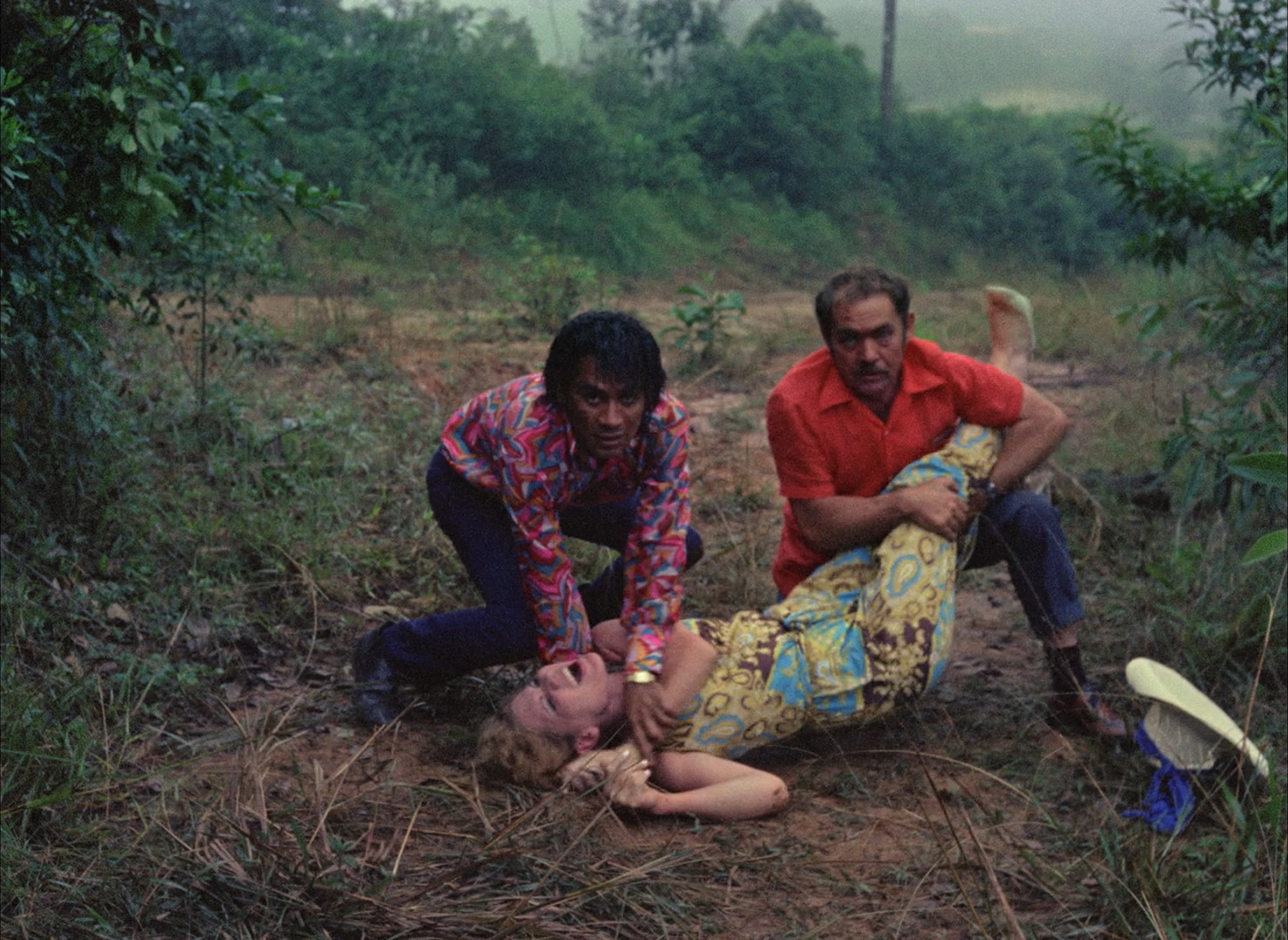 opinions
opinions 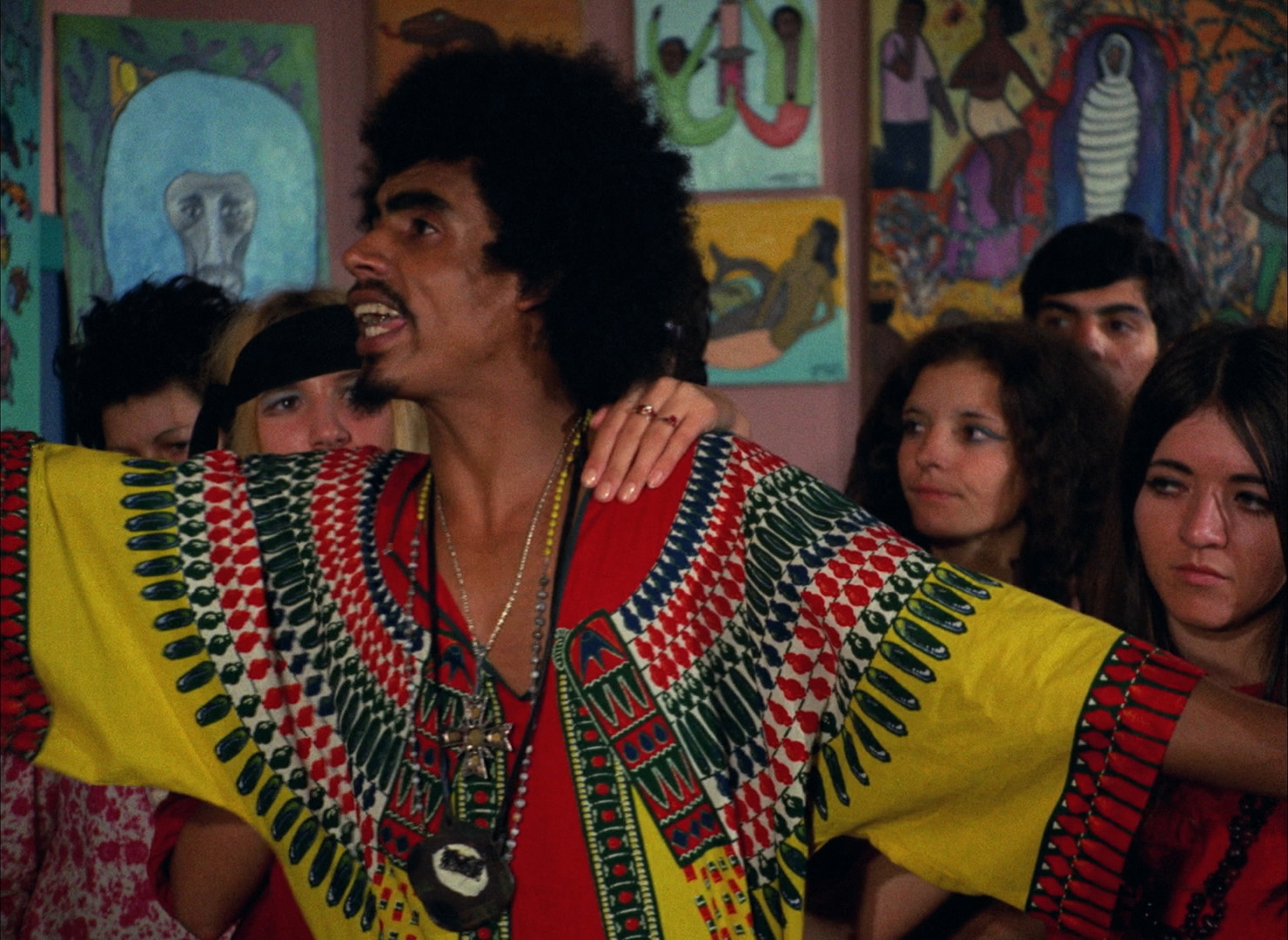 people hold about those around them. As usual, Marins' sense of humor is in abundance here throughout with a fun anarchist streak this time directly aimed at the government and the church in a far less violent fashion than usual. The film is also much easier to appreciate now on Blu-ray with its original vibrant, borderline psychedelic color scheme restored versus the drab look on the tape and the U.K. and Brazilian DVDs; the new 4K restoration from the original 35mm image negatives supplied by Cinemateca Basileira looks absolutely gorgeous. Both films on this disc feature the Brazilian DVD commentaries with Marins, Duarte and Primati, plus the featurette "The Strange Mind of Coffin Joe" (18m25s) with author Guy Adams in a graveyard field ruminating from his own neurodivergent perspective on the more left-field aspects of Marins' work focusing on the fusion of character and filmmaker as well as the unusual rhythms and visual motifs. Then "The Woman for Joe" (17m40s) is a video essay by author Alexandra Heller-Nicholas about Martins' gender politics and treatment of the rape-revenge trope, followed by an alternate main title sequence for The Awakening of the Beast as Ritual dos Sadicos (Ritual of Sadists) (which had to be changed to appease censors). Trailers for both films are also included.
people hold about those around them. As usual, Marins' sense of humor is in abundance here throughout with a fun anarchist streak this time directly aimed at the government and the church in a far less violent fashion than usual. The film is also much easier to appreciate now on Blu-ray with its original vibrant, borderline psychedelic color scheme restored versus the drab look on the tape and the U.K. and Brazilian DVDs; the new 4K restoration from the original 35mm image negatives supplied by Cinemateca Basileira looks absolutely gorgeous. Both films on this disc feature the Brazilian DVD commentaries with Marins, Duarte and Primati, plus the featurette "The Strange Mind of Coffin Joe" (18m25s) with author Guy Adams in a graveyard field ruminating from his own neurodivergent perspective on the more left-field aspects of Marins' work focusing on the fusion of character and filmmaker as well as the unusual rhythms and visual motifs. Then "The Woman for Joe" (17m40s) is a video essay by author Alexandra Heller-Nicholas about Martins' gender politics and treatment of the rape-revenge trope, followed by an alternate main title sequence for The Awakening of the Beast as Ritual dos Sadicos (Ritual of Sadists) (which had to be changed to appease censors). Trailers for both films are also included.
Appropriately, disc four kicks off its double feature with the direct sequel to The End of Man, the far more obscure When the Gods Fall Asleep. Here the Finis Hominis character very much recedes into 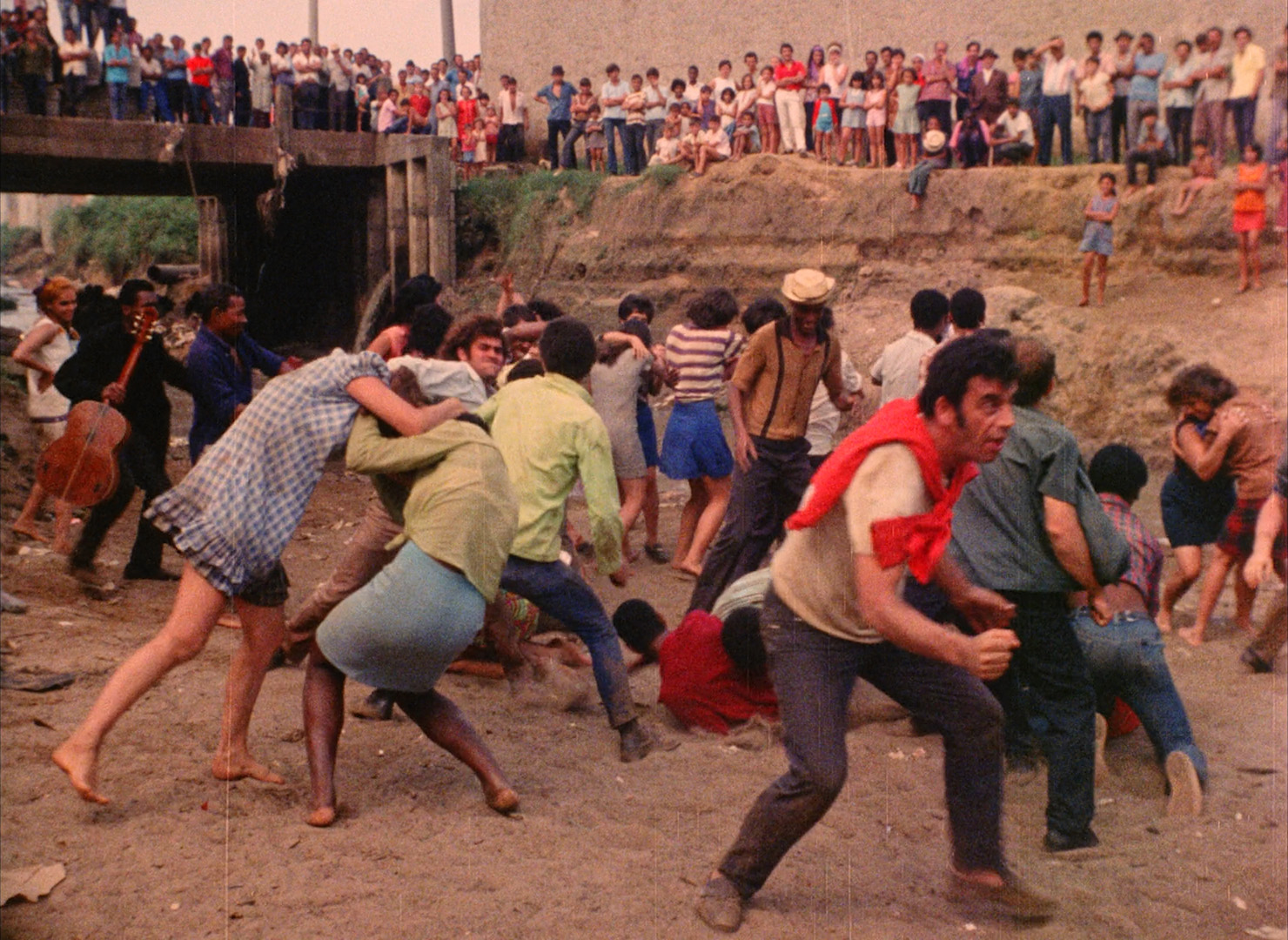 the background for most of the running time after an opener reminding us where he ended up in the prior film; this time
the background for most of the running time after an opener reminding us where he ended up in the prior film; this time 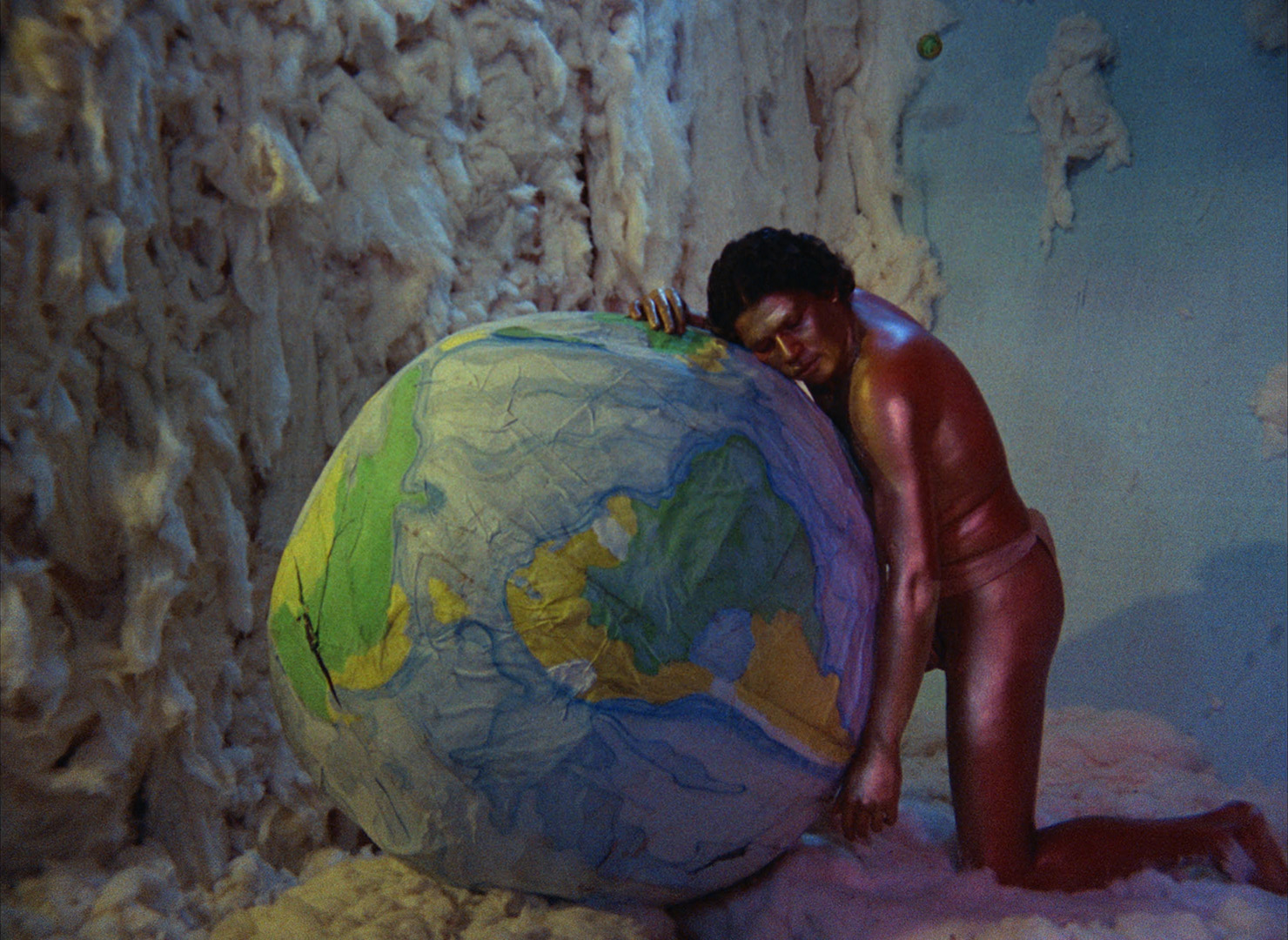 we're thrown into the middle of a gang fight involving guys with names like Chico Swamp and Shark. Soon back out in the wild, Finis Hominis becomes involved with a brutal gang of gypsies and uses his oratory powers to show them the error of their ways, igniting a new movement for unity and faith throughout the land.
we're thrown into the middle of a gang fight involving guys with names like Chico Swamp and Shark. Soon back out in the wild, Finis Hominis becomes involved with a brutal gang of gypsies and uses his oratory powers to show them the error of their ways, igniting a new movement for unity and faith throughout the land.
Saying any more about this one would spoil both films, but Marins casts his net wider here with an even more wry gotcha ending providing a commentary that wouldn't be out of place in The Prisoner. The view of humanity here is definitely on the darker side as well, even veering into shocking mondo territory at the half-hour mark with a truly horrific, protracted sequence involving the live eating and mutilation of chickens that will make even the most jaded viewers flinch. You also get a crazy black-and-white cat fight, a goofy sex scene inside barrel, instrumental cover versions of familiar pop songs, and other visual oddities. Apart from a brief release from Something Weird on VHS, the only way to really see this was a miserable unsubtitled bootleg copy that had all the extreme material removed, making it a truly pointless experience. The Arrow release is sourced from a 4K restoration of the only known existing print, and fortunately it's uncut and in excellent shape with color and detail that are pretty astounding given the film's rarity.
Also on 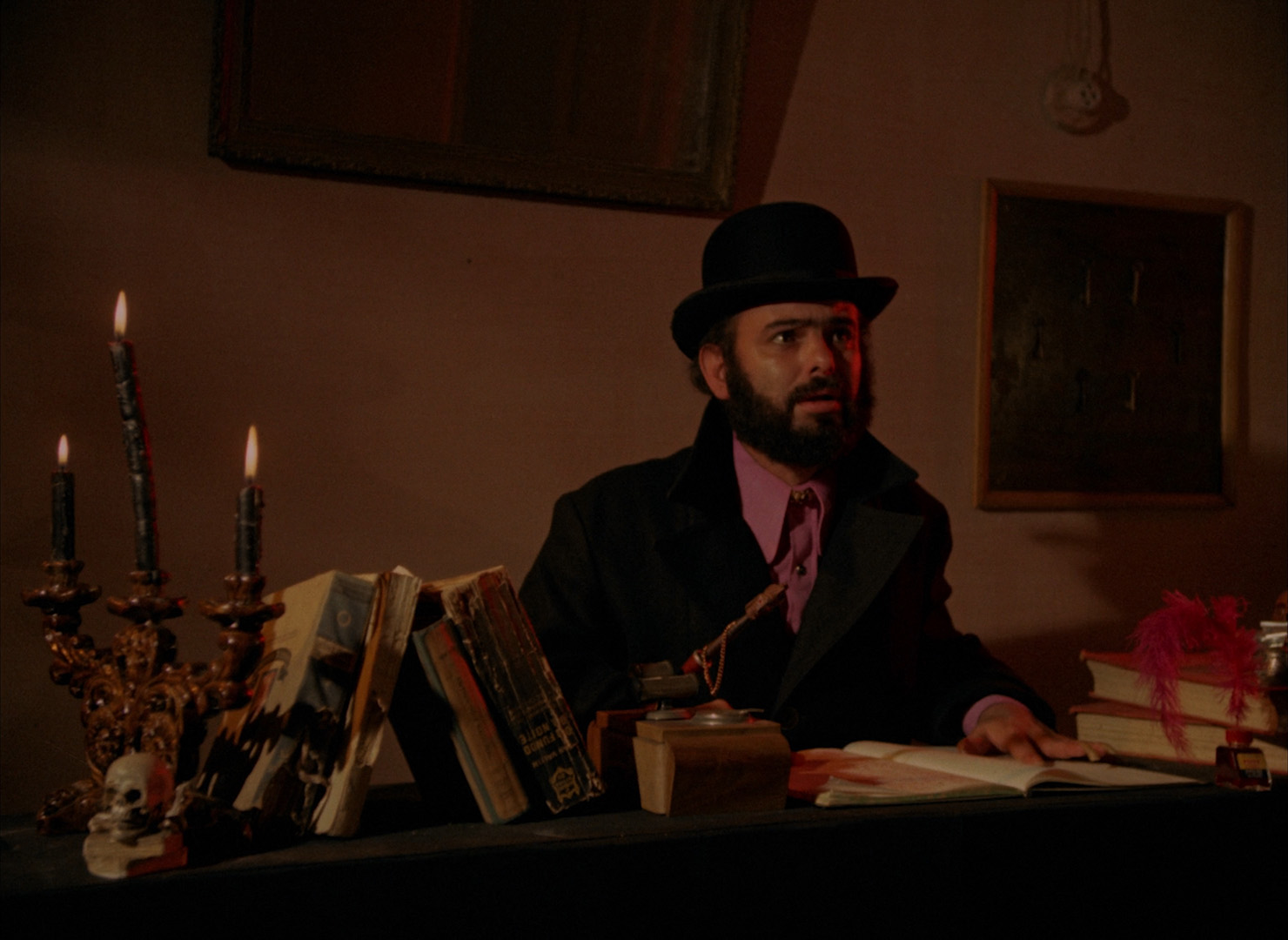 disc four is the much more familiar and irresistibly titled The Strange Hostel of Naked Pleasures, another
disc four is the much more familiar and irresistibly titled The Strange Hostel of Naked Pleasures, another 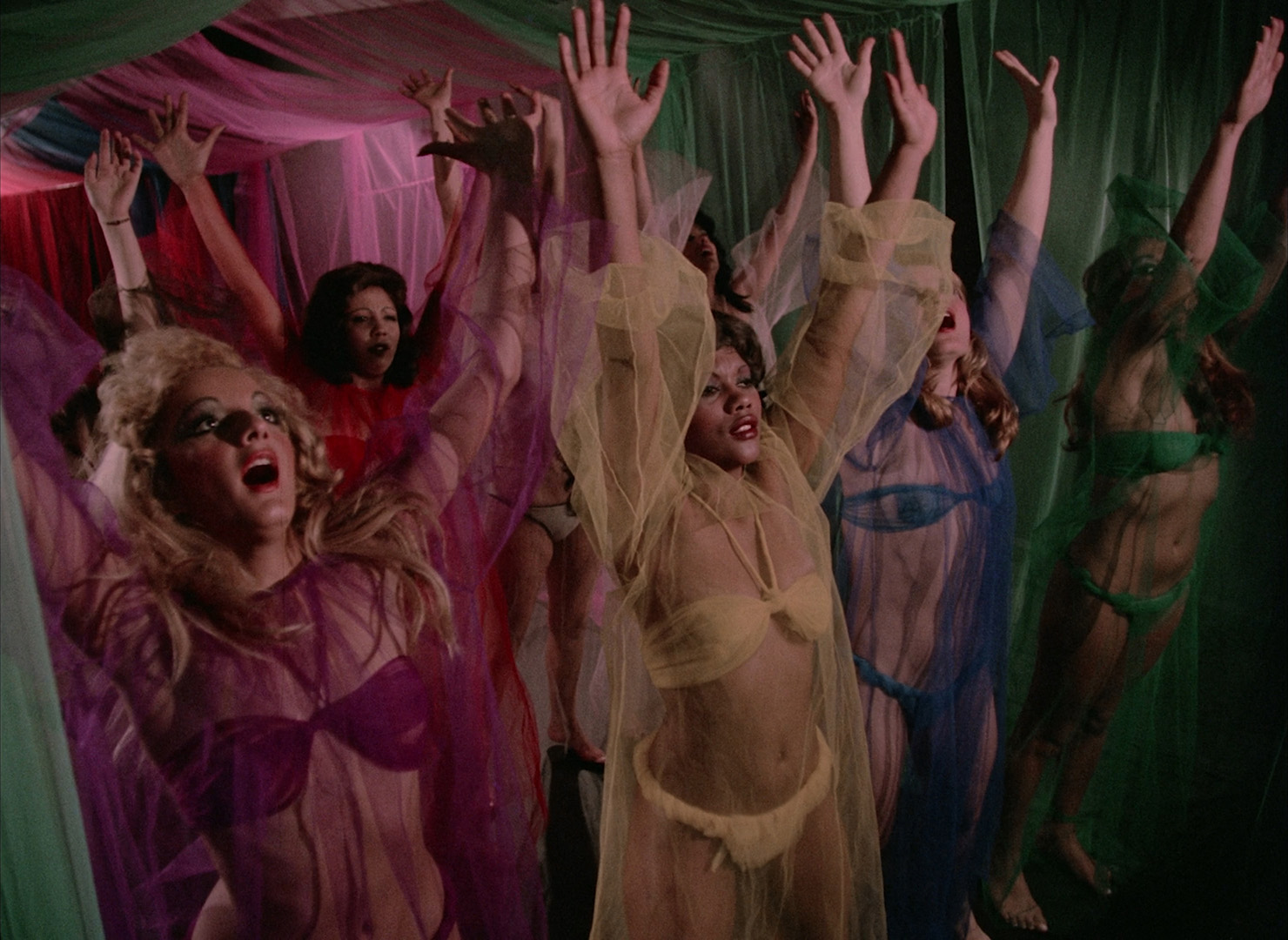 "sorta kinda but not quite" Coffin Joe outing made on the heels of his meta mindbender Exorcismo Negro (or The Bloody Exorcism of Coffin Joe), not included here due to insurmountable music rights issues. Credited to Marcelo Motta as director with Marins pitching in as much as he could during a busy time, this is essentially Twilight Zone territory as a dozen random guests including gamblers, adulterers, and other fishy characters are invited to spend the night at a remote hostel on a stormy night. The owner (Marins), who may or may not be the Coffin Joe-style figure we see during a wild prologue, seems to be toying with them including withholding some of the lodgings, which sets the stage for a dark night of twists and turns.
"sorta kinda but not quite" Coffin Joe outing made on the heels of his meta mindbender Exorcismo Negro (or The Bloody Exorcism of Coffin Joe), not included here due to insurmountable music rights issues. Credited to Marcelo Motta as director with Marins pitching in as much as he could during a busy time, this is essentially Twilight Zone territory as a dozen random guests including gamblers, adulterers, and other fishy characters are invited to spend the night at a remote hostel on a stormy night. The owner (Marins), who may or may not be the Coffin Joe-style figure we see during a wild prologue, seems to be toying with them including withholding some of the lodgings, which sets the stage for a dark night of twists and turns.
Though Marins had been using color in an aggressive and stylized fashion for years by this point, Strange Hostel and its different director pivot things in a different direction here with an approach far more akin to European horror films in vogue at the time. The primary location is often bathed in vibrant red lighting worthy of Mario Bava or Jean Rollin, and the tracking camerawork makes interesting use of windows and wood surfaces to create an off-kilter environment representing a true midnight of the soul. The opening sequence is easily the most traditional Coffin Joe-style bit in the film with its crazed dance routines 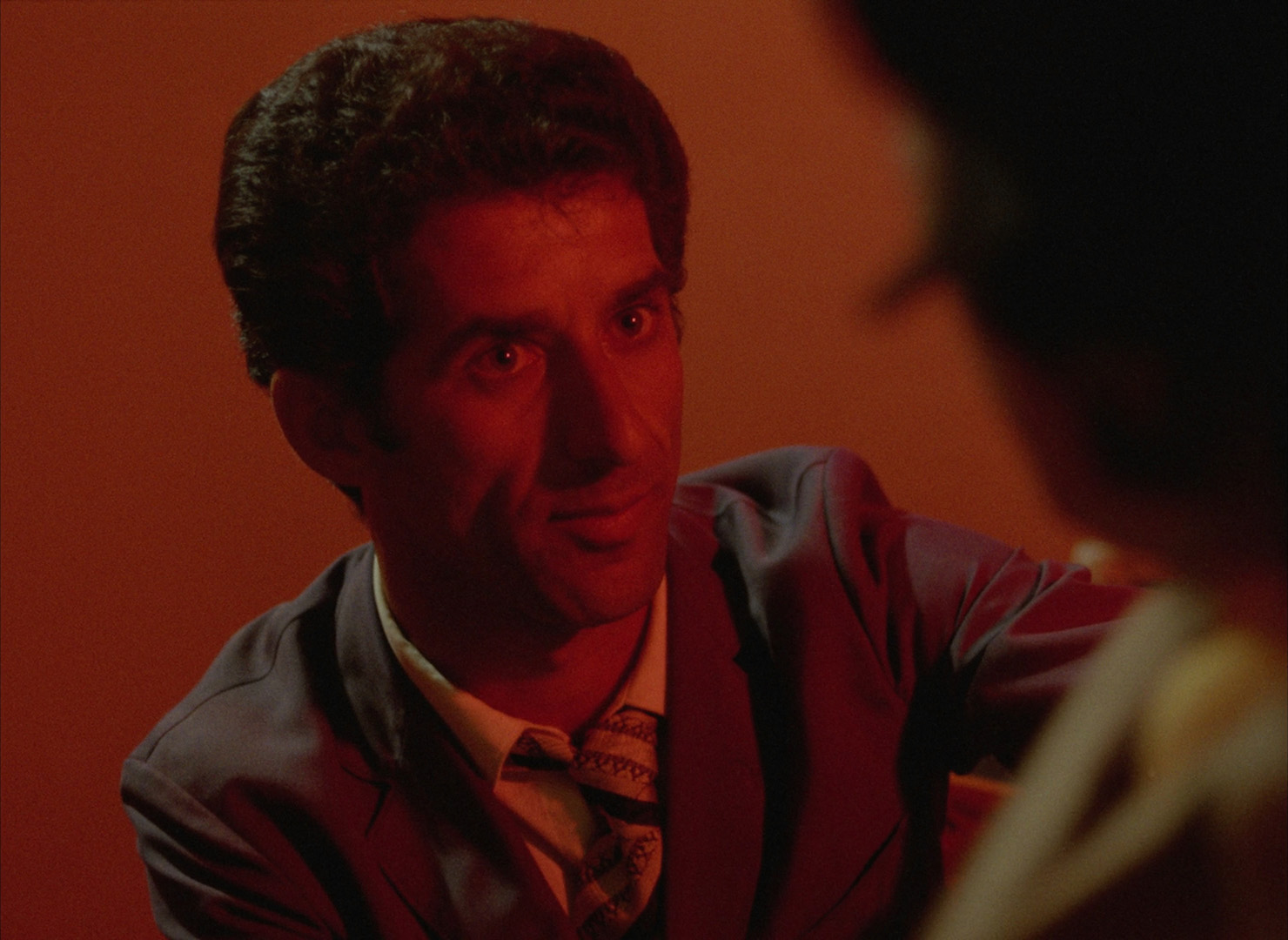 and infernal resurrection ritual, something that has given this film something of a lesser reputation as everything after that it is
and infernal resurrection ritual, something that has given this film something of a lesser reputation as everything after that it is 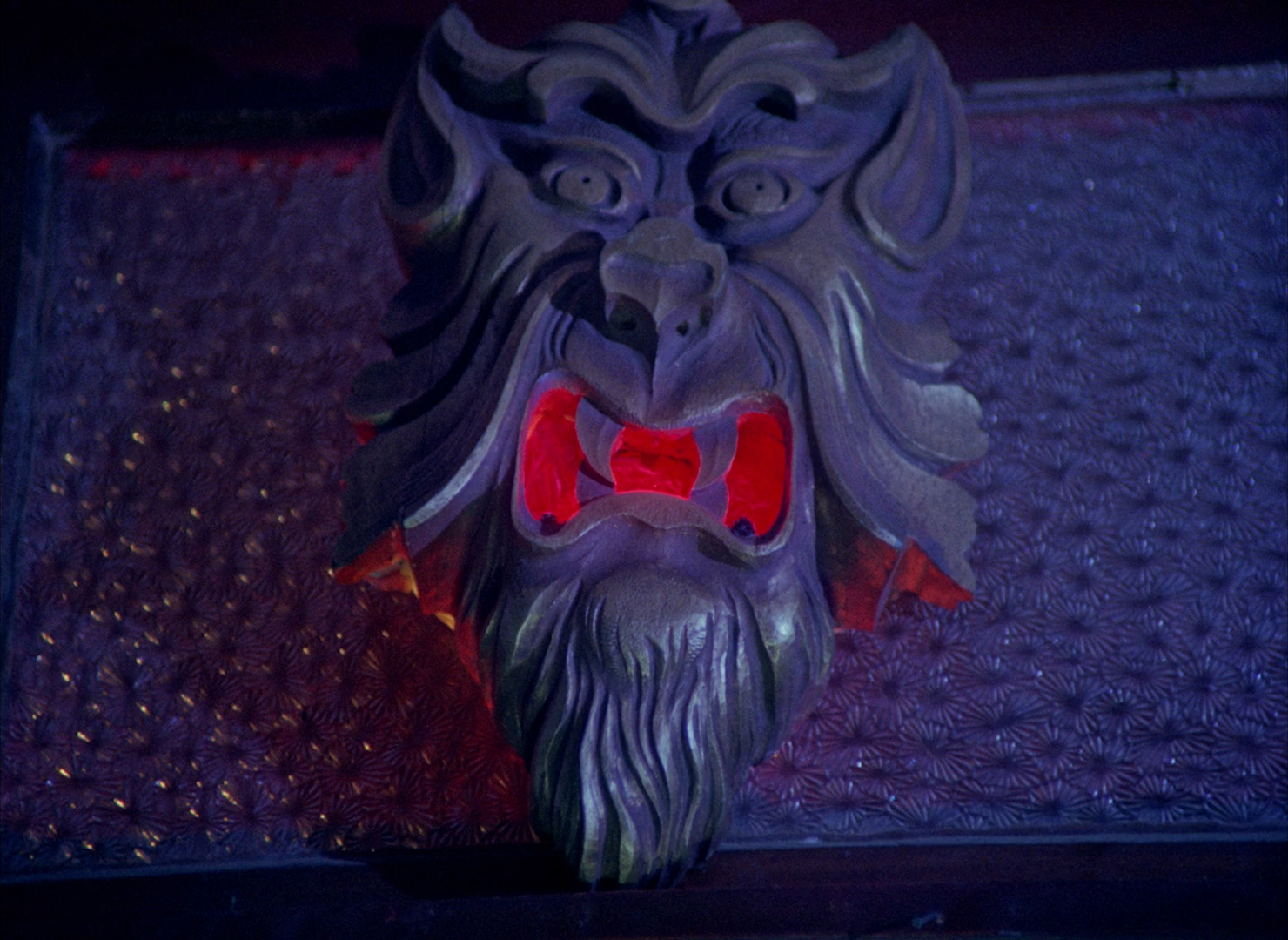 more traditional compared to its predecessors. There's a lot of fun to be had though with some ooga-booga scare moments and enough bare flesh to justify the title, though anyone expecting a softcore extravaganza shouldn't get their hopes up.
more traditional compared to its predecessors. There's a lot of fun to be had though with some ooga-booga scare moments and enough bare flesh to justify the title, though anyone expecting a softcore extravaganza shouldn't get their hopes up.
Another one first seen subtitled in the '93 Something Weird VHS batch, this one later did the DVD rounds looking quite good in the U.K. and Brazil but has never appeared as brilliant as it does on the Blu-ray. The original 35mm camera negative yields stunning results here with a wild kaleidoscope of colors and textures, and the heavy element damage in past transfers is completely gone here. Neither of the films on this disc has a commentary, but "The Demonic Surrealism of Coffin Joe" (25m42s) is a new interview with filmmaker Virginie Sélavy about the links between Marins and European and South American surrealist figures like Georges Franju and Luis Buñuel. Then in "Delirium, Surrealism, and Vision" (13m33s), author Jack Sargeant (Deathtripping: The Cinema of Transgression) tackles the inflammatory nature of Coffin Joe's addresses to the audience and the deliberate toppling of social and cinematic conventions through the films in this set. In "Apostle of Evil" (10m46s), filmmaker Dennison Ramalho (more on him below) chats about his initial exposure to the work of Marins and his first encounters in the mid-'90s that led to a creative union. The amusing "Mojica in the Snow: Tonight I Incarnate at Sundance!" (15m11s) captures Martins' appearance at the Sundance Film Festival in 2001, where he rubbed shoulders with an assortment of names like Michael Stipe. Finally you get the trailer for Strange Hostel and the comic short film A Blind Date for Coffin Joe (9m42s), a short film by Raymond “Coffin Ray” Castile who depicts the familiar 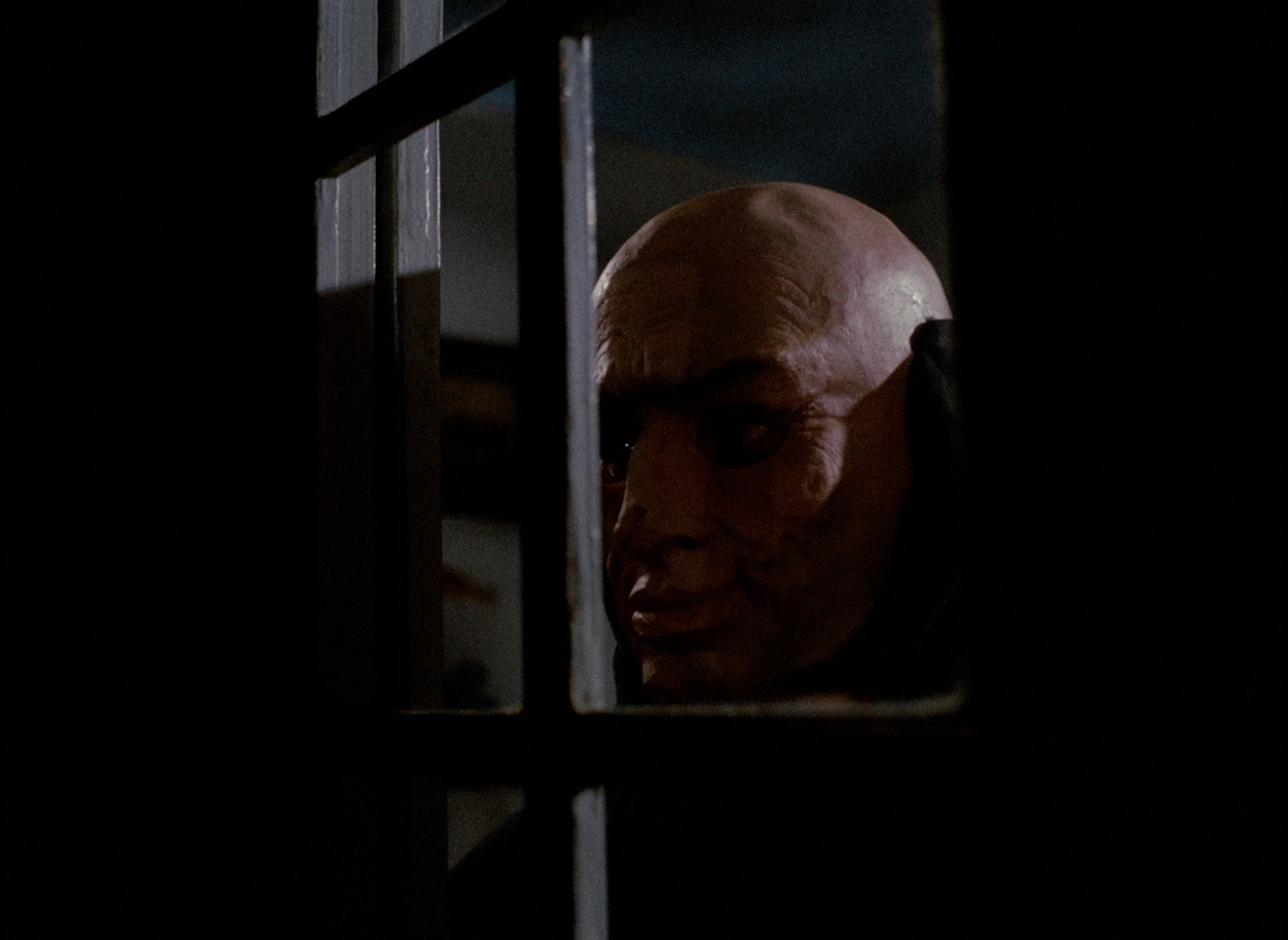 character in a most unfamiliar
character in a most unfamiliar 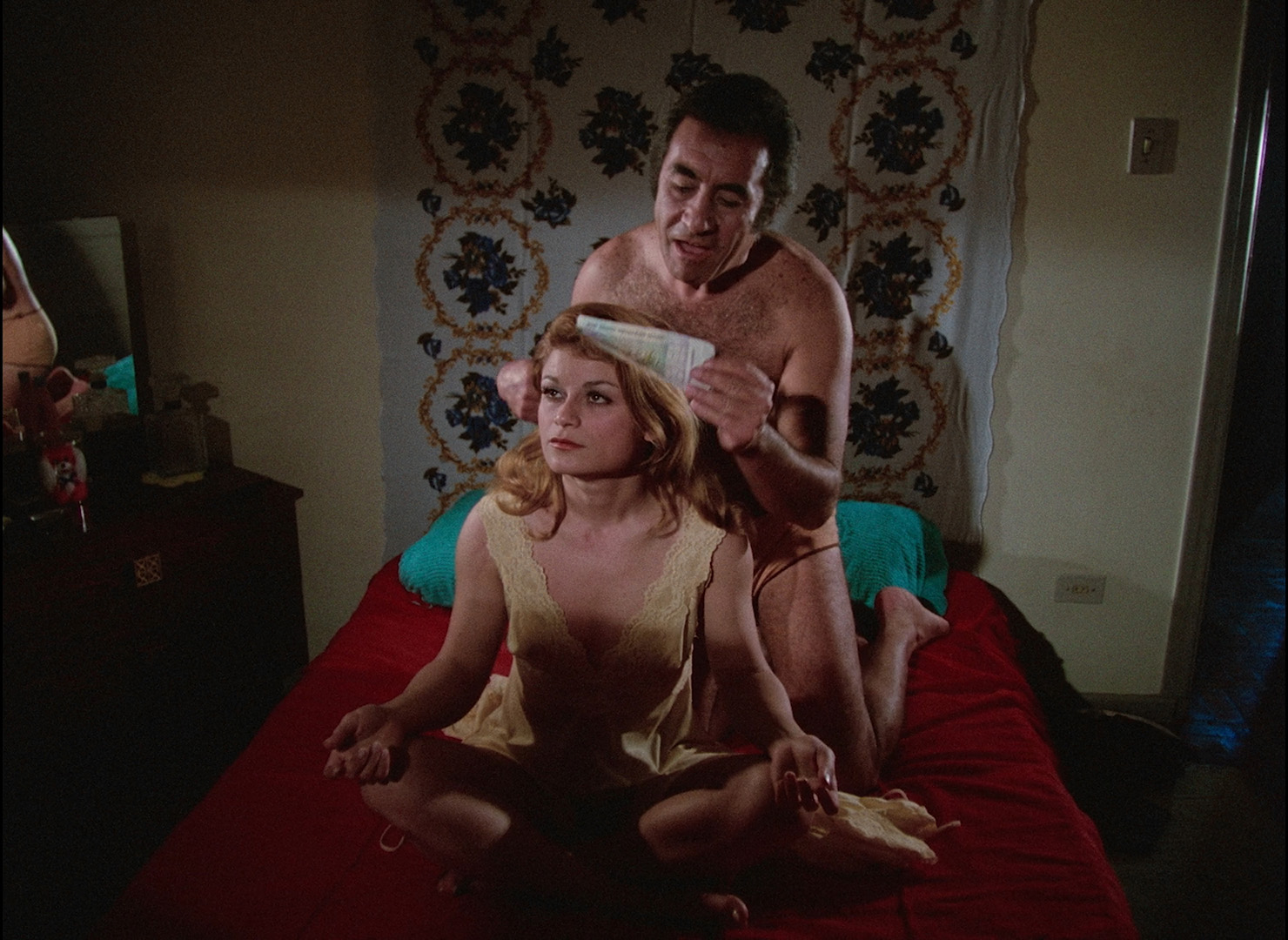 restaurant setting.
restaurant setting.
On we go to disc five for the last stretch of Marins' 1970s output starting with 1977's Hellish Flesh (or to go by its much cooler Portuguese title, Inferno Carnal). At least superficially, this is the most conventional film in the set as it offers a Marinsified take on Diabolique-inspired thrillers about scheming spouses and elaborate murder plots. However, his fixation with bodily mutilation and the sicker side of human relationships is well in abundance here along with his trademark vein of black comedy. Here Marins is the work-obsessed scientist Dr. George Madeiros, who's so obsessed with his beakers that he utterly neglects his wife, Raquel (Figueiró). In turn she falls into the arms of family friend Oliver (de Souza), which ignites a plan to kill George and wallow in his money. The plan involving acid and a lot of fire doesn't quite go as planned, but at least the doc is out of the way for a while as our couple starts to spend his cash... with a high price.
Melodramatic and stylish, this is clearly a bid for more commercial territory from Marins -- but it's still pretty far out with some goopy makeup effects and a key role for pornochanchada star Helena Ramos among its many delights. The triple twist final act is up there with the nuttier excesses of gialli around the same time, and even with a limited cast of characters, you'll have fun trying to figure out exactly who's double crossing whom. Of course, the real show stopper here is a prolonged eye surgery scene, reportedly done for real on Marins himself 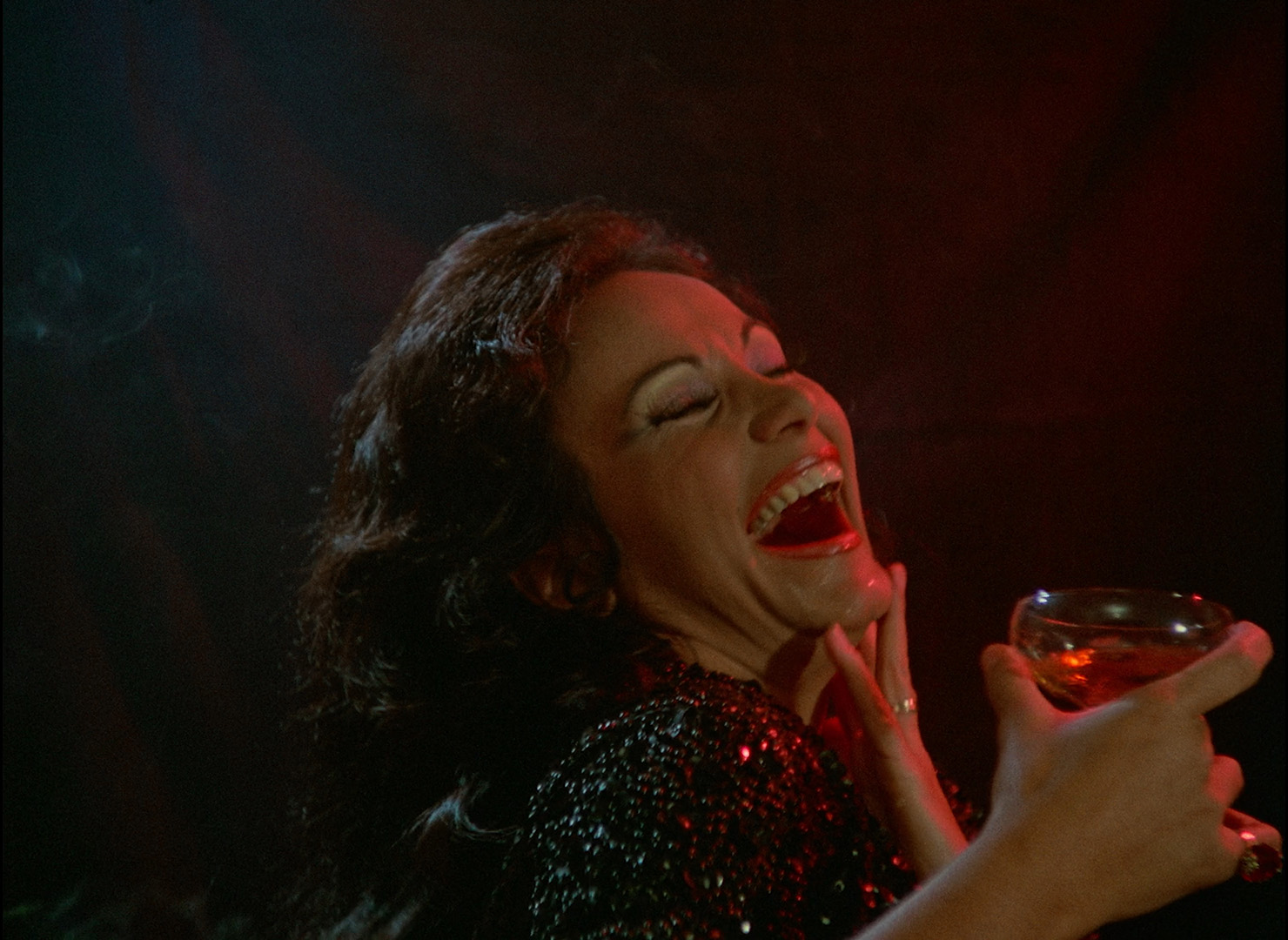 with the queasy results you'd expect. This one stayed out of U.S. circulation for ages after its first Something Weird
with the queasy results you'd expect. This one stayed out of U.S. circulation for ages after its first Something Weird 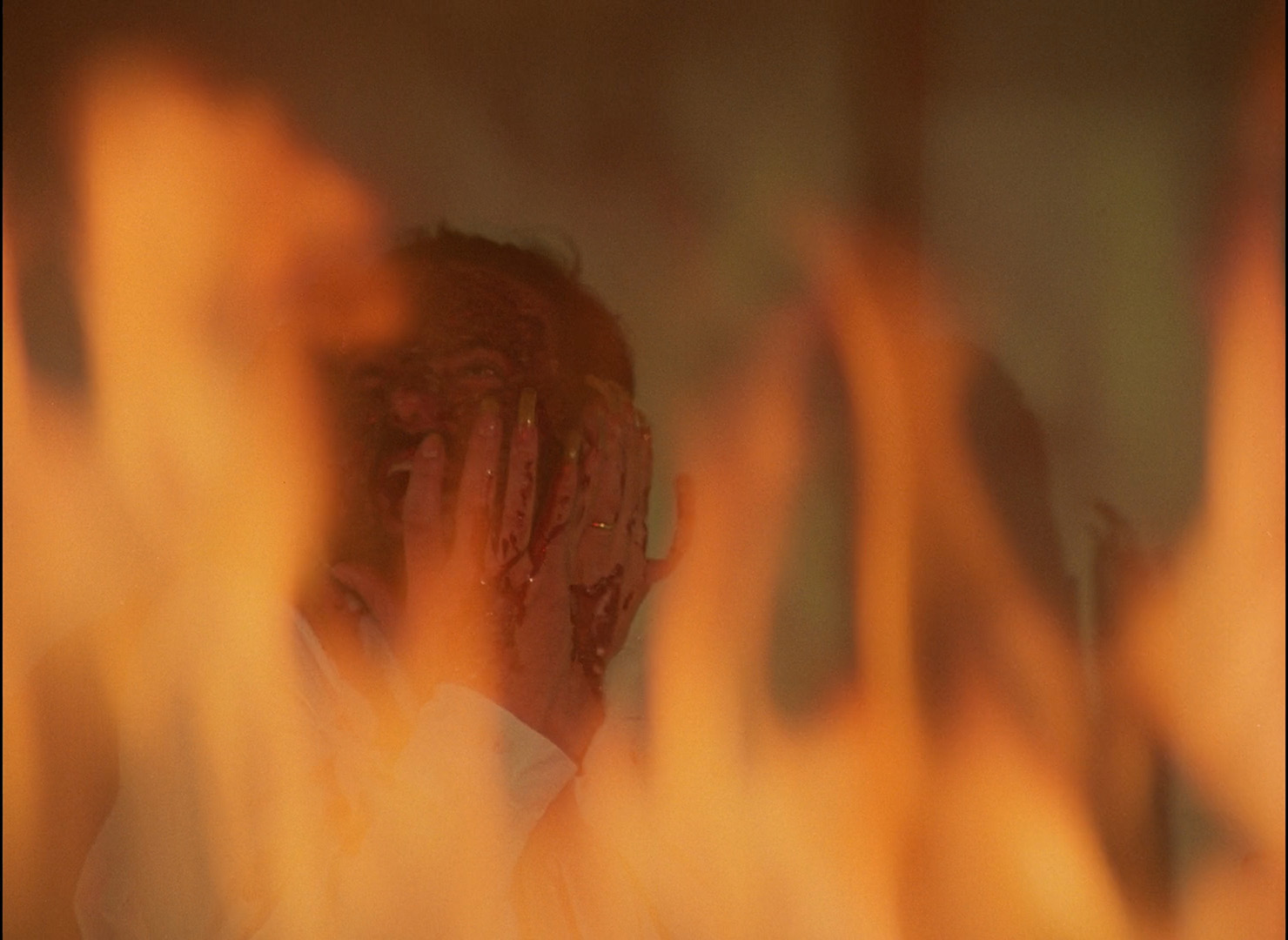 VHS, turning up as usual on DVD later in Brazil and the U.K. The story's the same here with the Arrow Video Blu-ray presenting an immaculate 4K restoration from the original 35mm camera negative and looking faultless here.
VHS, turning up as usual on DVD later in Brazil and the U.K. The story's the same here with the Arrow Video Blu-ray presenting an immaculate 4K restoration from the original 35mm camera negative and looking faultless here.
Released in 1978, Hallucinations of a Deranged Mind (Delírios de um Anormal) is even more of a greatest hits package than Awakening of the Beast, here pulling together a combination of extreme footage from his earlier films that hit the cutting room floor and new bits of body horror to maintain the film's almost nonstop air of wild delirium. Here Coffin Joe is a ferocious boogeyman in the recurring dreams of Dr. Hamilton (Peres), a psychiatrist who's convinced that his wife is the latest target in the maniac's quest for female birthing candidates. A plot is hatched in between hallucination sequences to help the doc by bringing in the real Marins (as himself) to prove that Coffin Joe is just a psychological manifestation. Of course, we know how these kinds of therapy approaches tend to play out.
Obviously you'll get serious deja vu here as the film trots out highlights from Mojica's major earlier films, this time with even more grotesque imagery than usual including lots of screaming bodies fused together in a Brian Yuzna-style mass of writhing flesh. By this point Marins was quite comfortable playing around with his public image, which (like Paul Naschy at the same time) was 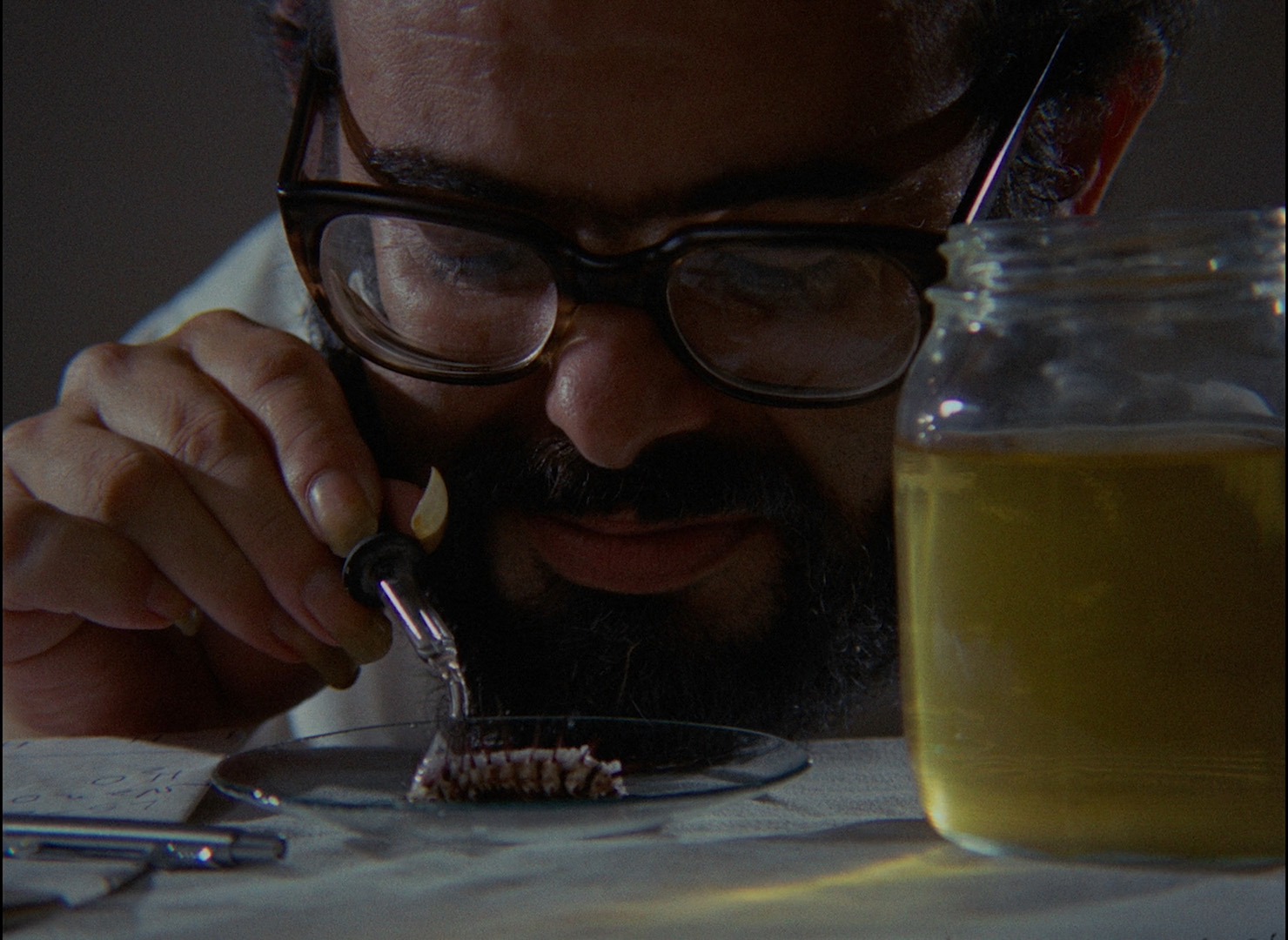 starting to move into quaint elder statesman territory instead of horror pioneer. The gambit didn't really do much to keep the Coffin Joe brand alive though, as Marins wouldn't really do anything worthy of its original mojo again after this until 1987's Demons and Wonders (almost omitted
starting to move into quaint elder statesman territory instead of horror pioneer. The gambit didn't really do much to keep the Coffin Joe brand alive though, as Marins wouldn't really do anything worthy of its original mojo again after this until 1987's Demons and Wonders (almost omitted 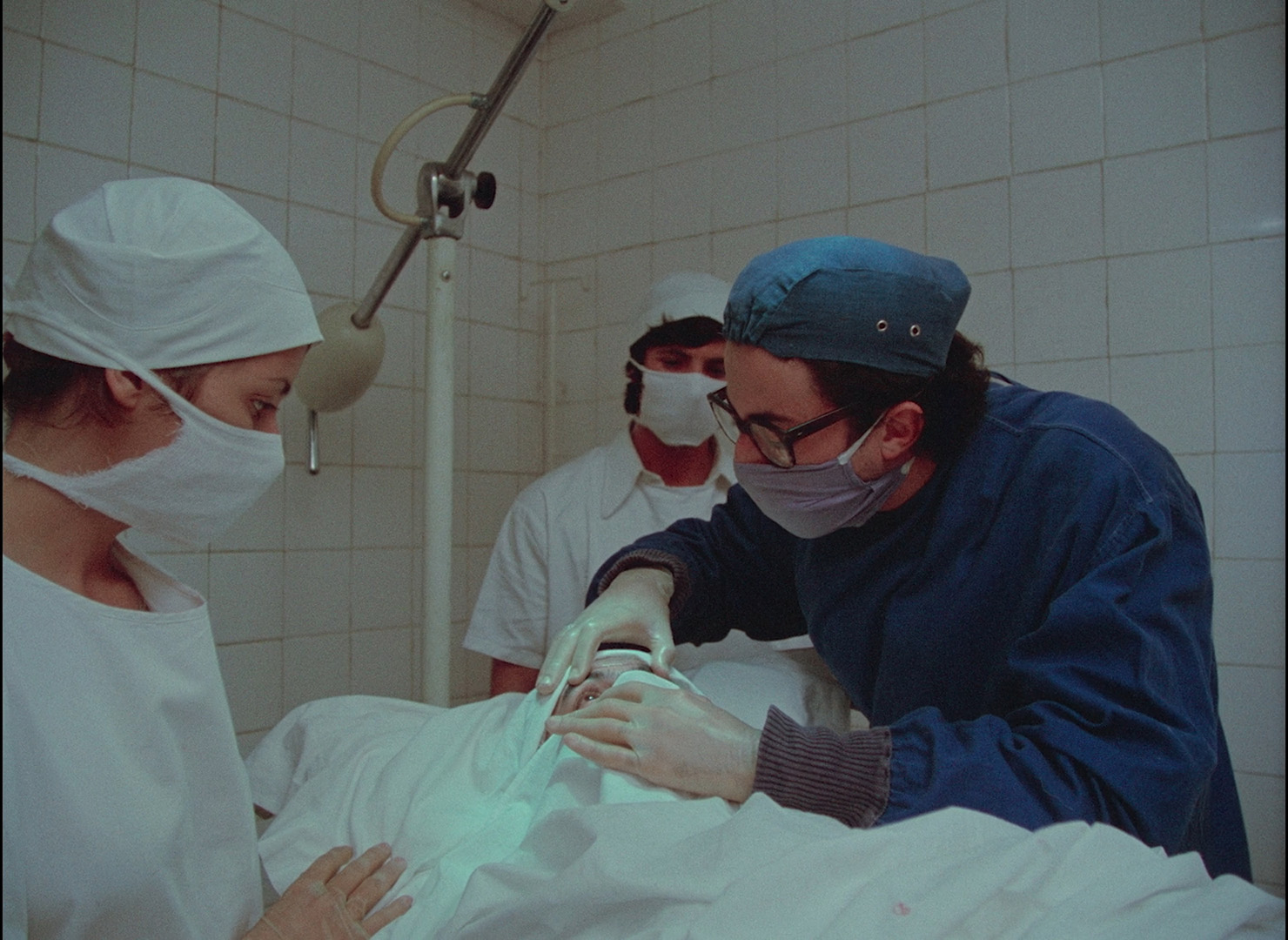 here, presumably over its music). This one followed the same home video trail as Hellish Flesh, bouncing from VHS to U.K. and Brazilian DVD with the latter having an audio commentary (with Marins, editor Nilcemar Leyart, Paulo Duarte and Carlos Primati) carried over for the Arrow Video Blu-ray. The new 4K restoration from the original 35mm camera negative is another dramatic bump with more accurate color, no more damage, and far deeper blacks. "Aesthetics of Garbage: José Mojica Marins, a Complicated Icon" (30m56s) features The Search for Weng Weng filmmaker Andrew Leavold (in full Coffin Joe regalia) examining Marins' place in multiple Brazilian cinematic movements of the '60s and '70s including the Marginal Cinema and some of the weirder alleys the filmmaker encountered in later years (like this). Then in "Beyond Good and Evil" (15m31s), film critic Kat Ellinger looks at Marins' relationship to Nietzsche and the Gothic tradition to which he may tip his hat at times. Finally both films' respective trailers are included.
here, presumably over its music). This one followed the same home video trail as Hellish Flesh, bouncing from VHS to U.K. and Brazilian DVD with the latter having an audio commentary (with Marins, editor Nilcemar Leyart, Paulo Duarte and Carlos Primati) carried over for the Arrow Video Blu-ray. The new 4K restoration from the original 35mm camera negative is another dramatic bump with more accurate color, no more damage, and far deeper blacks. "Aesthetics of Garbage: José Mojica Marins, a Complicated Icon" (30m56s) features The Search for Weng Weng filmmaker Andrew Leavold (in full Coffin Joe regalia) examining Marins' place in multiple Brazilian cinematic movements of the '60s and '70s including the Marginal Cinema and some of the weirder alleys the filmmaker encountered in later years (like this). Then in "Beyond Good and Evil" (15m31s), film critic Kat Ellinger looks at Marins' relationship to Nietzsche and the Gothic tradition to which he may tip his hat at times. Finally both films' respective trailers are included.
In 2008, Marins finally released the 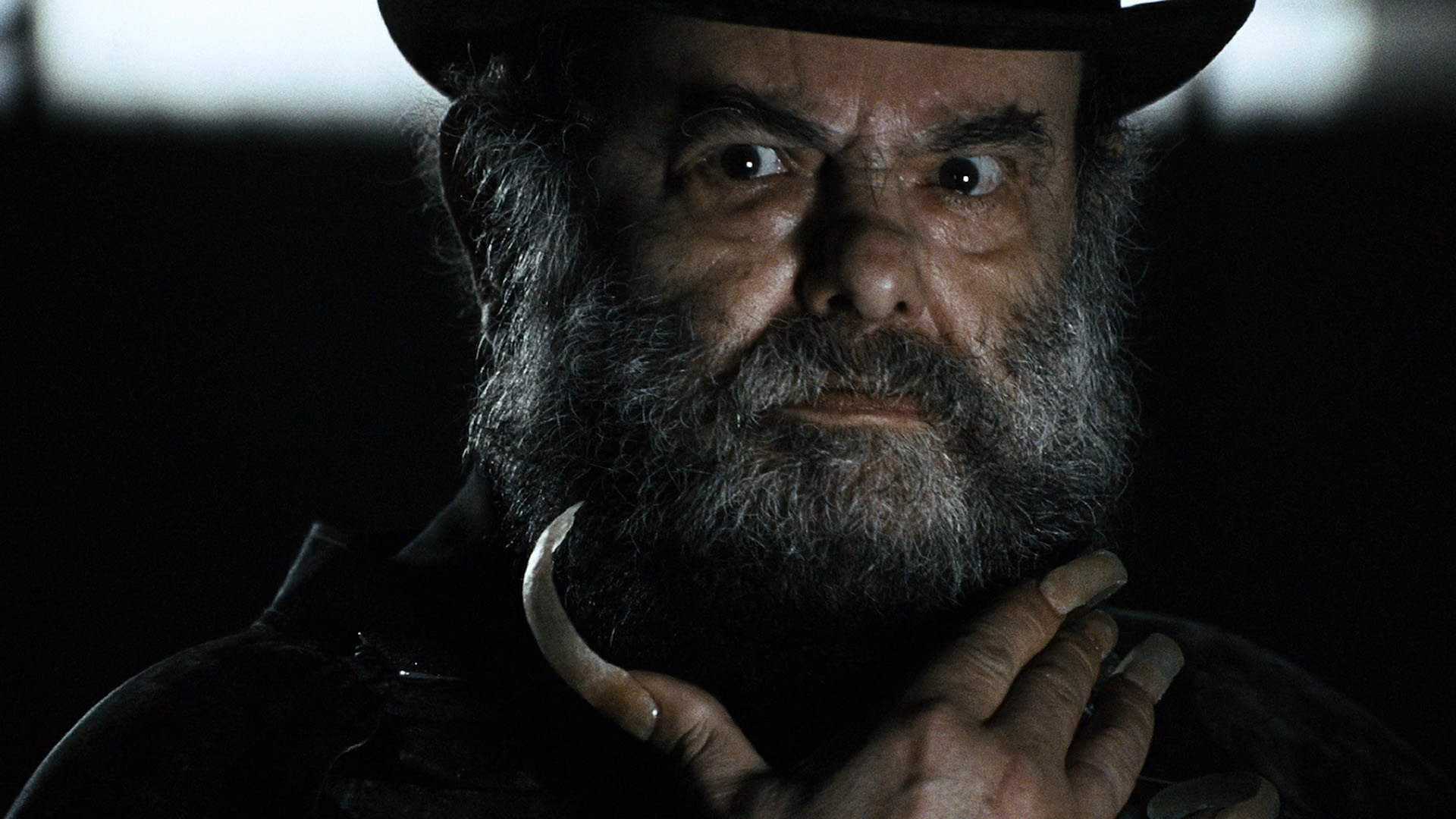 third official installment in his Coffin Joe feature series, Embodiment of Evil, and everyone had to wonder: how and why do you bring a character so associated with the excessive '60s and '70s into the modern era? The answer comes right away as we meet a much grayer and even
third official installment in his Coffin Joe feature series, Embodiment of Evil, and everyone had to wonder: how and why do you bring a character so associated with the excessive '60s and '70s into the modern era? The answer comes right away as we meet a much grayer and even 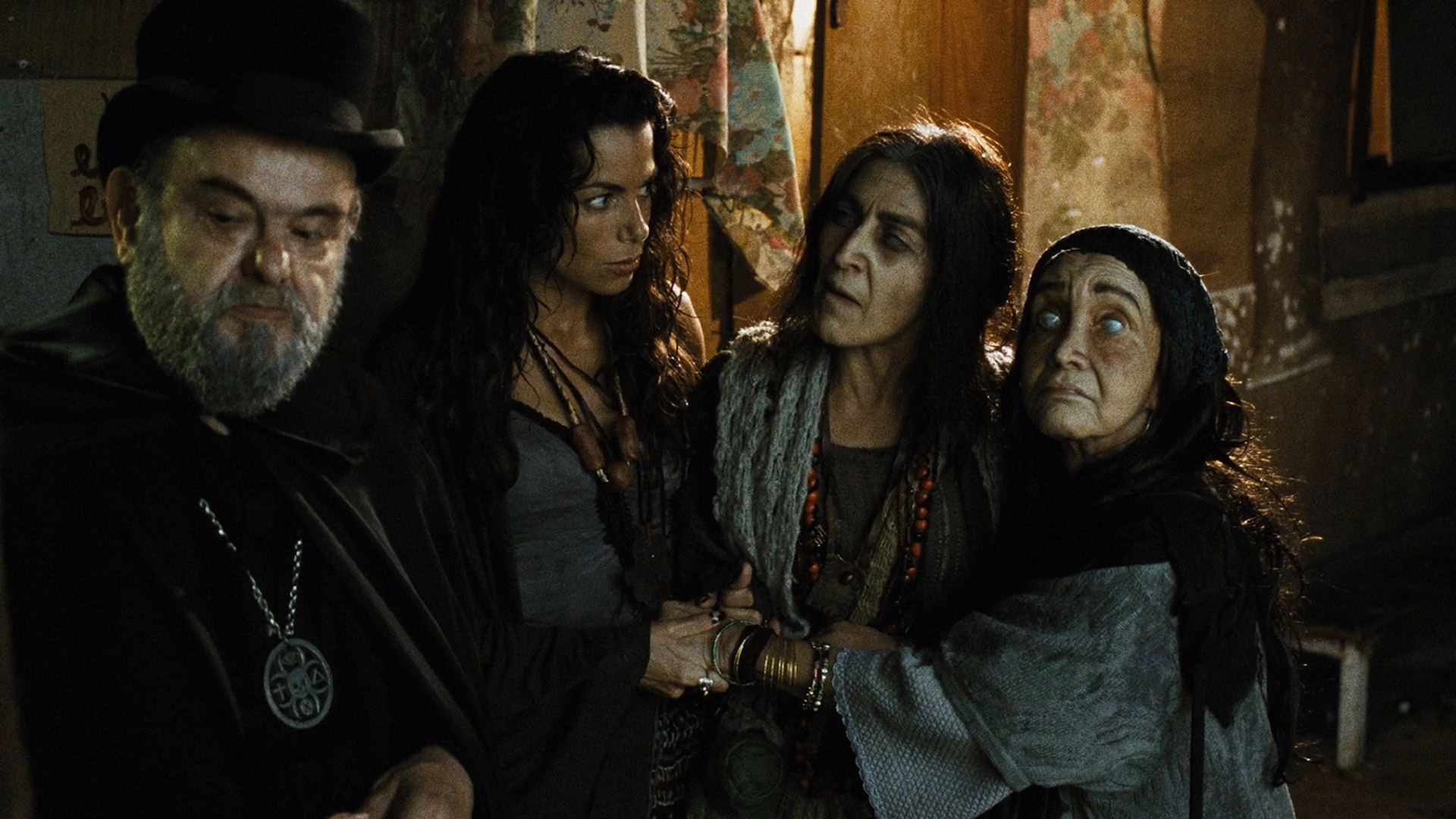 madder-looking Coffin Joe locked away in an asylum where, after decades of incarceration for vile crimes against humanity, he's freed thanks to the efforts of an attorney (Aché) and joins his hunchbacked sidekick, Bruno (Resende), to resume his depraved activities. However, the slums have become very different over the passage of time; on top of that, a nasty colonel (Valadão) and police captain (Stuart) have their sights set on making Joe pay for his misdeeds. Undeterred, he rounds up some new disciplines (whom he initiates through fun tricks like ordering them to fire pistols at their skulls) and embarks on a new mission to sire an evil heir. Along the way he's tortured by black-and-white flashbacks from the first two films, with his ghostly victims attacking him as equally monochromatic phantoms. With both women and men subjected to a string of ghoulish torments, can Joe be stopped before his mission is completed?
madder-looking Coffin Joe locked away in an asylum where, after decades of incarceration for vile crimes against humanity, he's freed thanks to the efforts of an attorney (Aché) and joins his hunchbacked sidekick, Bruno (Resende), to resume his depraved activities. However, the slums have become very different over the passage of time; on top of that, a nasty colonel (Valadão) and police captain (Stuart) have their sights set on making Joe pay for his misdeeds. Undeterred, he rounds up some new disciplines (whom he initiates through fun tricks like ordering them to fire pistols at their skulls) and embarks on a new mission to sire an evil heir. Along the way he's tortured by black-and-white flashbacks from the first two films, with his ghostly victims attacking him as equally monochromatic phantoms. With both women and men subjected to a string of ghoulish torments, can Joe be stopped before his mission is completed?
It takes a lot to shock horror fans numbed by decades of gore films, but Martins quickly exceeds expectations with Embodiment of Evil. Apart from the opening credits, the film relies on a combination of grisly practical effects, real-life masochists willing to subject themselves to various piercings and insect attacks, and conceptually fearless atrocities, such as a woman forced to eat a highly unusual body part. The film has its moments of beauty as well, especially a third act fantasy sequence with Coffin Joe escorted through 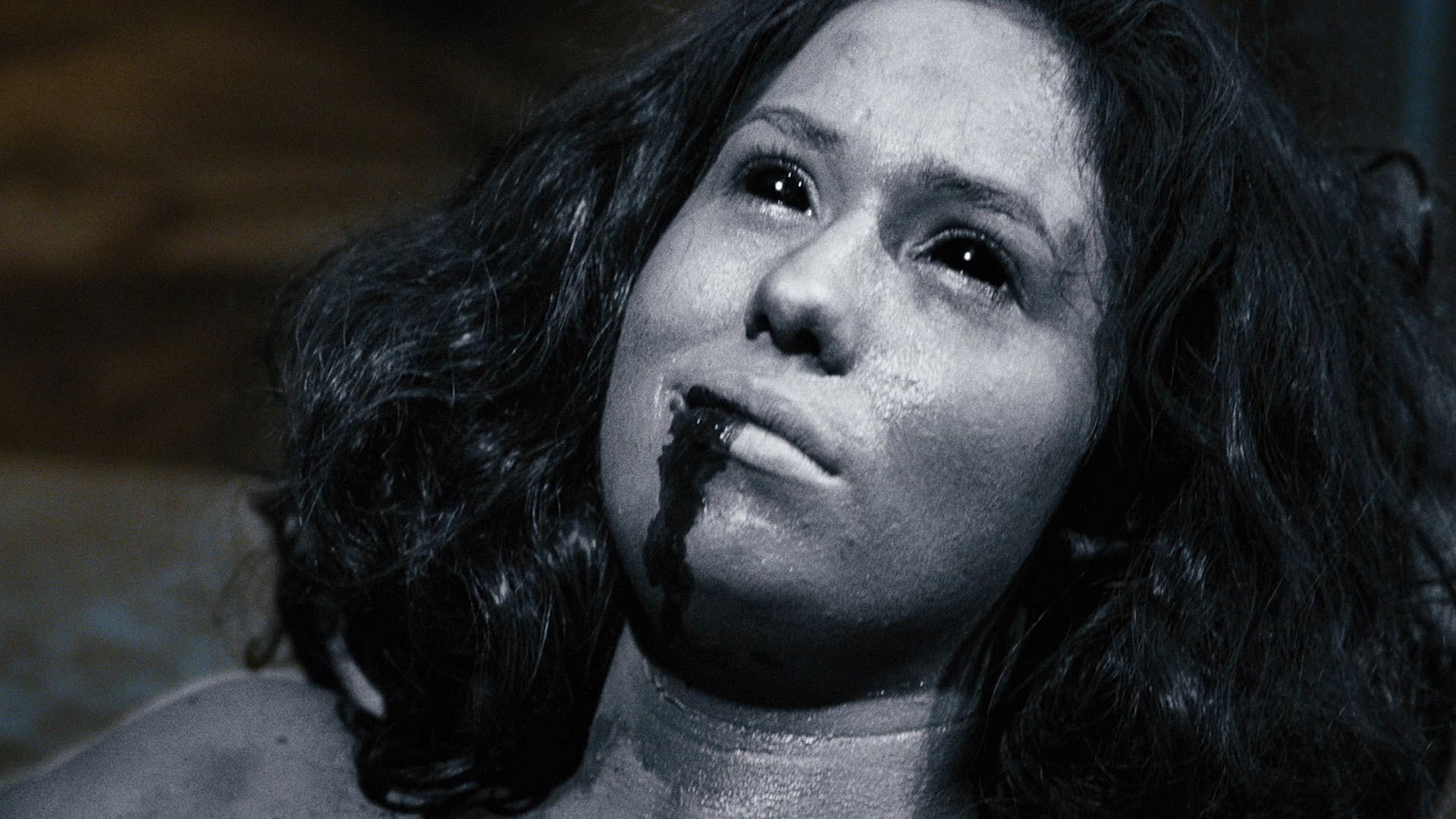 Hell that turns into a fantastic surrealist set piece. Marins' over-the-top acting hasn't changed one iota either; drawing inspiration on some of Vincent Price's
Hell that turns into a fantastic surrealist set piece. Marins' over-the-top acting hasn't changed one iota either; drawing inspiration on some of Vincent Price's 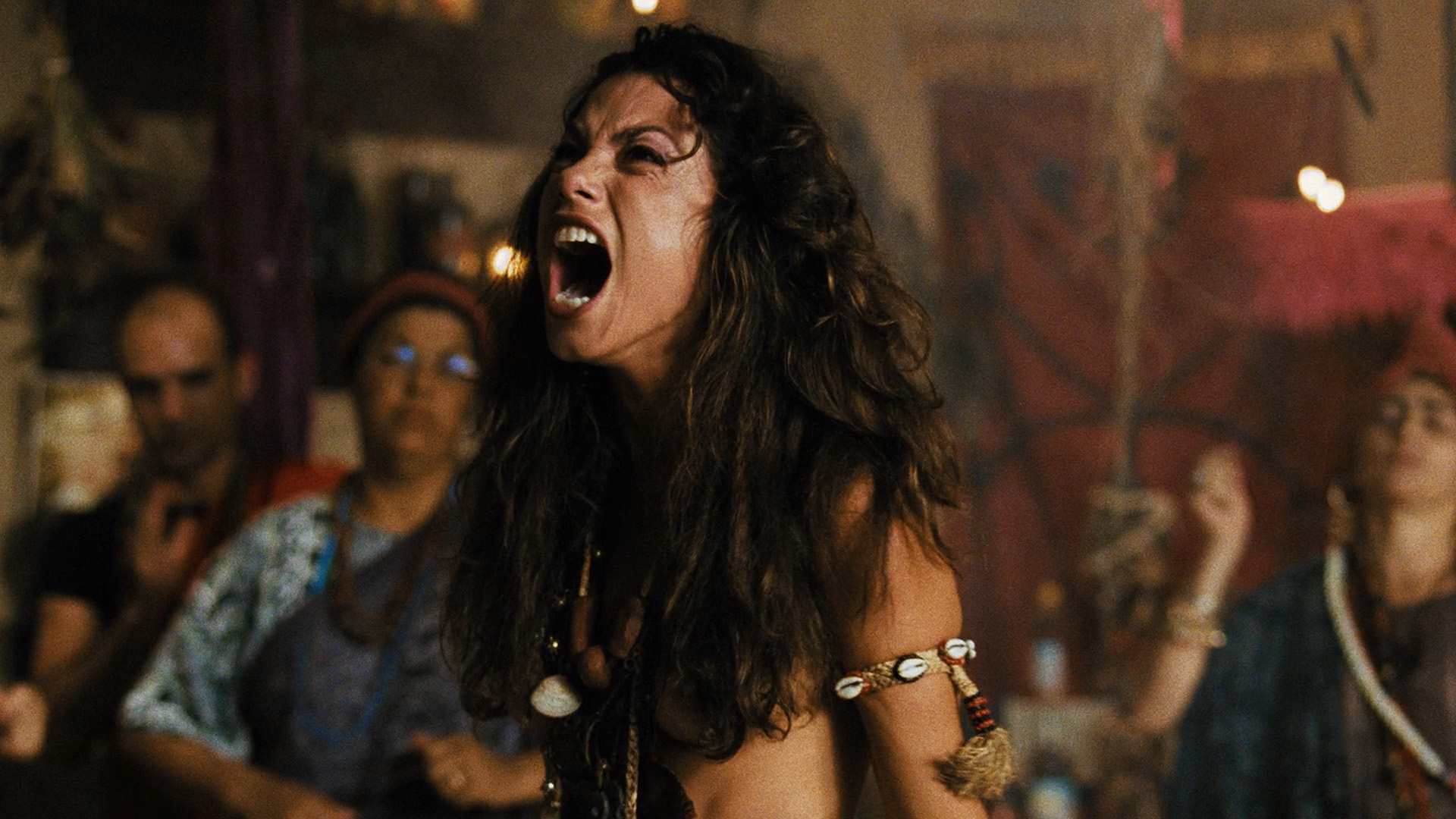 more melodramatic performances but ratcheted through the roof, he turns Coffin Joe into a vivid, barnstorming figure of villainy you can't help secretly rooting for as he undermines all of society's dictates.
more melodramatic performances but ratcheted through the roof, he turns Coffin Joe into a vivid, barnstorming figure of villainy you can't help secretly rooting for as he undermines all of society's dictates.
Through some insane twist, Embodiment Of Evil was picked up for distribution by 20th Century Fox in Brazil, and their logo remained at the head of international releases. The first English-friendly option on home video came in the U.K. from Anchor Bay, whose 2009 DVD was a disastrously bad conversion to PAL from NTSC. Their Blu-ray was better, even if it also suffered from some odd frame rate inconsistencies and a peculiar lack of film grain. It took a while, but Synapse's American edition on Blu-ray and DVD in 2011 was a very pleasing presentation. The Blu-ray looks really terrific thanks to a new scan, with fine detail and an appropriate light dusting of fine film grain throughout. The Portuguese audio (in either DTS-HD 5.1 or 2.0) sounds great, with lots of spacious separation effects and a nicely immersive score. Extras include an entertaining 31m36s making-of featurette (in which we see Marins at work shooting the film and discussing his rationale behind the character), a theatrical trailer, and 14m22s of footage from the film's premiere at Canada's Fantasia Film Festival.
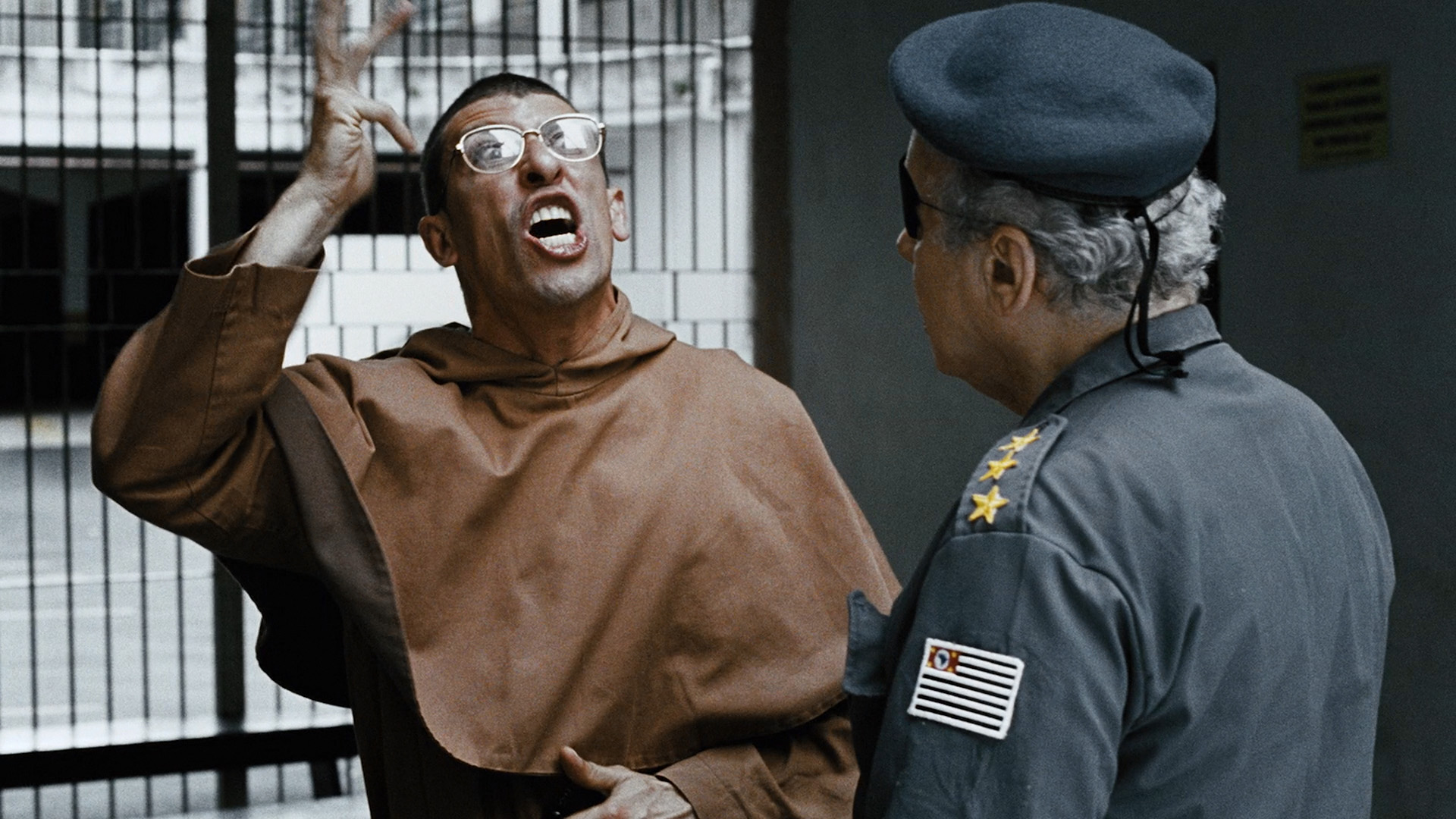 The 2023 Arrow Blu-ray is devoted entirely to this film, with yet another scan that features deeper blacks and punchier
The 2023 Arrow Blu-ray is devoted entirely to this film, with yet another scan that features deeper blacks and punchier 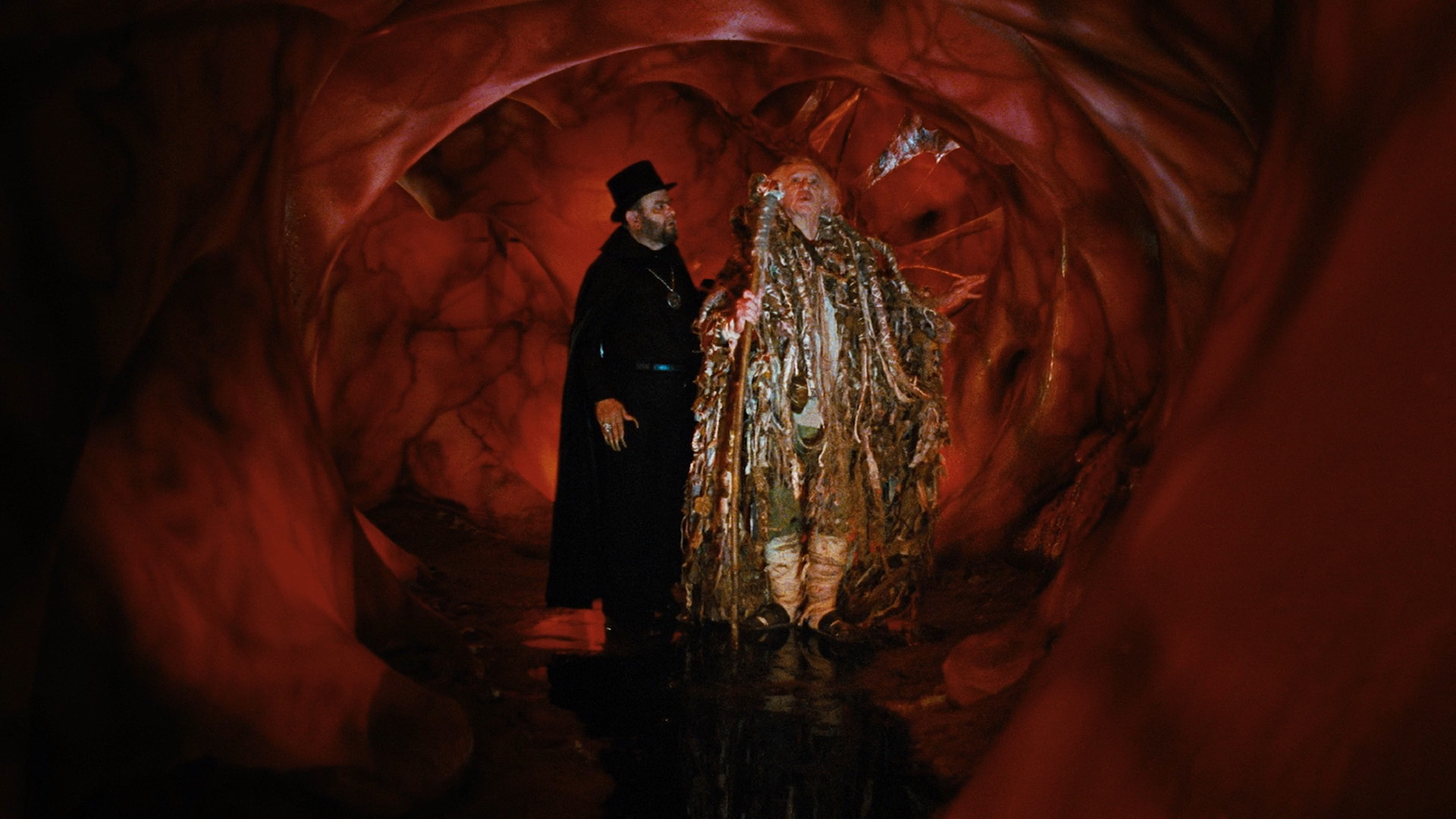 colors while zooming it in a bit to 1.78:1 from the earlier 1.85:1 (with less info on the sides). The DTS-HD MA 5.1 and 2.0 options are both here with English subtitles, plus an archival commentary from its Brazilian run with producer Paulo Sacramento and co-screenwriter Dennison Ramalho (in Portuguese with English subtitles, like the rest of the tracks here). The making-of, Fantasia coverage, and trailer are ported over here, while Ramalho returns for the new featurette "Learning from the Master" (37m40s) about the process of coming up with the story with Marins and tailoring the script for a modern audience who might not be familiar with the original films. Ramalho is also back for "Apprenticeship of Evil" (84m36s), an extensive 2020 interview via Zoom for Fantasia with Mitch Davis in a very in-depth, interesting conversation about Marins' working process, his outlook, the rebirth of fandom among new generations, and the film's reception. Also included are an alternate "experimental making of" (13m25s) with an impressionistic look at the production, a reel of deleted scenes (12m11s) with commentary by Marins, and two brief archival short extras, "Visual Effects: Purgatory" (2m16s) and "Storyboards" (2m7s), both with Marins commentary.
colors while zooming it in a bit to 1.78:1 from the earlier 1.85:1 (with less info on the sides). The DTS-HD MA 5.1 and 2.0 options are both here with English subtitles, plus an archival commentary from its Brazilian run with producer Paulo Sacramento and co-screenwriter Dennison Ramalho (in Portuguese with English subtitles, like the rest of the tracks here). The making-of, Fantasia coverage, and trailer are ported over here, while Ramalho returns for the new featurette "Learning from the Master" (37m40s) about the process of coming up with the story with Marins and tailoring the script for a modern audience who might not be familiar with the original films. Ramalho is also back for "Apprenticeship of Evil" (84m36s), an extensive 2020 interview via Zoom for Fantasia with Mitch Davis in a very in-depth, interesting conversation about Marins' working process, his outlook, the rebirth of fandom among new generations, and the film's reception. Also included are an alternate "experimental making of" (13m25s) with an impressionistic look at the production, a reel of deleted scenes (12m11s) with commentary by Marins, and two brief archival short extras, "Visual Effects: Purgatory" (2m16s) and "Storyboards" (2m7s), both with Marins commentary.
AT MIDNIGHT I'LL TAKE YOUR SOUL: Arrow Video (Blu-ray)
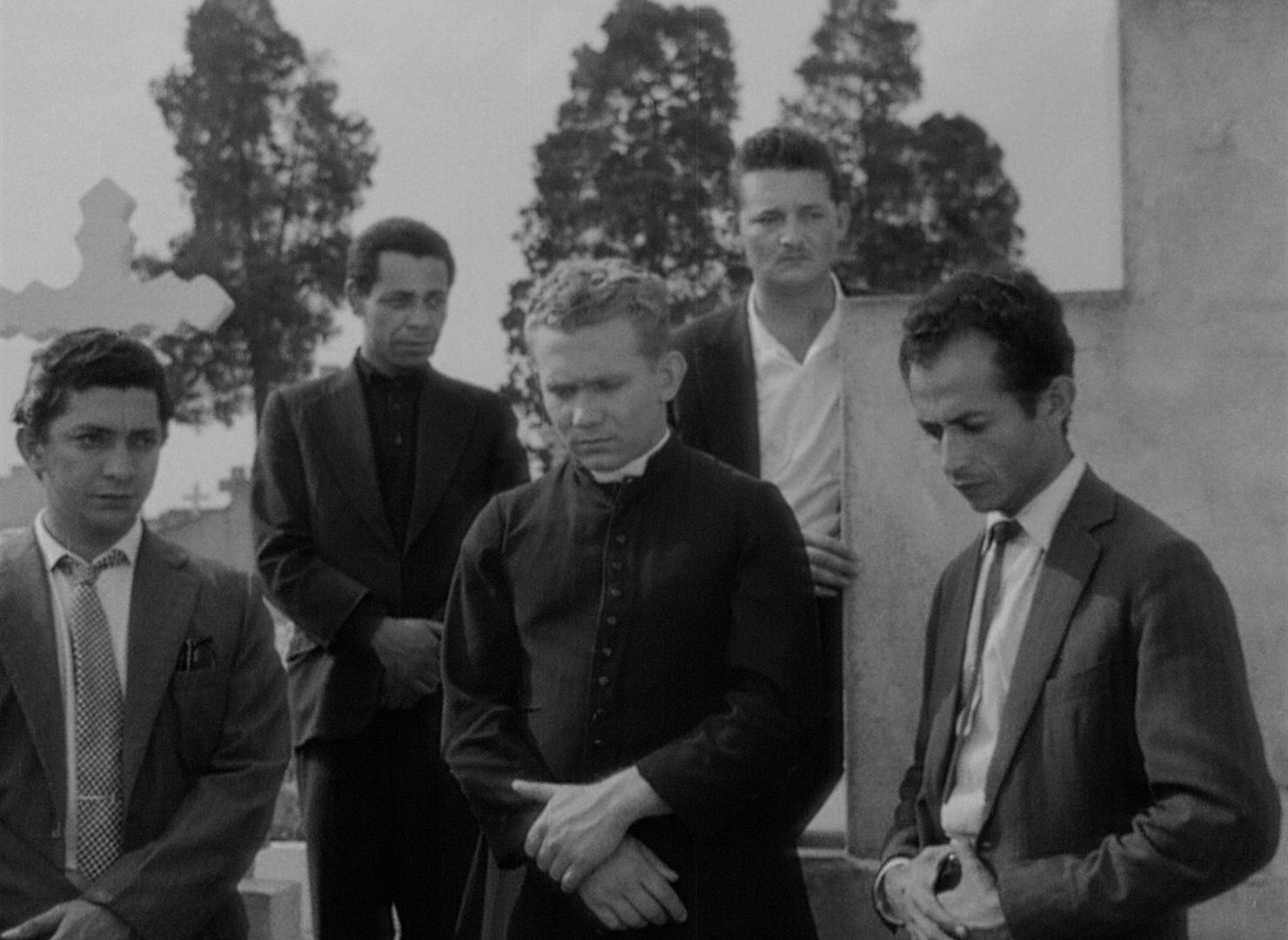
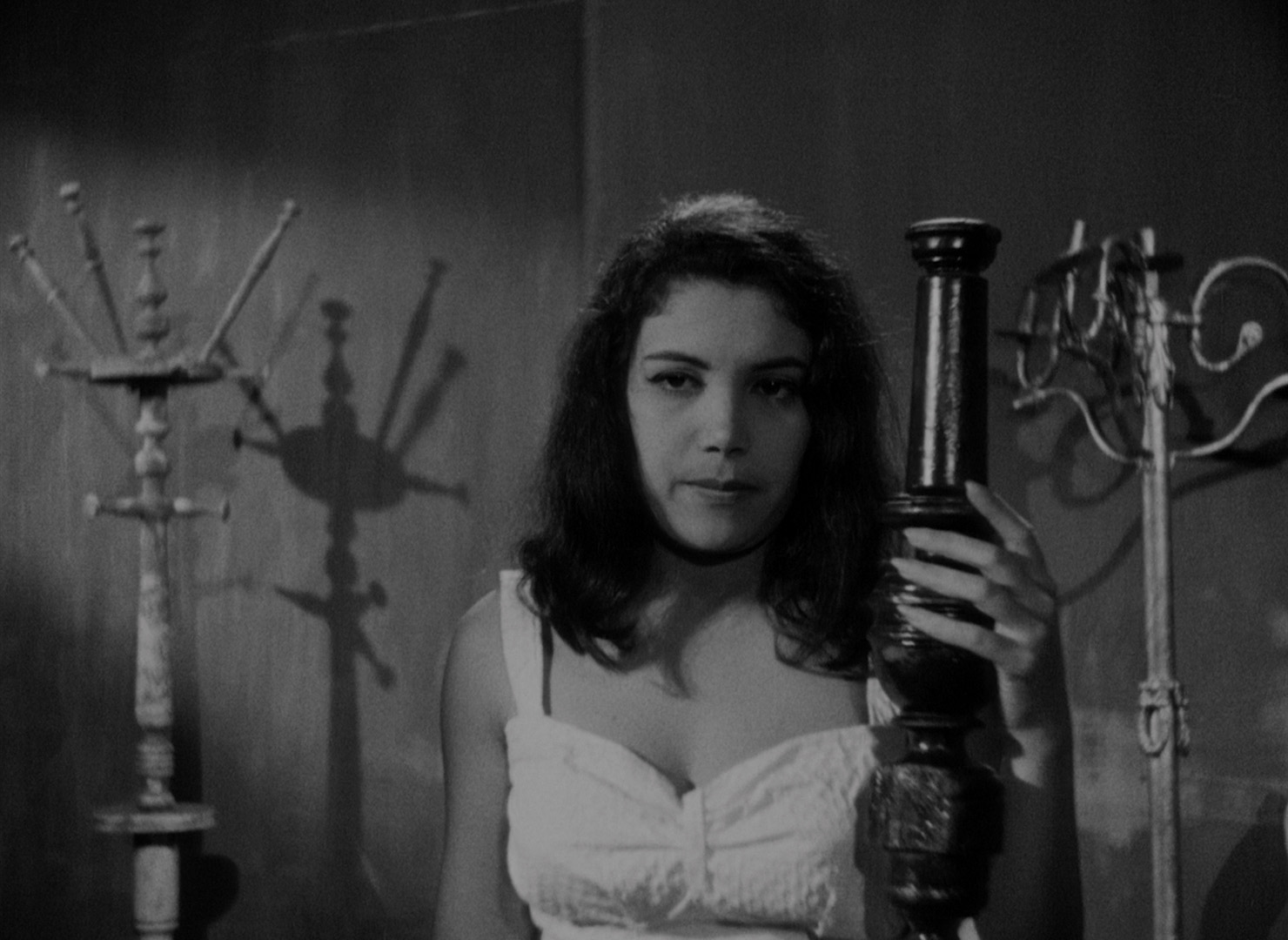
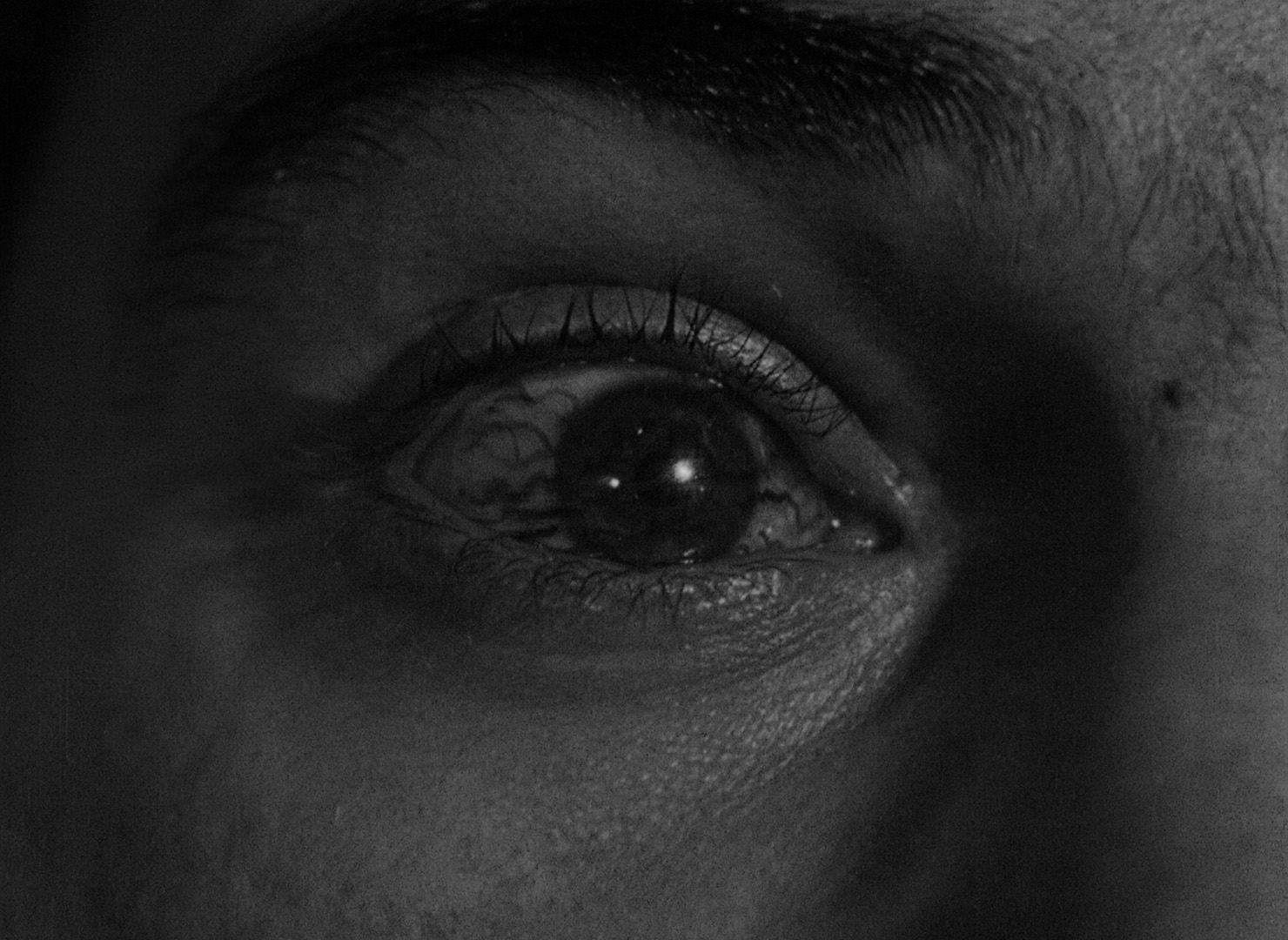
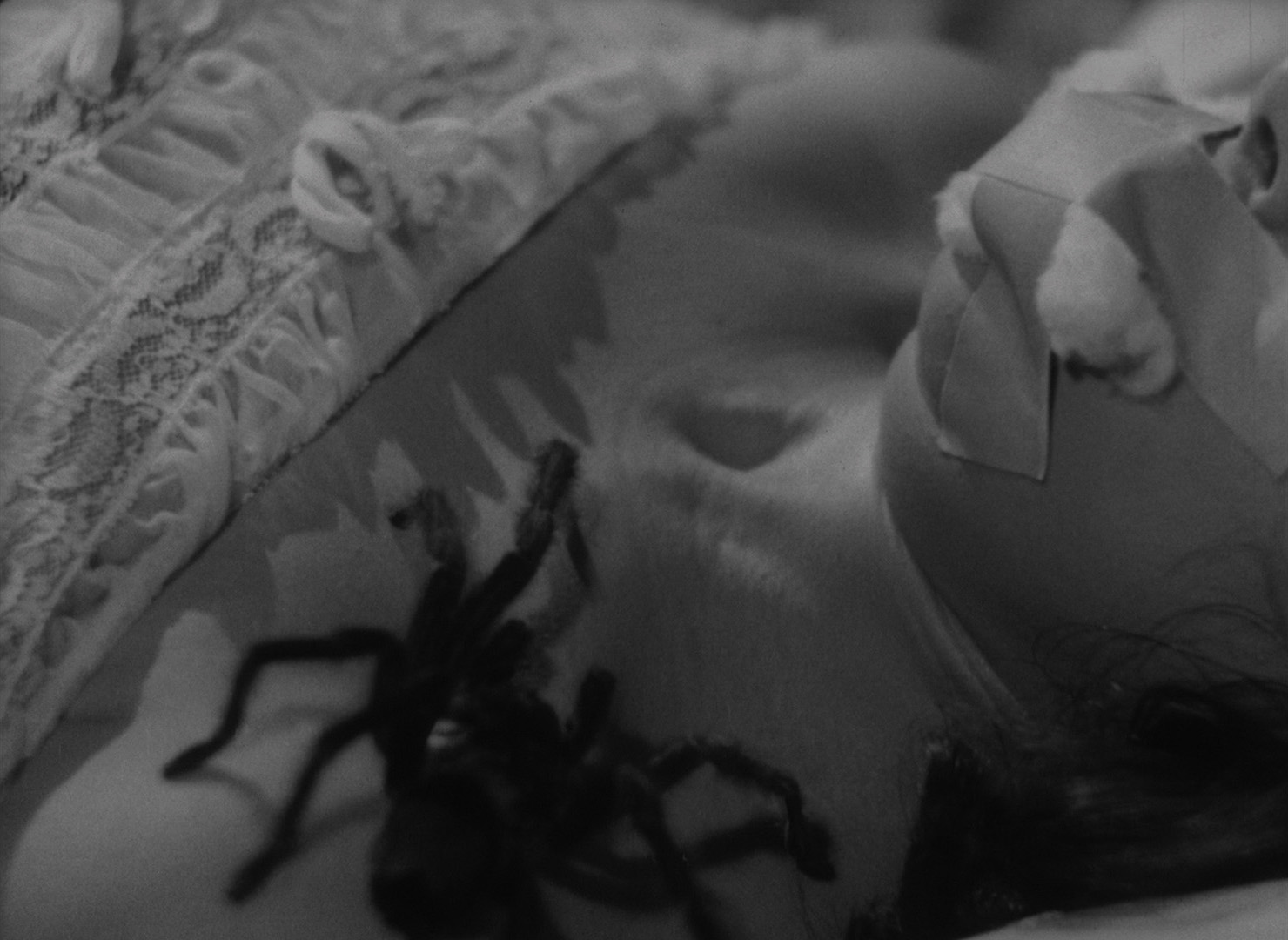
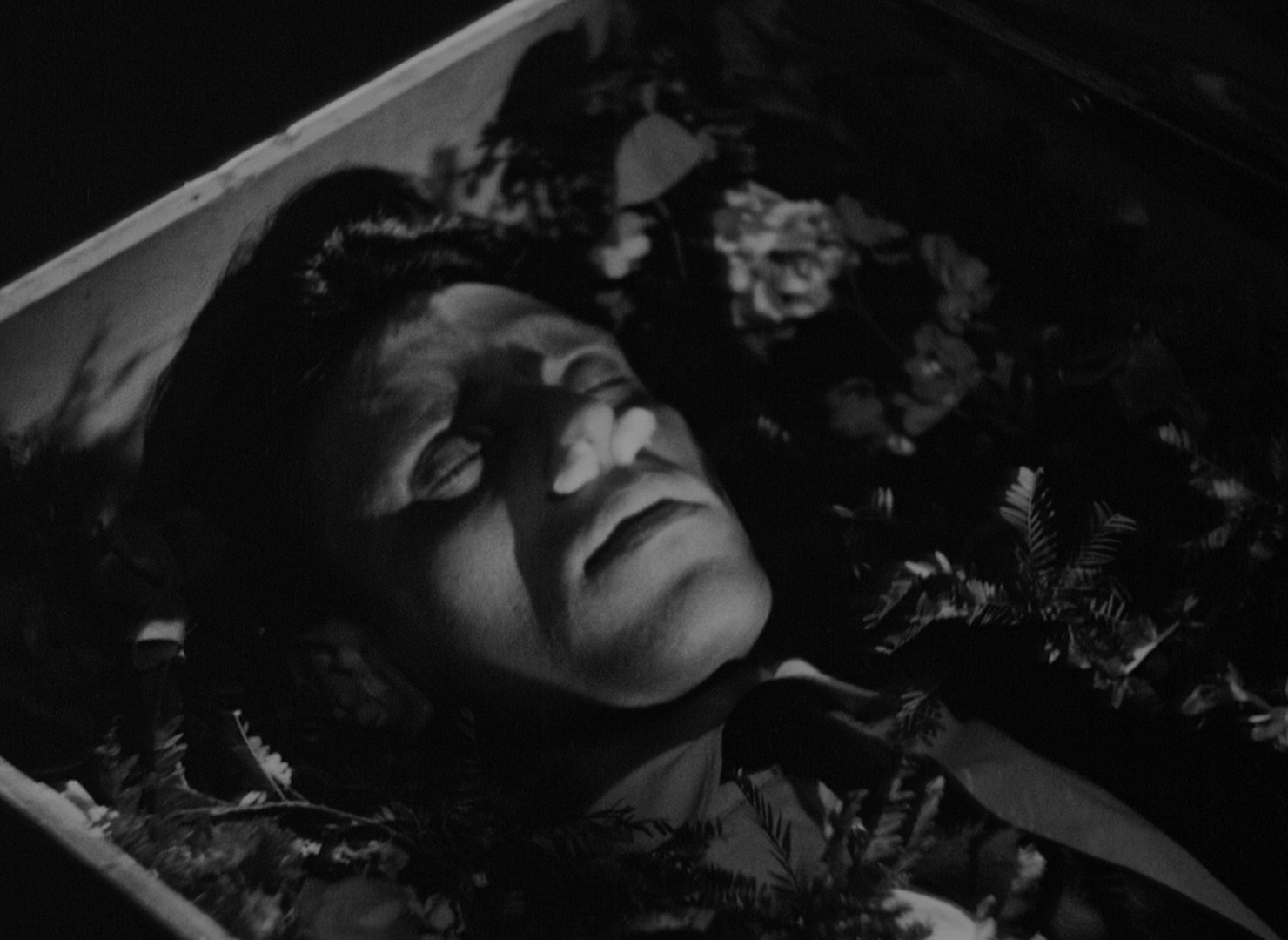
AT MIDNIGHT I'LL TAKE YOUR SOUL: Synapse Films (DVD)
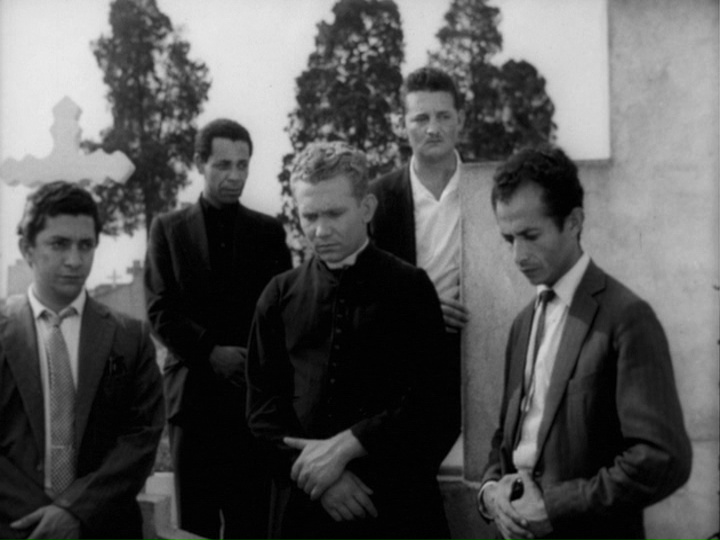
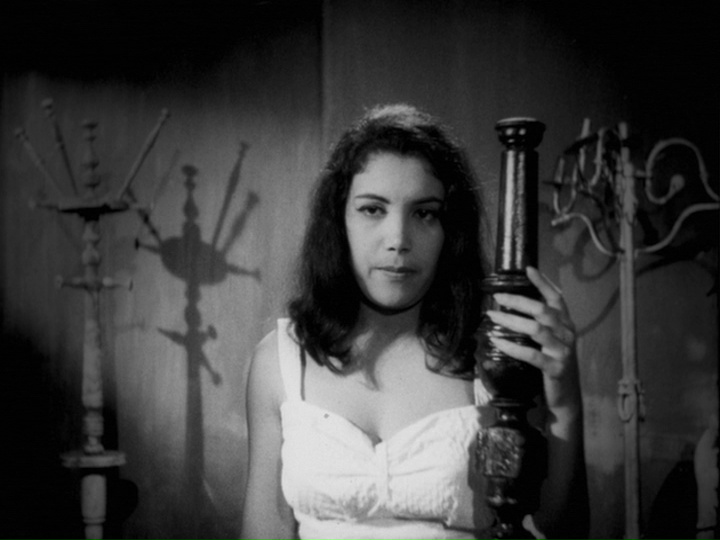
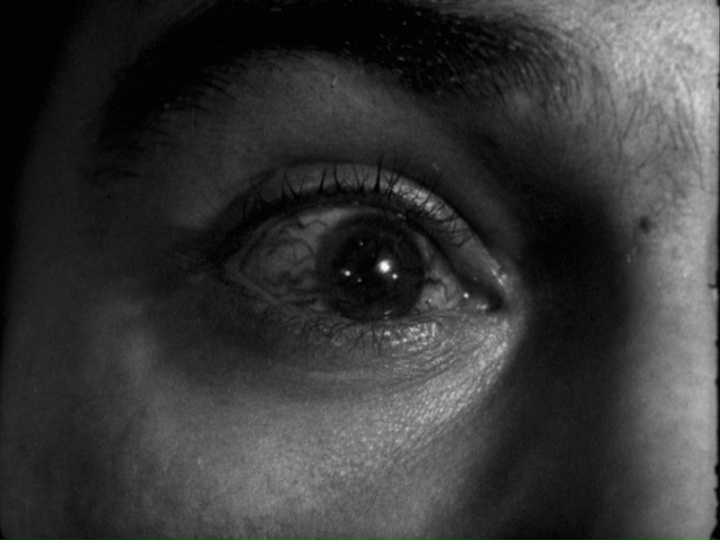
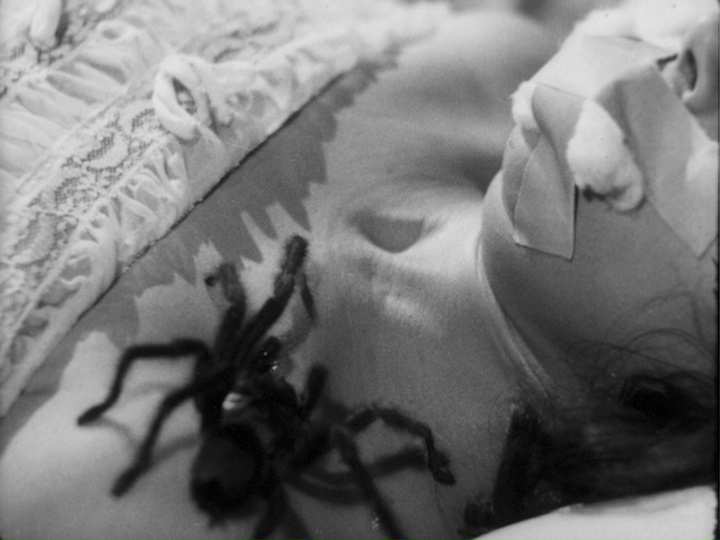
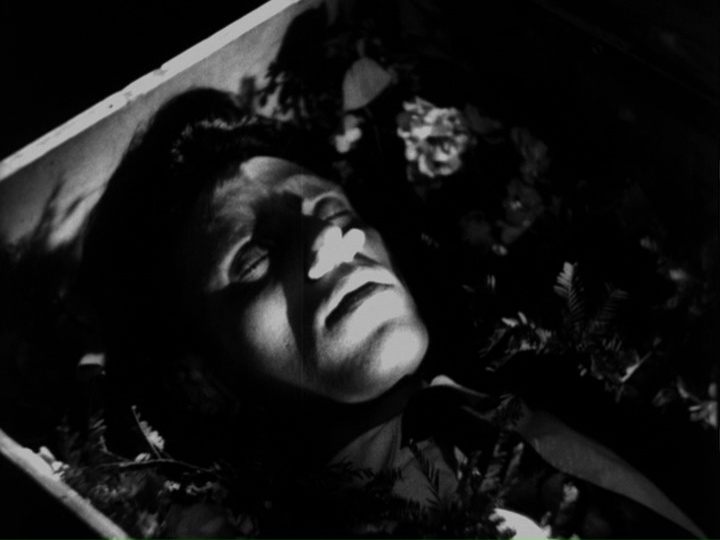
AT MIDNIGHT I'LL TAKE YOUR SOUL: Fantoma (DVD)
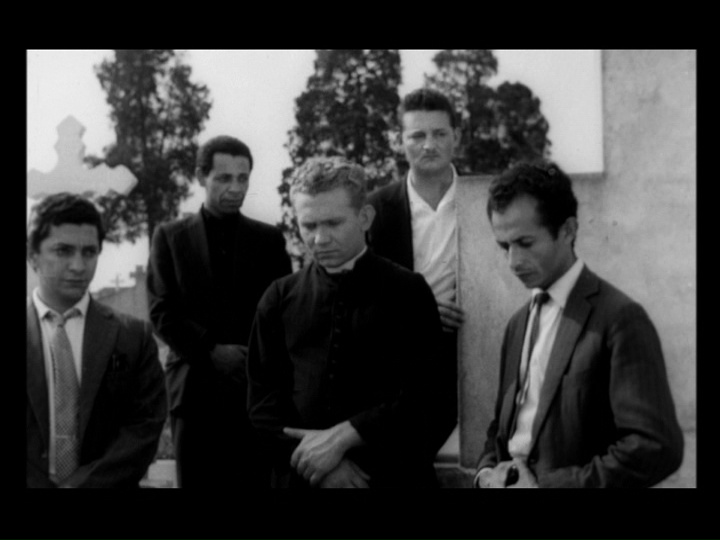
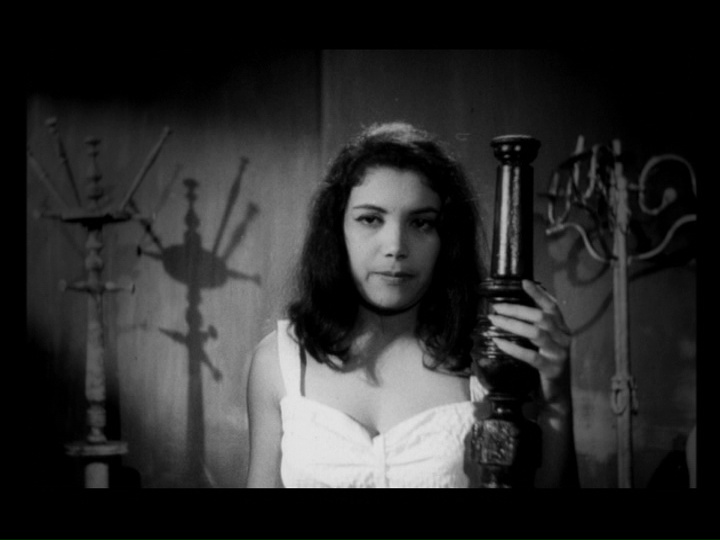
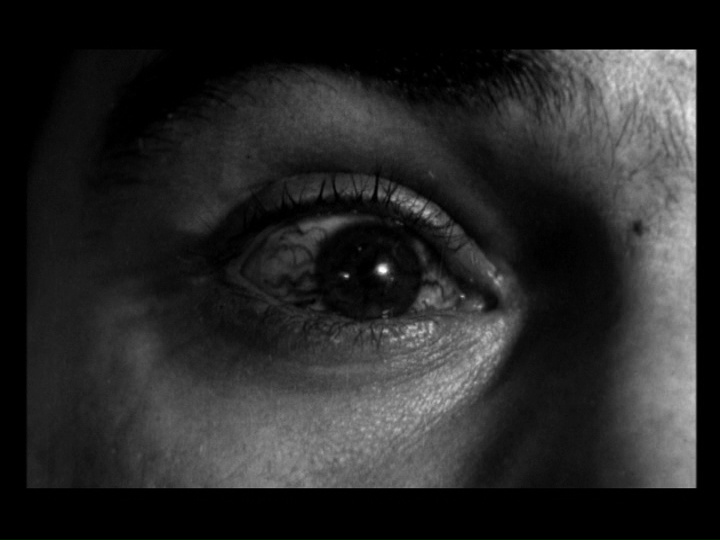
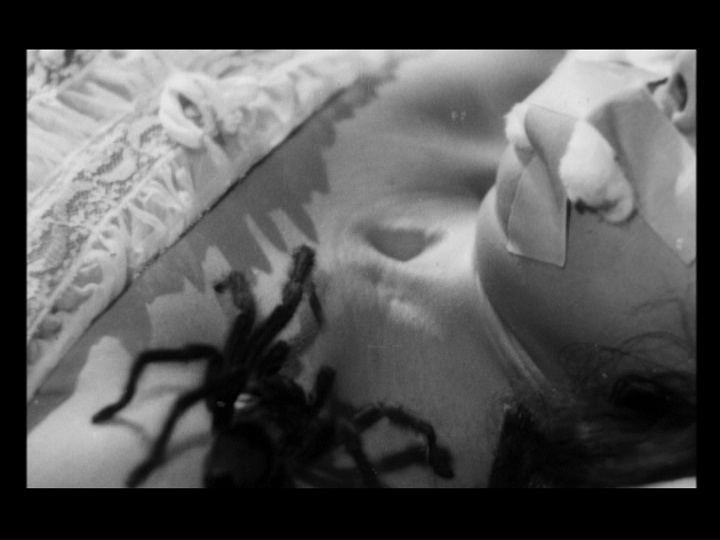
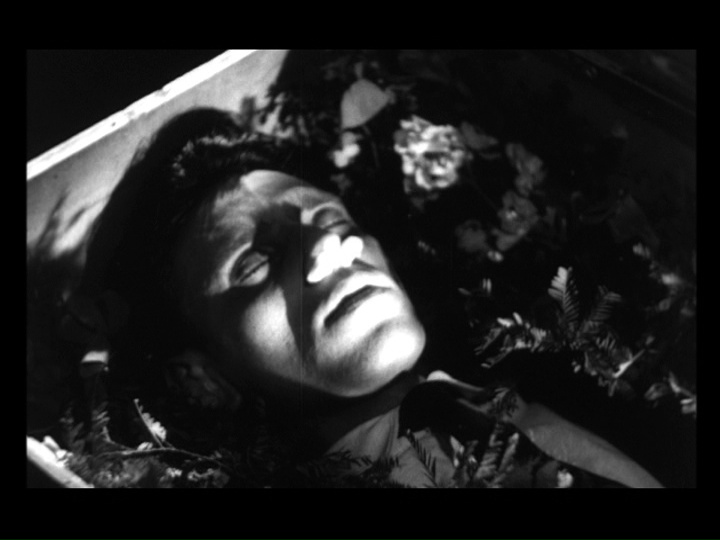
THIS NIGHT I'LL POSSESS YOUR CORPSE: Arrow Video (Blu-ray)
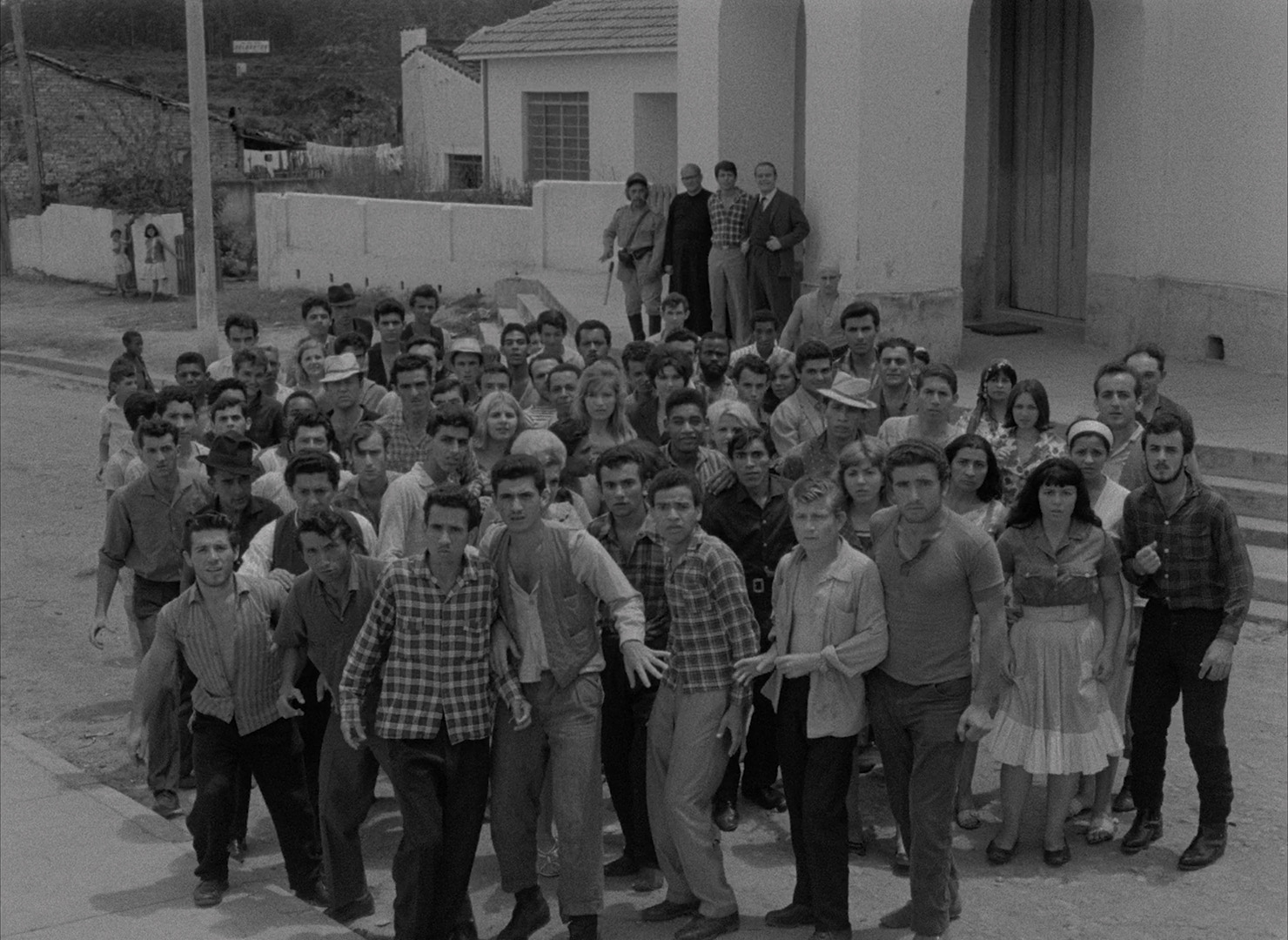
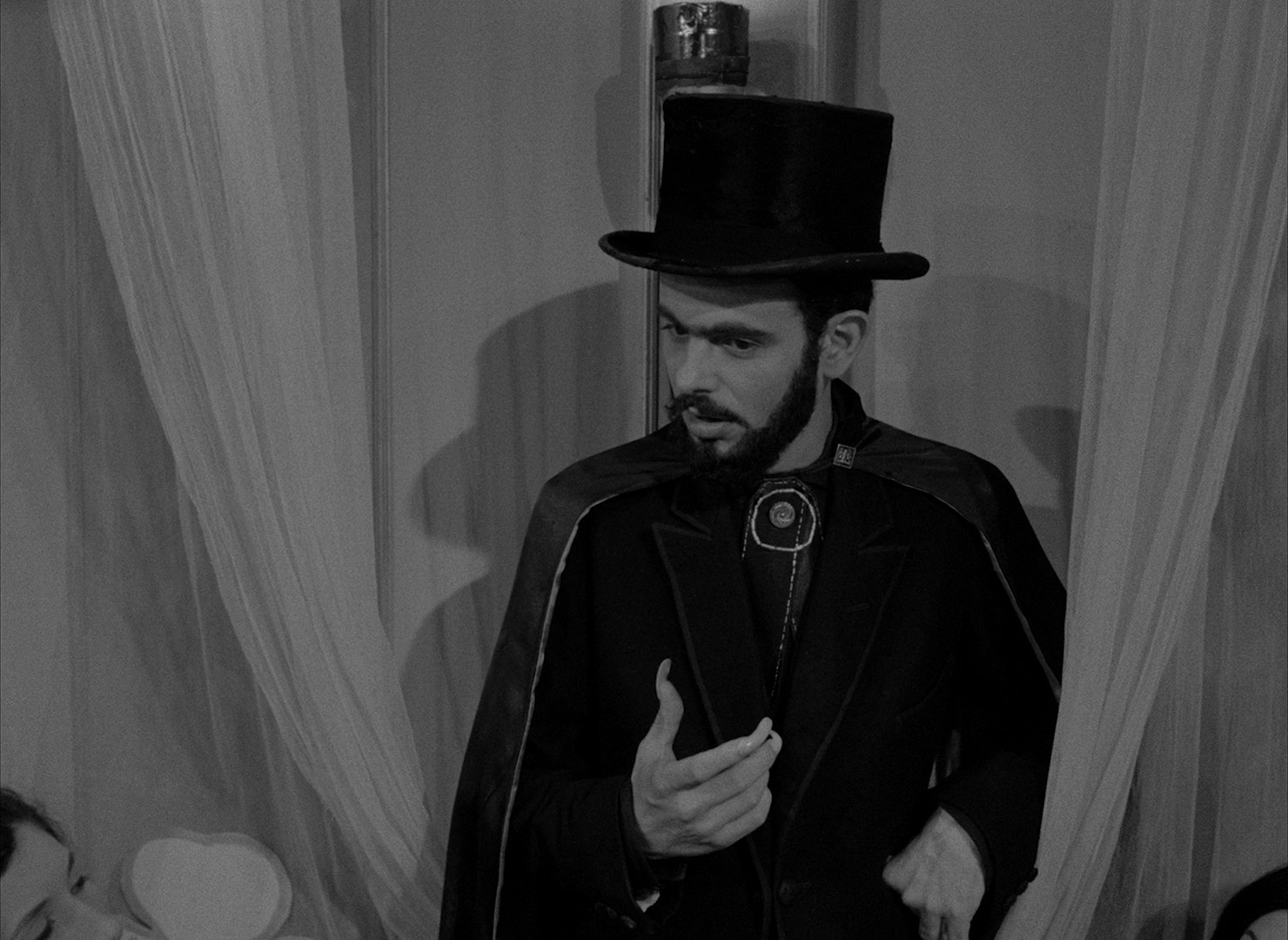
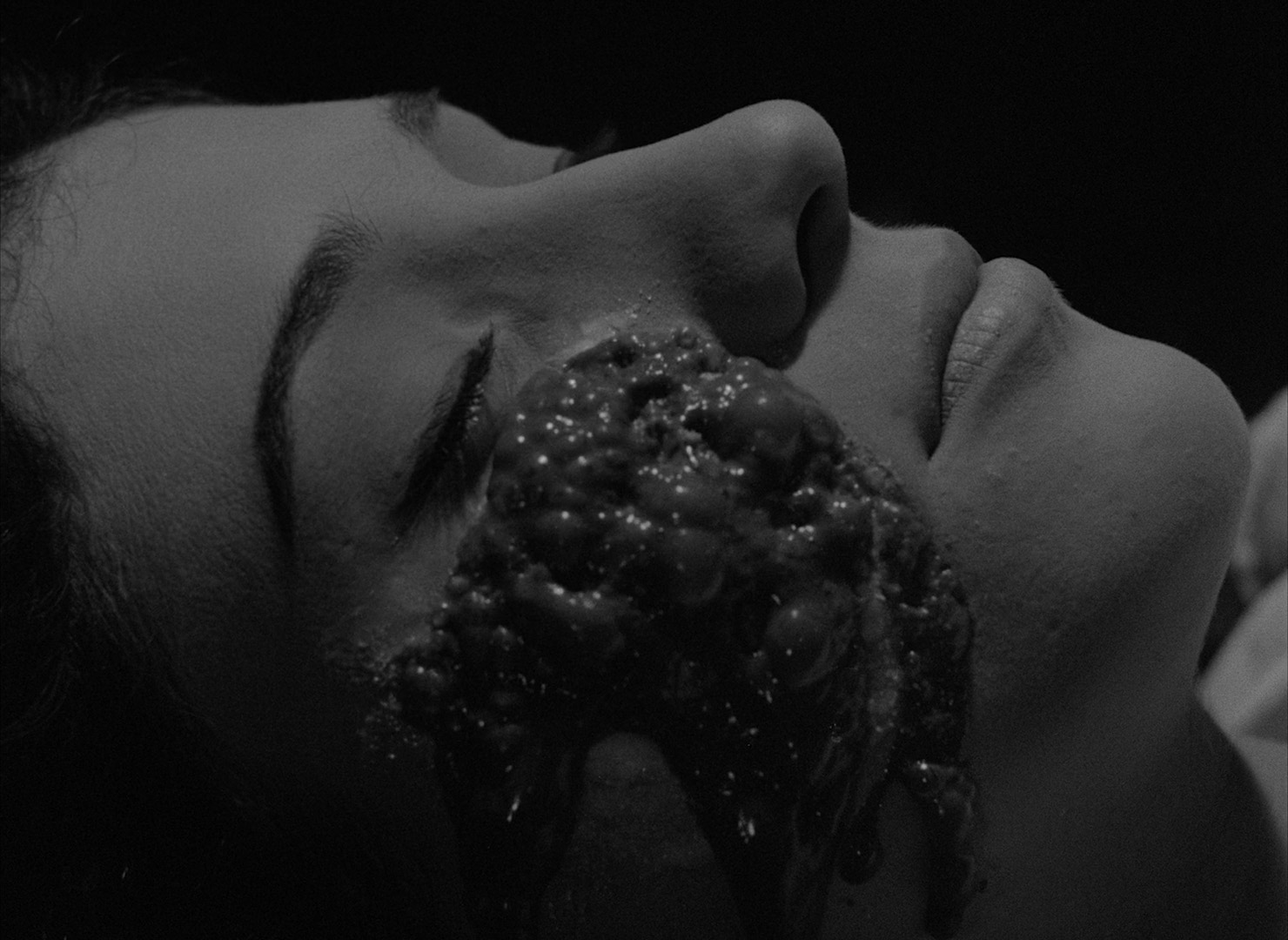
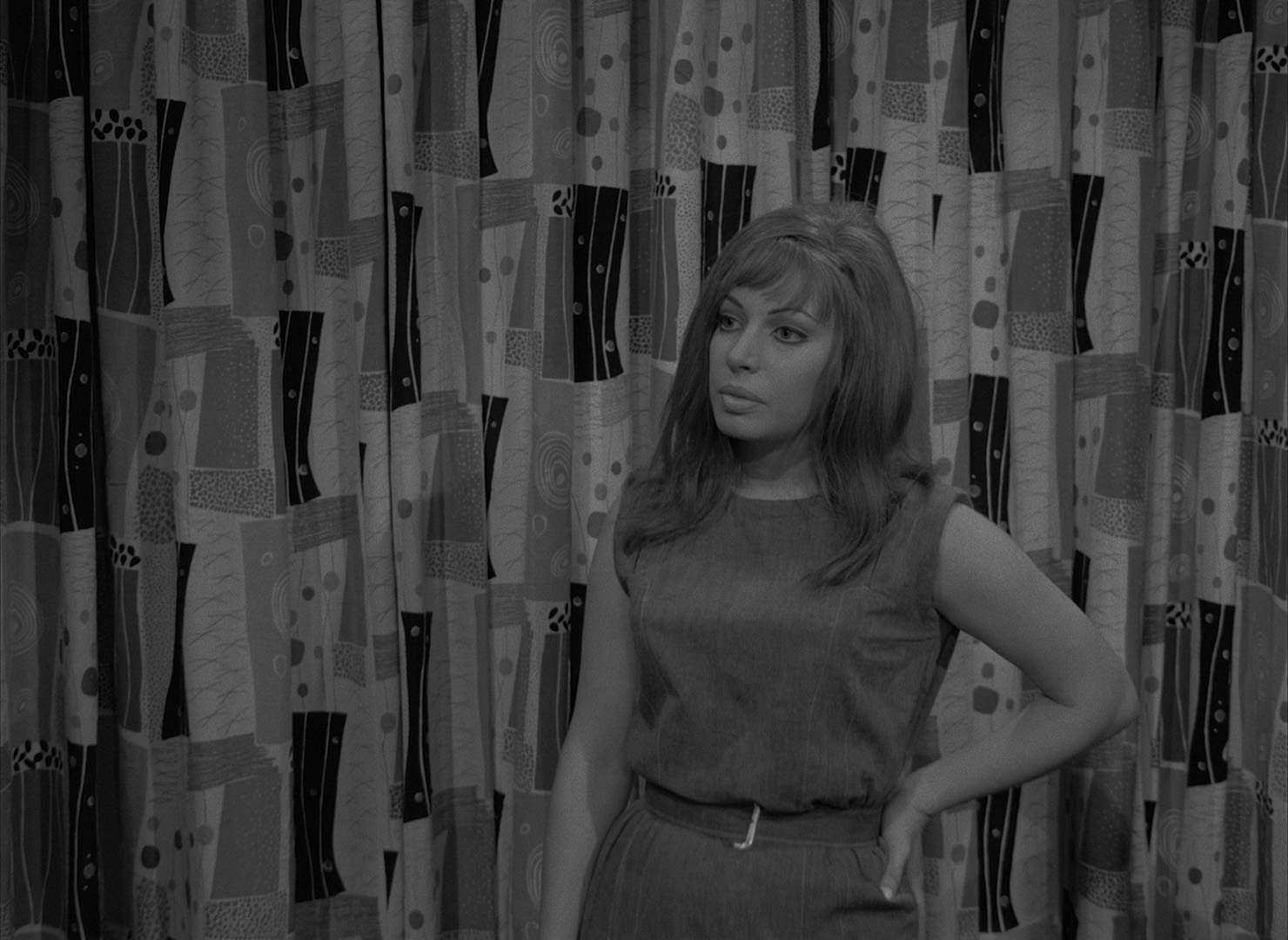
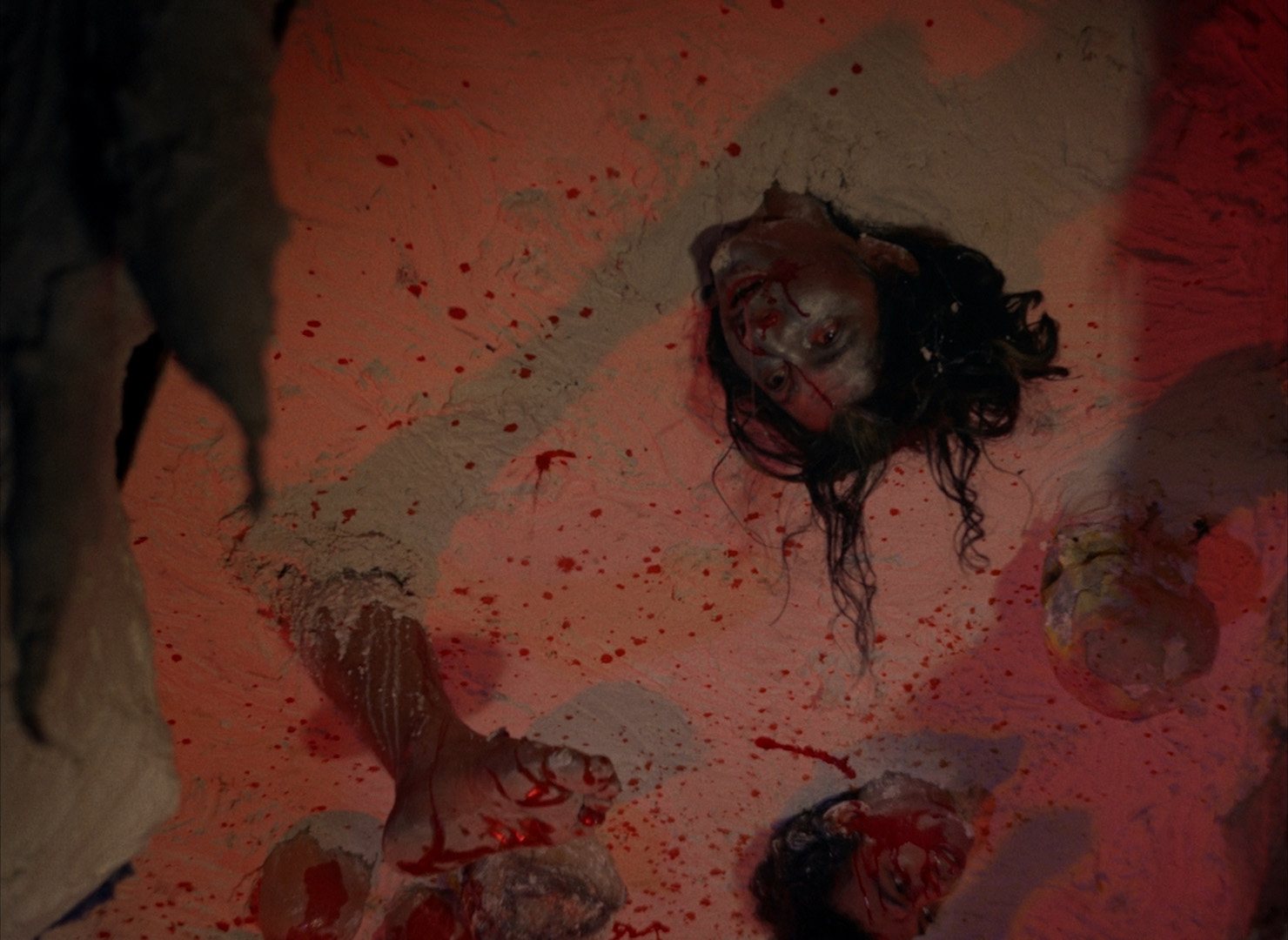
THIS NIGHT I'LL POSSESS YOUR CORPSE: Synapse Films (DVD)
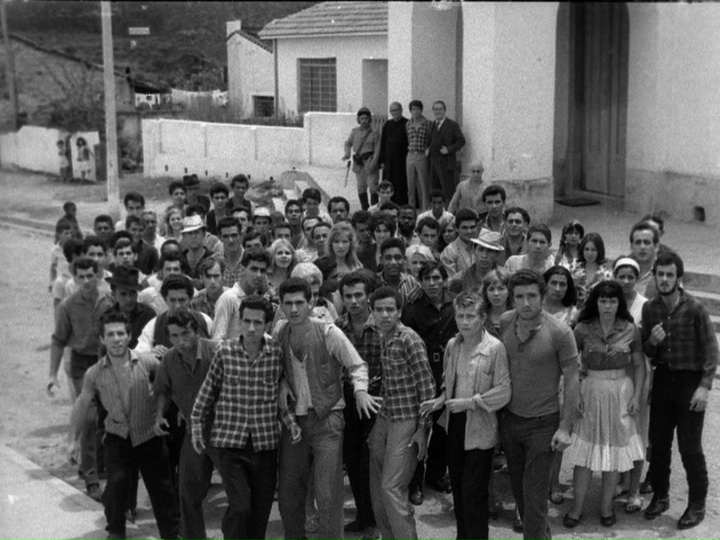
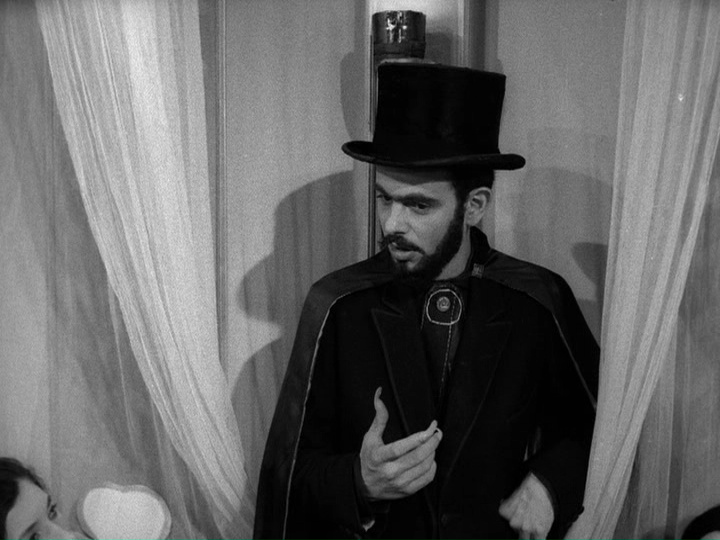
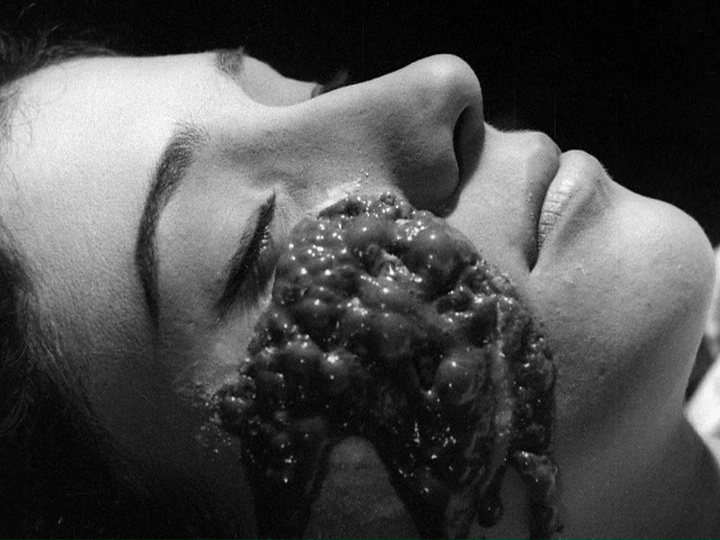
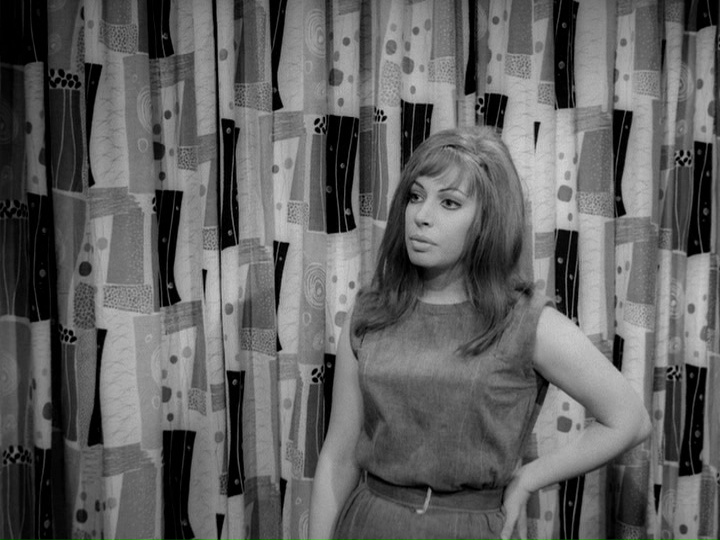
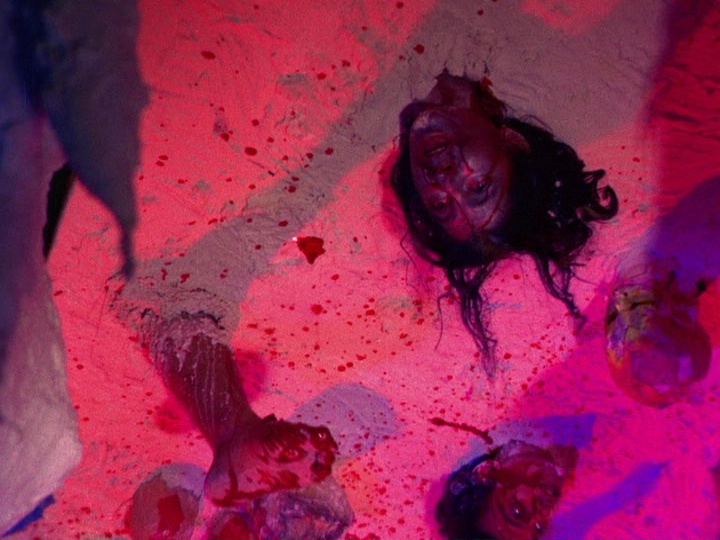
THIS NIGHT I'LL POSSESS YOUR CORPSE: Fantoma (DVD)
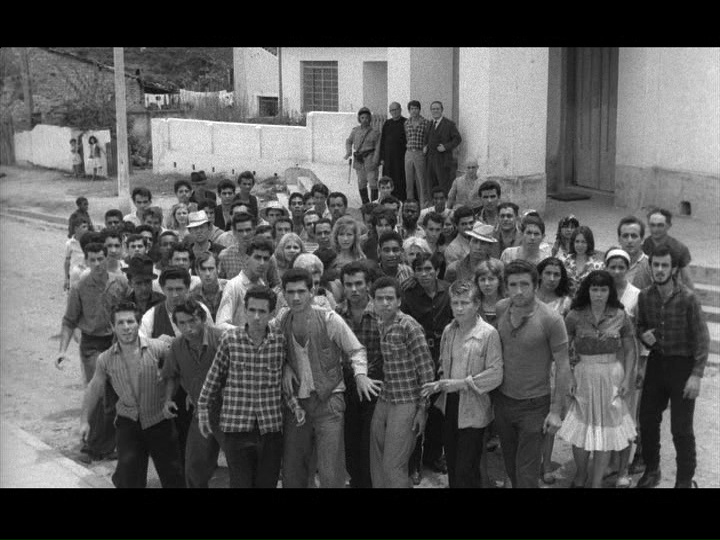
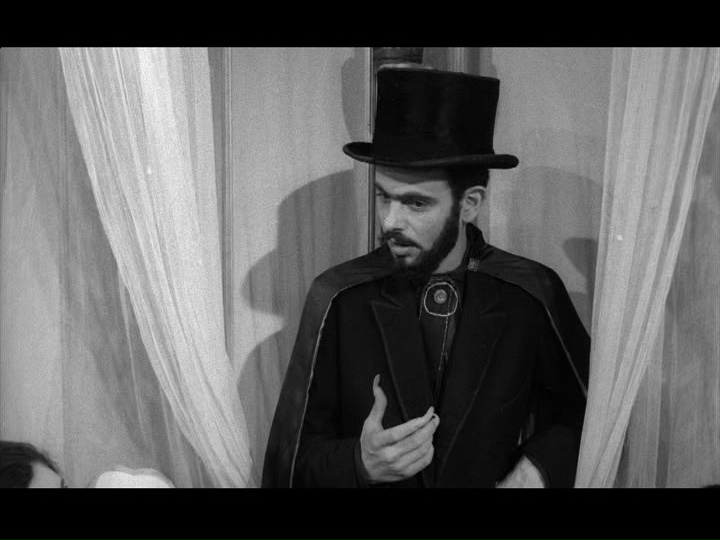
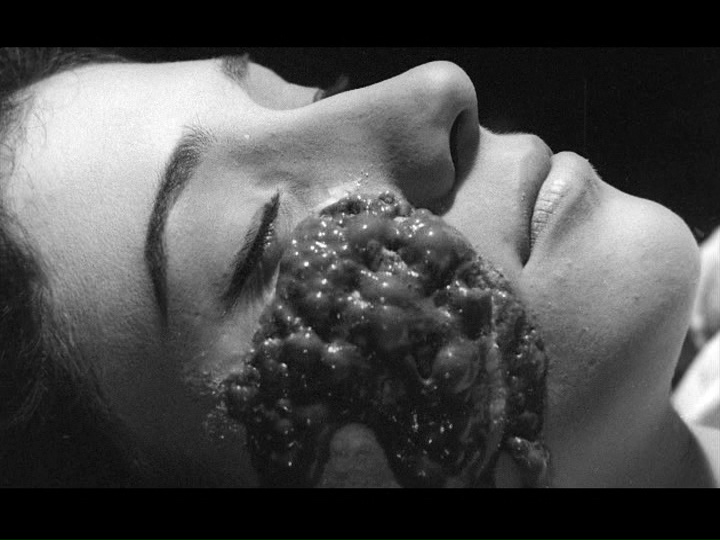
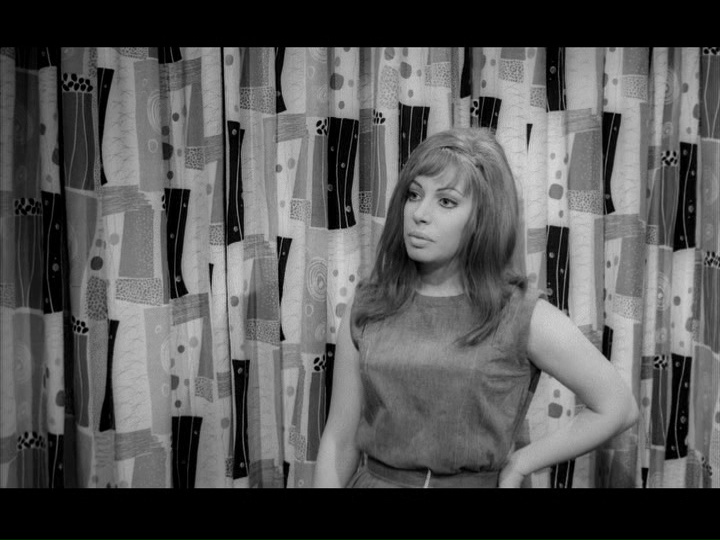
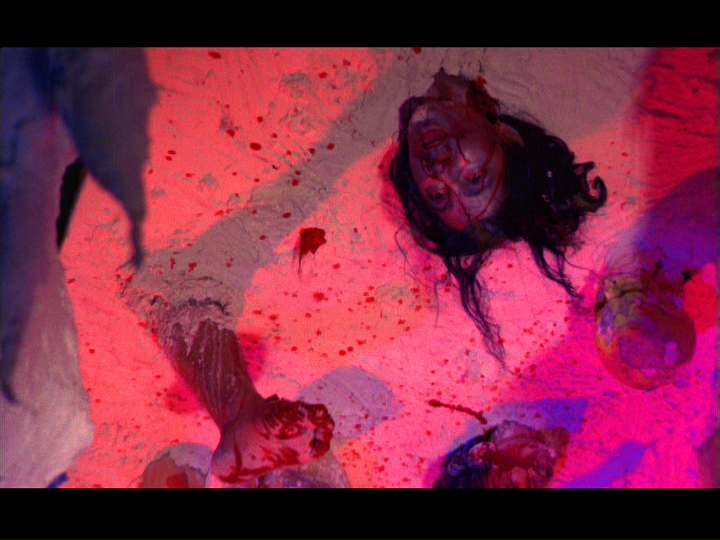
THE STRANGE WORLD OF COFFIN JOE: Arrow Video (Blu-ray)
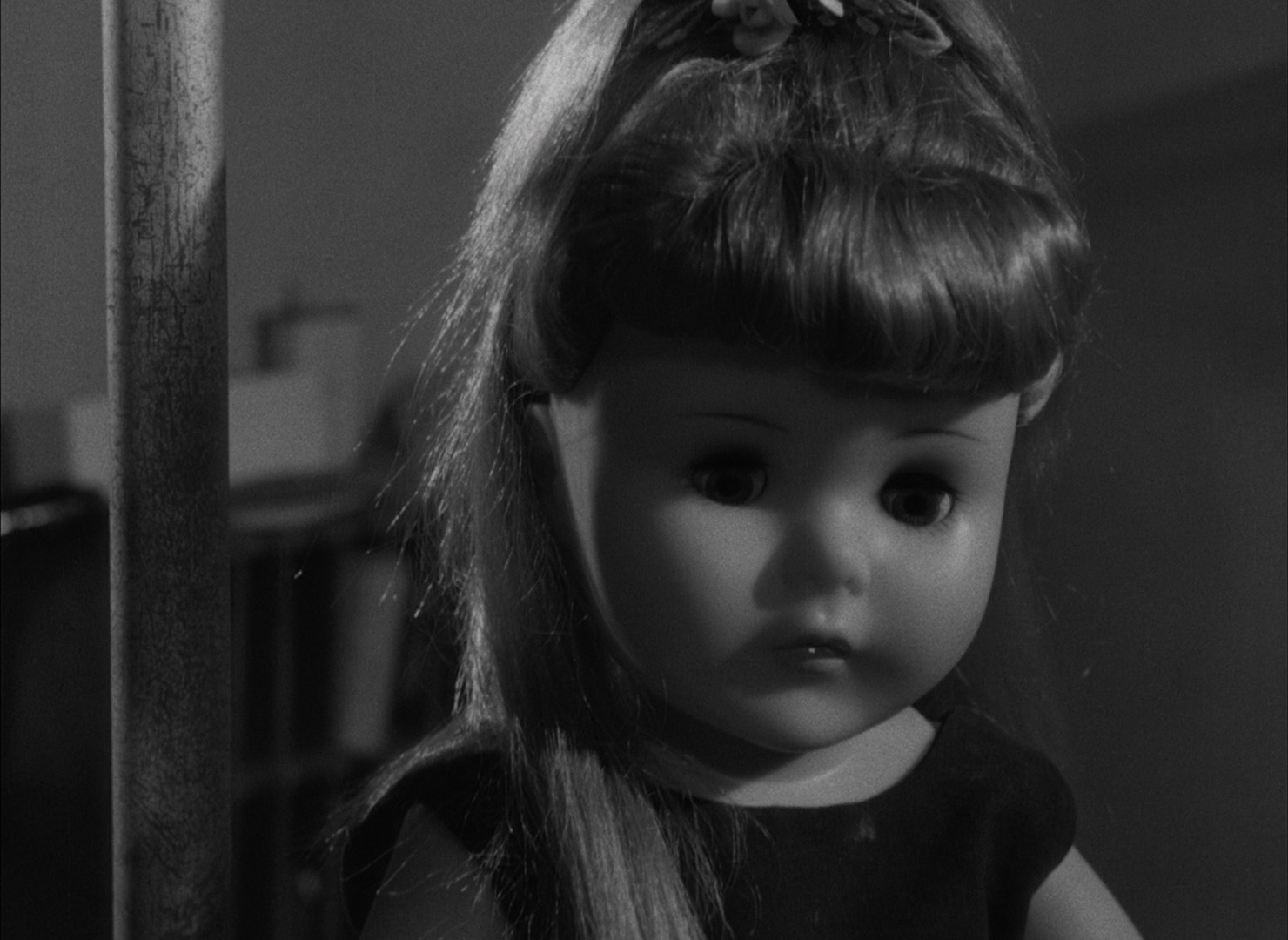
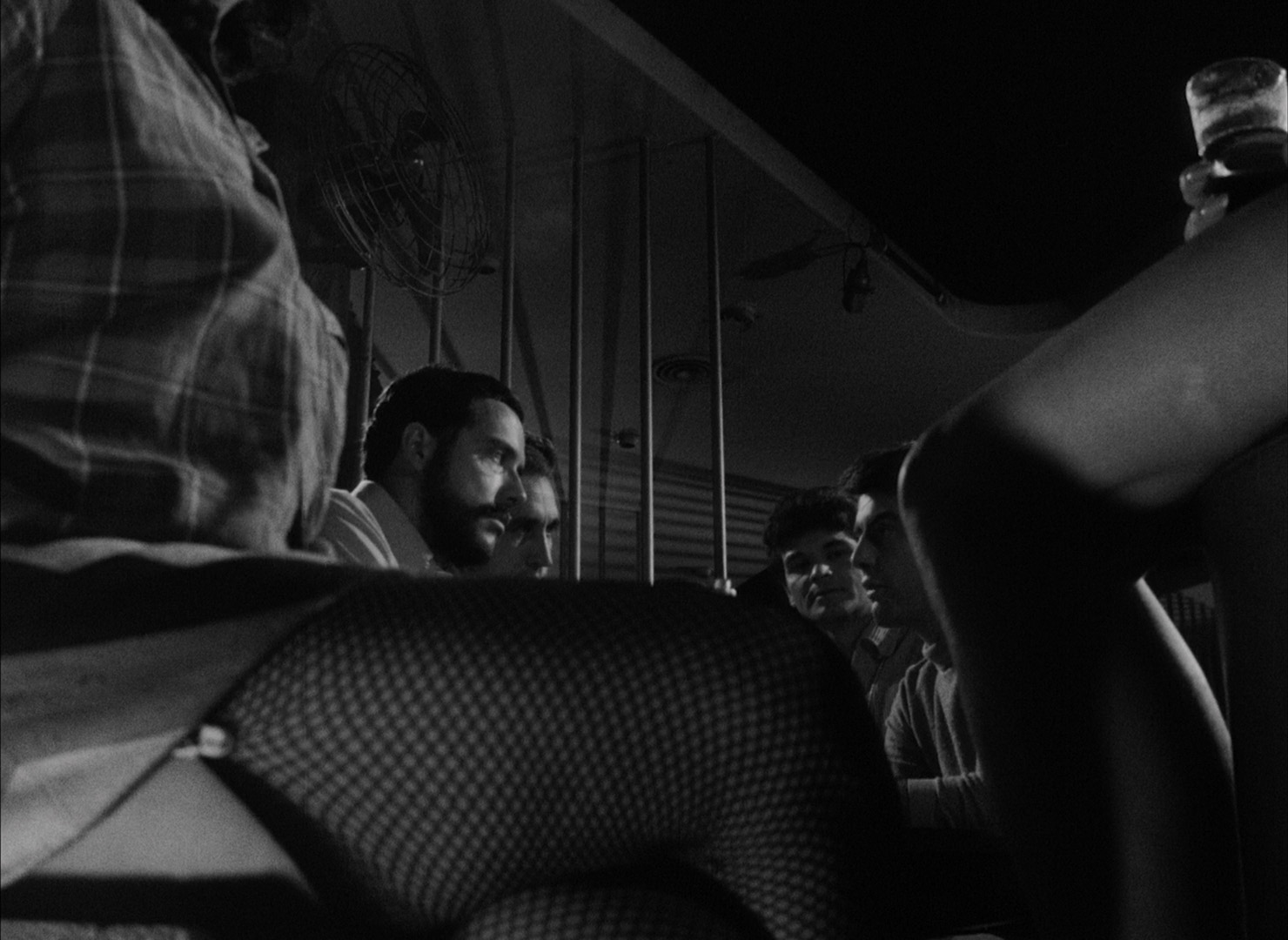
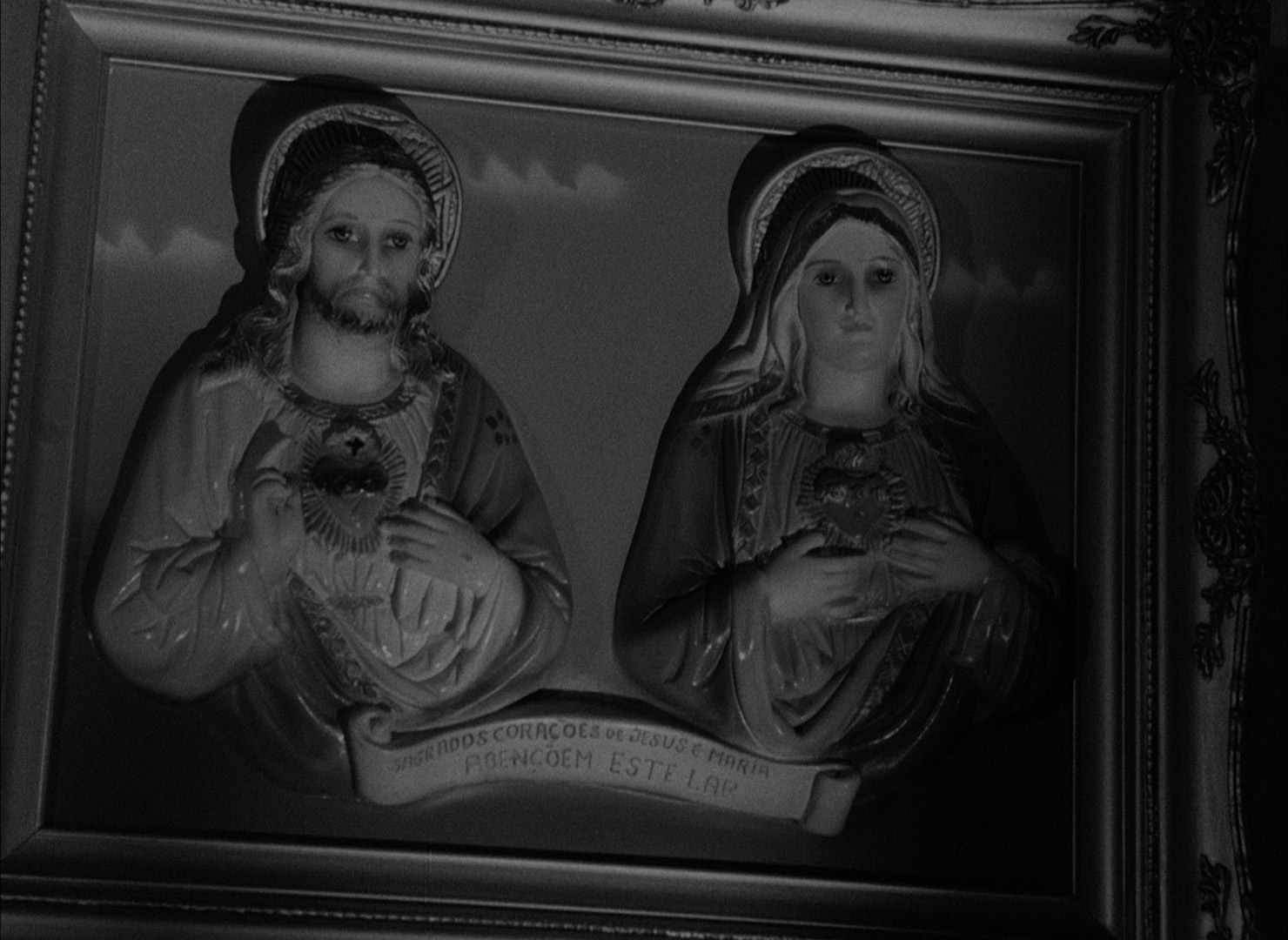
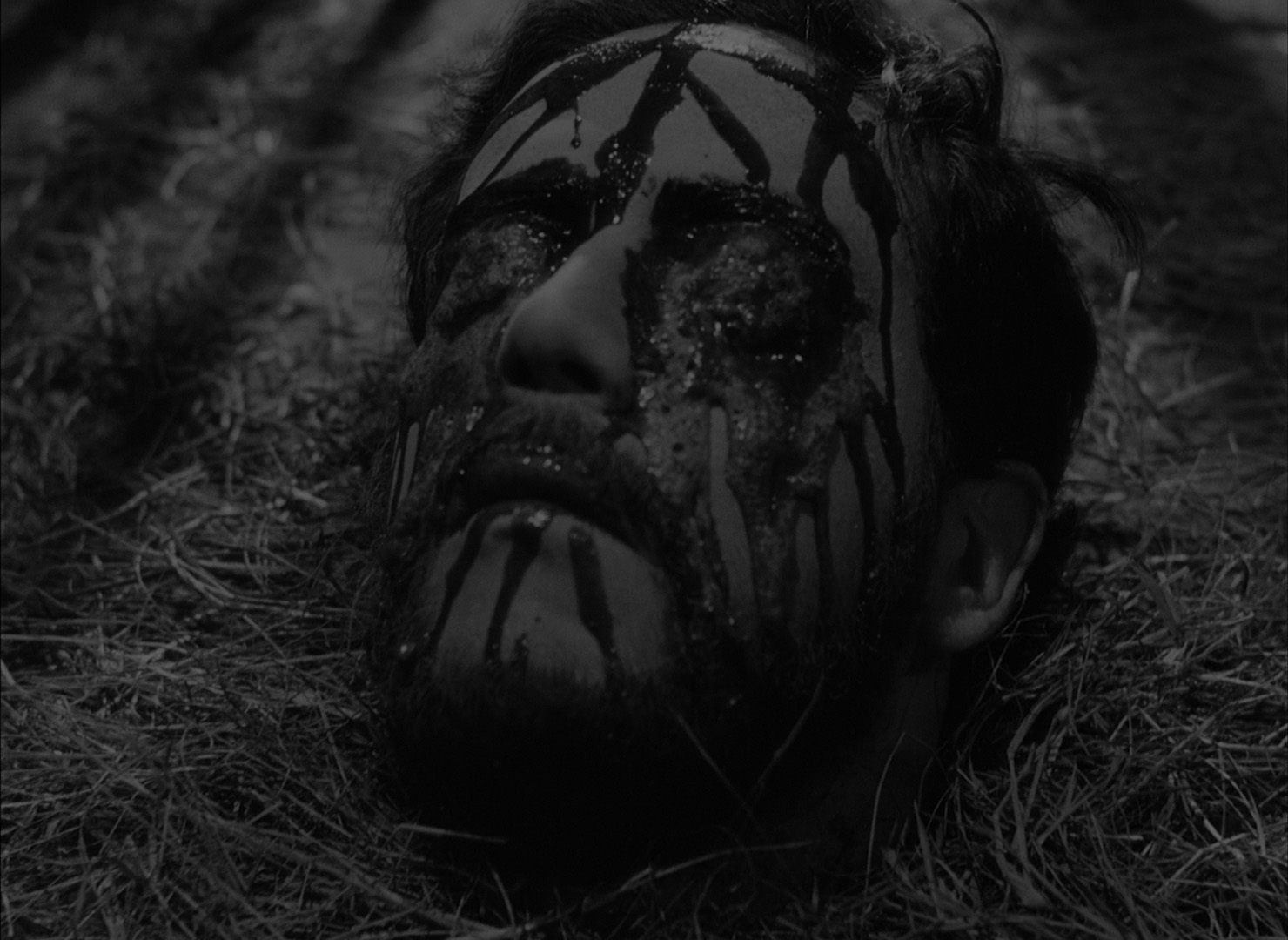
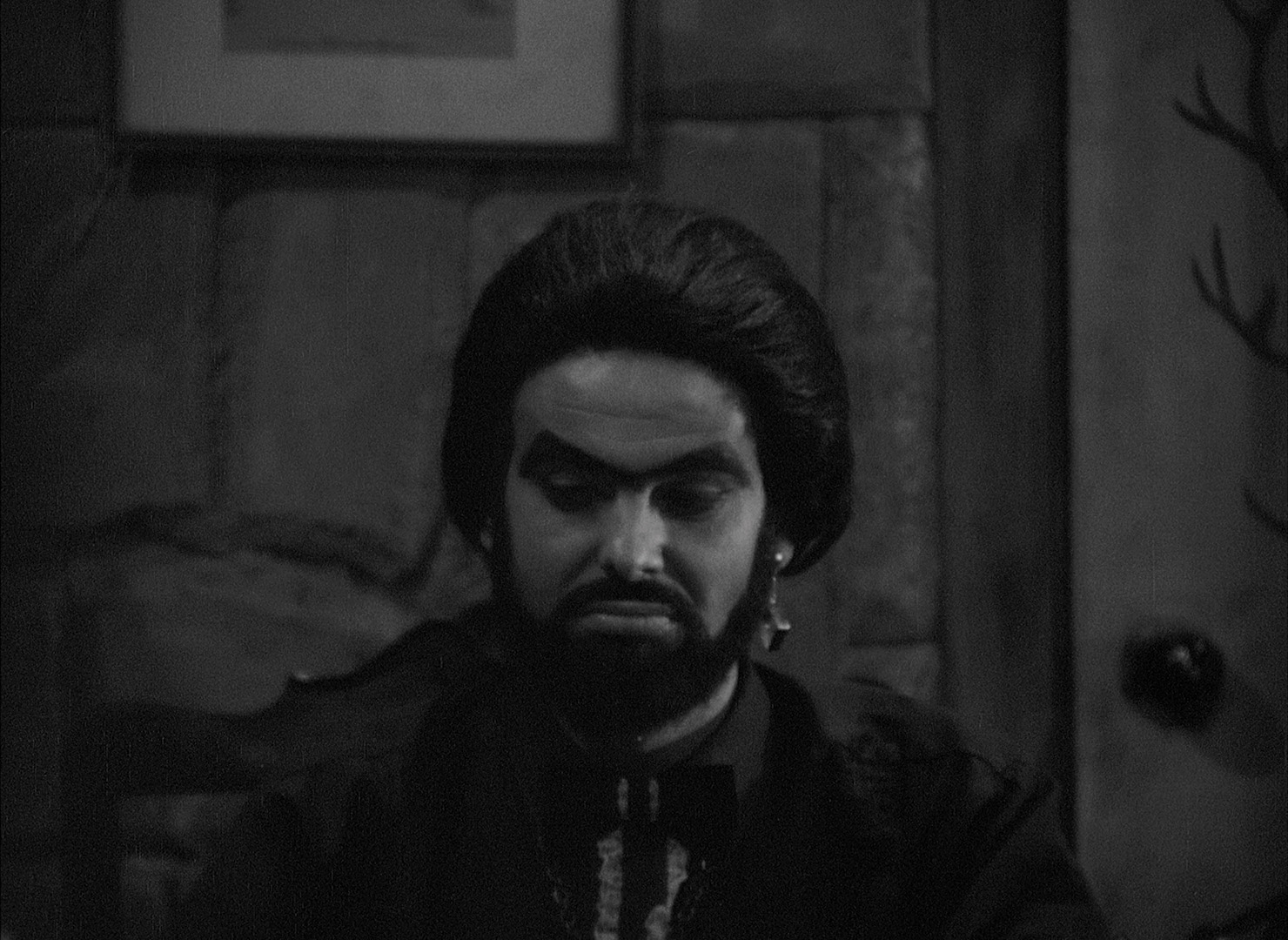
THE STRANGE WORLD OF COFFIN JOE: Cinemagia (DVD)
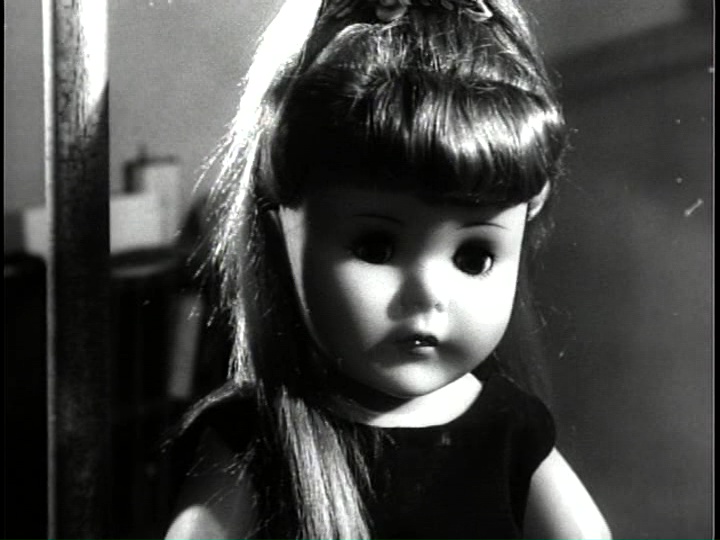
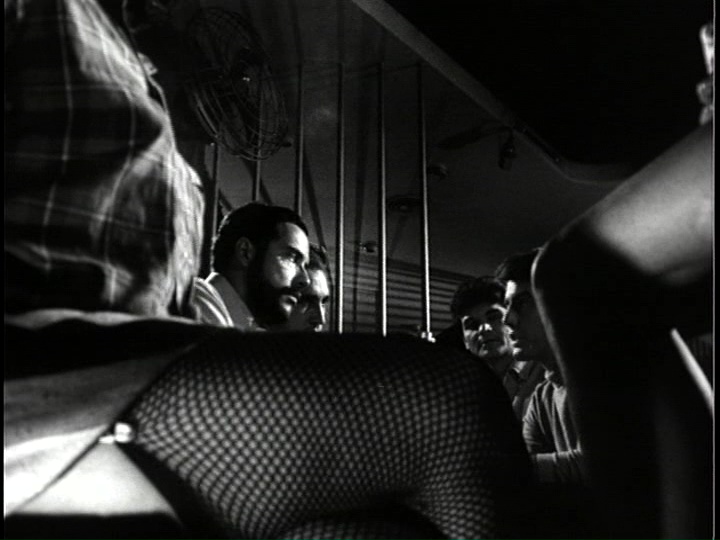
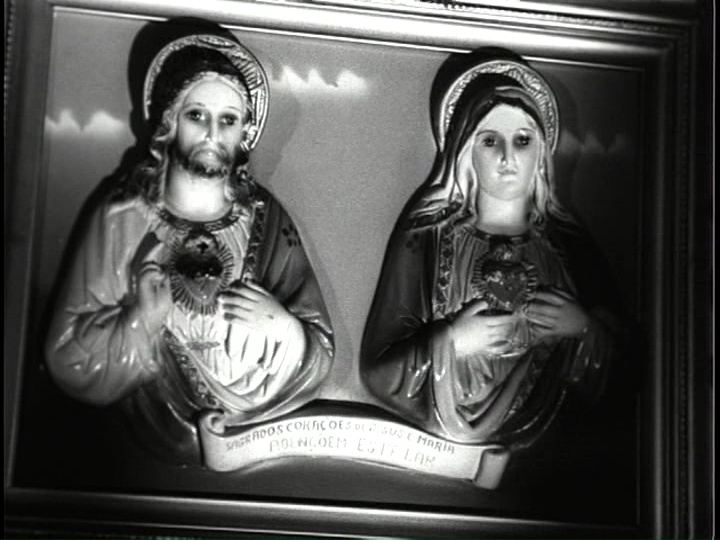
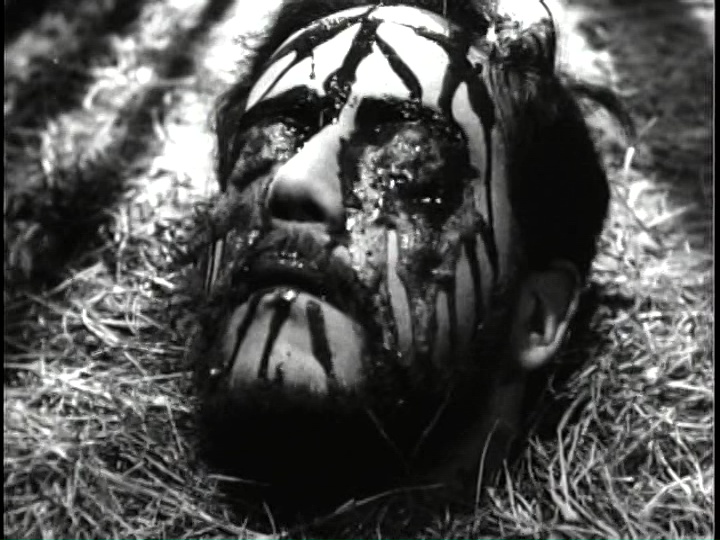
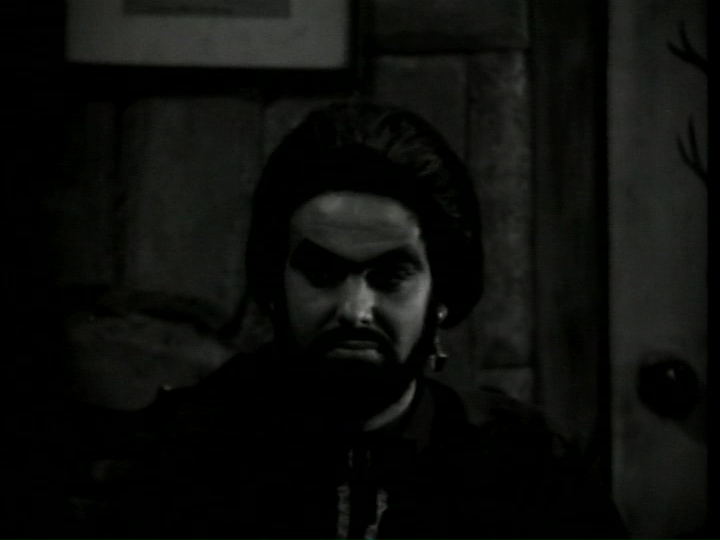
THE STRANGE WORLD OF COFFIN JOE: Anchor Bay (DVD)
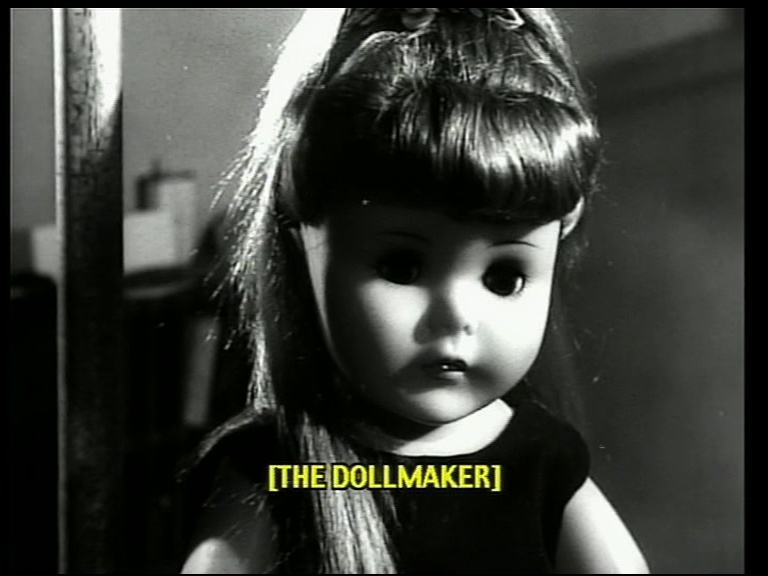
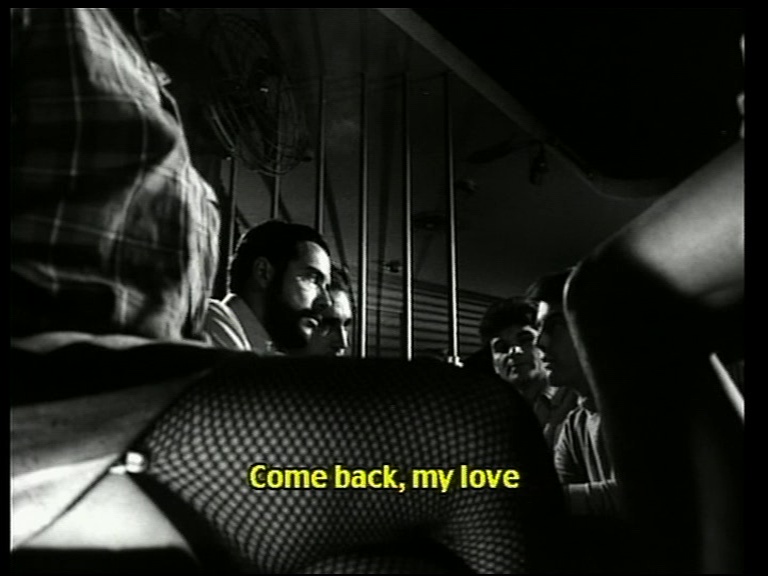
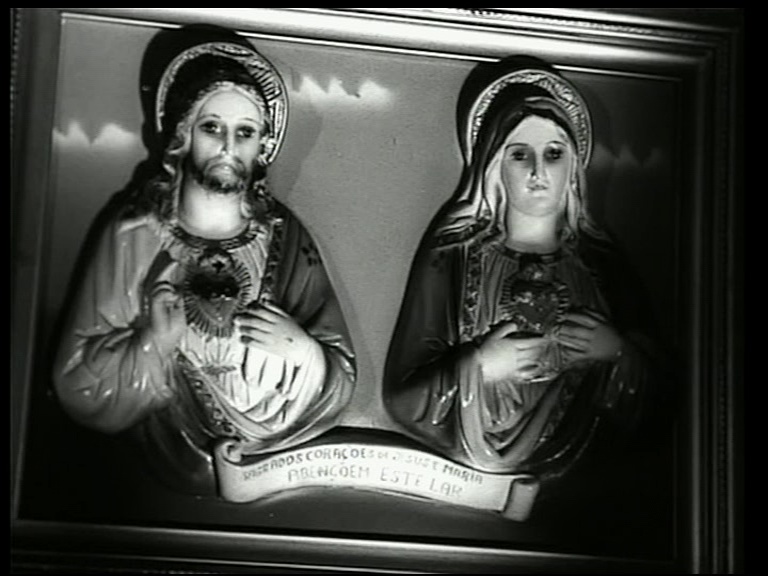
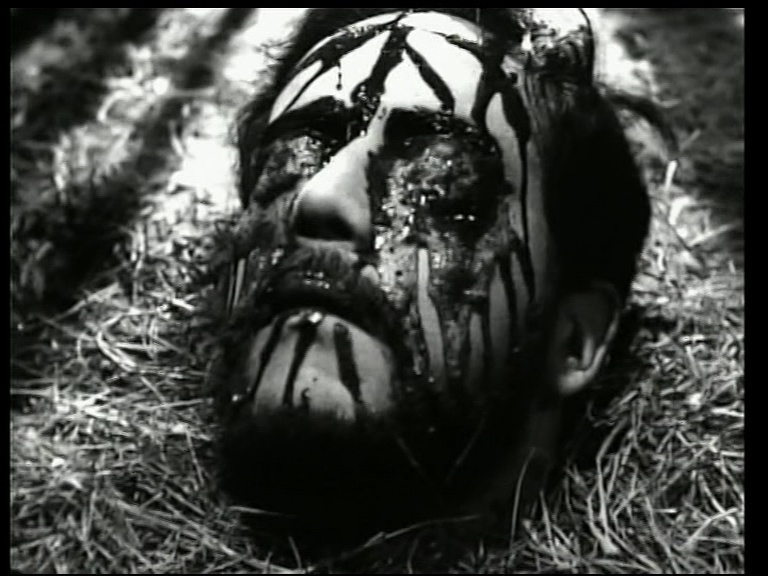
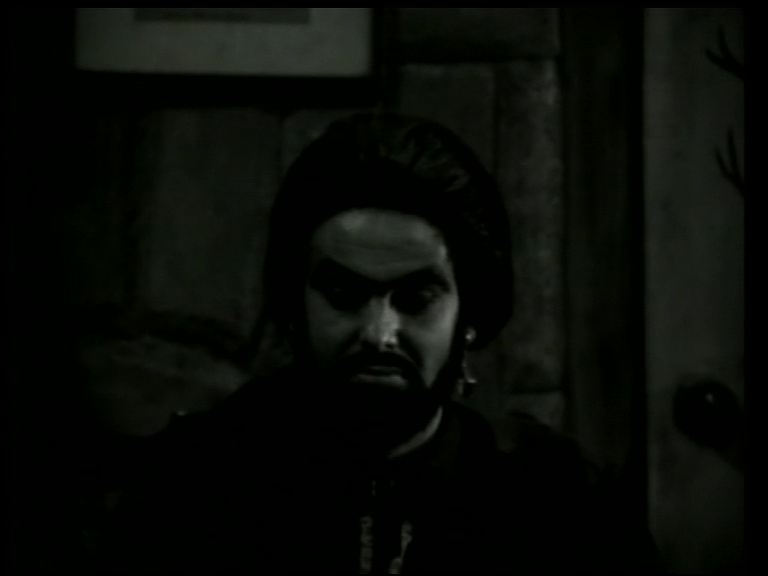
AWAKENING OF THE BEAST: Arrow Video (Blu-ray)
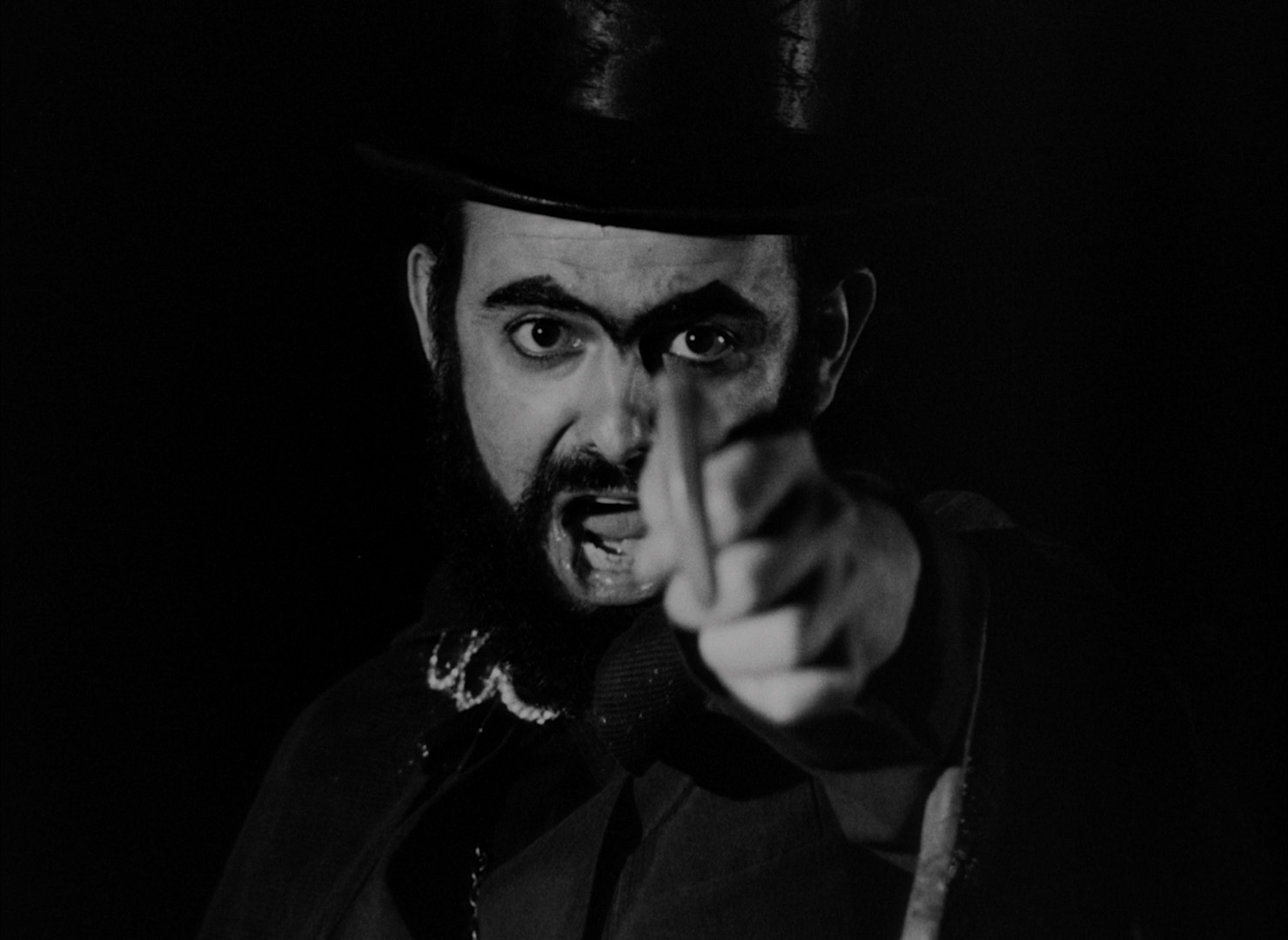
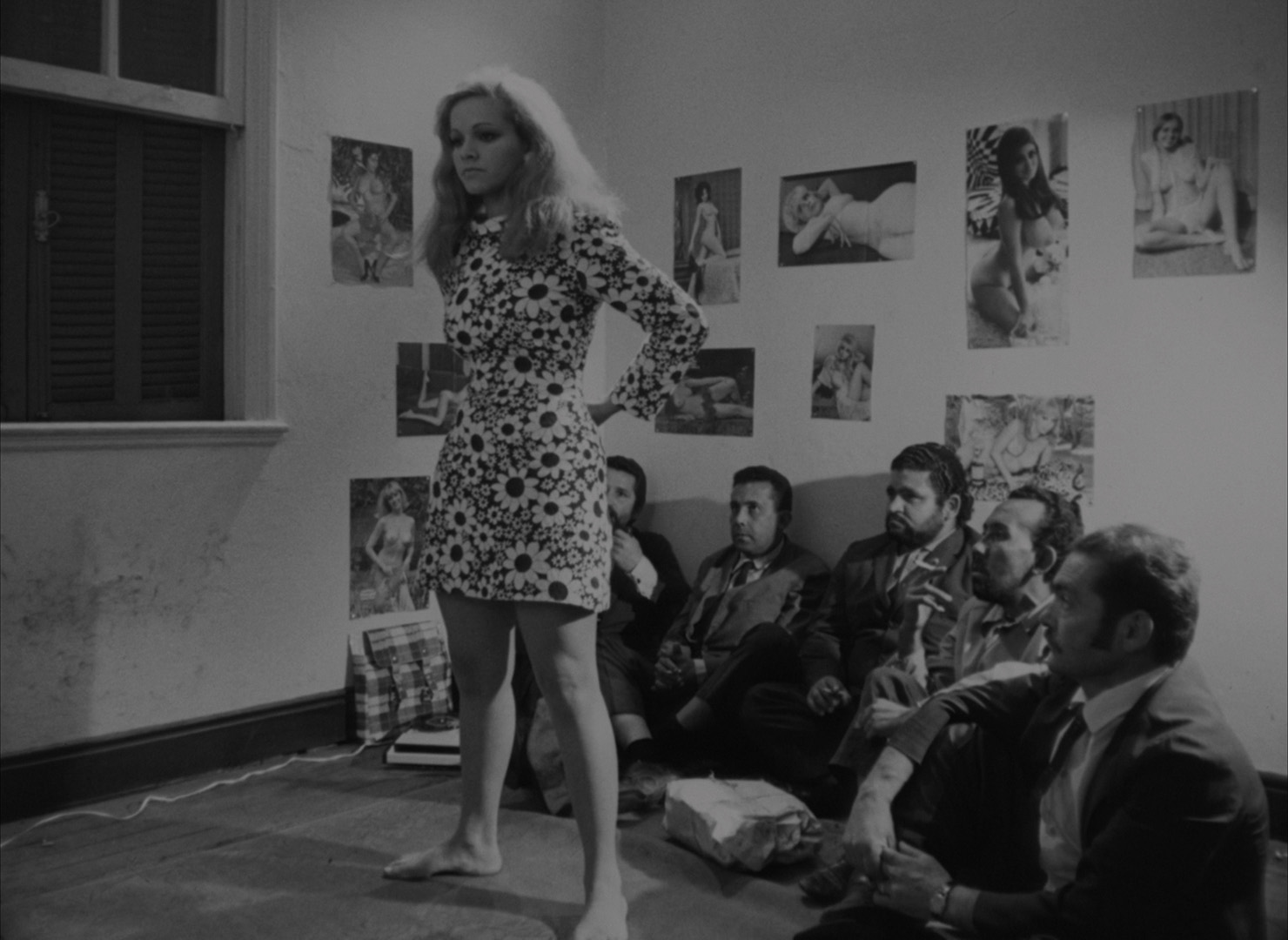
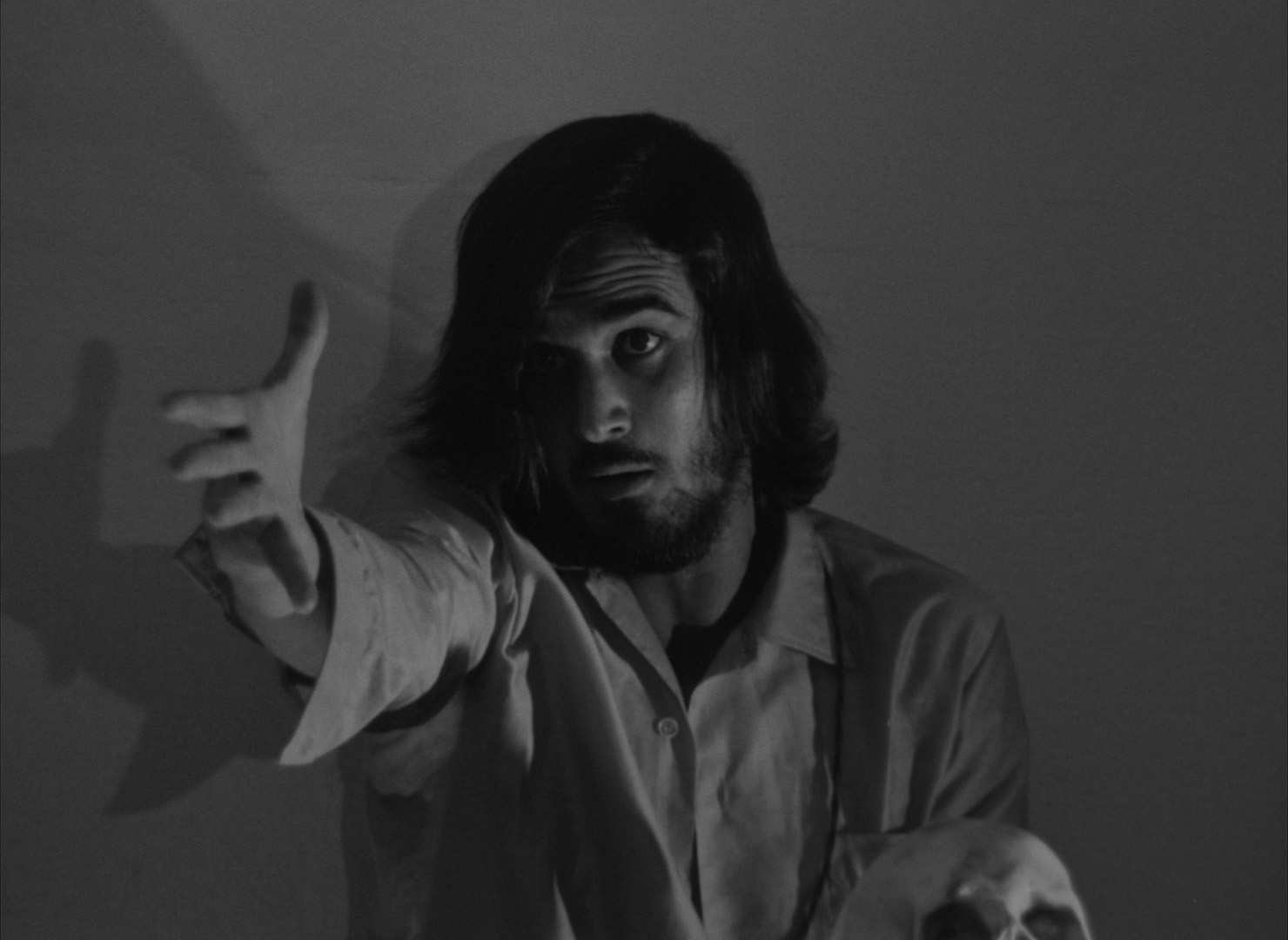
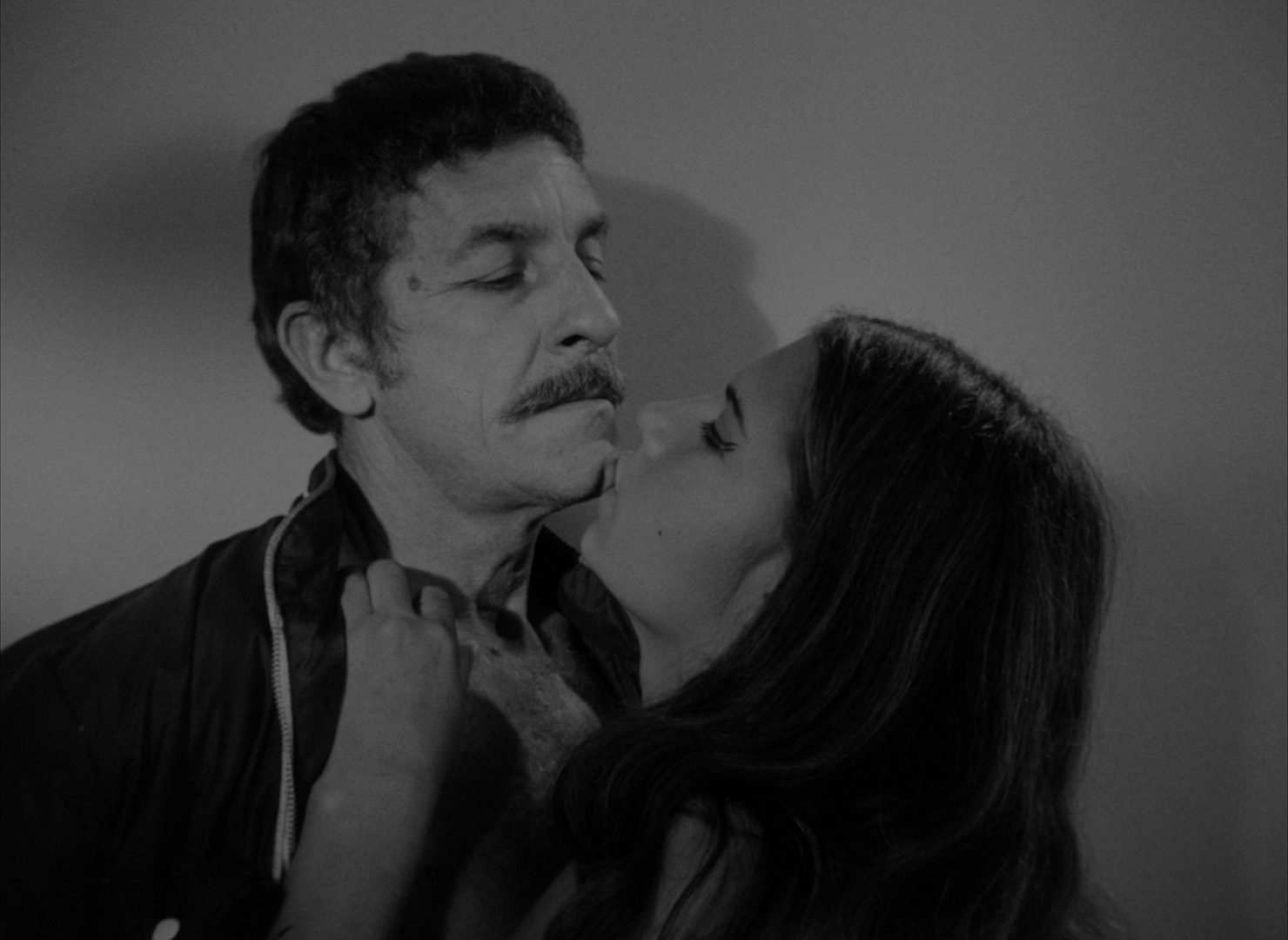
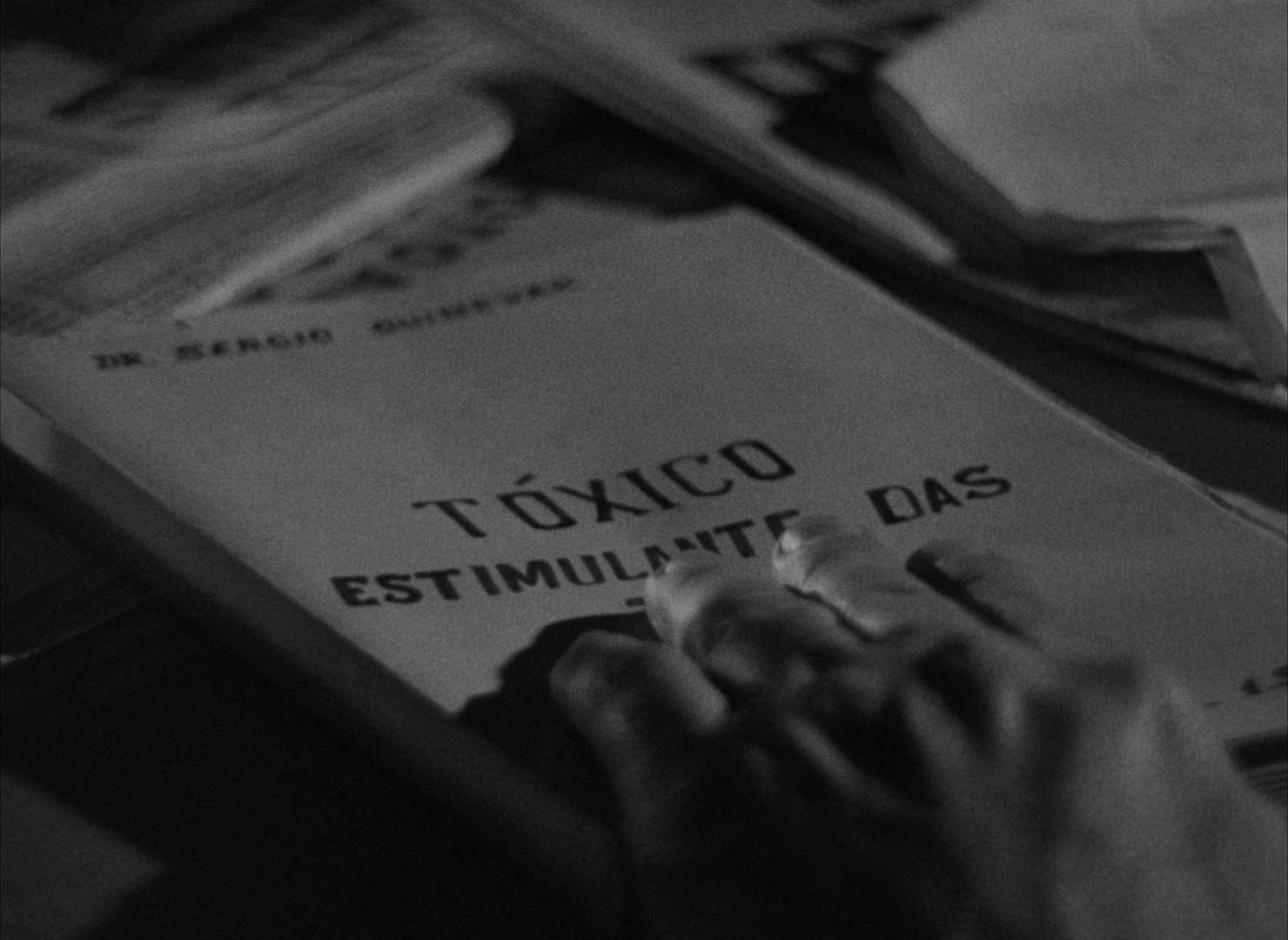
AWAKENING OF THE BEAST: Synapse Films (DVD)
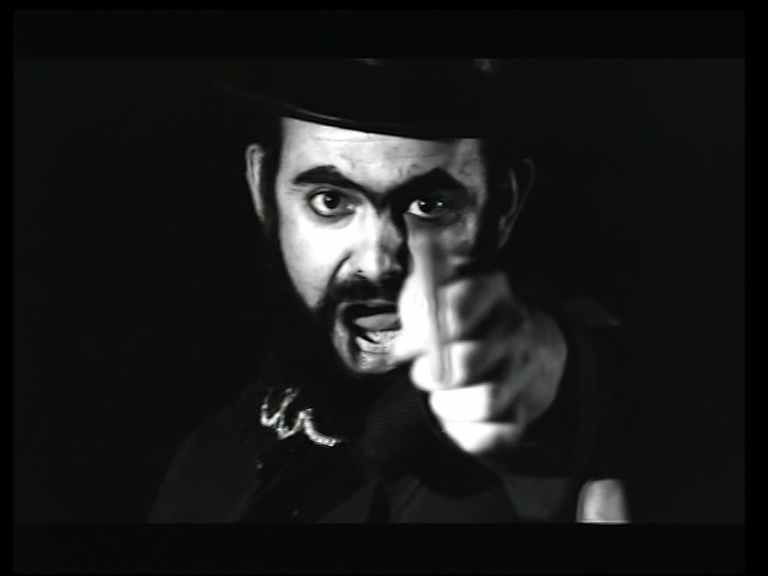
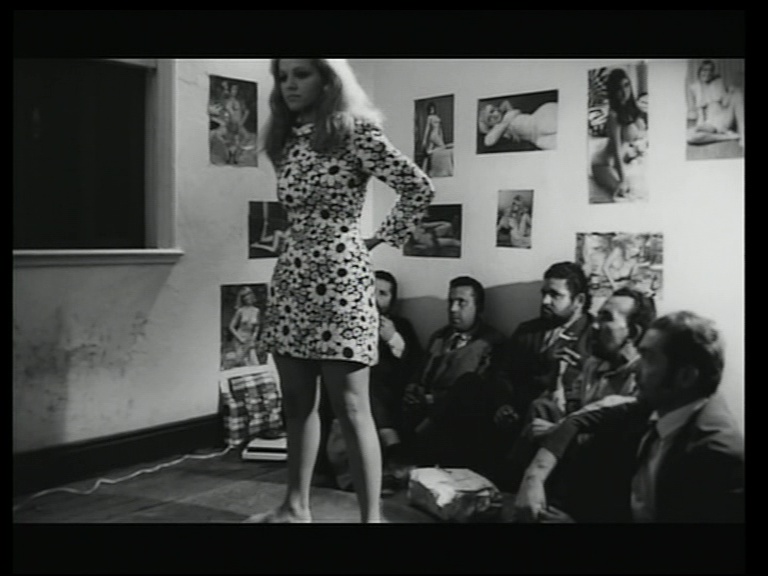
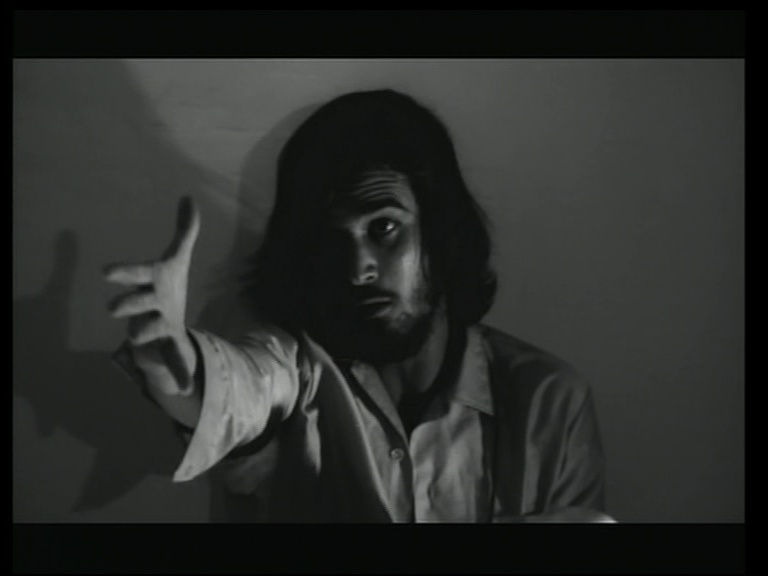
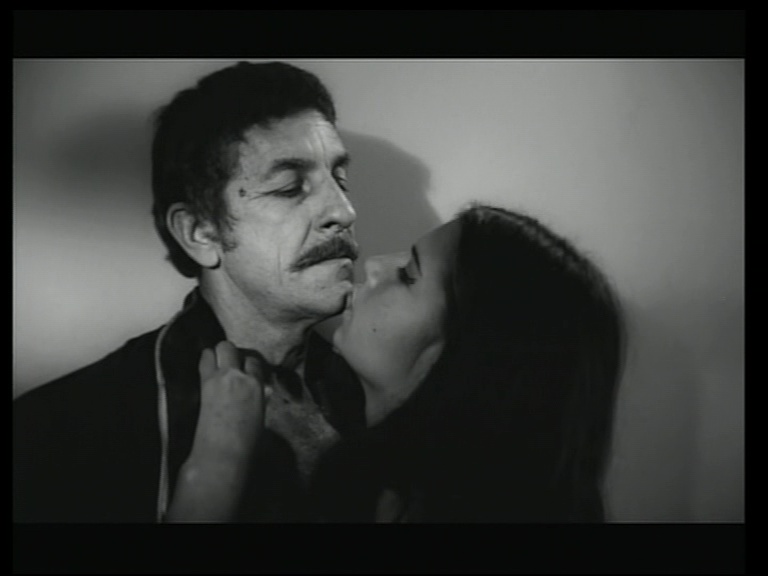
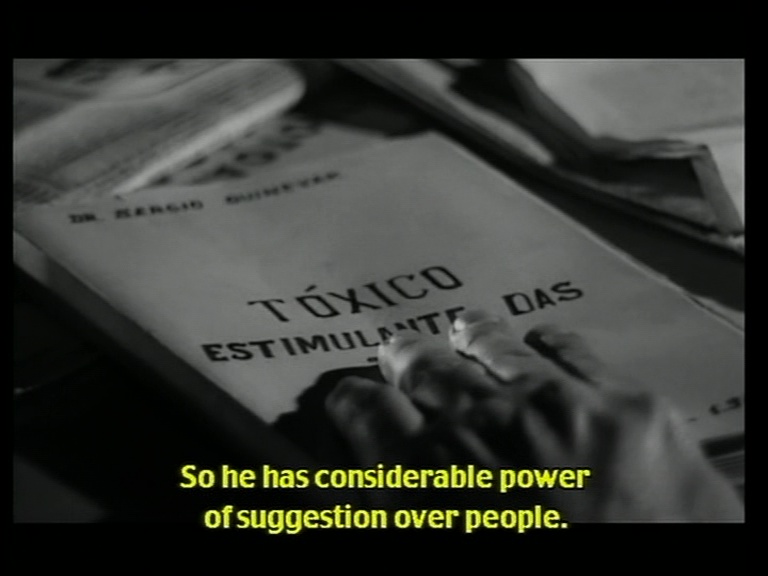
AWAKENING OF THE BEAST: Fantoma (DVD)
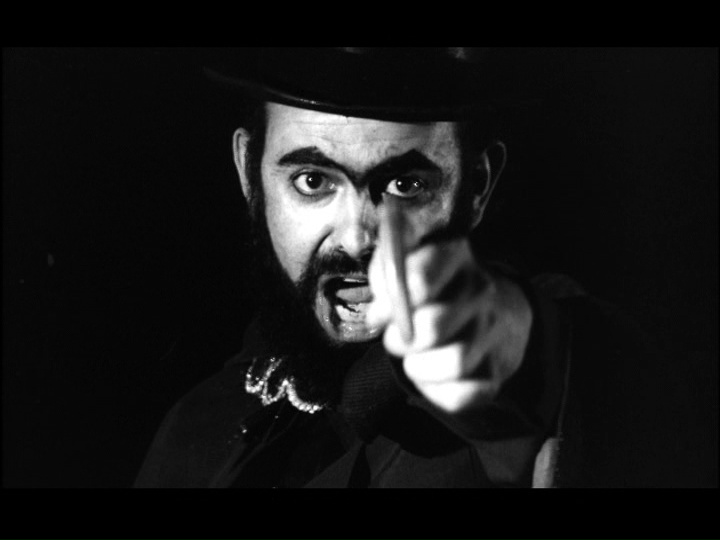
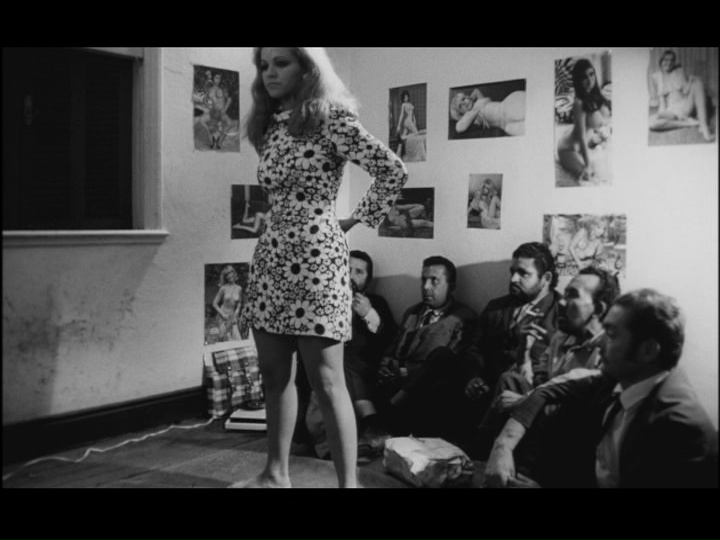
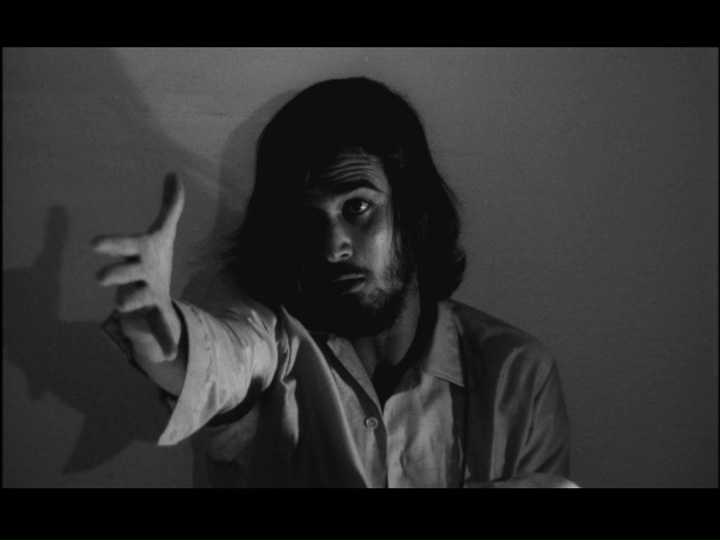
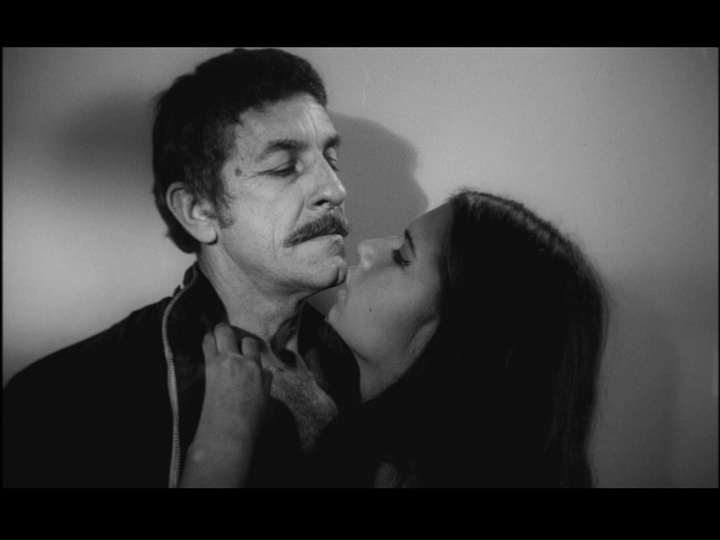
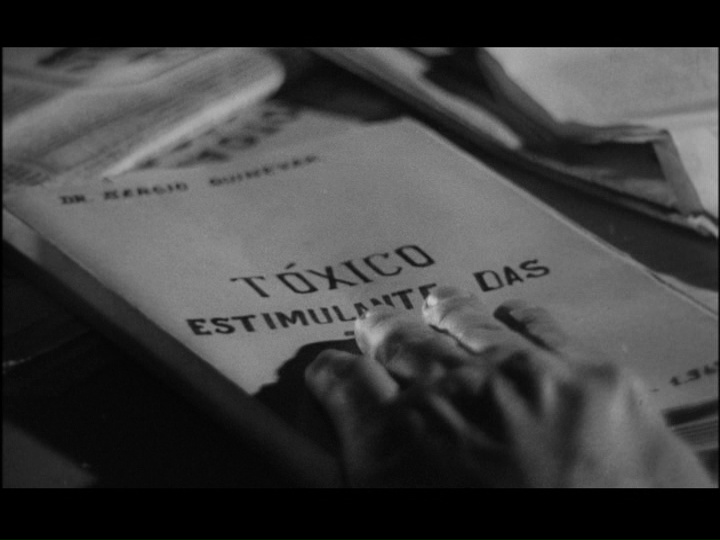
THE END OF MAN: Arrow Video (Blu-ray)
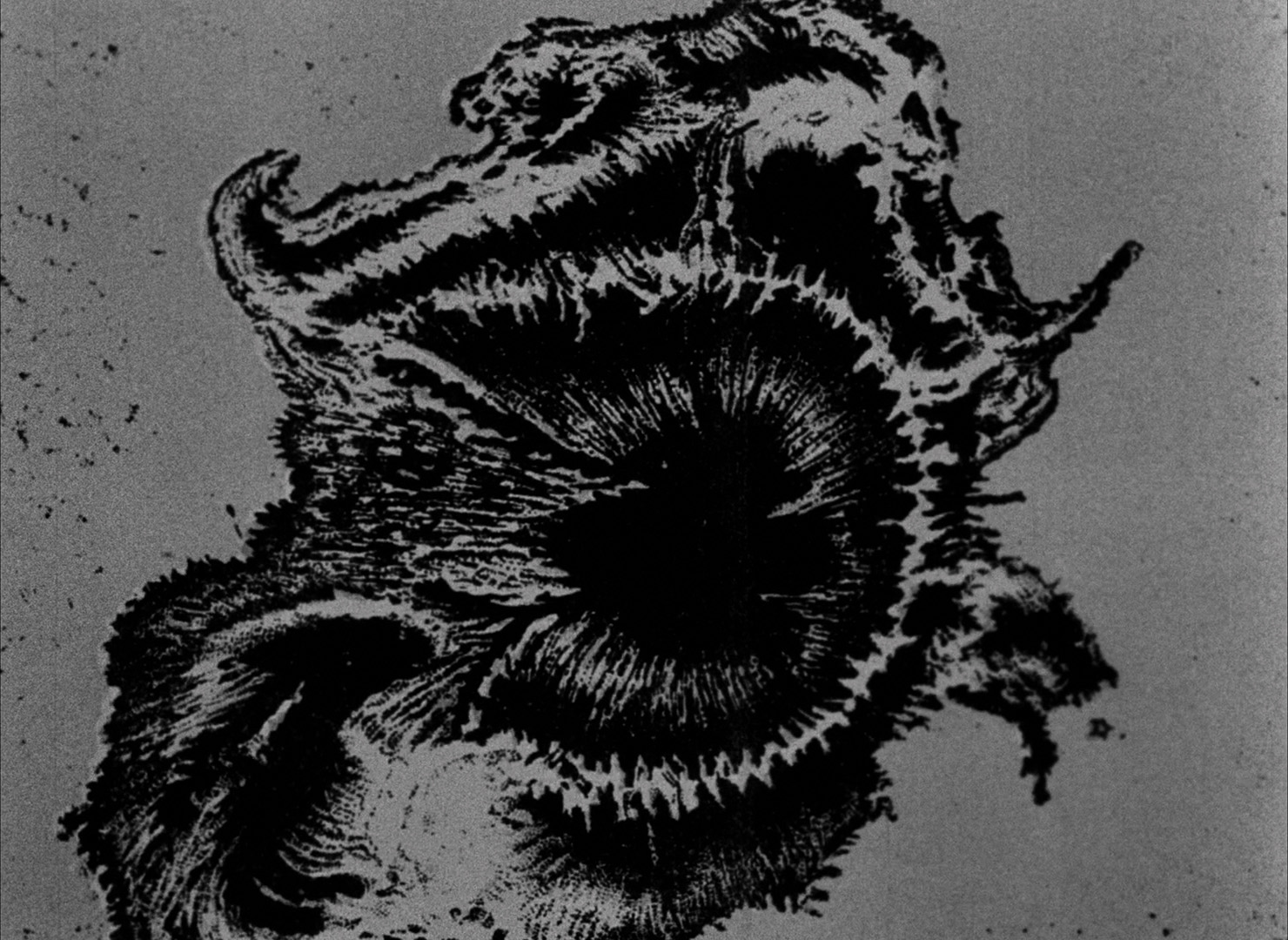
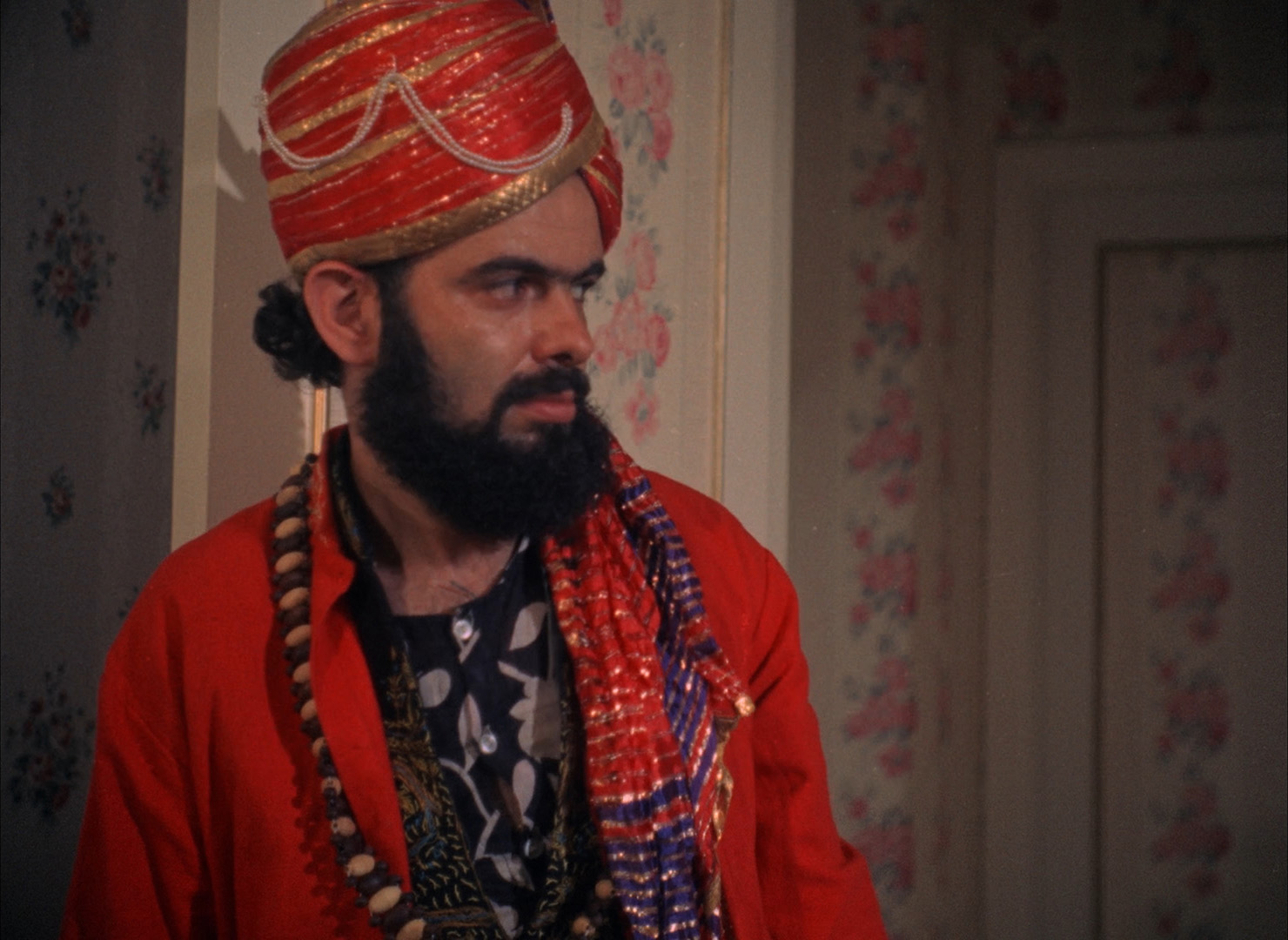
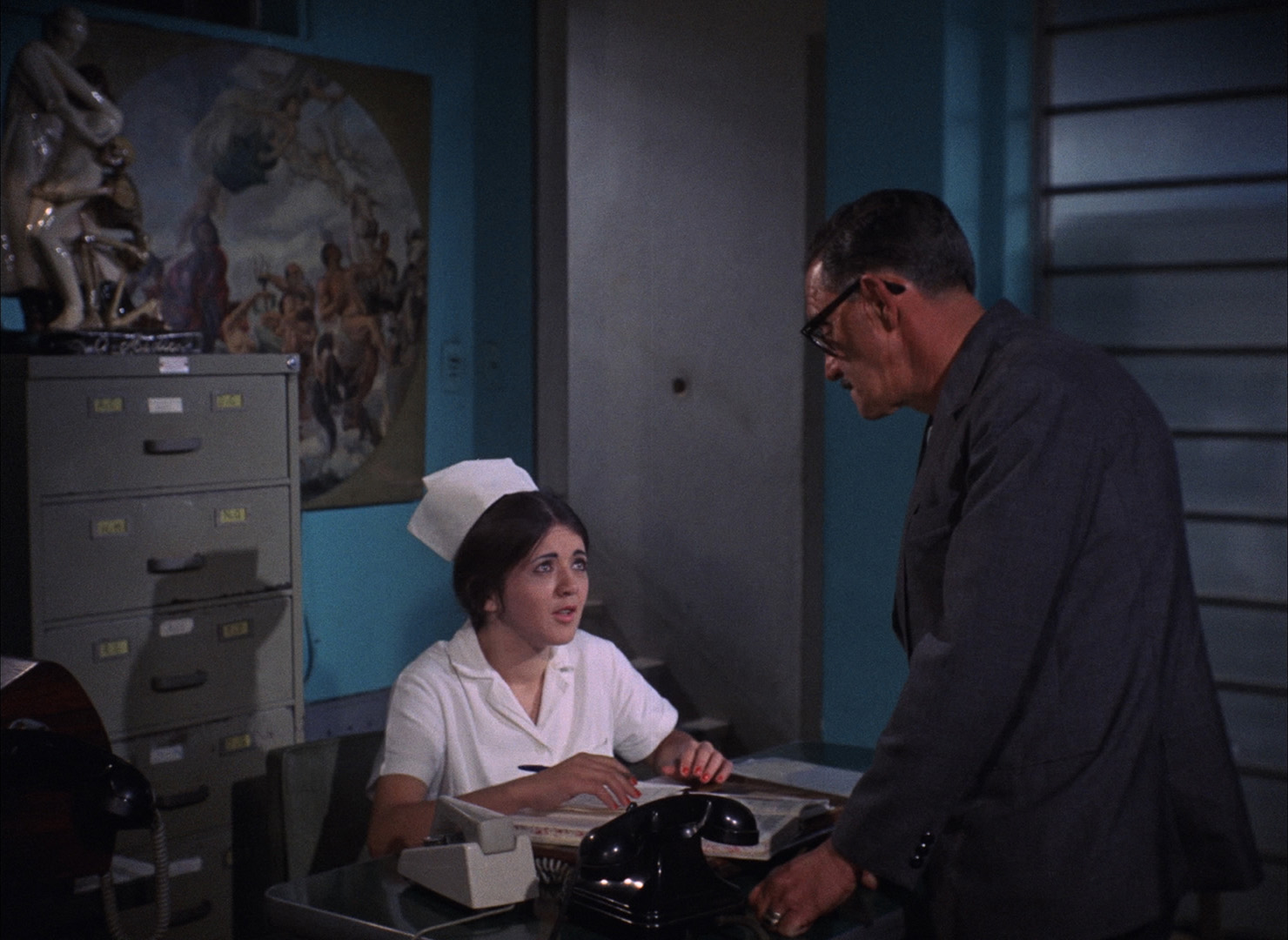
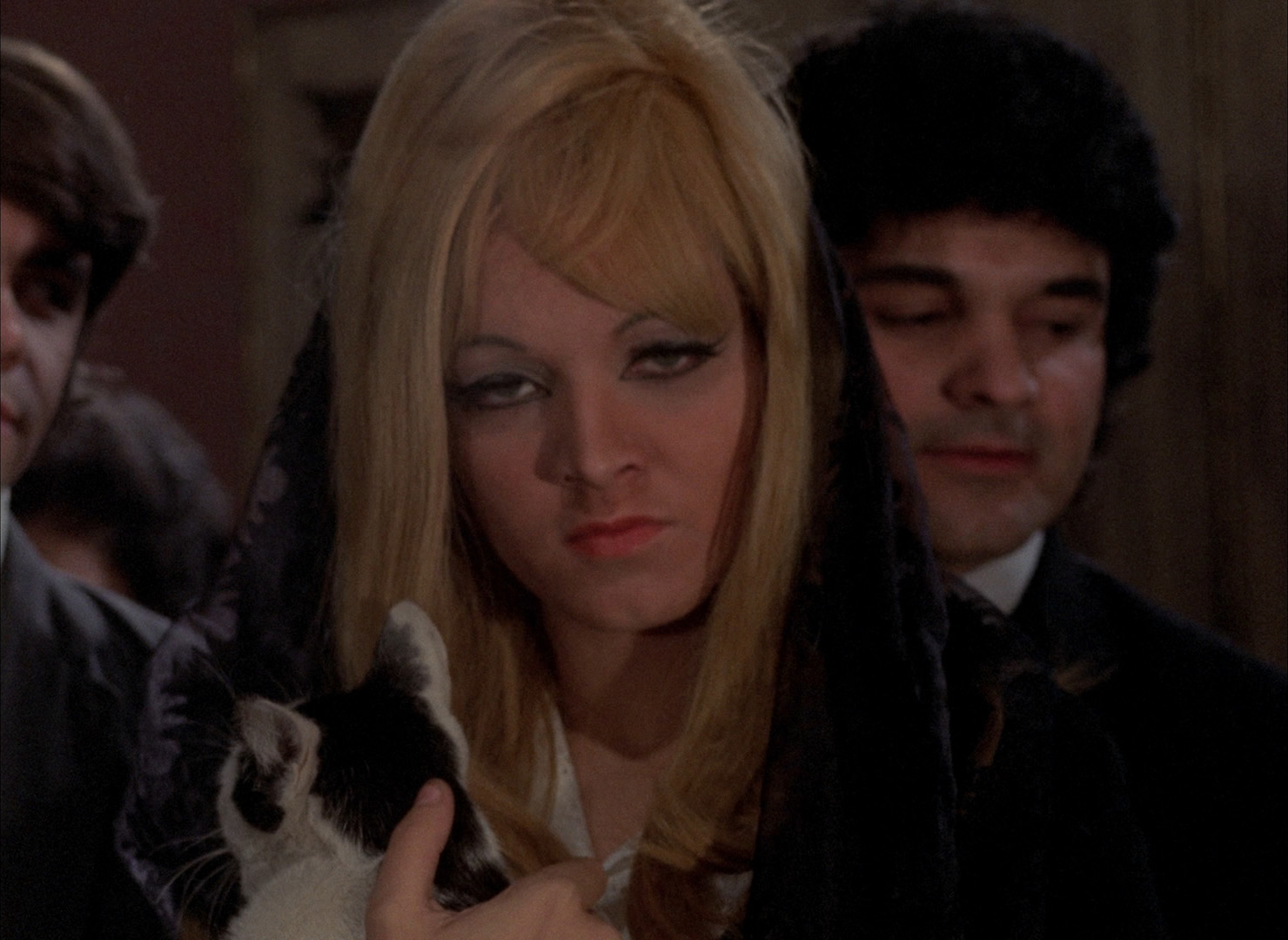
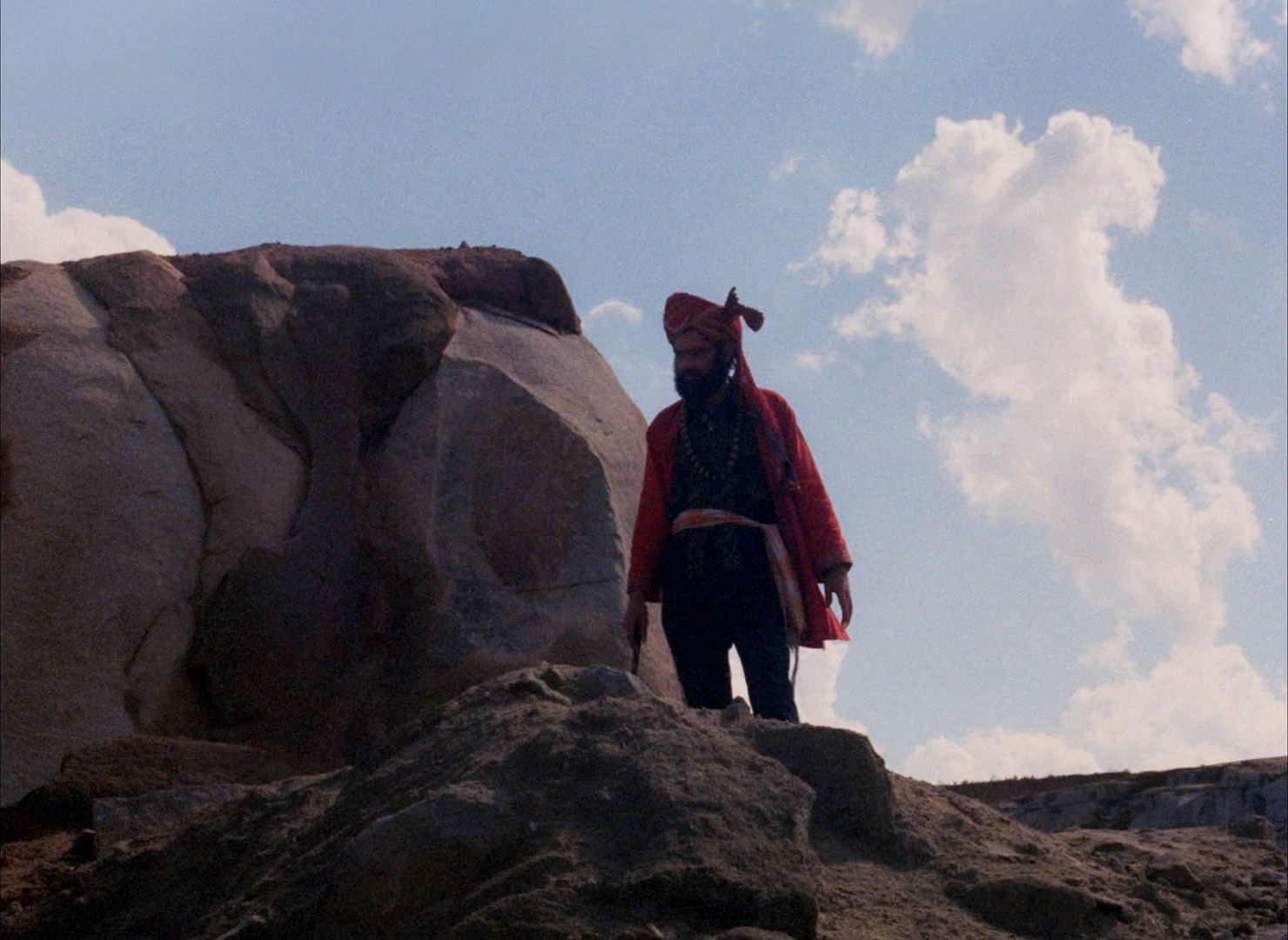
THE END OF MAN: Anchor Bay (DVD)
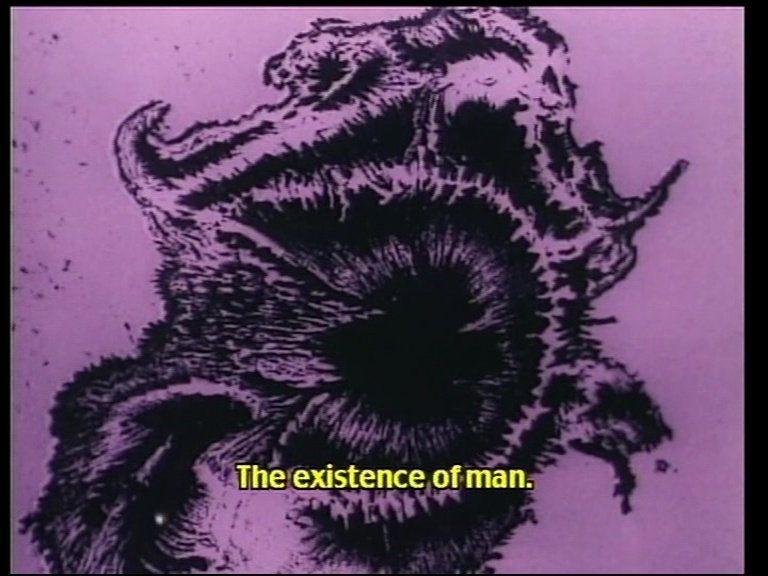
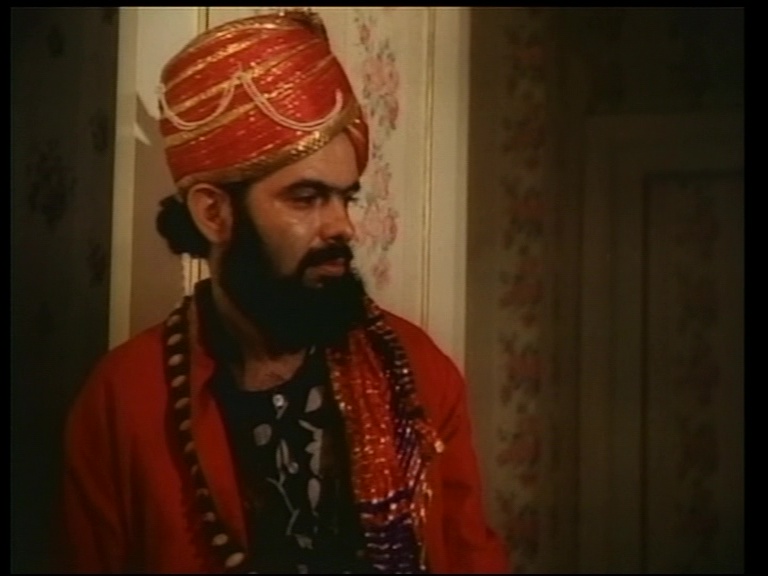
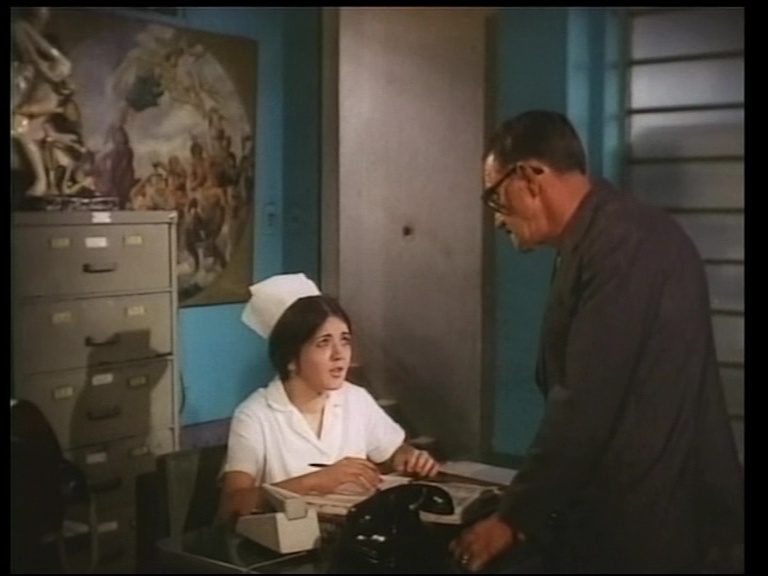
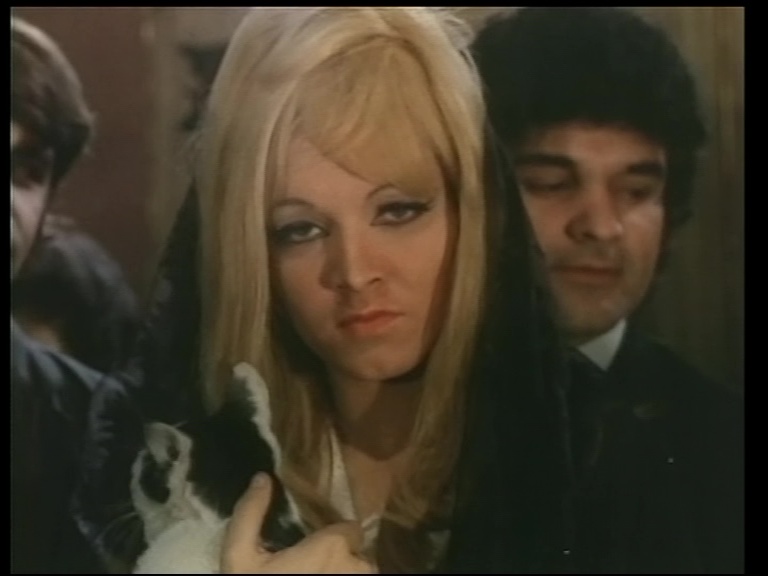
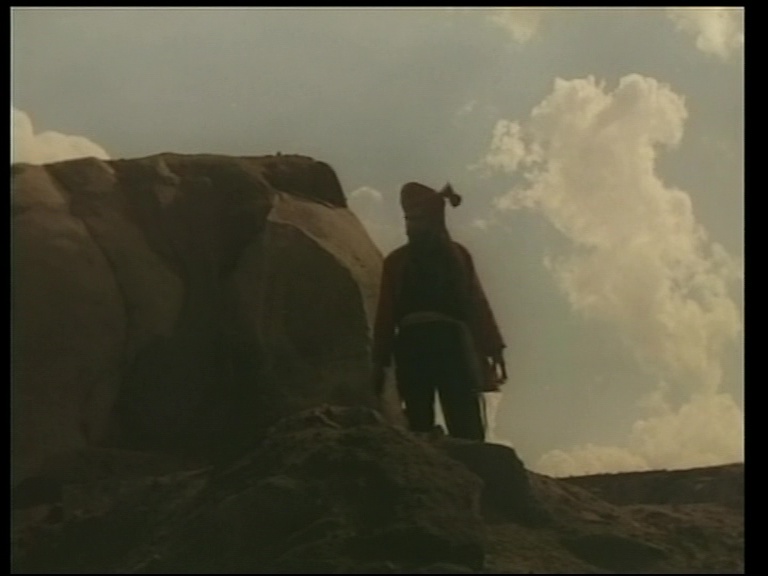
THE STRANGE HOSTEL OF NAKED PLEASURES: Arrow Video (Blu-ray)
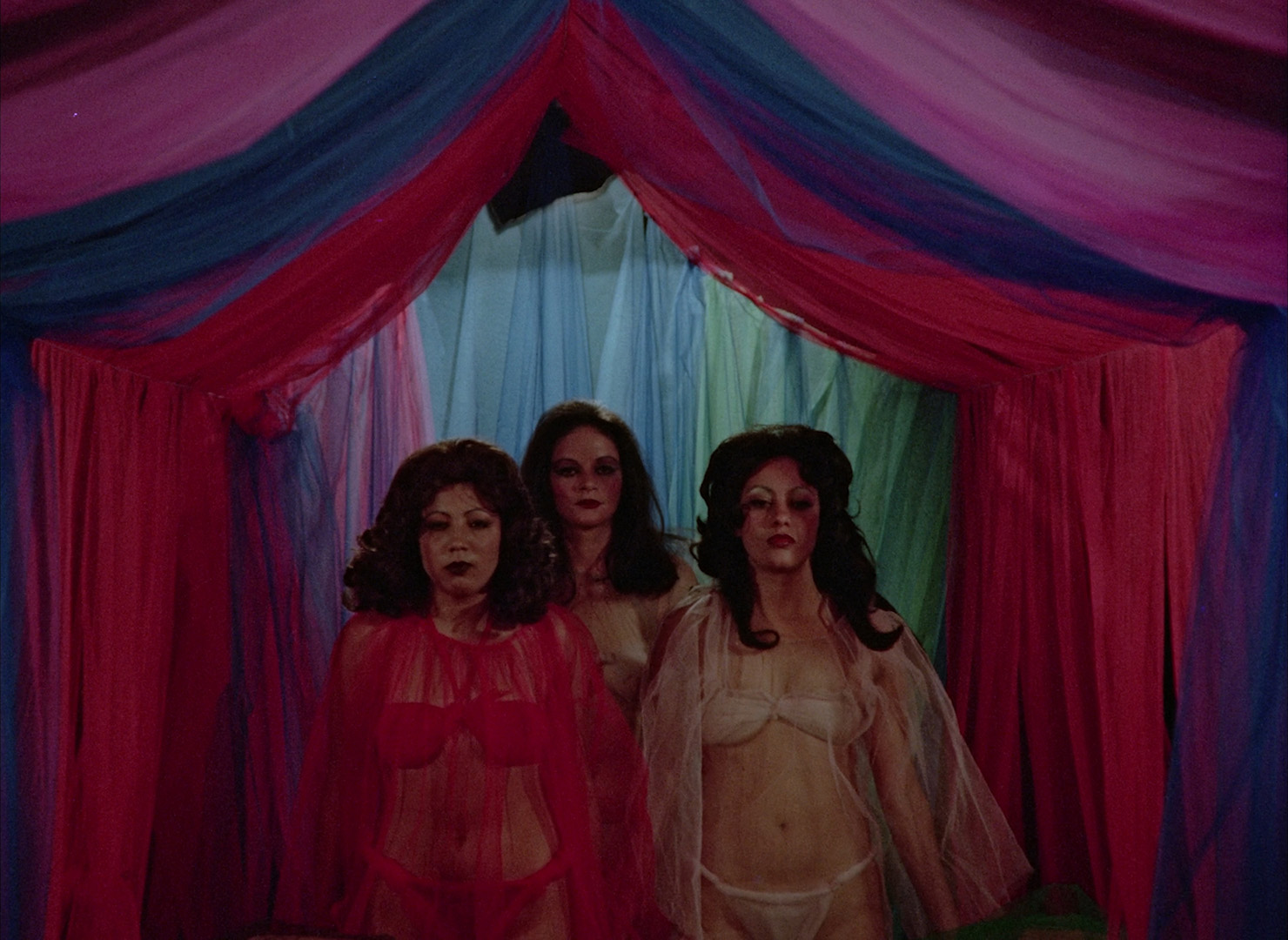
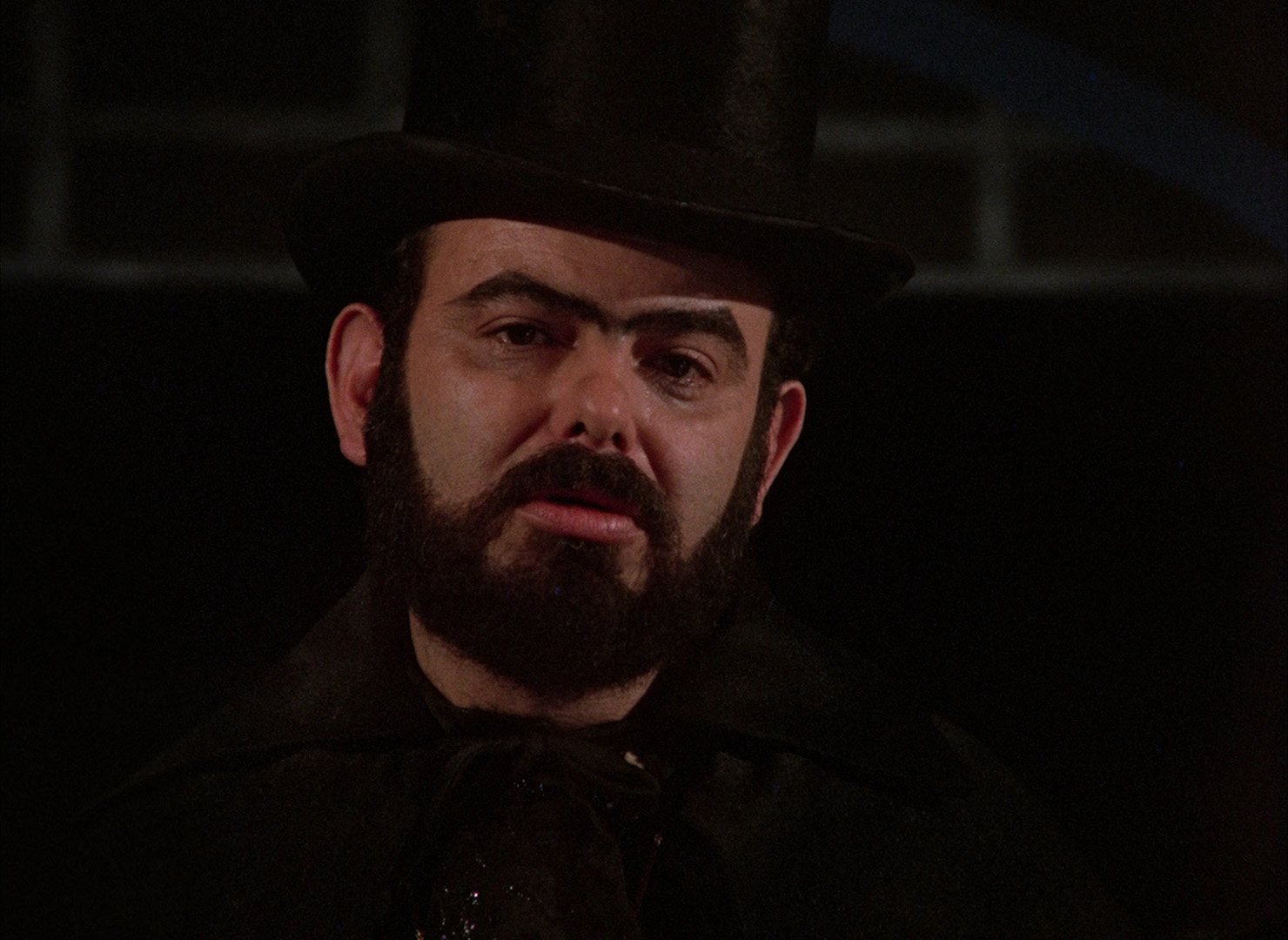
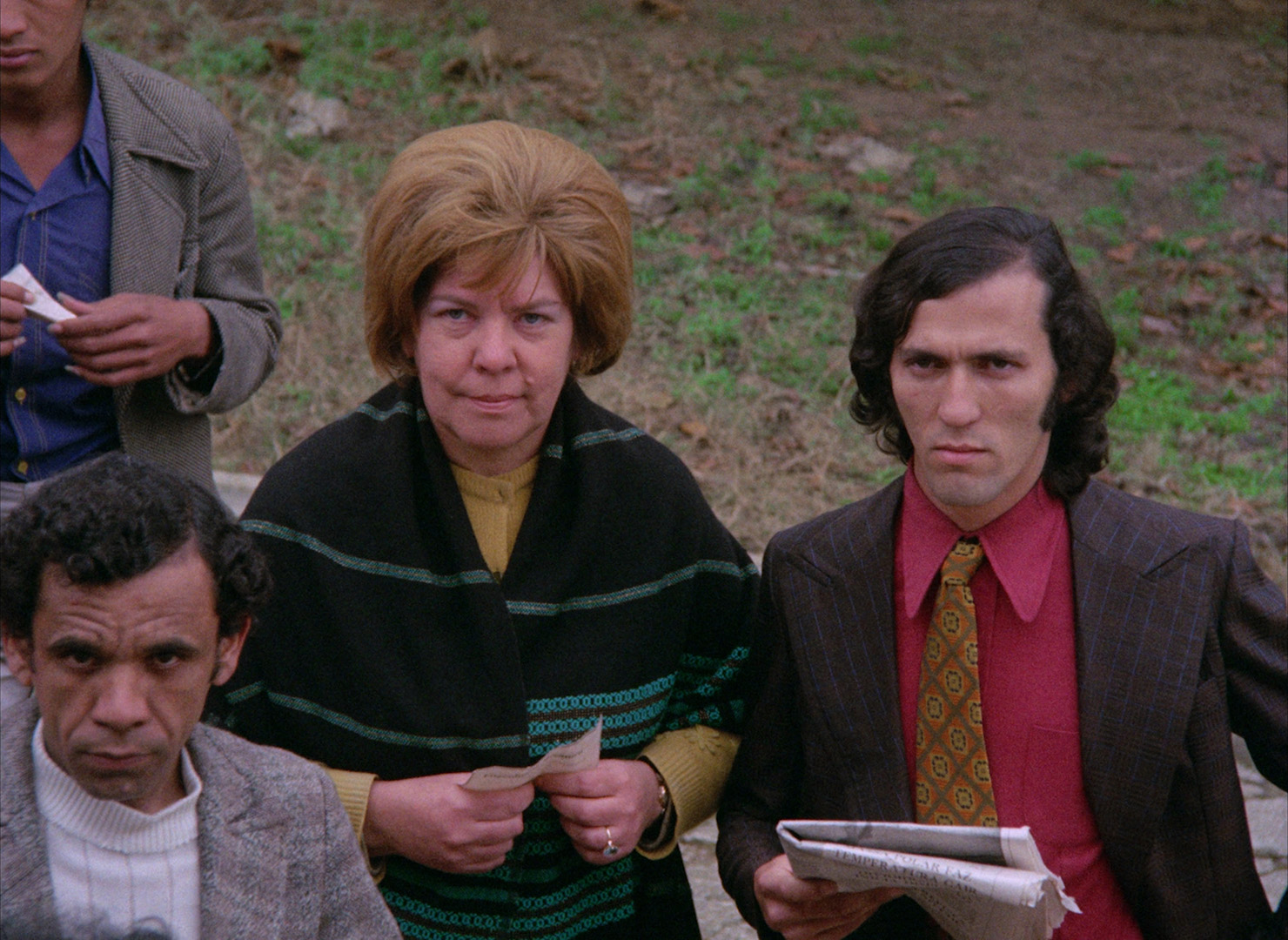
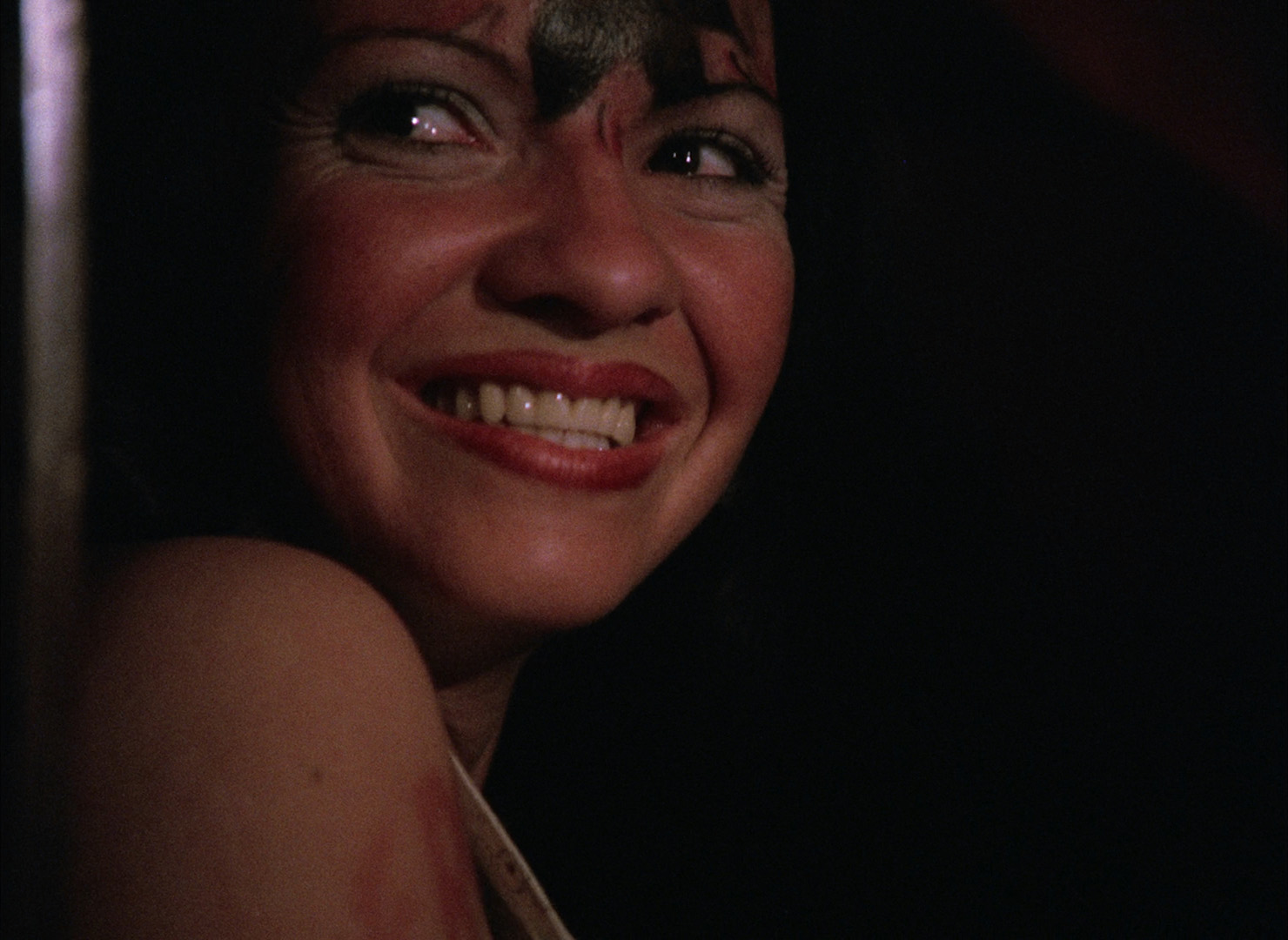
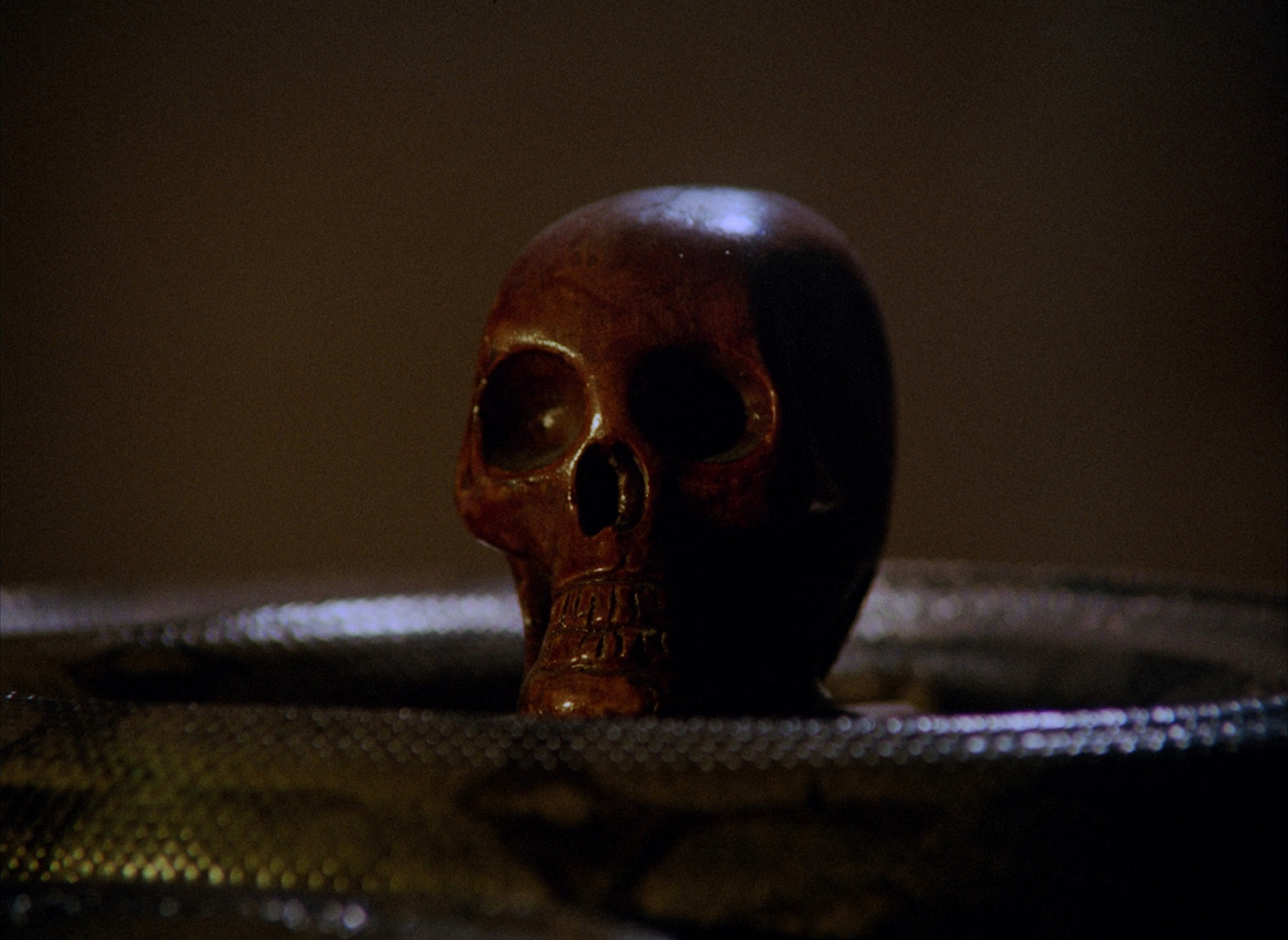
THE STRANGE HOSTEL OF NAKED PLEASURES: Anchor Bay (DVD)
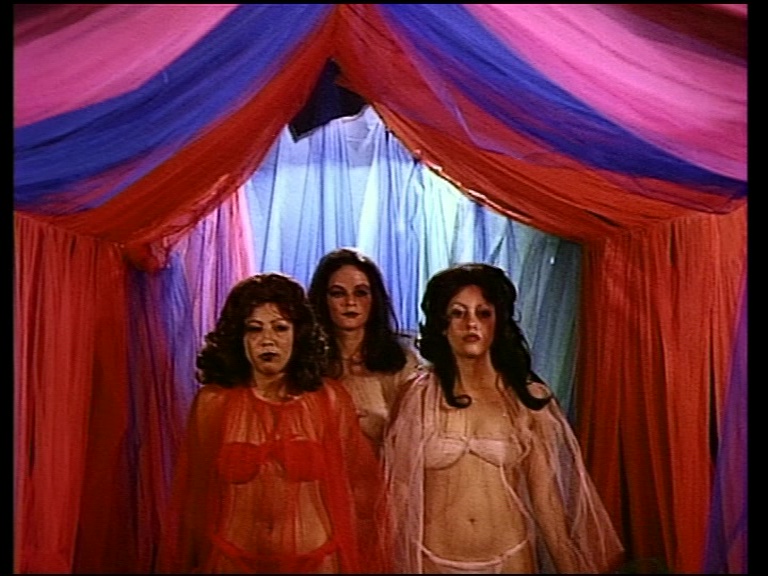
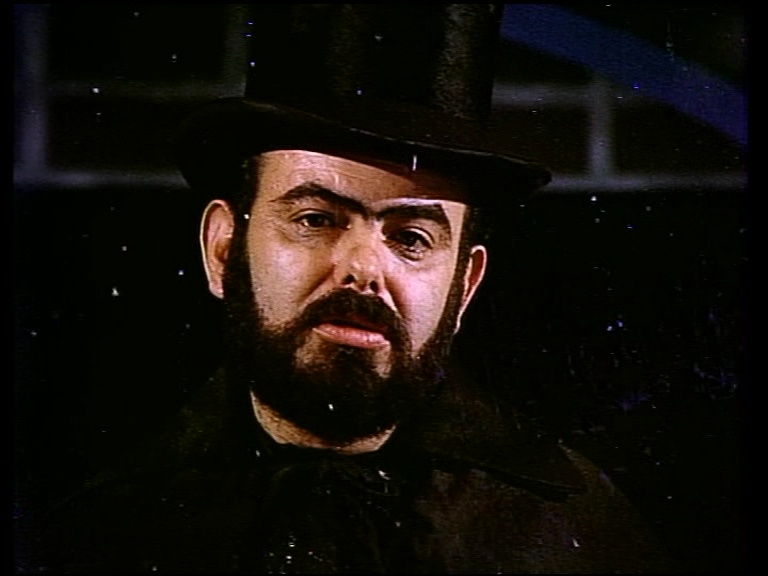
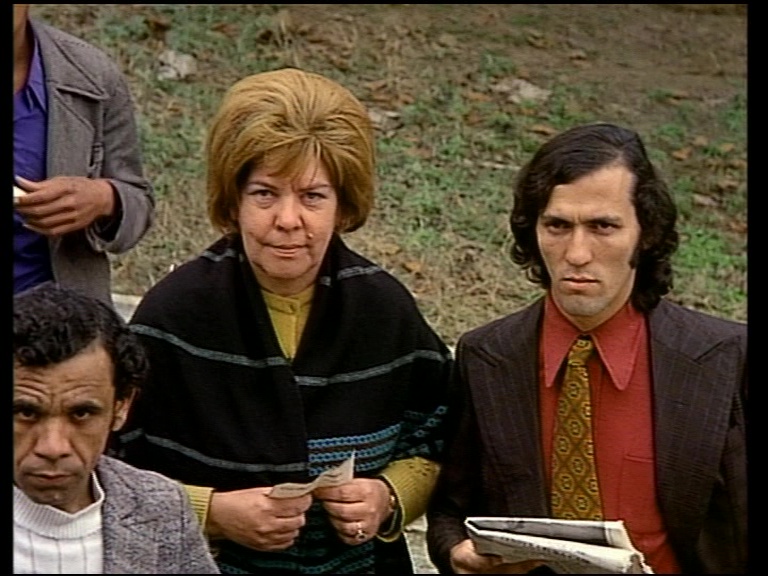
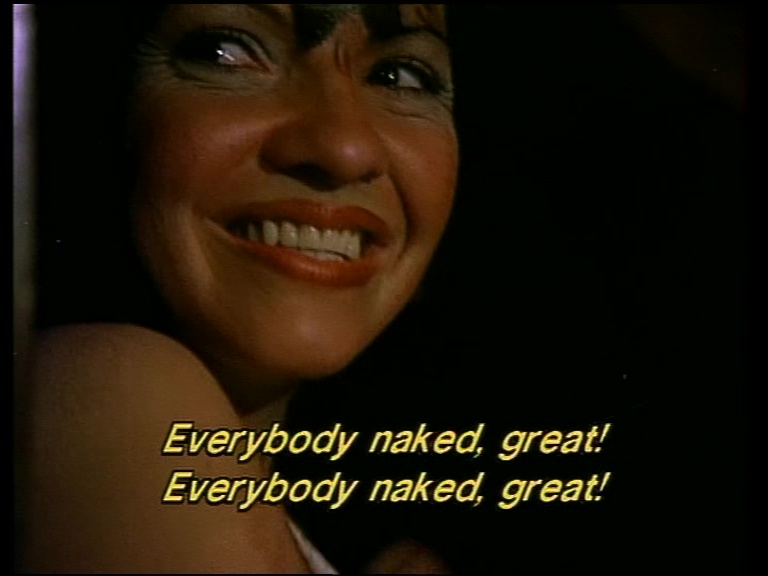
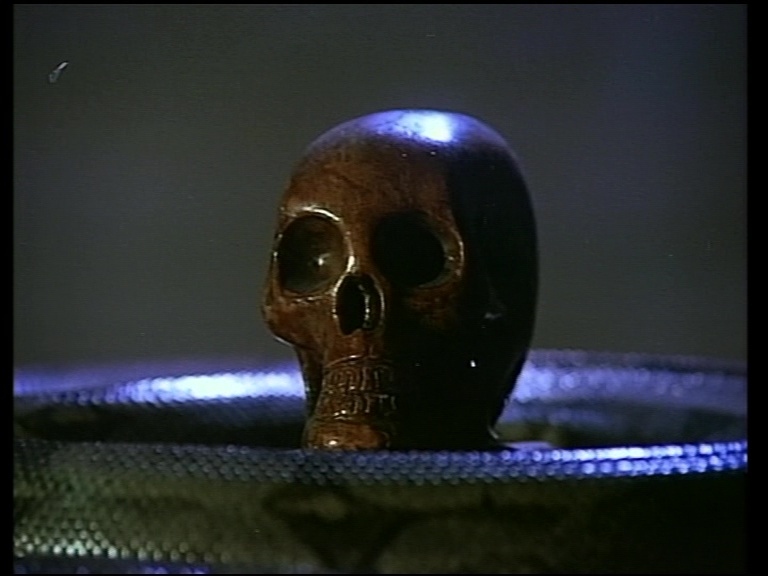
HELLISH FLESH: Arrow Video (Blu-ray)
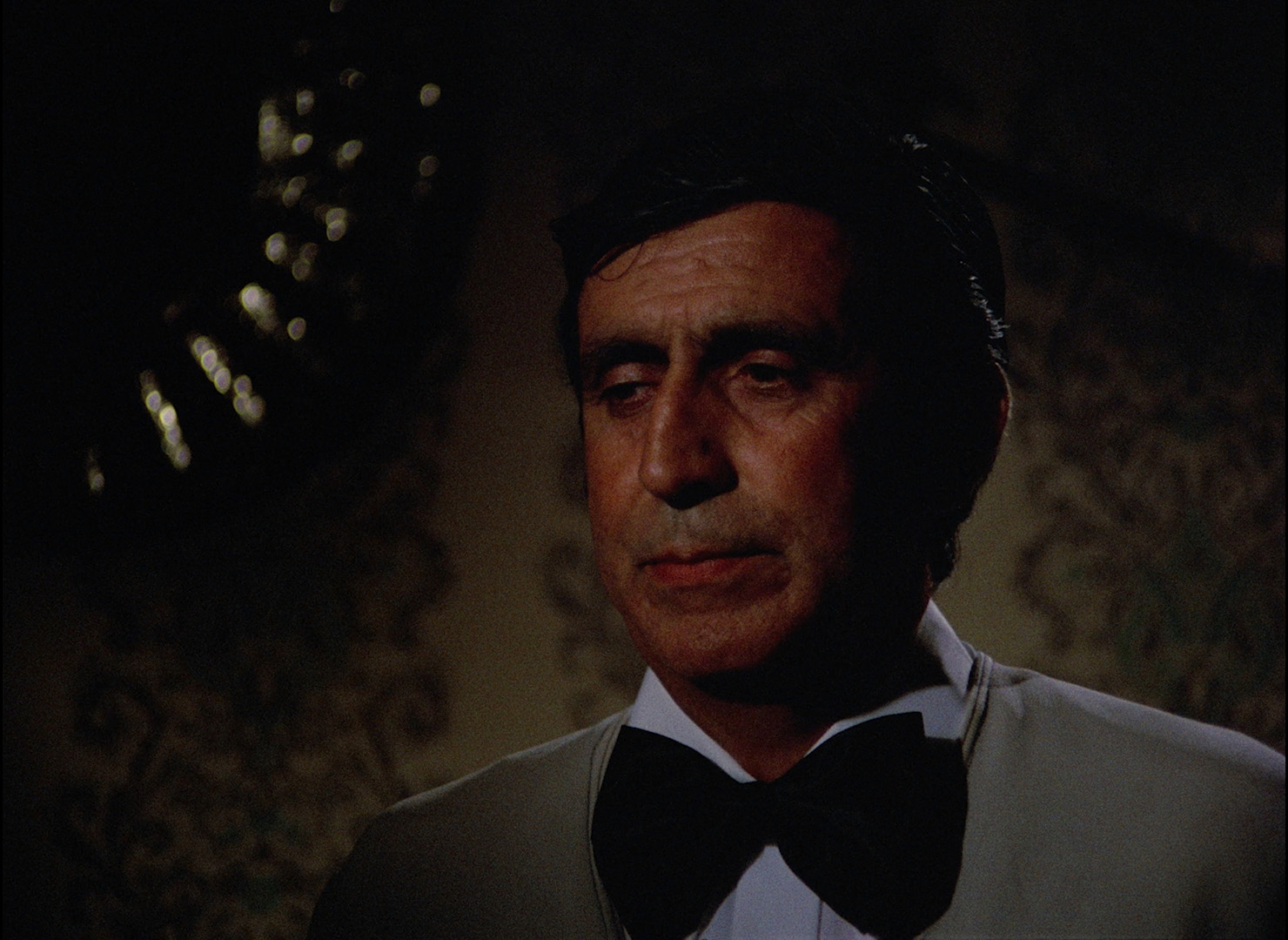
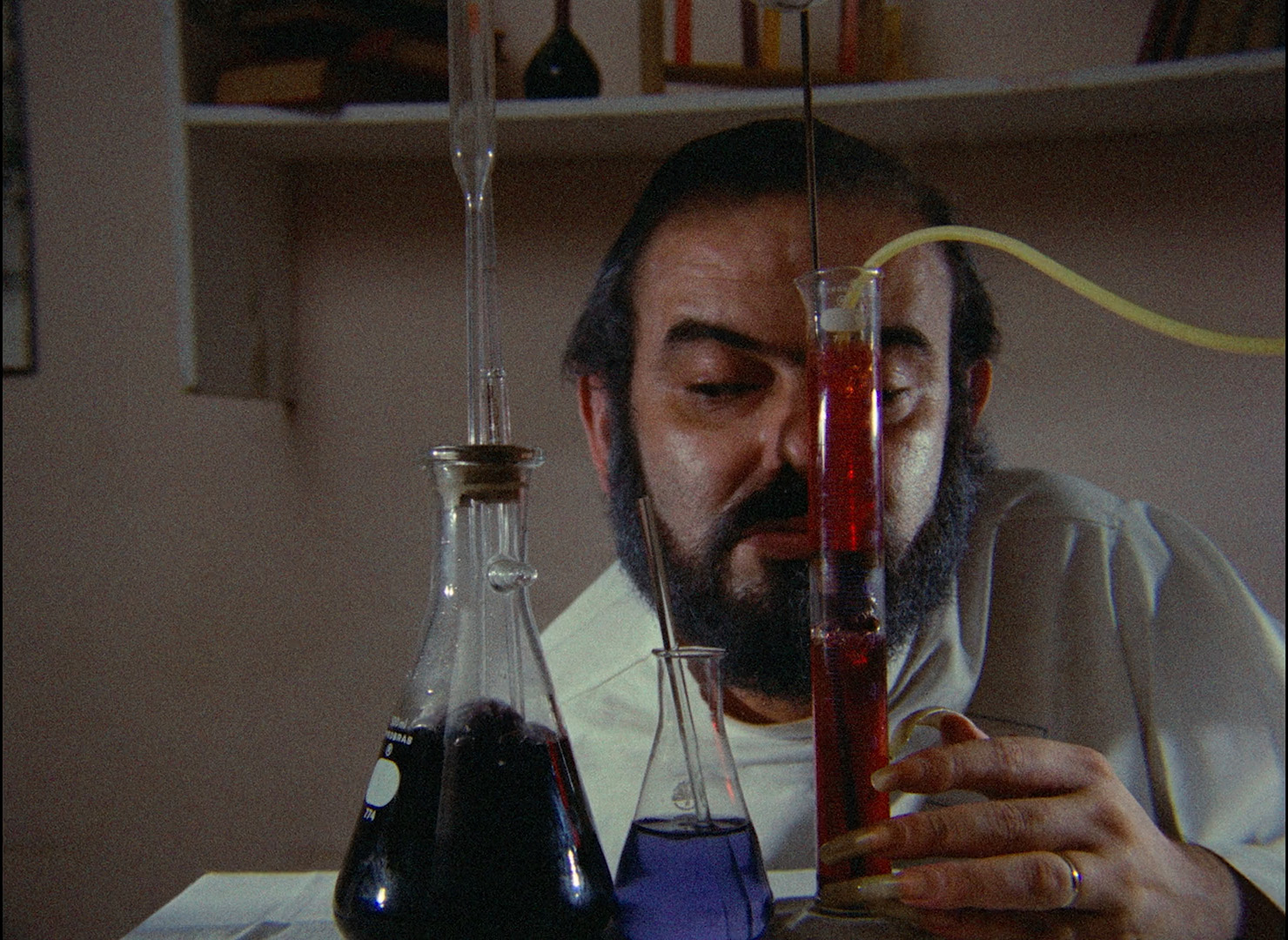
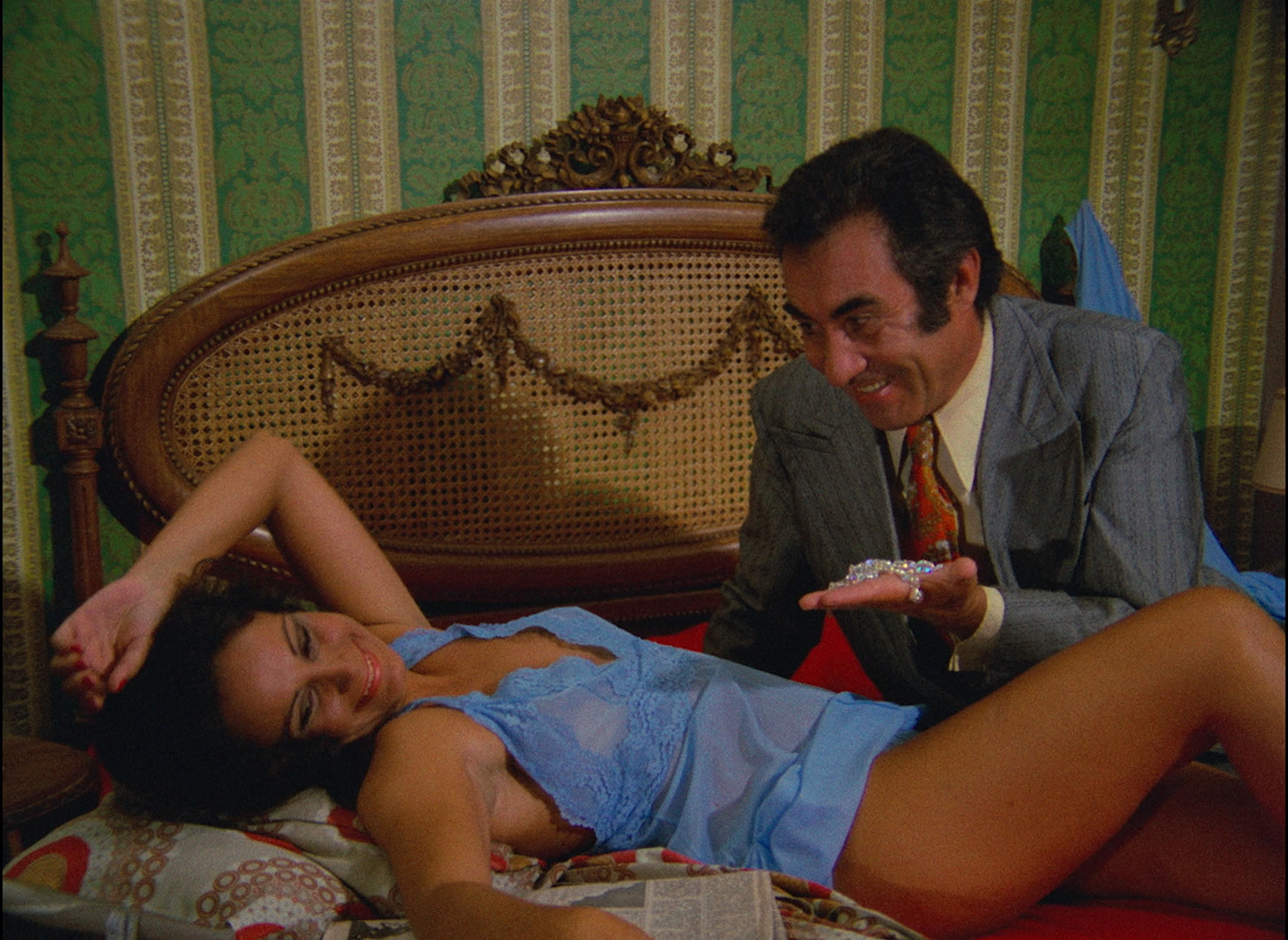
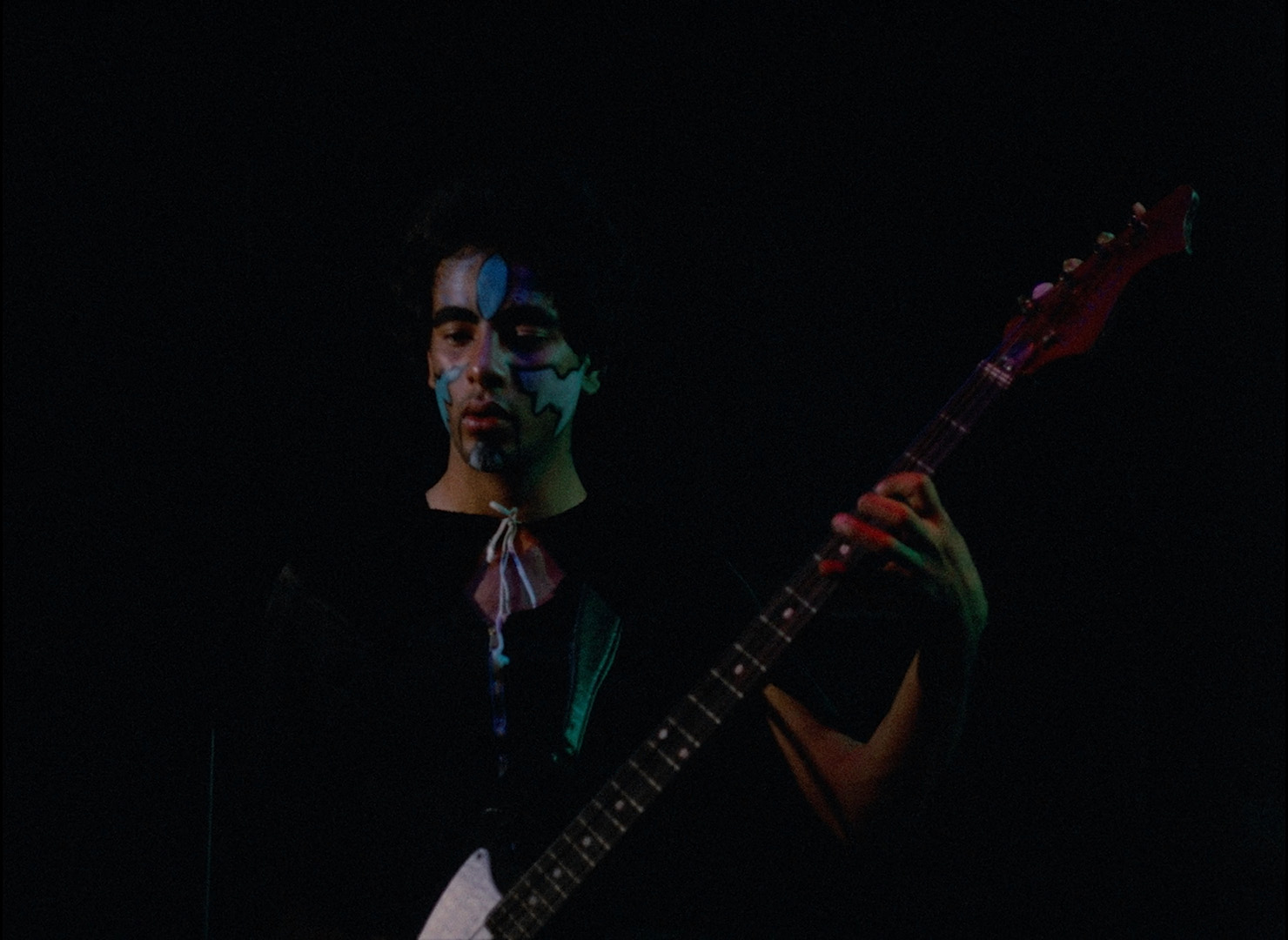
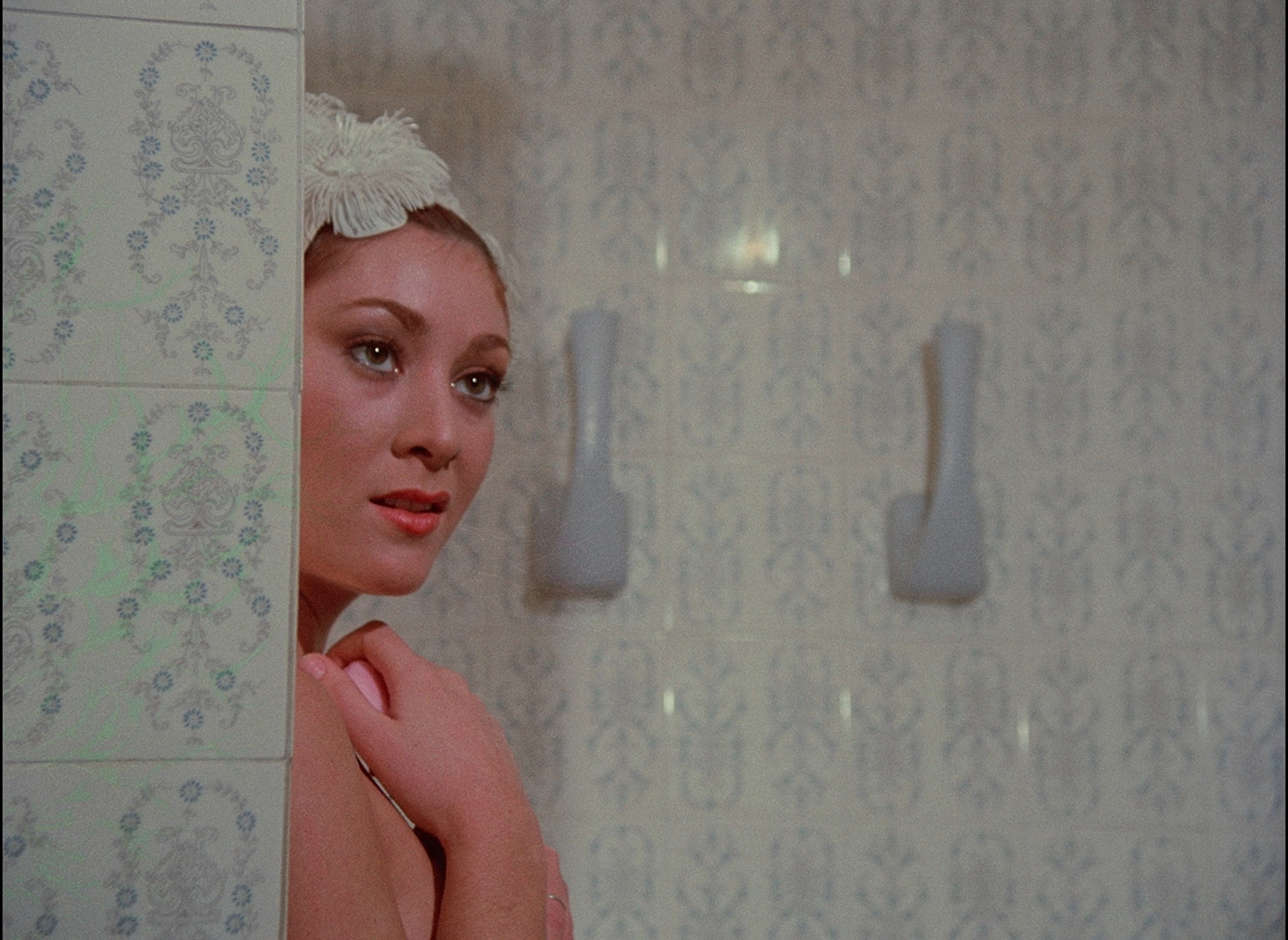
HELLISH FLESH: Anchor Bay (DVD)
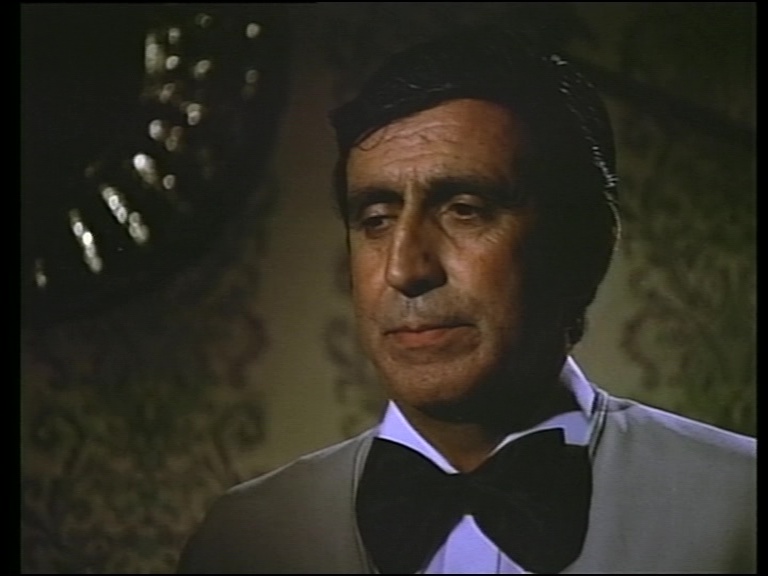
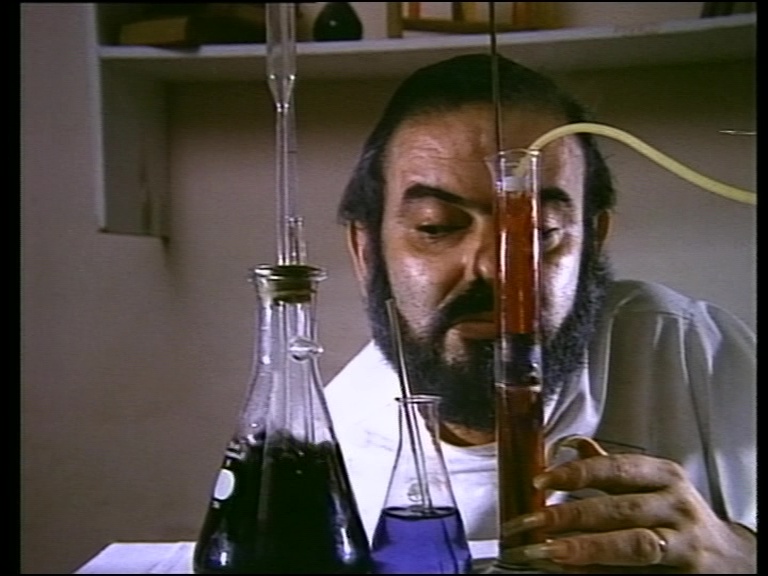
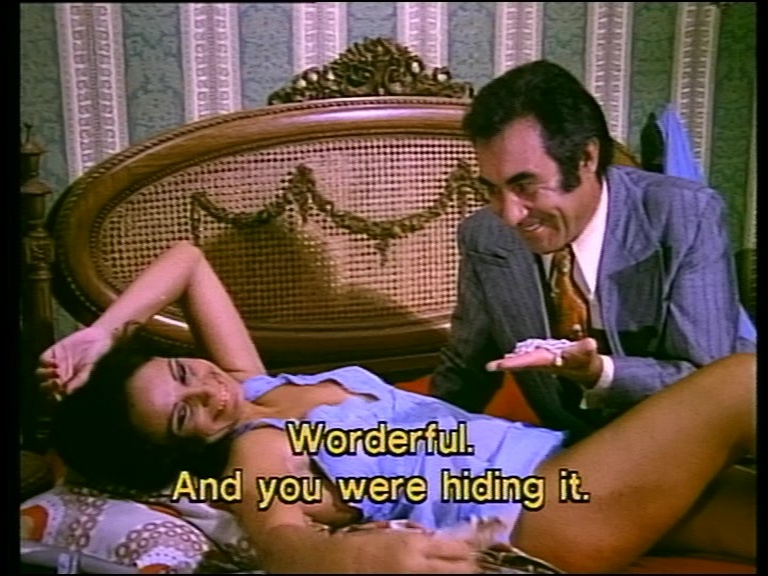
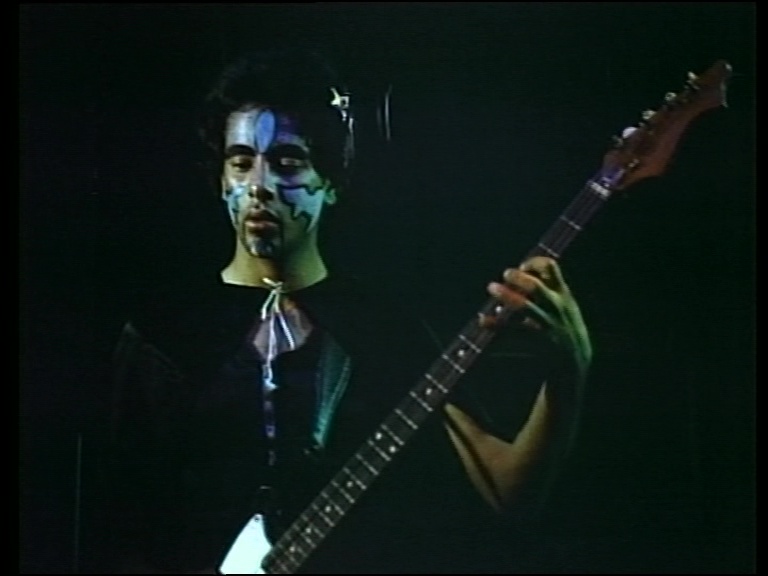
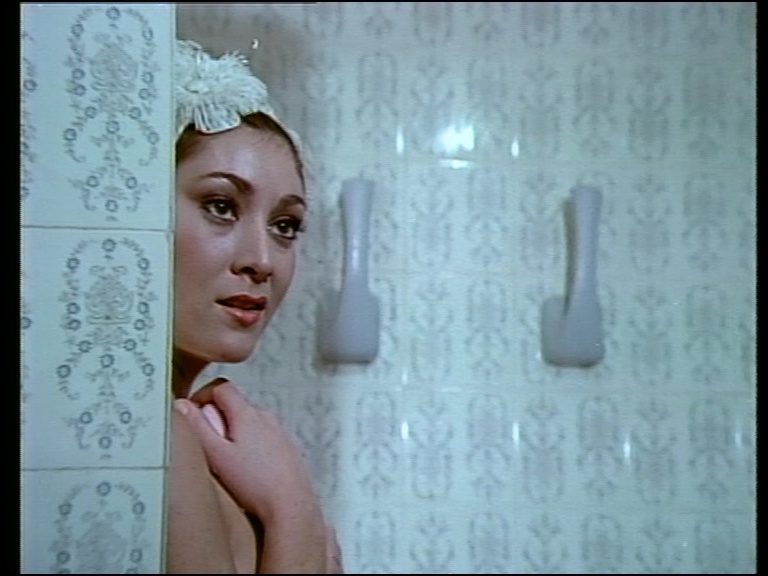
HALLUCINATIONS OF A DERANGED MIND: Arrow Video (Blu-ray)
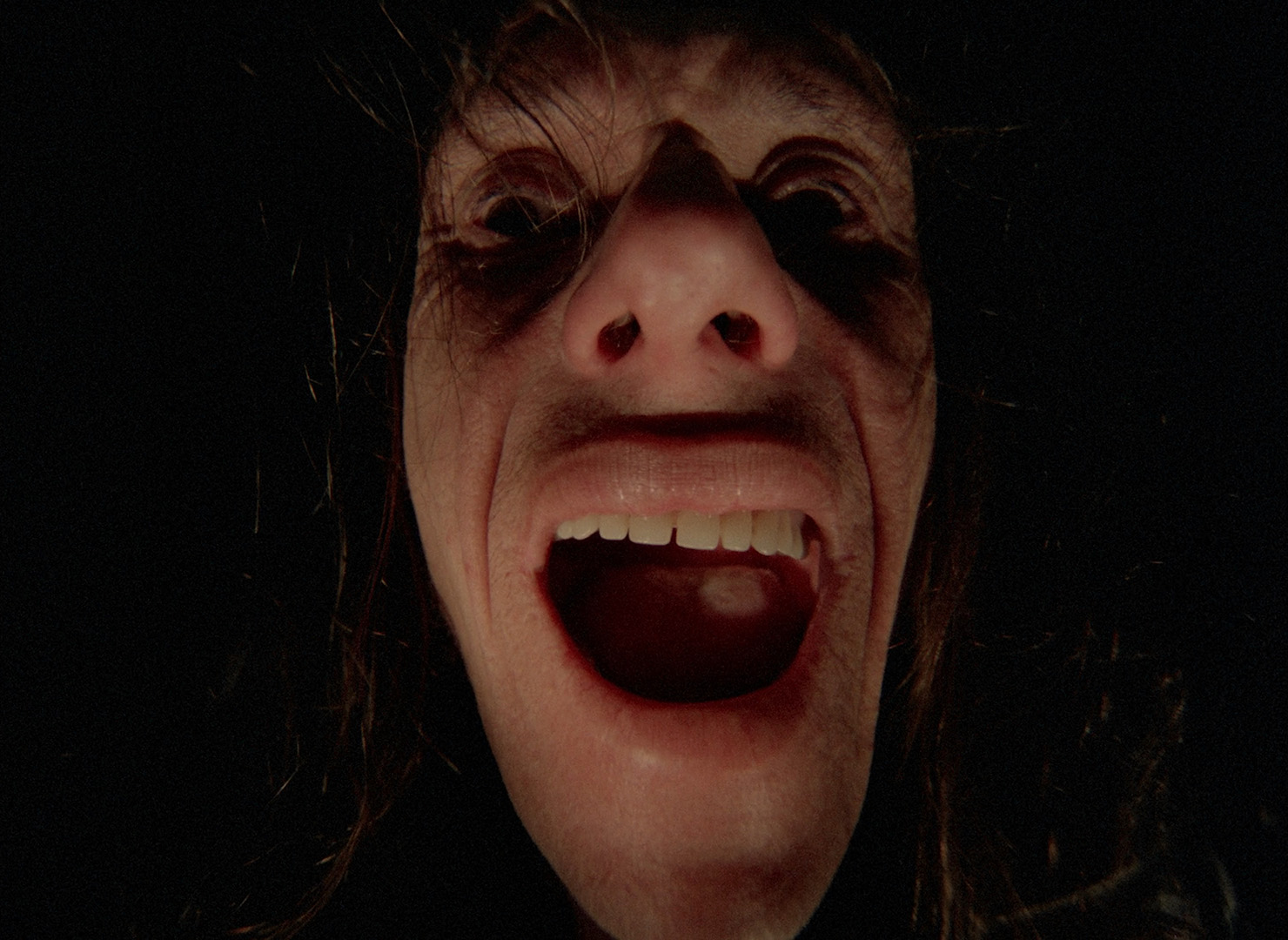
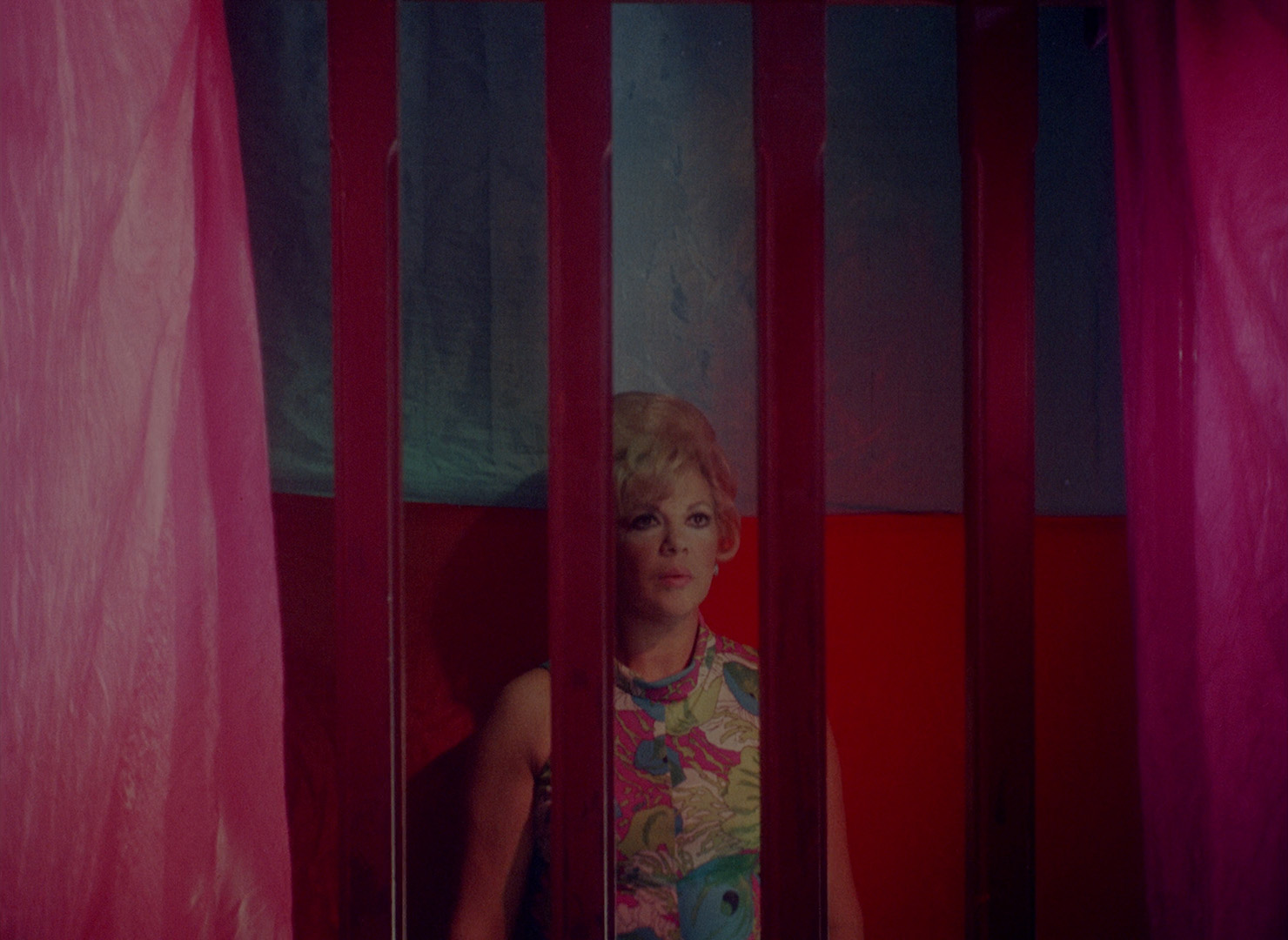
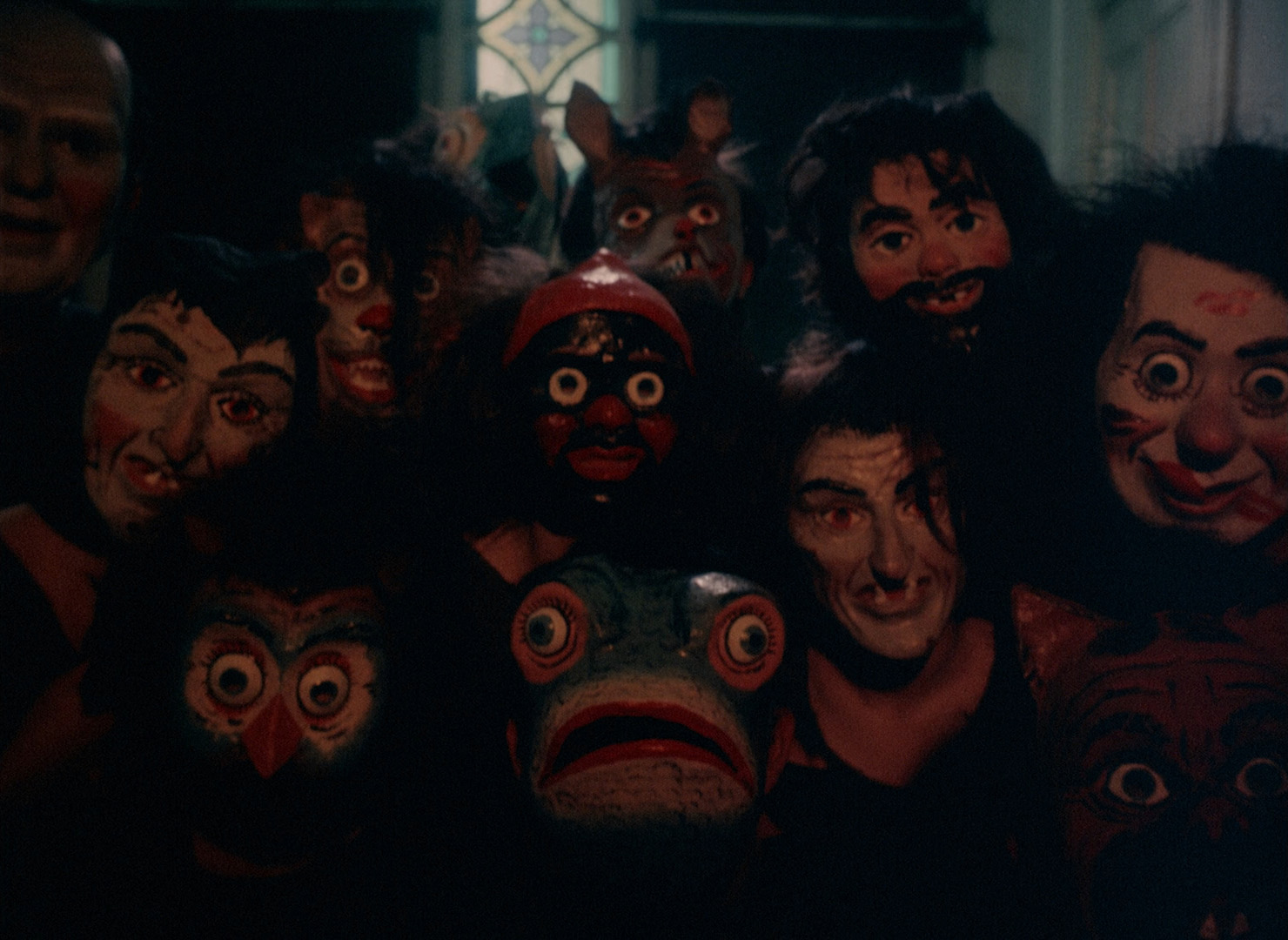
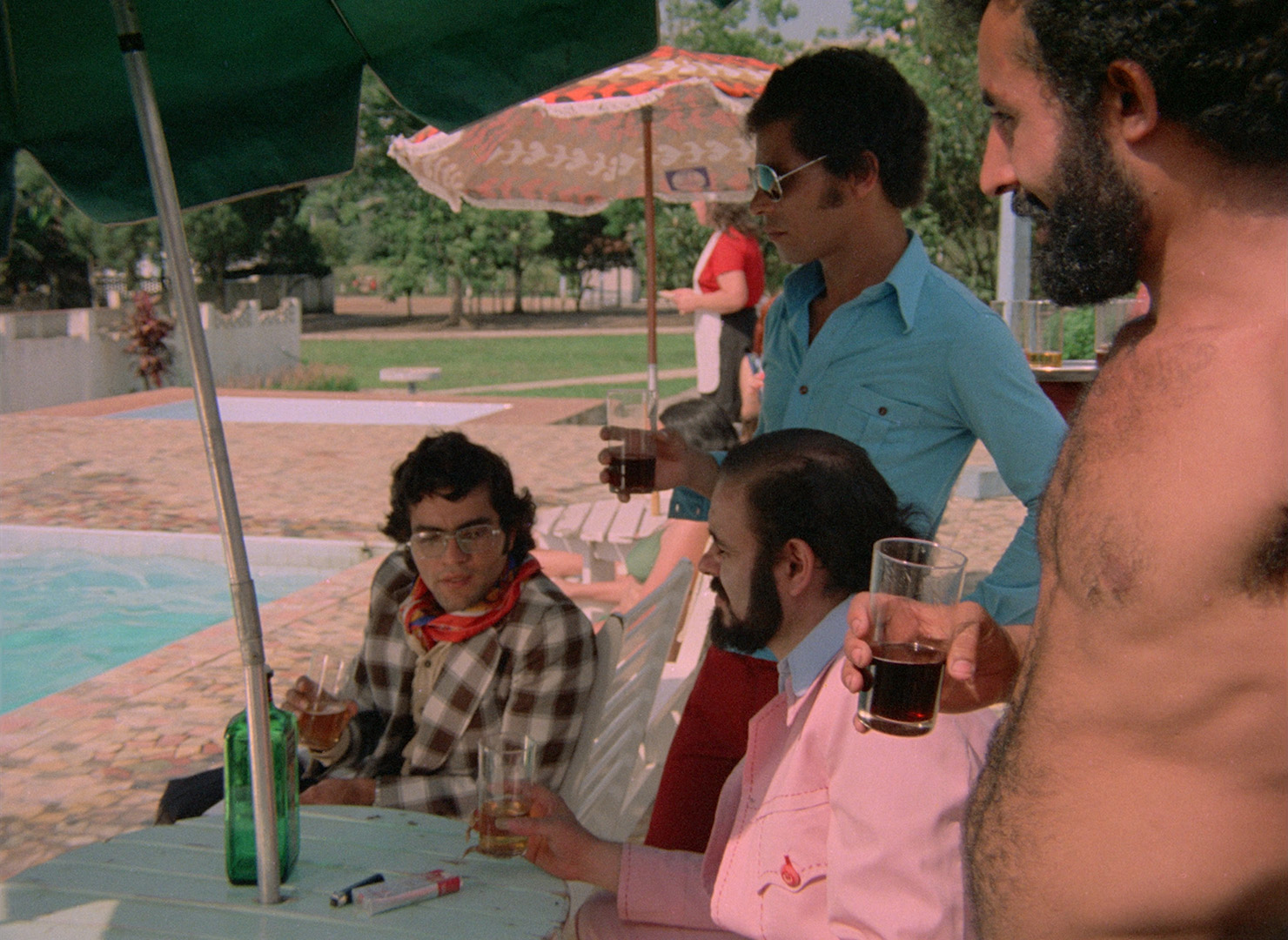
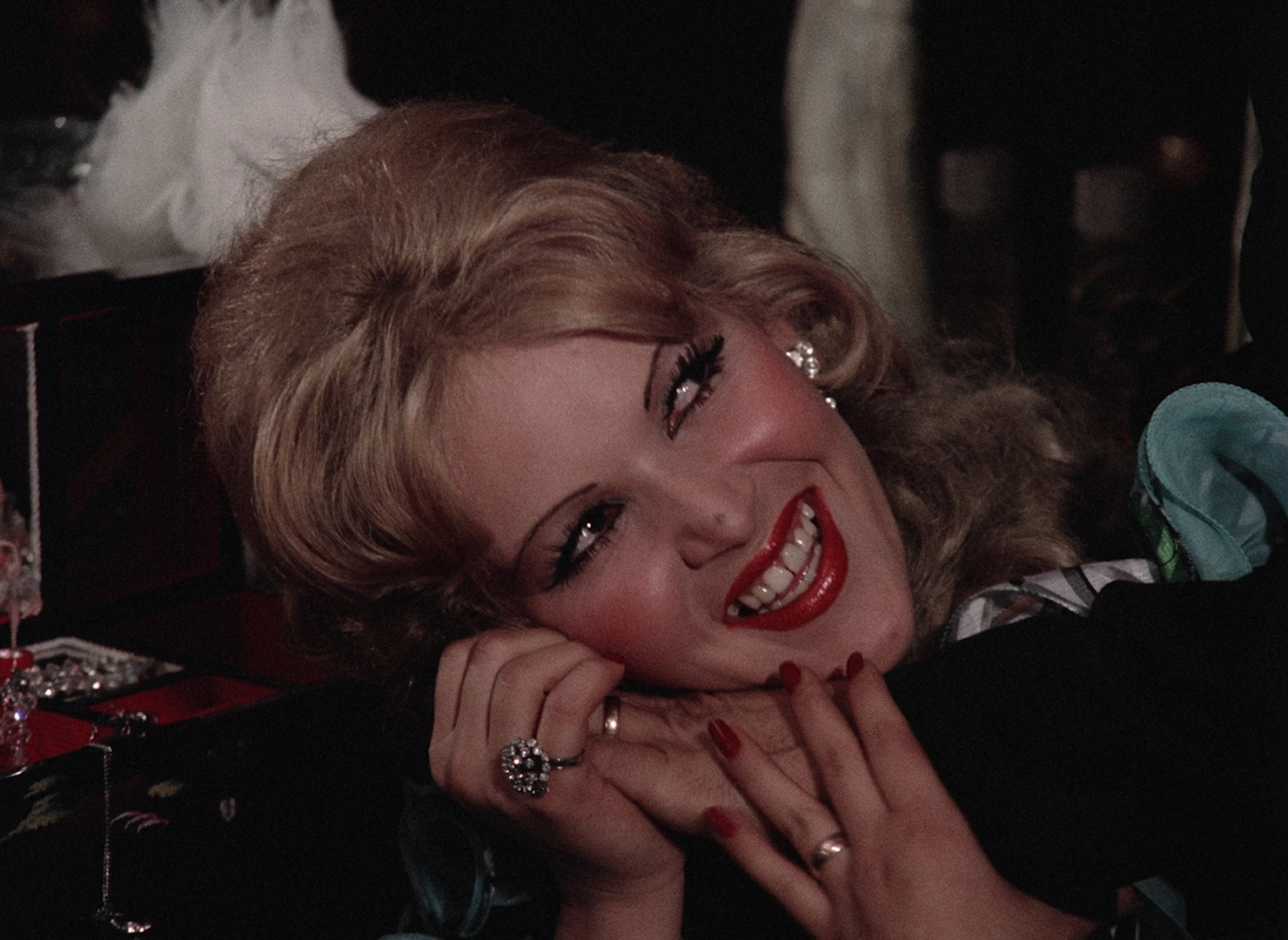
HALLUCINATIONS OF A DERANGED MIND: Cinemagia (DVD)
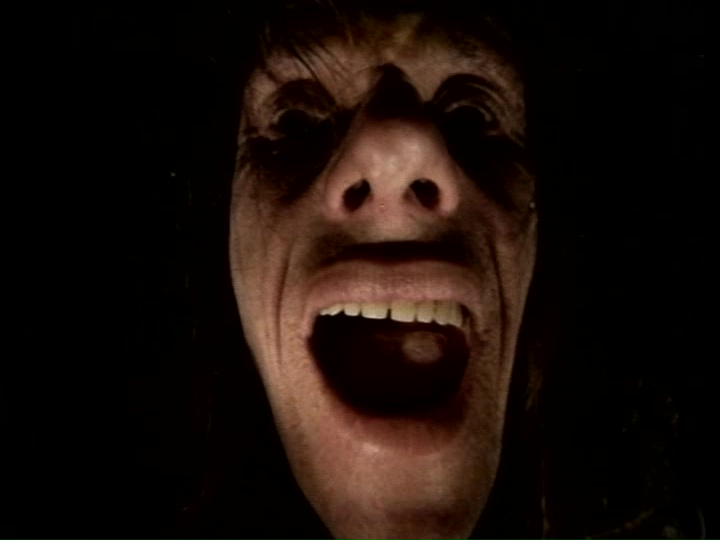
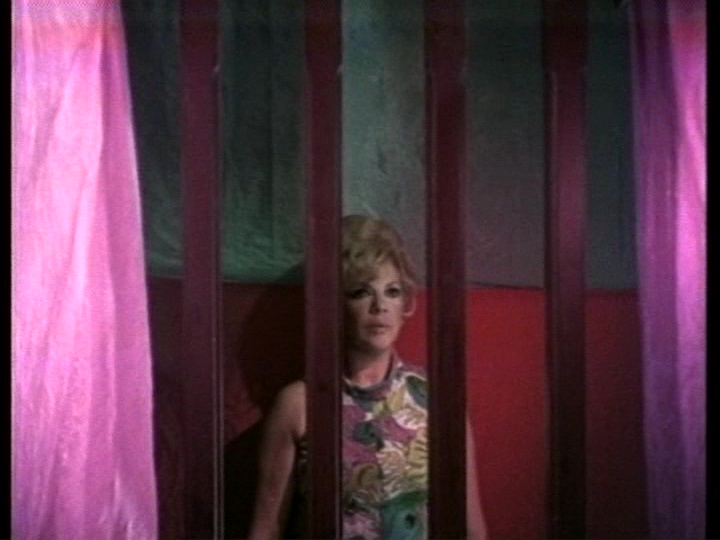
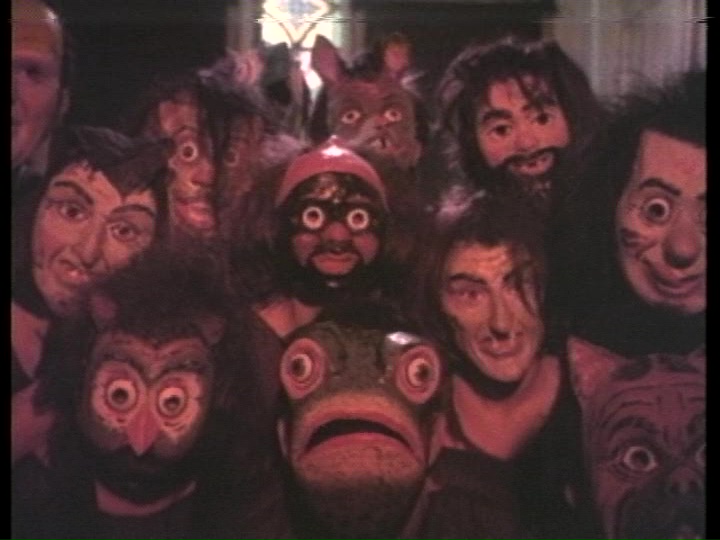
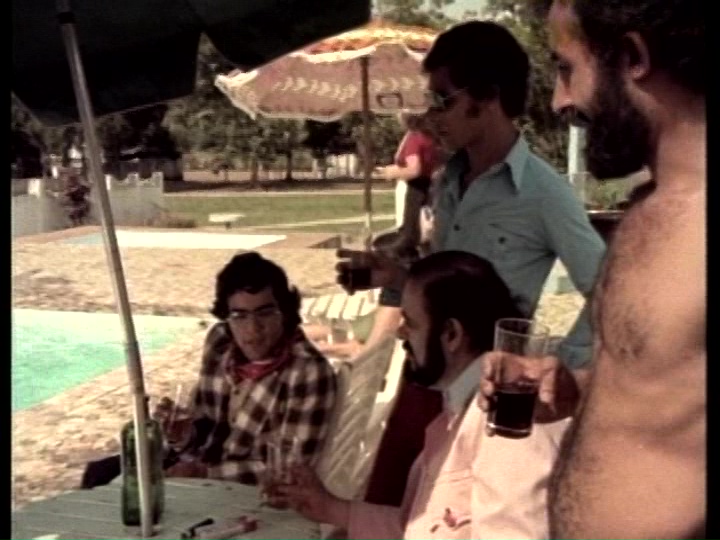
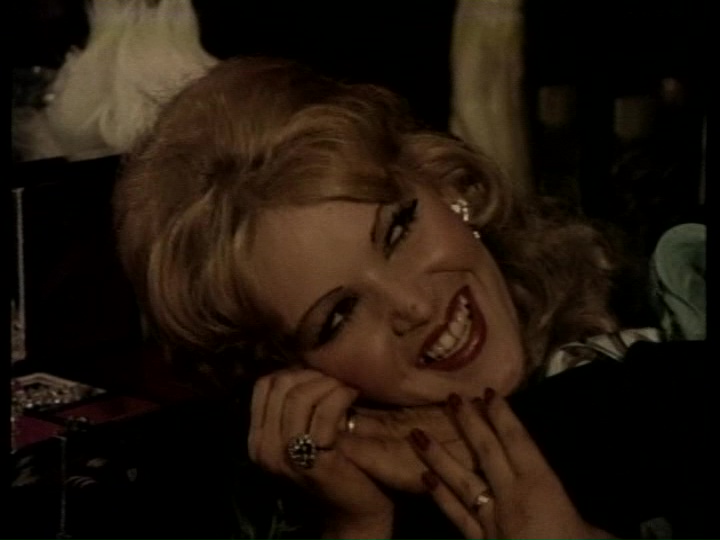
HALLUCINATIONS OF A DERANGED MIND: Anchor Bay (DVD)
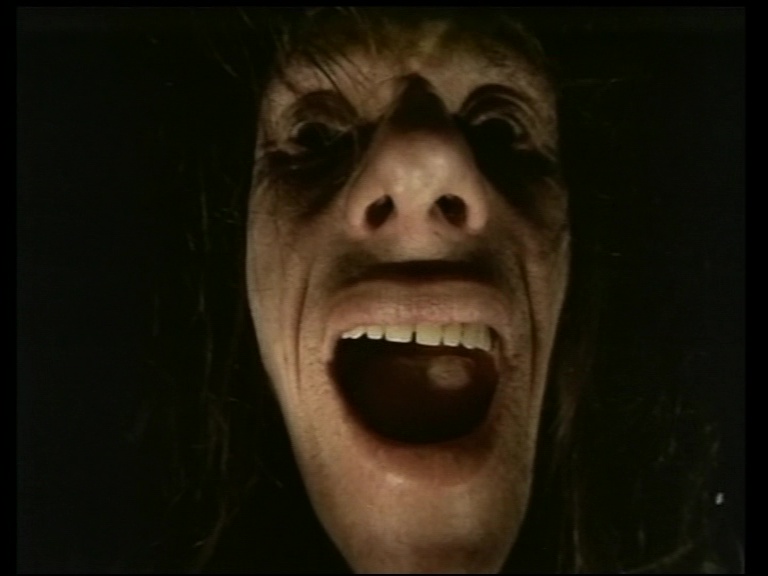
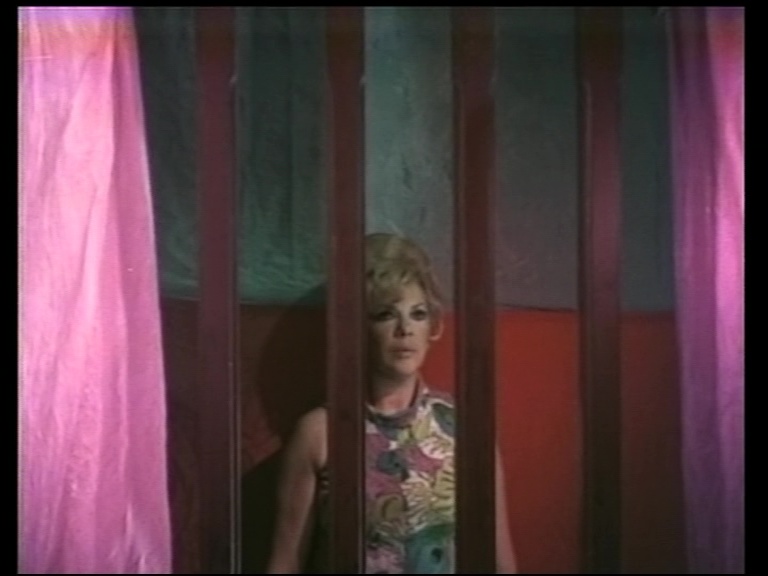
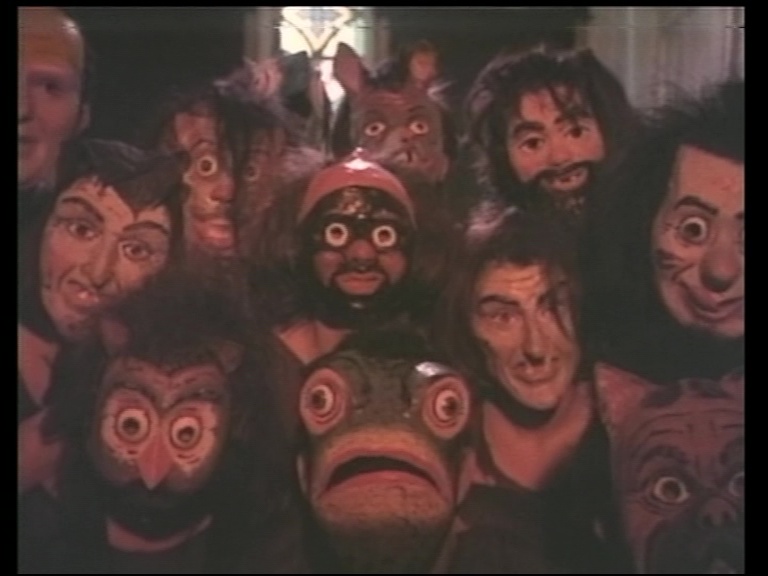
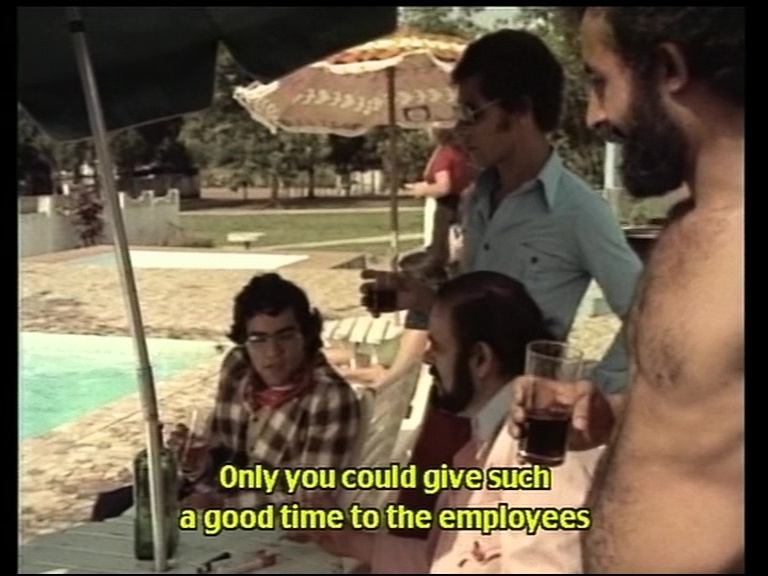
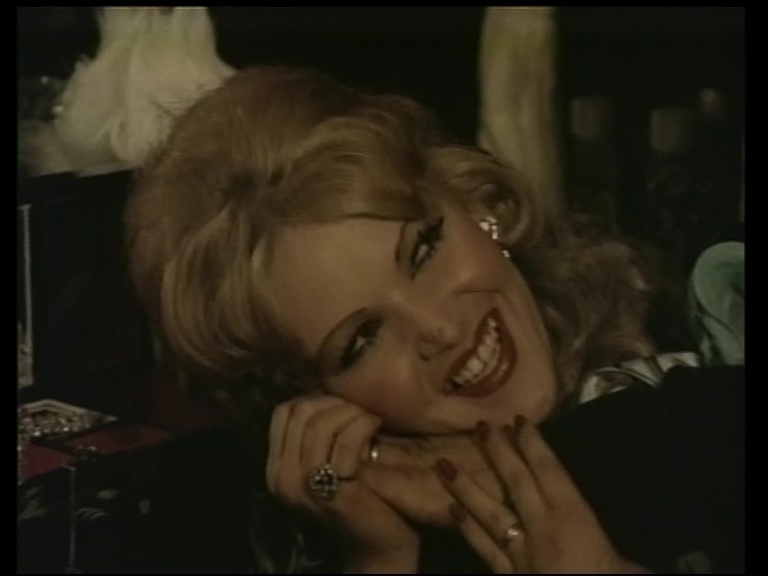
EMBODIMENT OF EVIL: Arrow Video (Blu-ray)
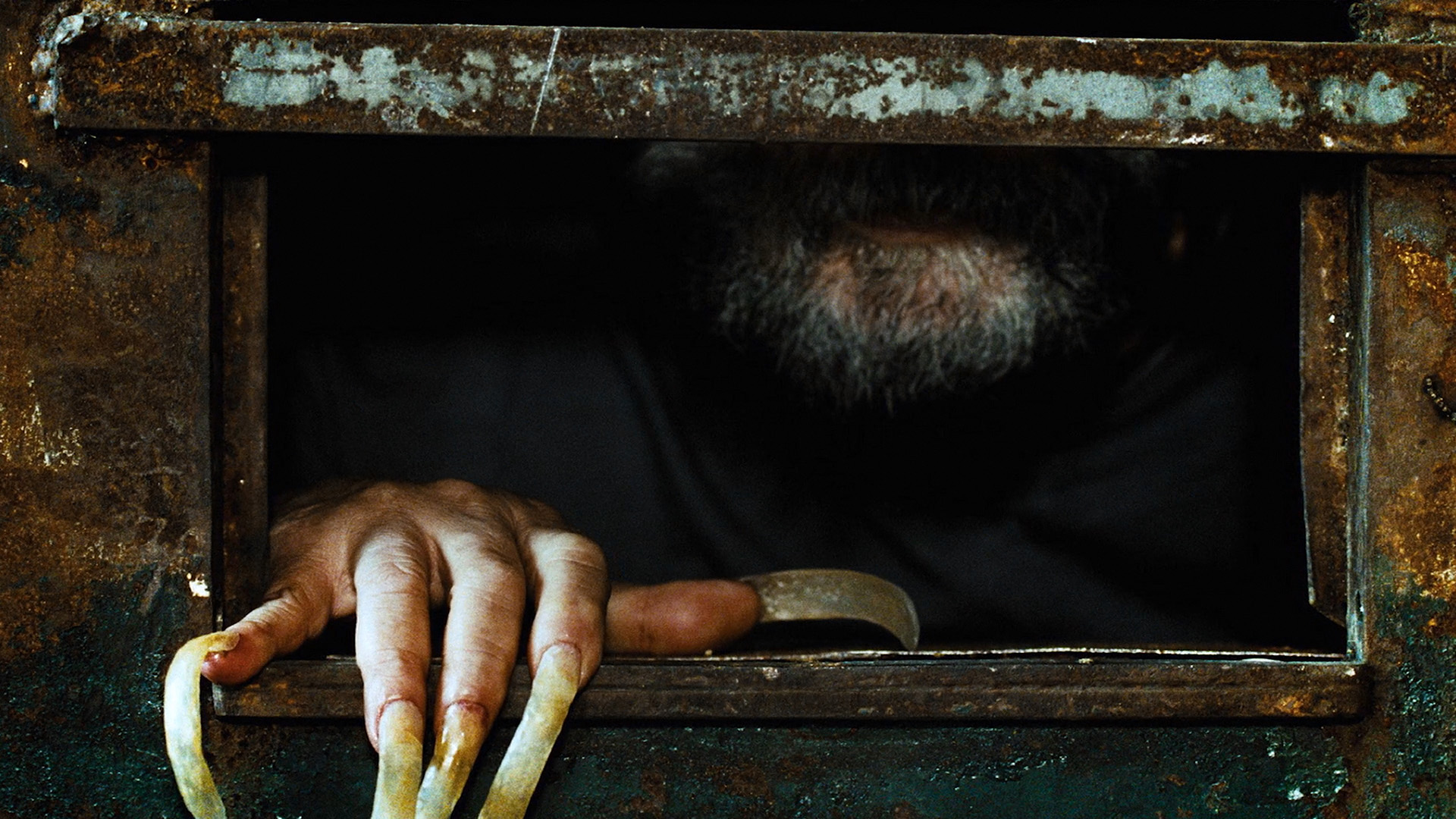
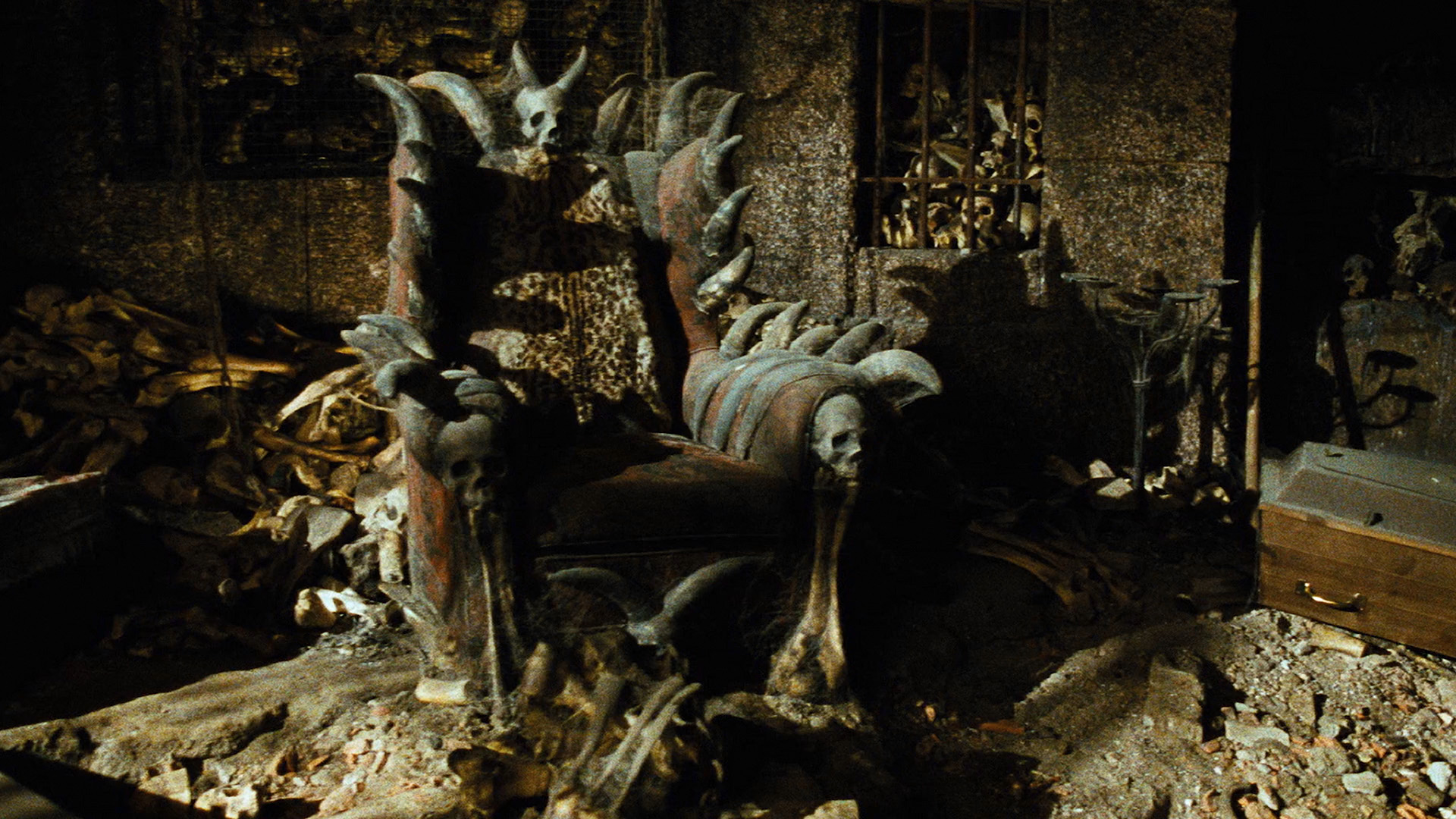
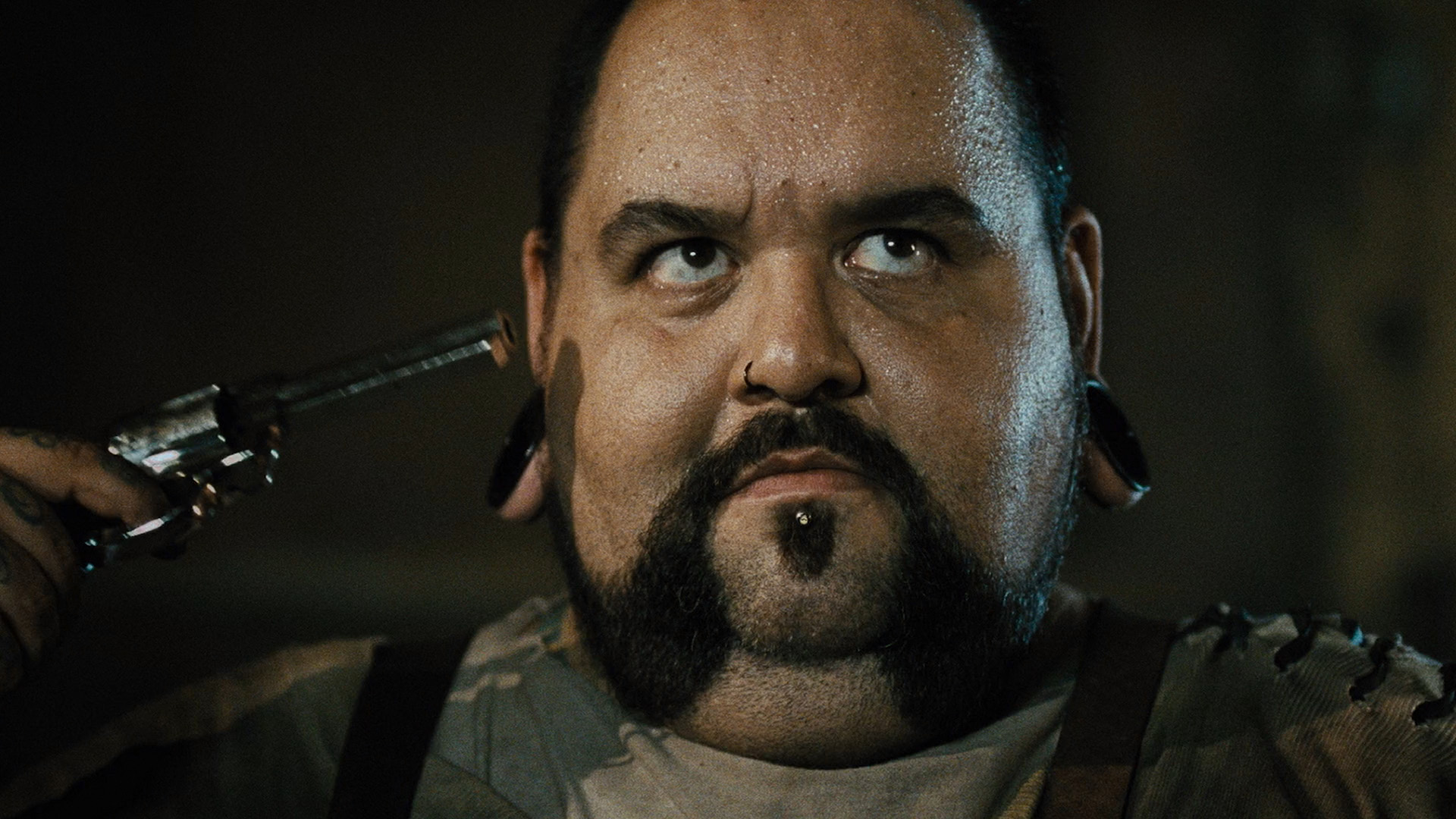
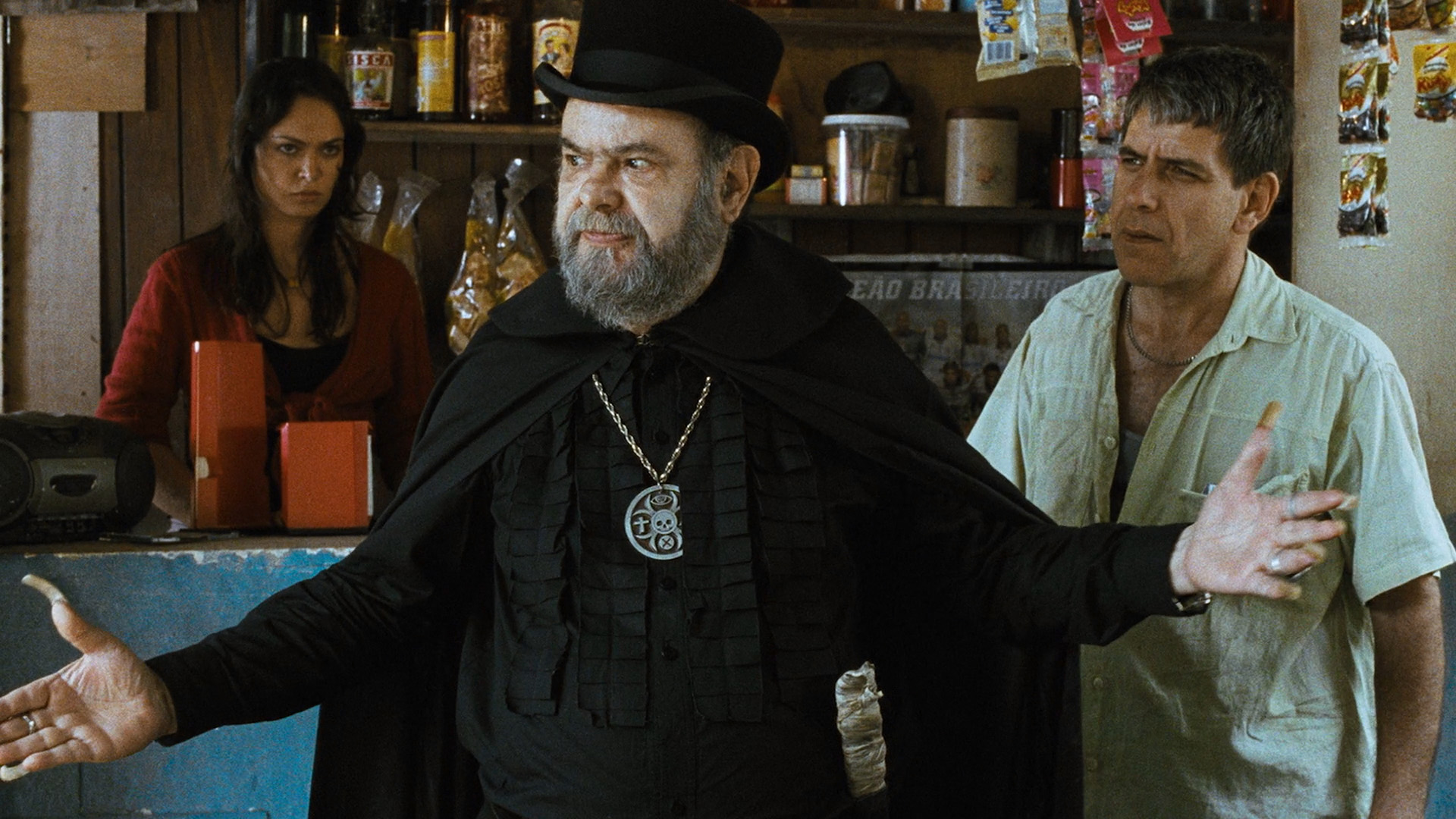
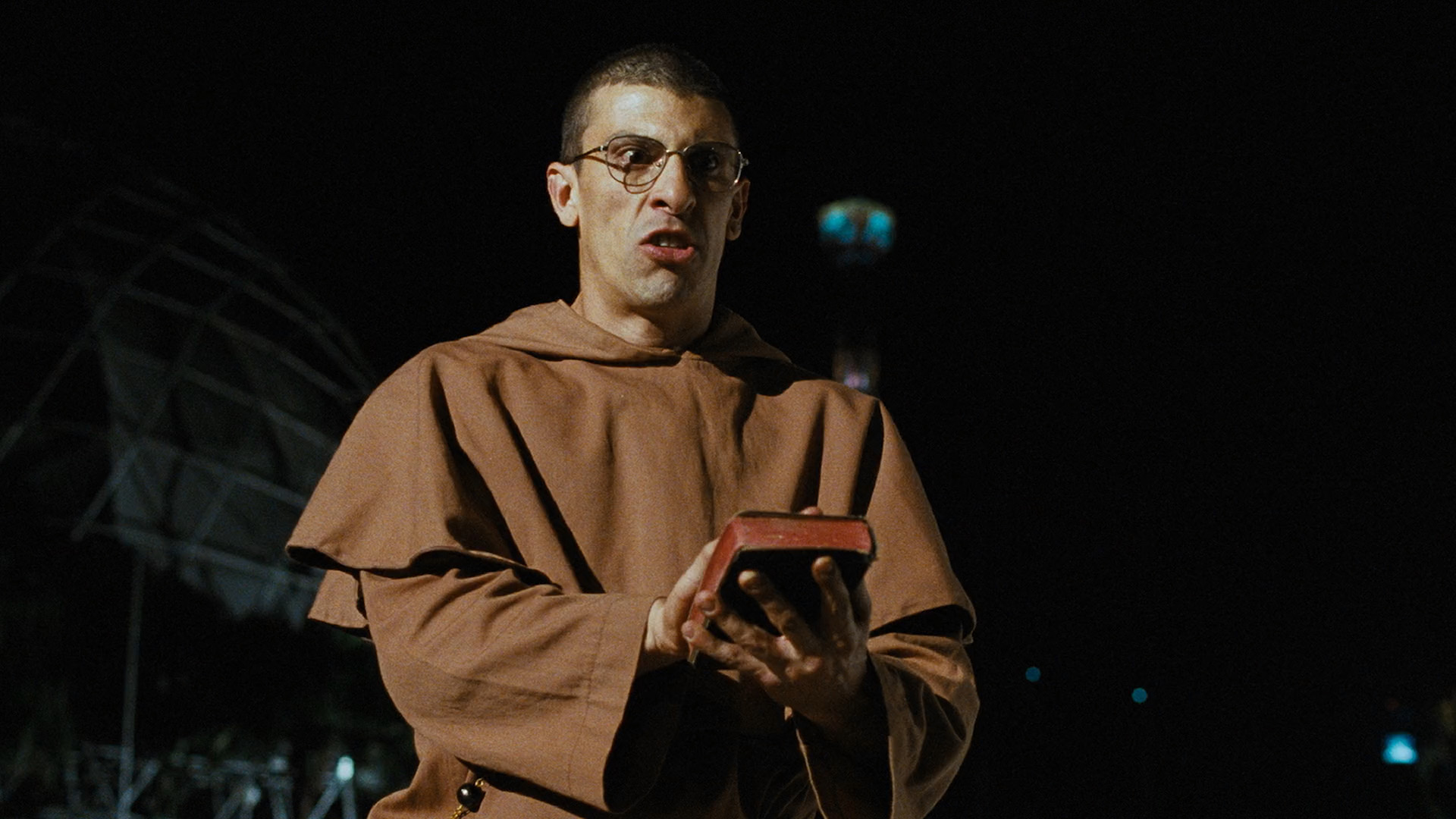
EMBODIMENT OF EVIL: Synapse (Blu-ray)
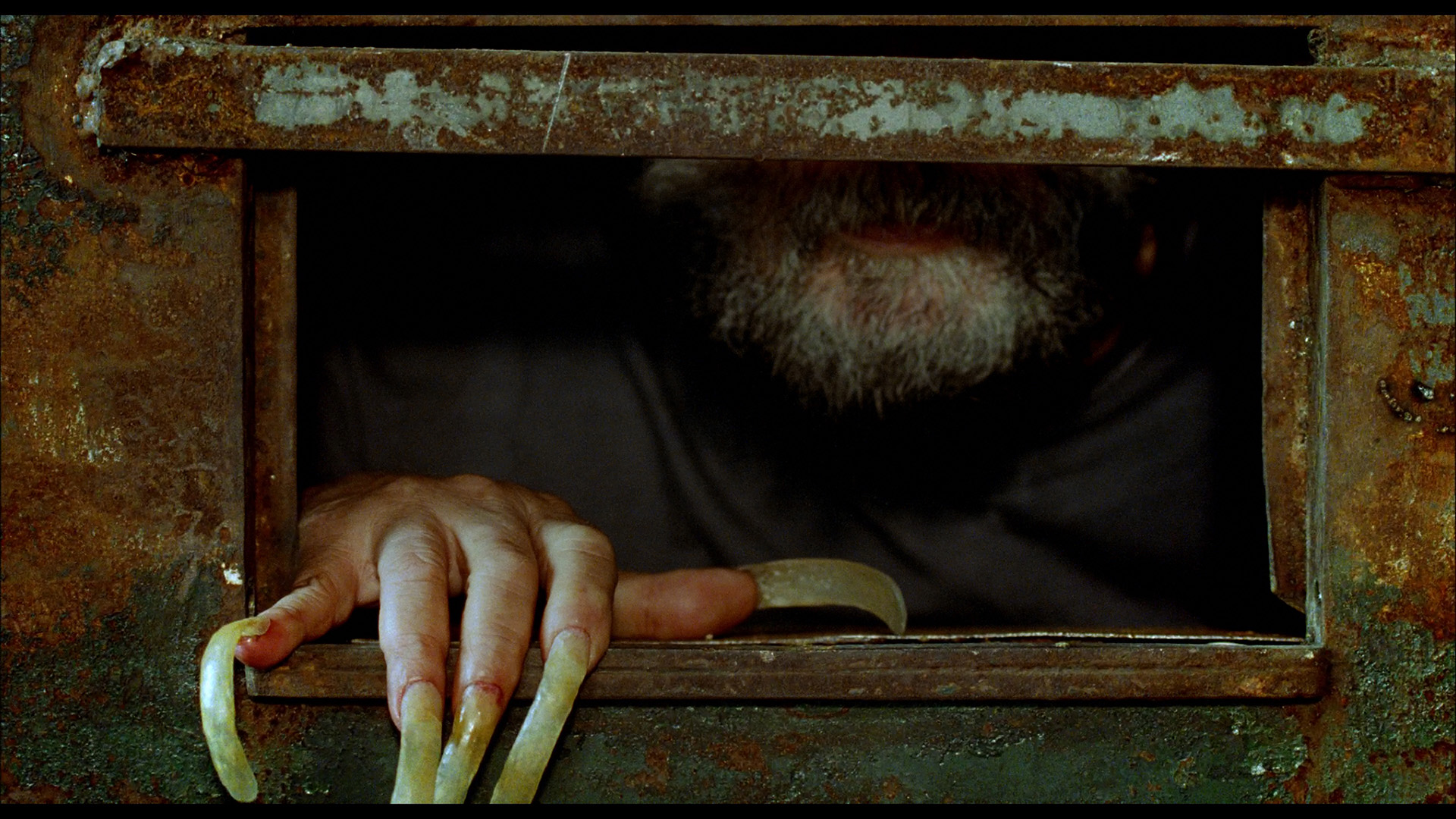
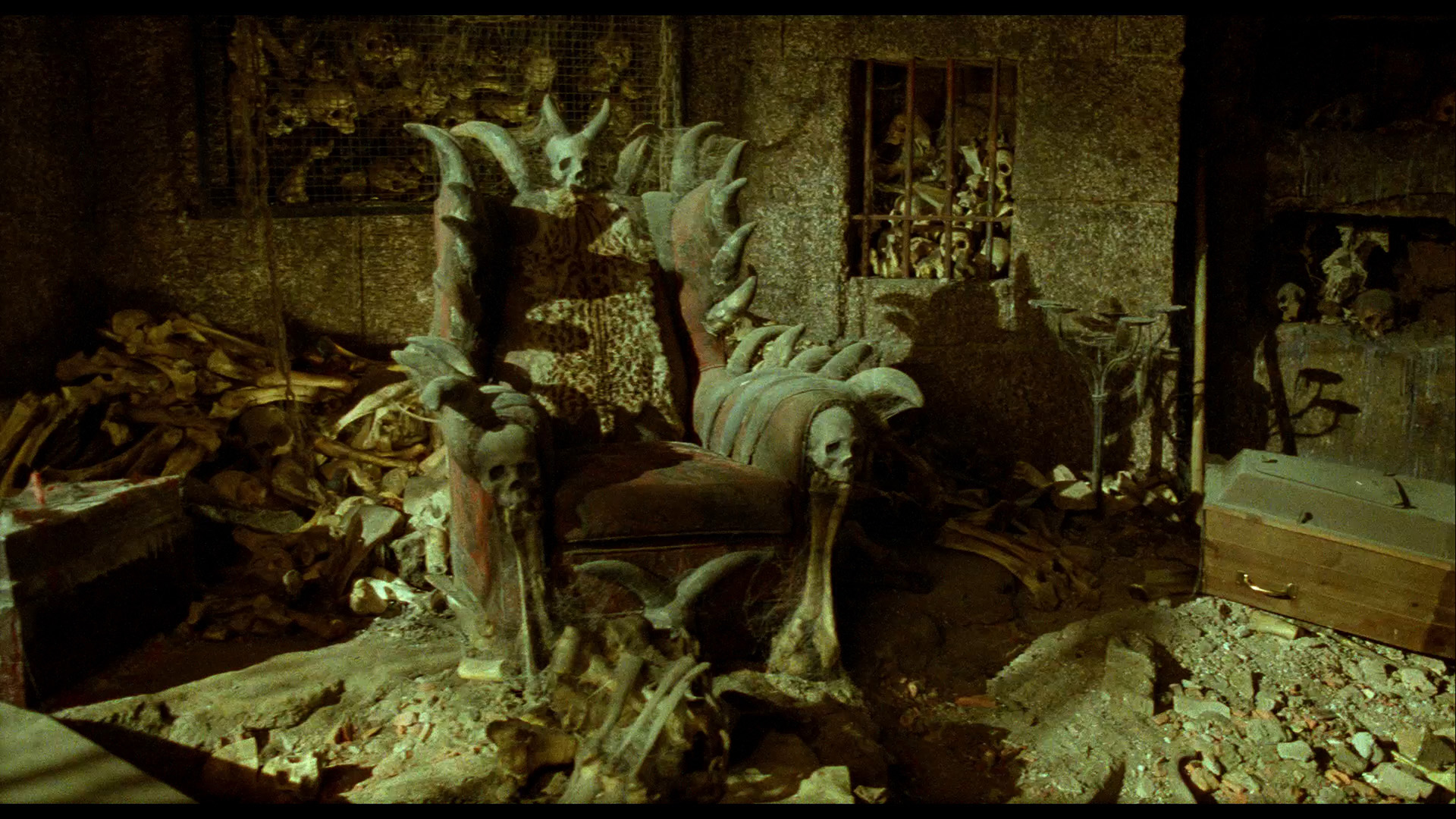
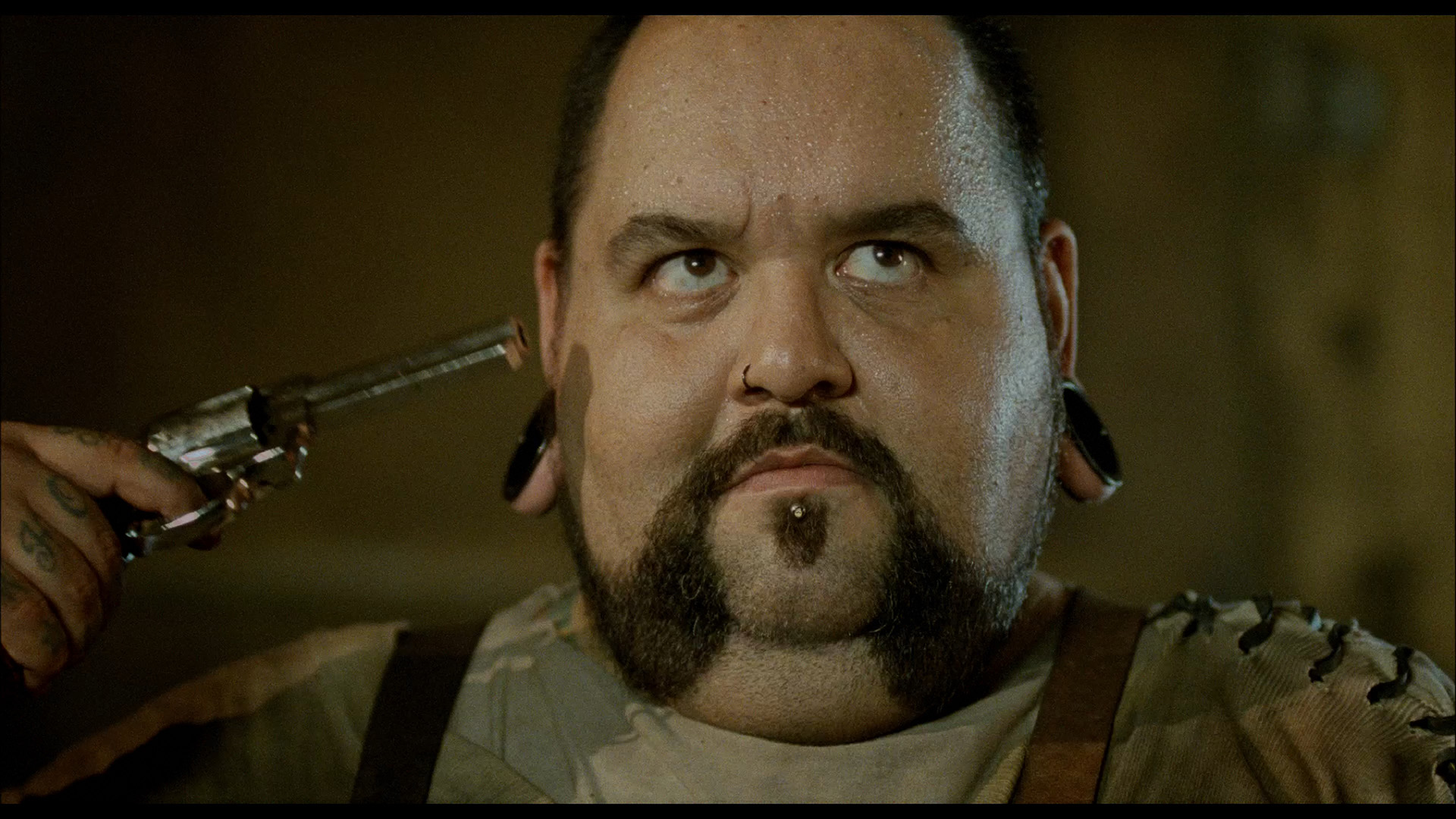
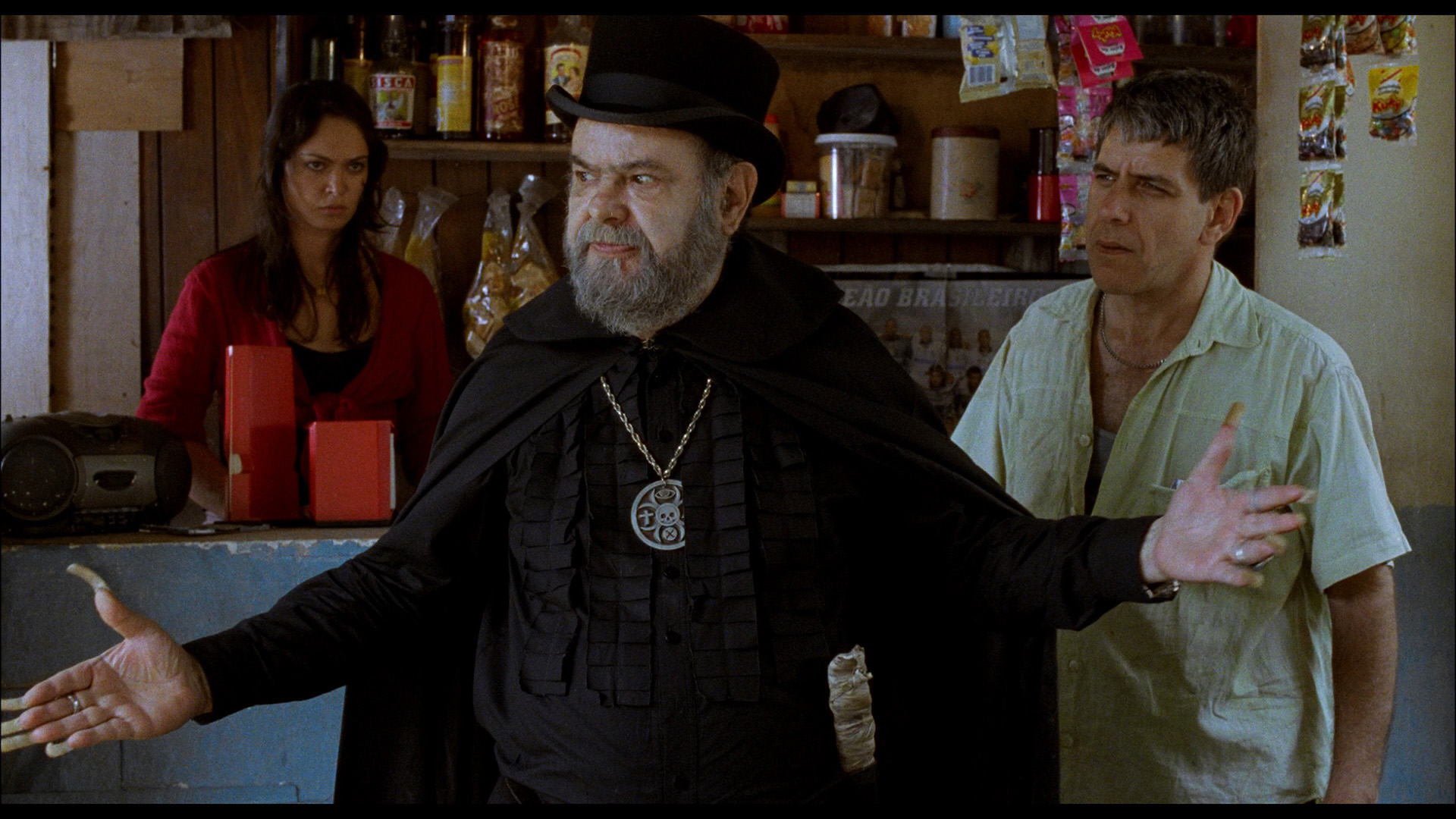
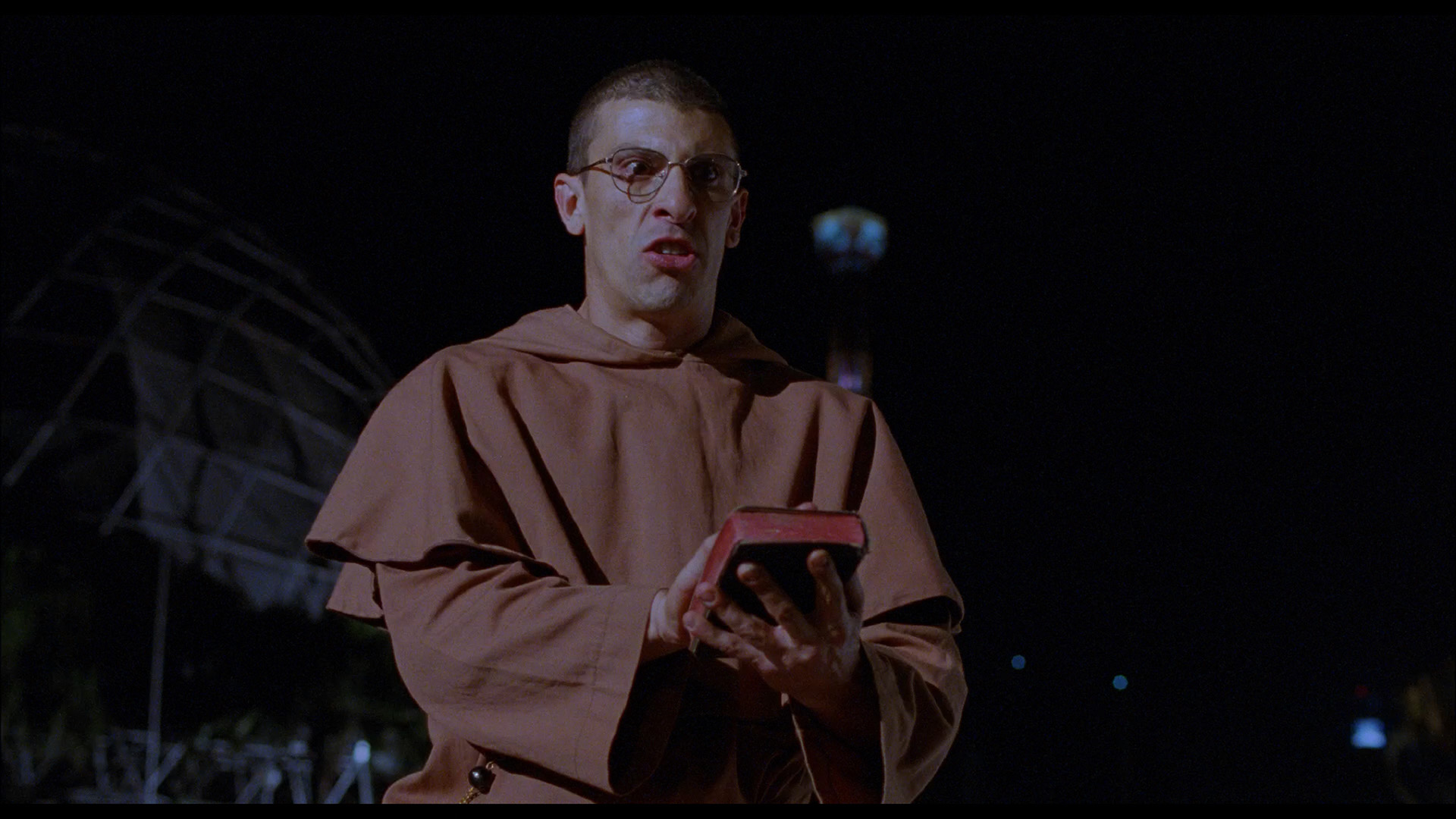
Reviewed on December 29, 2023



 before
before  Freddy Krueger, another maniacal fiend with long fingernails stalked movie screens for years in Brazil. One of the most unforgettable director-actors ever, José Mojica Marins began his bizarre career in 1963 with At Midnight I'll Take Your Soul, a film shot on scraps that turned out to be a huge hit in screens across the nation. With his top hat, chiseled beard, piercing eyes, flowing black cape, and inhumanly long fingernails, Marins became a celebrity as Zé do Caixão, or "Coffin Joe" (the name given by Mike Vraney when the films first came to American VHS from Something Weird starting in 1993), a raging narcissist and pontificator devoted to a personal philosophy of suffering, pain, and procreation. Exactly what constitutes a Coffin Joe film has been up for debate since the character has popped up in multiple titles as a main character, a horror host, or a peripheral presence, with only three of his titles really qualifying as 100% official entries. Marins' horror output (as opposed to his work in other genres ranging from melodramas to westerns to a brief stint in hardcore) has appeared in piecemeal fashion on home video over the past few decades, driven by fan fascination largely ignited at first by jaw-dropping stills and write-ups in major horror book studies like Phil Hardy's essential The Overlook Film Encyclopedia: Horror. Despite claims that his films had been mostly damaged so badly they couldn't be scanned again, a large portion of his horror work was miraculously restored and reissued on Blu-ray by Arrow Video in 2023 in a loaded set, Inside the Mind of Coffin Joe, with six discs housing ten key films along with extensive new and archival extras. The packaging for this limited edition features a collector's book Coffin Joe: Against the World!, with essays by Tim Lucas, Carlos Primati, Jerome Reuter, Amy Voorhees Searles, Kyle Anderson, and Paula Sacramento, plus a double-sided poster and 12 postcard-sized double-sided art cards.
Freddy Krueger, another maniacal fiend with long fingernails stalked movie screens for years in Brazil. One of the most unforgettable director-actors ever, José Mojica Marins began his bizarre career in 1963 with At Midnight I'll Take Your Soul, a film shot on scraps that turned out to be a huge hit in screens across the nation. With his top hat, chiseled beard, piercing eyes, flowing black cape, and inhumanly long fingernails, Marins became a celebrity as Zé do Caixão, or "Coffin Joe" (the name given by Mike Vraney when the films first came to American VHS from Something Weird starting in 1993), a raging narcissist and pontificator devoted to a personal philosophy of suffering, pain, and procreation. Exactly what constitutes a Coffin Joe film has been up for debate since the character has popped up in multiple titles as a main character, a horror host, or a peripheral presence, with only three of his titles really qualifying as 100% official entries. Marins' horror output (as opposed to his work in other genres ranging from melodramas to westerns to a brief stint in hardcore) has appeared in piecemeal fashion on home video over the past few decades, driven by fan fascination largely ignited at first by jaw-dropping stills and write-ups in major horror book studies like Phil Hardy's essential The Overlook Film Encyclopedia: Horror. Despite claims that his films had been mostly damaged so badly they couldn't be scanned again, a large portion of his horror work was miraculously restored and reissued on Blu-ray by Arrow Video in 2023 in a loaded set, Inside the Mind of Coffin Joe, with six discs housing ten key films along with extensive new and archival extras. The packaging for this limited edition features a collector's book Coffin Joe: Against the World!, with essays by Tim Lucas, Carlos Primati, Jerome Reuter, Amy Voorhees Searles, Kyle Anderson, and Paula Sacramento, plus a double-sided poster and 12 postcard-sized double-sided art cards.  regularly picks fights at local bars and cuts off his competitors' fingers with a broken bottle during a game of poker. The goal of Coffin Joe's unholy search is the perfect woman who can bear his son, but even including his own less than satisfactory wife, the locals don't offer a prime candidate... or so it seems, until he meets the lovely Terezinha (Mei).
regularly picks fights at local bars and cuts off his competitors' fingers with a broken bottle during a game of poker. The goal of Coffin Joe's unholy search is the perfect woman who can bear his son, but even including his own less than satisfactory wife, the locals don't offer a prime candidate... or so it seems, until he meets the lovely Terezinha (Mei).  Marins is known for his extreme, personalized filmmaking which often put the actors through the kind of humiliations normally reserved for carnival freak shows, At Midnight is surprisingly strong in both the story and atmosphere departments. The desolate, shadowy village is photographed in a stylish manner to conceal the limited budget; in fact, some of the nocturnal graveyard sequences recall the similar feats accomplished by Mario Bava in Black Sunday and several of Terence Fisher's earlier Hammer films, not to mention the classic Universal horrors which crop up in numerous little homages. All of the actors were amateurs, either friends or relatives, and Marins (sporting his shortest manicure here) handled most of the technical duties himself. As far as homemade horrors go, however, this is a stunning achievement.
Marins is known for his extreme, personalized filmmaking which often put the actors through the kind of humiliations normally reserved for carnival freak shows, At Midnight is surprisingly strong in both the story and atmosphere departments. The desolate, shadowy village is photographed in a stylish manner to conceal the limited budget; in fact, some of the nocturnal graveyard sequences recall the similar feats accomplished by Mario Bava in Black Sunday and several of Terence Fisher's earlier Hammer films, not to mention the classic Universal horrors which crop up in numerous little homages. All of the actors were amateurs, either friends or relatives, and Marins (sporting his shortest manicure here) handled most of the technical duties himself. As far as homemade horrors go, however, this is a stunning achievement.
 Marins interview about the genesis of his interest in filmmaking, a
Marins interview about the genesis of his interest in filmmaking, a  "new scene" shot in 2002 with a modern-day Coffin Joe assailing a woman clutching onto a pet bird, the original Brazilian trailer, and a "rare promotional trailer" with burned-in subs that could have run during its Something Weird days.
"new scene" shot in 2002 with a modern-day Coffin Joe assailing a woman clutching onto a pet bird, the original Brazilian trailer, and a "rare promotional trailer" with burned-in subs that could have run during its Something Weird days. first
first  disc.
disc.  is slicker, the acting is better, and the hell sequence is arguably the most striking set piece in Marins' entire canon (which recycled it more than once!).
is slicker, the acting is better, and the hell sequence is arguably the most striking set piece in Marins' entire canon (which recycled it more than once!).  Newcomers may be startled by the film's excessiveness, so it's probably best to start with the first film to get one's feet wet; however, anyone curious about world horror cinema should make This Night required viewing.
Newcomers may be startled by the film's excessiveness, so it's probably best to start with the first film to get one's feet wet; however, anyone curious about world horror cinema should make This Night required viewing.  sequence looks markedly different than the earlier scan, with the gaudy pinks now looking a darker red and brown. (See comparisons at the bottom
sequence looks markedly different than the earlier scan, with the gaudy pinks now looking a darker red and brown. (See comparisons at the bottom  of this review.)
of this review.) Weird's 1993 VHS compilation, Coffin Joe's Visions of Terror and out of commission since then). The first two stories are certainly strong
Weird's 1993 VHS compilation, Coffin Joe's Visions of Terror and out of commission since then). The first two stories are certainly strong  enough with their subject matter involving necrophilia, rape, and other unsavory activities, but it's in the last stretch where Marins pulls out all the stops with an unforgettable banquet scene that's up to par with the delirious heights of his prior two horror films. This one hasn't had quite the same level of home video exposure in the U.S.; it hit VHS from Something Weird and appeared in the Brazilian and U.K. wave of releases, but the Arrow Video Blu-ray is its first stateside availability in a very long time. The new 4K restoration from the 35mm interpositive and a 35mm print is a radical improvement compared to the very harsh, contrasty look it's had before, with a lot more image info visible to boot and a cleaner LPCM 1.0 mono track. Extras on the second disc include commentaries for both features with Marins, Duarte and Primati ported over from the Brazilian releases, while Stephen Thrower contributes an epic, eloquent look at Marins and his cinematic influences with "Eccentric of Cinema" (87m28s) covering a bevy of literary and cinematic ties to the filmmaker's most transgressive work. "On Tonight’s Horror Show!" (17m14s) is a new video essay by film scholar Miranda Corcoran examining the Coffin Joe persona within the larger line of international horror hosts, with Marins himself shooting to new popularity in Brazil in the '90s as a horror movie host himself. An alternate ending for The Strange World of Coffin Joe (54s) with commentary by Marins is actually the tacked-on ending seen on all prior home video editions; it was imposed by Brazilian censors to get the film released, with an explosive act of God and a bit of scripture wrapping this up on a moralistic note a la The Bad Seed. Its absence in the main body of the feature itself here is actually quite a cause for celebration as the film now ends exactly where it should on a note of complete amoral abandon.
enough with their subject matter involving necrophilia, rape, and other unsavory activities, but it's in the last stretch where Marins pulls out all the stops with an unforgettable banquet scene that's up to par with the delirious heights of his prior two horror films. This one hasn't had quite the same level of home video exposure in the U.S.; it hit VHS from Something Weird and appeared in the Brazilian and U.K. wave of releases, but the Arrow Video Blu-ray is its first stateside availability in a very long time. The new 4K restoration from the 35mm interpositive and a 35mm print is a radical improvement compared to the very harsh, contrasty look it's had before, with a lot more image info visible to boot and a cleaner LPCM 1.0 mono track. Extras on the second disc include commentaries for both features with Marins, Duarte and Primati ported over from the Brazilian releases, while Stephen Thrower contributes an epic, eloquent look at Marins and his cinematic influences with "Eccentric of Cinema" (87m28s) covering a bevy of literary and cinematic ties to the filmmaker's most transgressive work. "On Tonight’s Horror Show!" (17m14s) is a new video essay by film scholar Miranda Corcoran examining the Coffin Joe persona within the larger line of international horror hosts, with Marins himself shooting to new popularity in Brazil in the '90s as a horror movie host himself. An alternate ending for The Strange World of Coffin Joe (54s) with commentary by Marins is actually the tacked-on ending seen on all prior home video editions; it was imposed by Brazilian censors to get the film released, with an explosive act of God and a bit of scripture wrapping this up on a moralistic note a la The Bad Seed. Its absence in the main body of the feature itself here is actually quite a cause for celebration as the film now ends exactly where it should on a note of complete amoral abandon.  Theatrical trailers for both films are also
Theatrical trailers for both films are also  included .
included . previous
previous  films.
films.  Here the contrast is also
Here the contrast is also  drastically improved, though in this case it's also a nice surprise to have the film opened up to 1.33:1 versus the matted 1.66:1 presentation of earlier releases which, by comparison, resulted in clunkier compositions and sheared off some significant info at the top. ADDENDUM: Evidently an error is manifesting on the finished goods with the subtitles for the main feature disappearing after the half-hour mark; what causes this has yet to be determined but hopefully a statement from Arrow will be forthcoming.
drastically improved, though in this case it's also a nice surprise to have the film opened up to 1.33:1 versus the matted 1.66:1 presentation of earlier releases which, by comparison, resulted in clunkier compositions and sheared off some significant info at the top. ADDENDUM: Evidently an error is manifesting on the finished goods with the subtitles for the main feature disappearing after the half-hour mark; what causes this has yet to be determined but hopefully a statement from Arrow will be forthcoming. opinions
opinions  people hold about those around them. As usual, Marins' sense of humor is in abundance here throughout with a fun anarchist streak this time directly aimed at the government and the church in a far less violent fashion than usual. The film is also much easier to appreciate now on Blu-ray with its original vibrant, borderline psychedelic color scheme restored versus the drab look on the tape and the U.K. and Brazilian DVDs; the new 4K restoration from the original 35mm image negatives supplied by Cinemateca Basileira looks absolutely gorgeous. Both films on this disc feature the Brazilian DVD commentaries with Marins, Duarte and Primati, plus the featurette "The Strange Mind of Coffin Joe" (18m25s) with author Guy Adams in a graveyard field ruminating from his own neurodivergent perspective on the more left-field aspects of Marins' work focusing on the fusion of character and filmmaker as well as the unusual rhythms and visual motifs. Then "The Woman for Joe" (17m40s) is a video essay by author Alexandra Heller-Nicholas about Martins' gender politics and treatment of the rape-revenge trope, followed by an alternate main title sequence for The Awakening of the Beast as Ritual dos Sadicos (Ritual of Sadists) (which had to be changed to appease censors). Trailers for both films are also included.
people hold about those around them. As usual, Marins' sense of humor is in abundance here throughout with a fun anarchist streak this time directly aimed at the government and the church in a far less violent fashion than usual. The film is also much easier to appreciate now on Blu-ray with its original vibrant, borderline psychedelic color scheme restored versus the drab look on the tape and the U.K. and Brazilian DVDs; the new 4K restoration from the original 35mm image negatives supplied by Cinemateca Basileira looks absolutely gorgeous. Both films on this disc feature the Brazilian DVD commentaries with Marins, Duarte and Primati, plus the featurette "The Strange Mind of Coffin Joe" (18m25s) with author Guy Adams in a graveyard field ruminating from his own neurodivergent perspective on the more left-field aspects of Marins' work focusing on the fusion of character and filmmaker as well as the unusual rhythms and visual motifs. Then "The Woman for Joe" (17m40s) is a video essay by author Alexandra Heller-Nicholas about Martins' gender politics and treatment of the rape-revenge trope, followed by an alternate main title sequence for The Awakening of the Beast as Ritual dos Sadicos (Ritual of Sadists) (which had to be changed to appease censors). Trailers for both films are also included.  the background for most of the running time after an opener reminding us where he ended up in the prior film; this time
the background for most of the running time after an opener reminding us where he ended up in the prior film; this time  we're thrown into the middle of a gang fight involving guys with names like Chico Swamp and Shark. Soon back out in the wild, Finis Hominis becomes involved with a brutal gang of gypsies and uses his oratory powers to show them the error of their ways, igniting a new movement for unity and faith throughout the land.
we're thrown into the middle of a gang fight involving guys with names like Chico Swamp and Shark. Soon back out in the wild, Finis Hominis becomes involved with a brutal gang of gypsies and uses his oratory powers to show them the error of their ways, igniting a new movement for unity and faith throughout the land.  disc four is the much more familiar and irresistibly titled The Strange Hostel of Naked Pleasures, another
disc four is the much more familiar and irresistibly titled The Strange Hostel of Naked Pleasures, another  "sorta kinda but not quite" Coffin Joe outing made on the heels of his meta mindbender Exorcismo Negro (or The Bloody Exorcism of Coffin Joe), not included here due to insurmountable music rights issues. Credited to Marcelo Motta as director with Marins pitching in as much as he could during a busy time, this is essentially Twilight Zone territory as a dozen random guests including gamblers, adulterers, and other fishy characters are invited to spend the night at a remote hostel on a stormy night. The owner (Marins), who may or may not be the Coffin Joe-style figure we see during a wild prologue, seems to be toying with them including withholding some of the lodgings, which sets the stage for a dark night of twists and turns.
"sorta kinda but not quite" Coffin Joe outing made on the heels of his meta mindbender Exorcismo Negro (or The Bloody Exorcism of Coffin Joe), not included here due to insurmountable music rights issues. Credited to Marcelo Motta as director with Marins pitching in as much as he could during a busy time, this is essentially Twilight Zone territory as a dozen random guests including gamblers, adulterers, and other fishy characters are invited to spend the night at a remote hostel on a stormy night. The owner (Marins), who may or may not be the Coffin Joe-style figure we see during a wild prologue, seems to be toying with them including withholding some of the lodgings, which sets the stage for a dark night of twists and turns.  and infernal resurrection ritual, something that has given this film something of a lesser reputation as everything after that it is
and infernal resurrection ritual, something that has given this film something of a lesser reputation as everything after that it is  more traditional compared to its predecessors. There's a lot of fun to be had though with some ooga-booga scare moments and enough bare flesh to justify the title, though anyone expecting a softcore extravaganza shouldn't get their hopes up.
more traditional compared to its predecessors. There's a lot of fun to be had though with some ooga-booga scare moments and enough bare flesh to justify the title, though anyone expecting a softcore extravaganza shouldn't get their hopes up.  character in a most unfamiliar
character in a most unfamiliar  restaurant setting.
restaurant setting.  with the queasy results you'd expect. This one stayed out of U.S. circulation for ages after its first Something Weird
with the queasy results you'd expect. This one stayed out of U.S. circulation for ages after its first Something Weird  VHS, turning up as usual on DVD later in Brazil and the U.K. The story's the same here with the Arrow Video Blu-ray presenting an immaculate 4K restoration from the original 35mm camera negative and looking faultless here.
VHS, turning up as usual on DVD later in Brazil and the U.K. The story's the same here with the Arrow Video Blu-ray presenting an immaculate 4K restoration from the original 35mm camera negative and looking faultless here.  starting to move into quaint elder statesman territory instead of horror pioneer. The gambit didn't really do much to keep the Coffin Joe brand alive though, as Marins wouldn't really do anything worthy of its original mojo again after this until 1987's Demons and Wonders (almost omitted
starting to move into quaint elder statesman territory instead of horror pioneer. The gambit didn't really do much to keep the Coffin Joe brand alive though, as Marins wouldn't really do anything worthy of its original mojo again after this until 1987's Demons and Wonders (almost omitted  here, presumably over its music). This one followed the same home video trail as Hellish Flesh, bouncing from VHS to U.K. and Brazilian DVD with the latter having an audio commentary (with Marins, editor Nilcemar Leyart, Paulo Duarte and Carlos Primati) carried over for the Arrow Video Blu-ray. The new 4K restoration from the original 35mm camera negative is another dramatic bump with more accurate color, no more damage, and far deeper blacks. "Aesthetics of Garbage: José Mojica Marins, a Complicated Icon" (30m56s) features The Search for Weng Weng filmmaker Andrew Leavold (in full Coffin Joe regalia) examining Marins' place in multiple Brazilian cinematic movements of the '60s and '70s including the Marginal Cinema and some of the weirder alleys the filmmaker encountered in later years (like this). Then in "Beyond Good and Evil" (15m31s), film critic Kat Ellinger looks at Marins' relationship to Nietzsche and the Gothic tradition to which he may tip his hat at times. Finally both films' respective trailers are included.
here, presumably over its music). This one followed the same home video trail as Hellish Flesh, bouncing from VHS to U.K. and Brazilian DVD with the latter having an audio commentary (with Marins, editor Nilcemar Leyart, Paulo Duarte and Carlos Primati) carried over for the Arrow Video Blu-ray. The new 4K restoration from the original 35mm camera negative is another dramatic bump with more accurate color, no more damage, and far deeper blacks. "Aesthetics of Garbage: José Mojica Marins, a Complicated Icon" (30m56s) features The Search for Weng Weng filmmaker Andrew Leavold (in full Coffin Joe regalia) examining Marins' place in multiple Brazilian cinematic movements of the '60s and '70s including the Marginal Cinema and some of the weirder alleys the filmmaker encountered in later years (like this). Then in "Beyond Good and Evil" (15m31s), film critic Kat Ellinger looks at Marins' relationship to Nietzsche and the Gothic tradition to which he may tip his hat at times. Finally both films' respective trailers are included.  third official installment in his Coffin Joe feature series, Embodiment of Evil, and everyone had to wonder: how and why do you bring a character so associated with the excessive '60s and '70s into the modern era? The answer comes right away as we meet a much grayer and even
third official installment in his Coffin Joe feature series, Embodiment of Evil, and everyone had to wonder: how and why do you bring a character so associated with the excessive '60s and '70s into the modern era? The answer comes right away as we meet a much grayer and even  madder-looking Coffin Joe locked away in an asylum where, after decades of incarceration for vile crimes against humanity, he's freed thanks to the efforts of an attorney (Aché) and joins his hunchbacked sidekick, Bruno (Resende), to resume his depraved activities. However, the slums have become very different over the passage of time; on top of that, a nasty colonel (Valadão) and police captain (Stuart) have their sights set on making Joe pay for his misdeeds. Undeterred, he rounds up some new disciplines (whom he initiates through fun tricks like ordering them to fire pistols at their skulls) and embarks on a new mission to sire an evil heir. Along the way he's tortured by black-and-white flashbacks from the first two films, with his ghostly victims attacking him as equally monochromatic phantoms. With both women and men subjected to a string of ghoulish torments, can Joe be stopped before his mission is completed?
madder-looking Coffin Joe locked away in an asylum where, after decades of incarceration for vile crimes against humanity, he's freed thanks to the efforts of an attorney (Aché) and joins his hunchbacked sidekick, Bruno (Resende), to resume his depraved activities. However, the slums have become very different over the passage of time; on top of that, a nasty colonel (Valadão) and police captain (Stuart) have their sights set on making Joe pay for his misdeeds. Undeterred, he rounds up some new disciplines (whom he initiates through fun tricks like ordering them to fire pistols at their skulls) and embarks on a new mission to sire an evil heir. Along the way he's tortured by black-and-white flashbacks from the first two films, with his ghostly victims attacking him as equally monochromatic phantoms. With both women and men subjected to a string of ghoulish torments, can Joe be stopped before his mission is completed? Hell that turns into a fantastic surrealist set piece. Marins' over-the-top acting hasn't changed one iota either; drawing inspiration on some of Vincent Price's
Hell that turns into a fantastic surrealist set piece. Marins' over-the-top acting hasn't changed one iota either; drawing inspiration on some of Vincent Price's  more melodramatic performances but ratcheted through the roof, he turns Coffin Joe into a vivid, barnstorming figure of villainy you can't help secretly rooting for as he undermines all of society's dictates.
more melodramatic performances but ratcheted through the roof, he turns Coffin Joe into a vivid, barnstorming figure of villainy you can't help secretly rooting for as he undermines all of society's dictates.  The 2023 Arrow Blu-ray is devoted entirely to this film, with yet another scan that features deeper blacks and punchier
The 2023 Arrow Blu-ray is devoted entirely to this film, with yet another scan that features deeper blacks and punchier  colors while zooming it in a bit to 1.78:1 from the earlier 1.85:1 (with less info on the sides). The DTS-HD MA 5.1 and 2.0 options are both here with English subtitles, plus an archival commentary from its Brazilian run with producer Paulo Sacramento and co-screenwriter Dennison Ramalho (in Portuguese with English subtitles, like the rest of the tracks here). The making-of, Fantasia coverage, and trailer are ported over here, while Ramalho returns for the new featurette "Learning from the Master" (37m40s) about the process of coming up with the story with Marins and tailoring the script for a modern audience who might not be familiar with the original films. Ramalho is also back for "Apprenticeship of Evil" (84m36s), an extensive 2020 interview via Zoom for Fantasia with Mitch Davis in a very in-depth, interesting conversation about Marins' working process, his outlook, the rebirth of fandom among new generations, and the film's reception. Also included are an alternate "experimental making of" (13m25s) with an impressionistic look at the production, a reel of deleted scenes (12m11s) with commentary by Marins, and two brief archival short extras, "Visual Effects: Purgatory" (2m16s) and "Storyboards" (2m7s), both with Marins commentary.
colors while zooming it in a bit to 1.78:1 from the earlier 1.85:1 (with less info on the sides). The DTS-HD MA 5.1 and 2.0 options are both here with English subtitles, plus an archival commentary from its Brazilian run with producer Paulo Sacramento and co-screenwriter Dennison Ramalho (in Portuguese with English subtitles, like the rest of the tracks here). The making-of, Fantasia coverage, and trailer are ported over here, while Ramalho returns for the new featurette "Learning from the Master" (37m40s) about the process of coming up with the story with Marins and tailoring the script for a modern audience who might not be familiar with the original films. Ramalho is also back for "Apprenticeship of Evil" (84m36s), an extensive 2020 interview via Zoom for Fantasia with Mitch Davis in a very in-depth, interesting conversation about Marins' working process, his outlook, the rebirth of fandom among new generations, and the film's reception. Also included are an alternate "experimental making of" (13m25s) with an impressionistic look at the production, a reel of deleted scenes (12m11s) with commentary by Marins, and two brief archival short extras, "Visual Effects: Purgatory" (2m16s) and "Storyboards" (2m7s), both with Marins commentary.
![]()